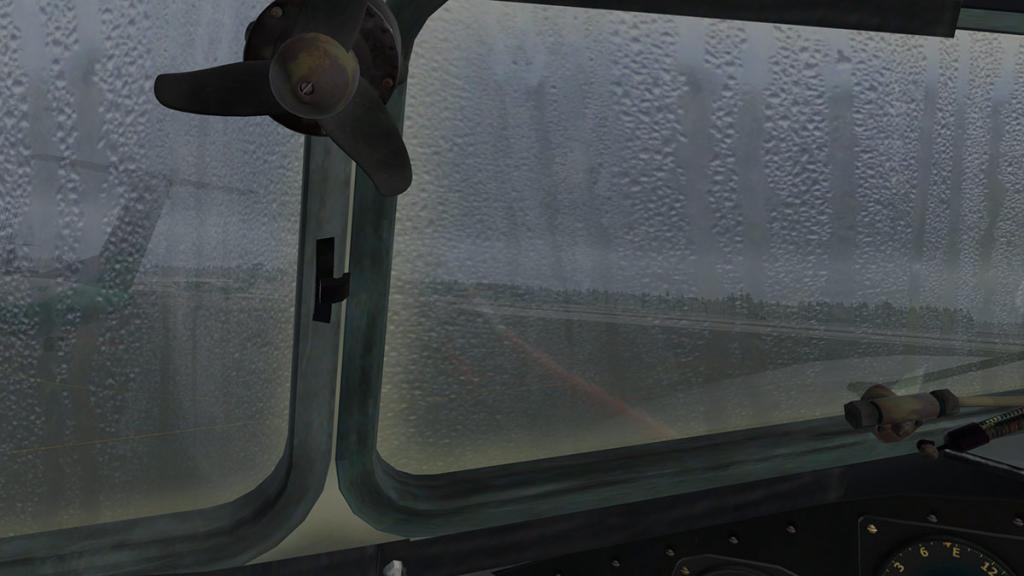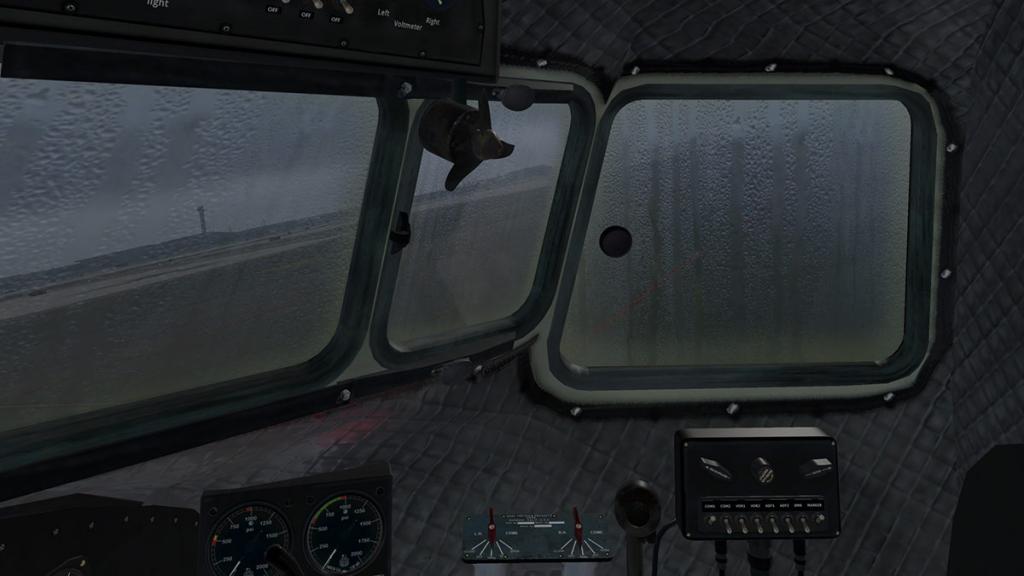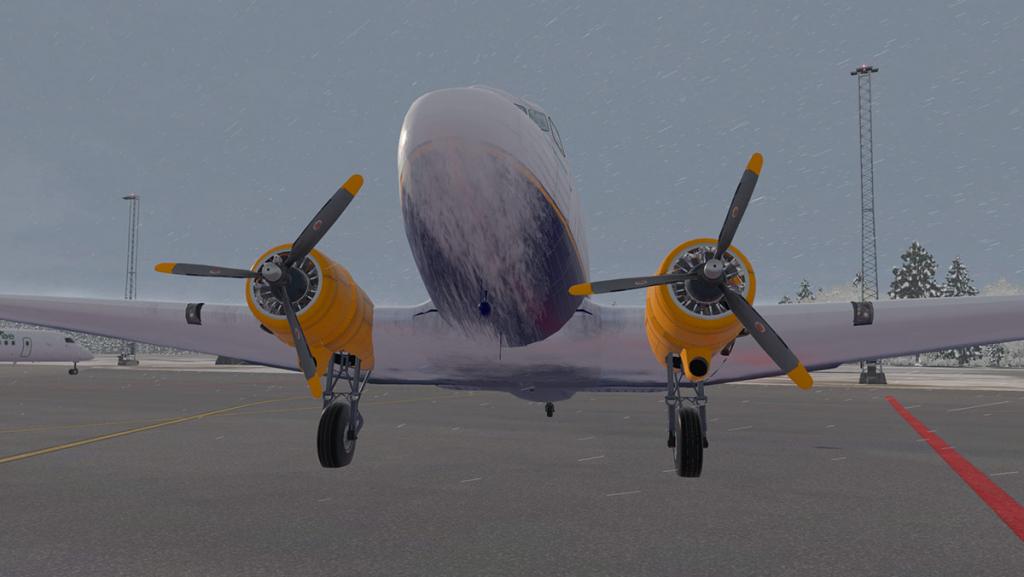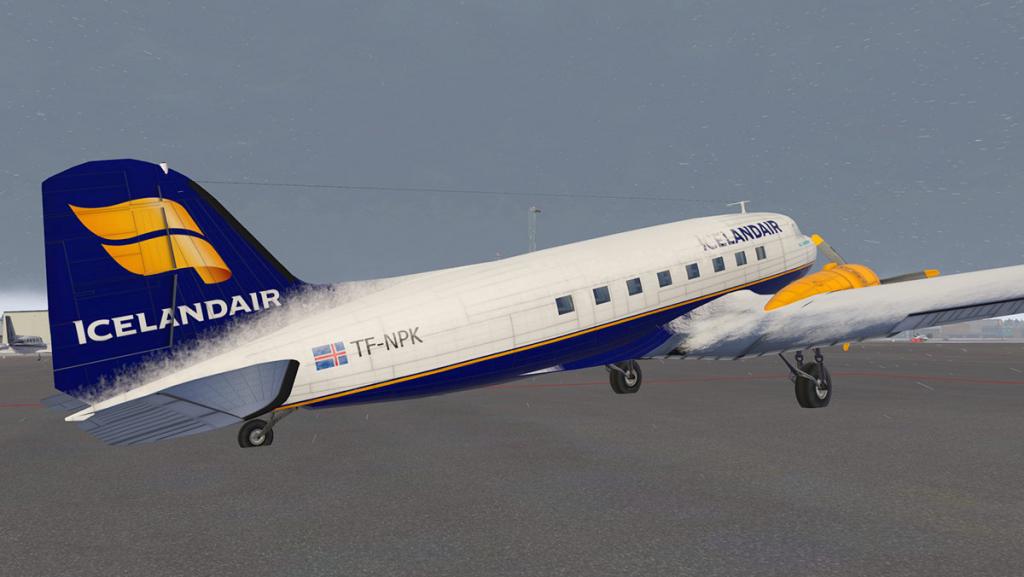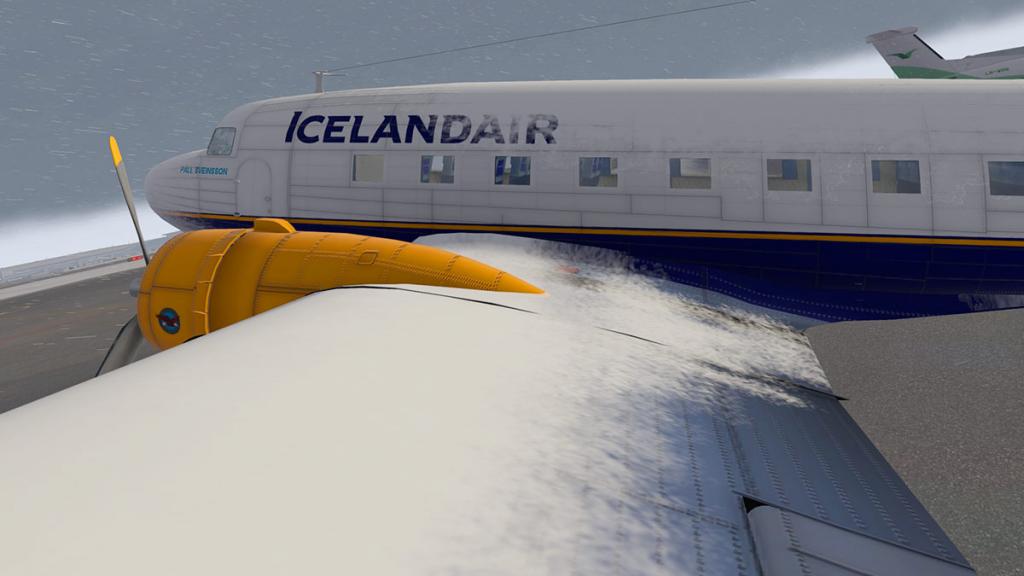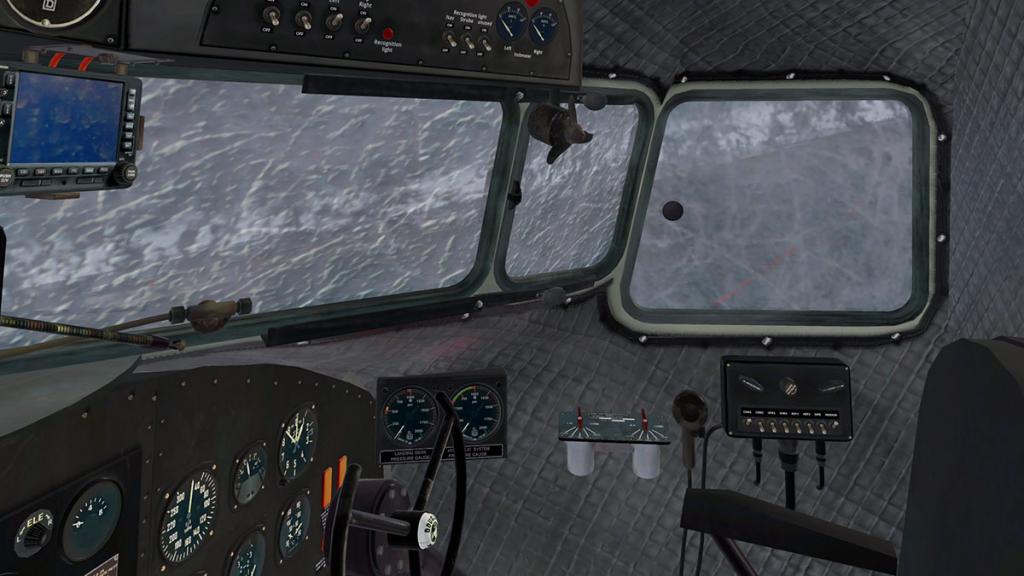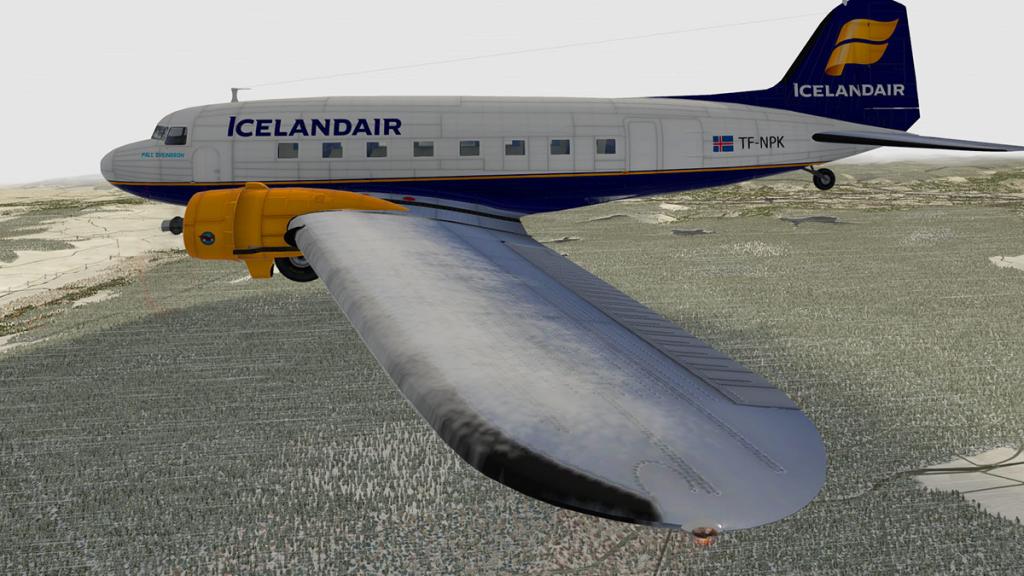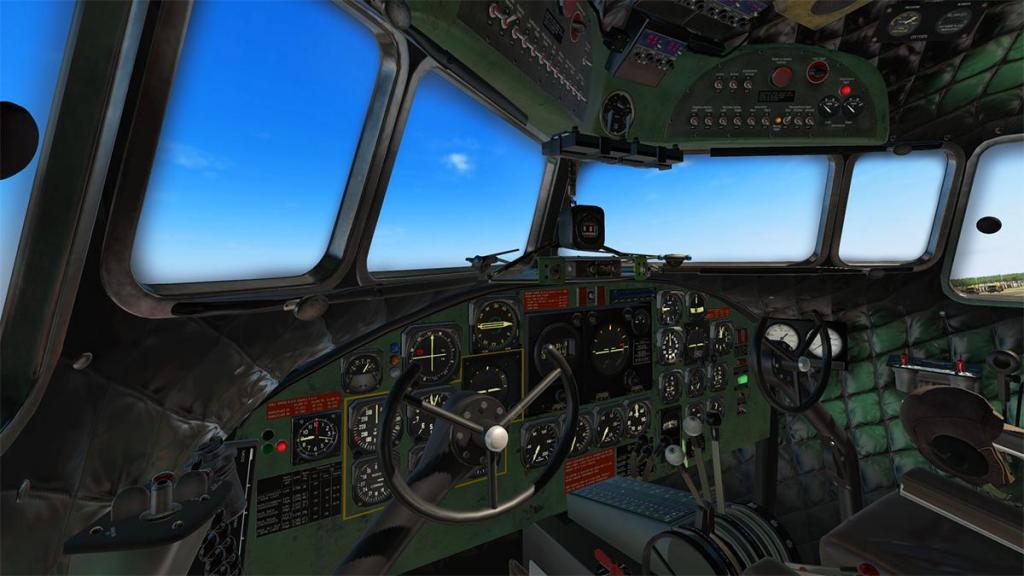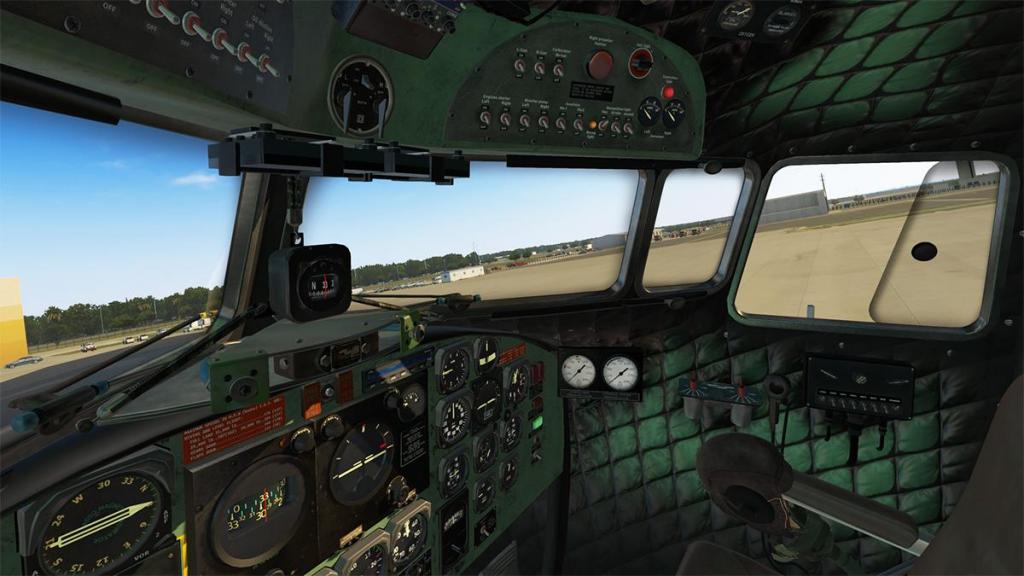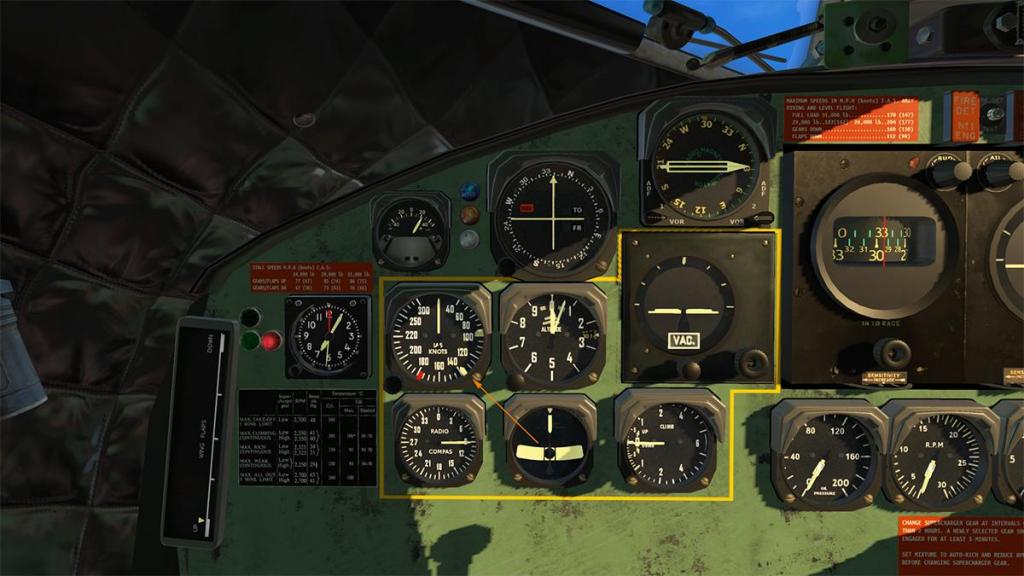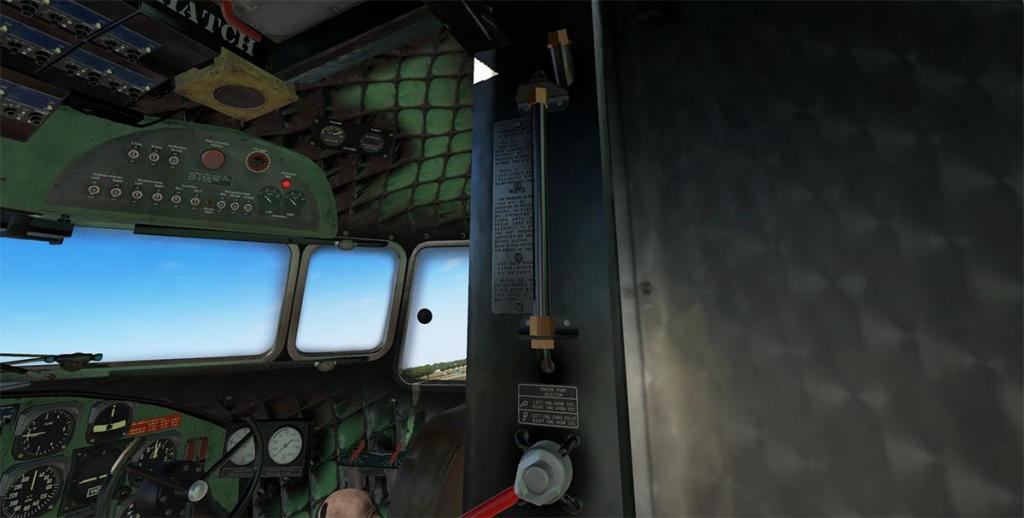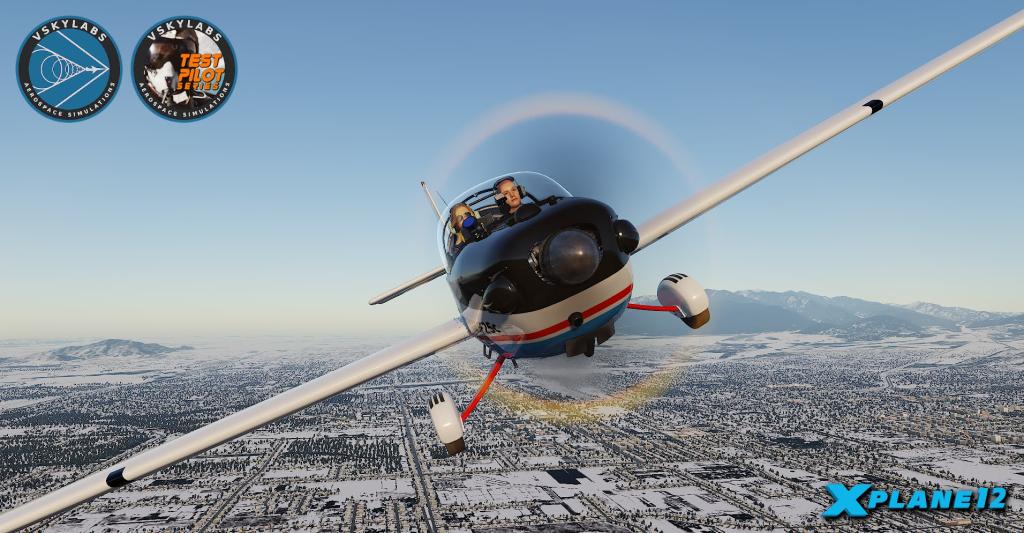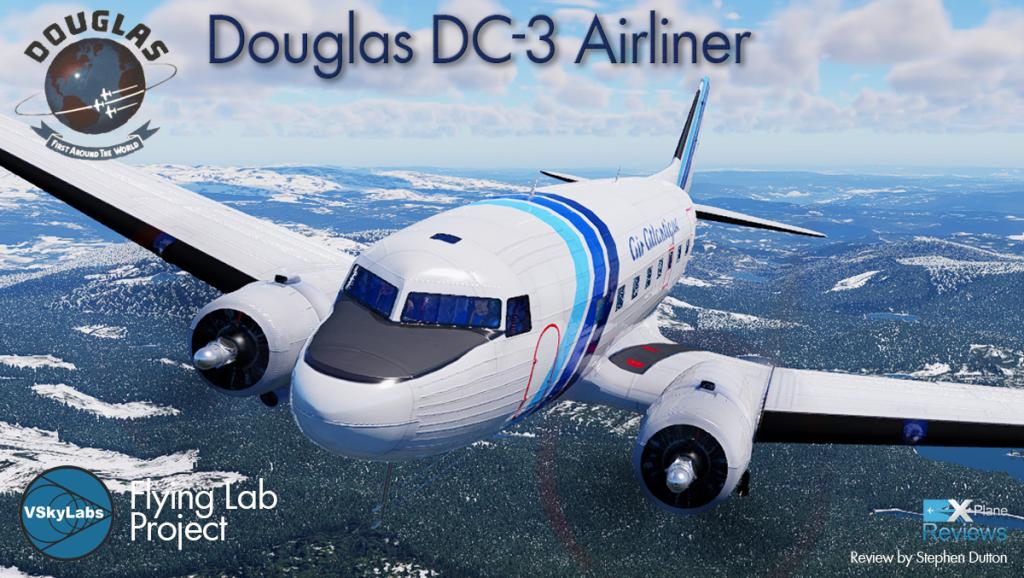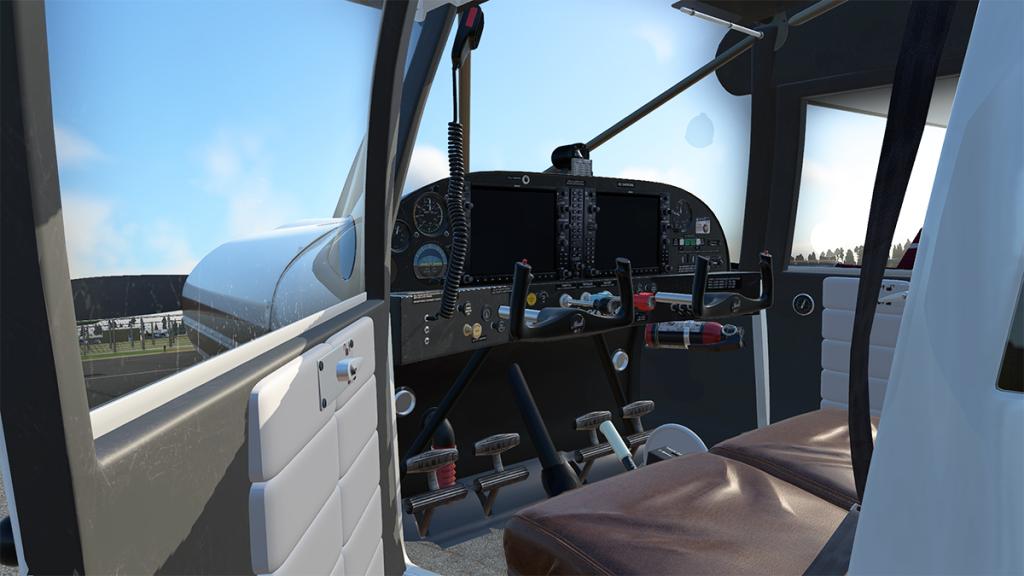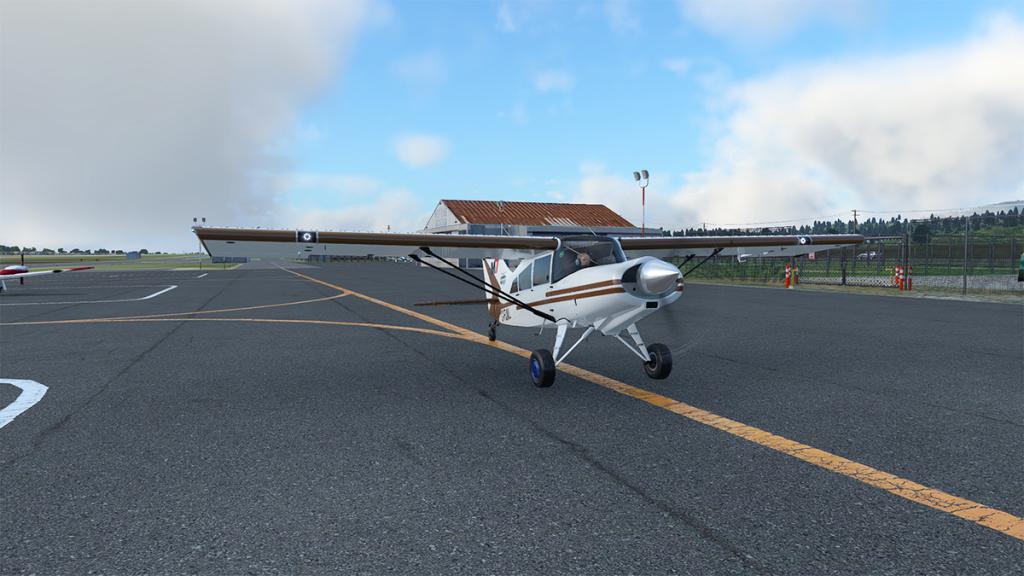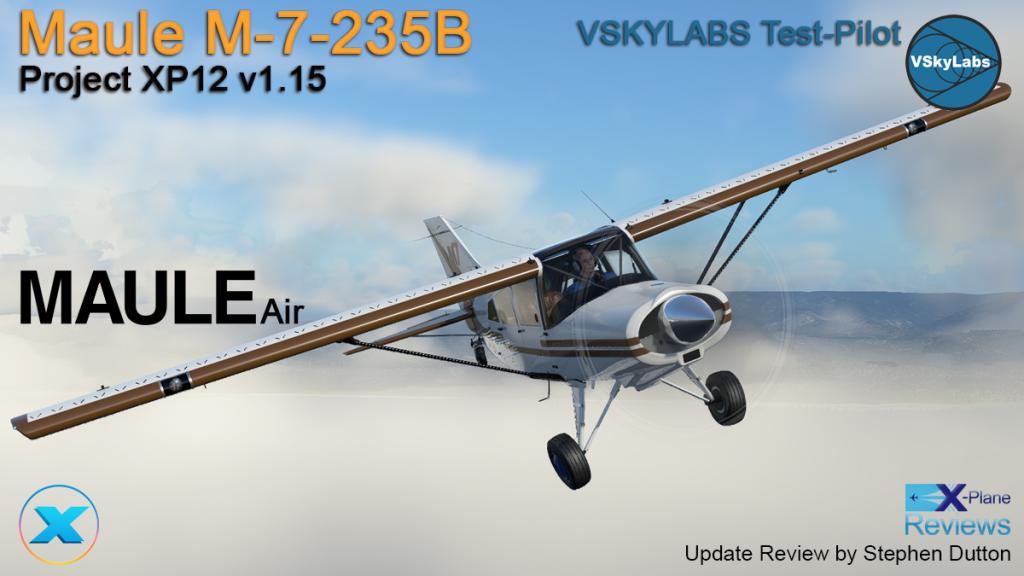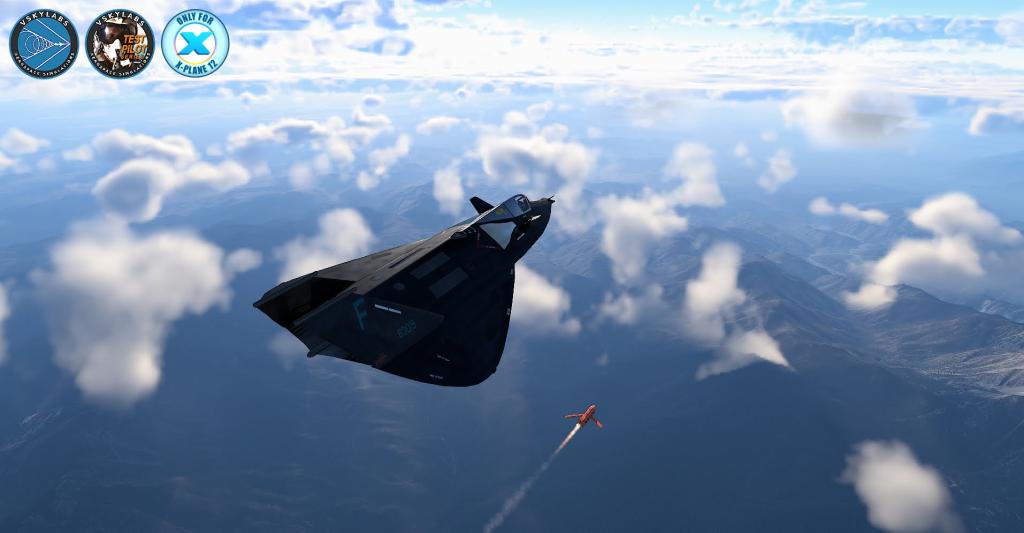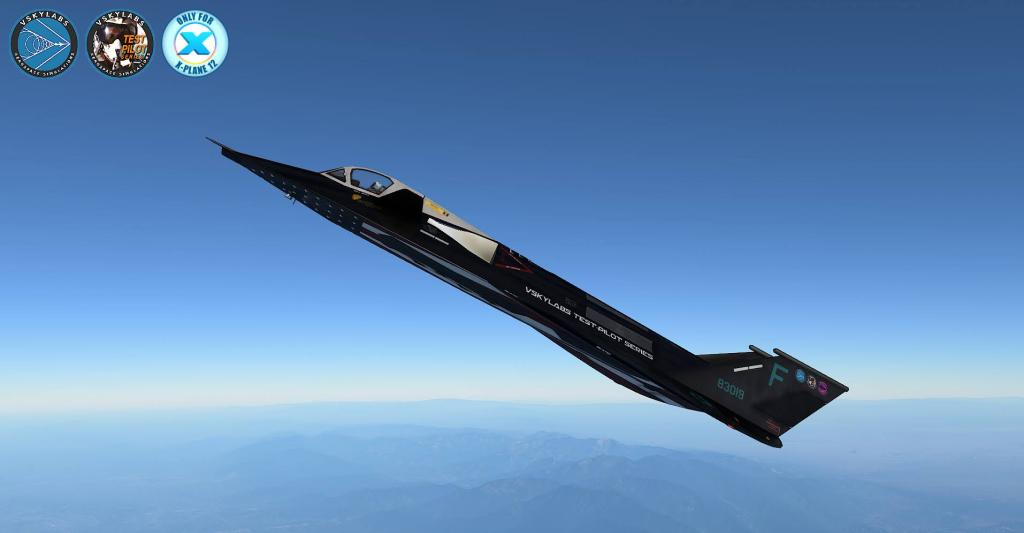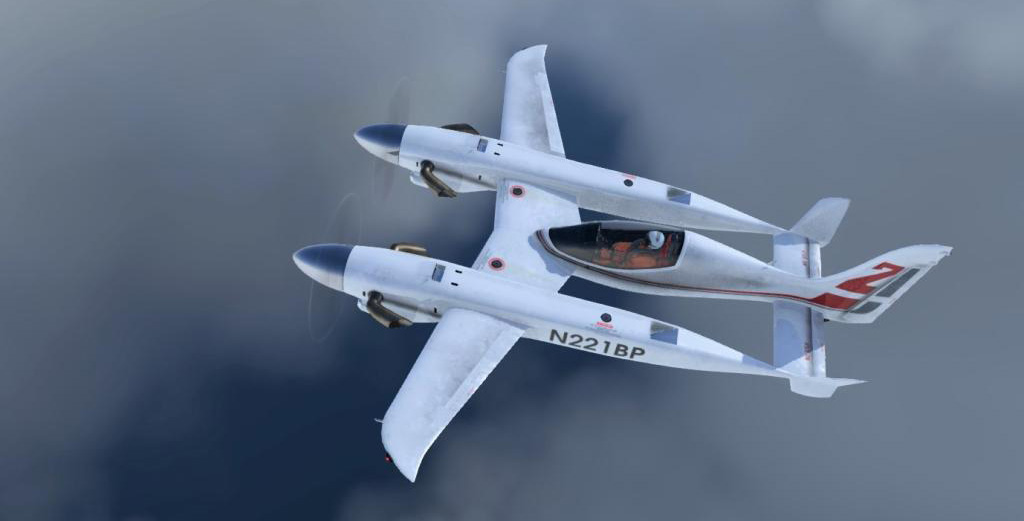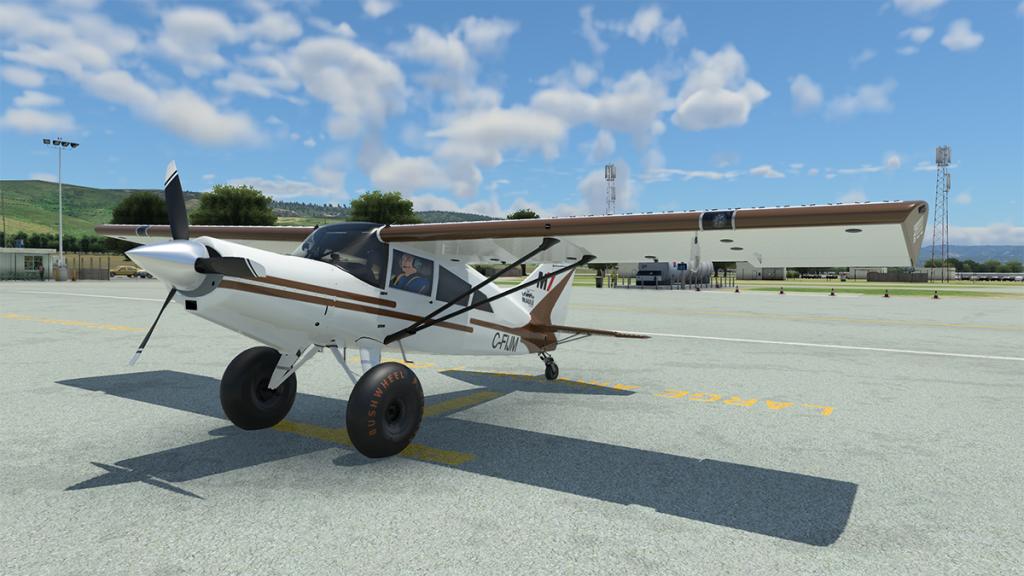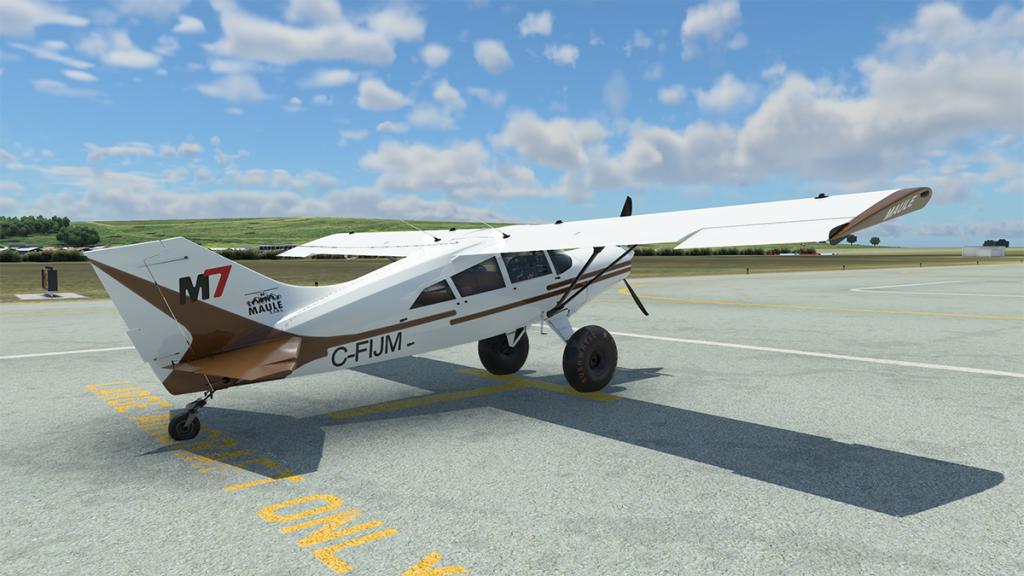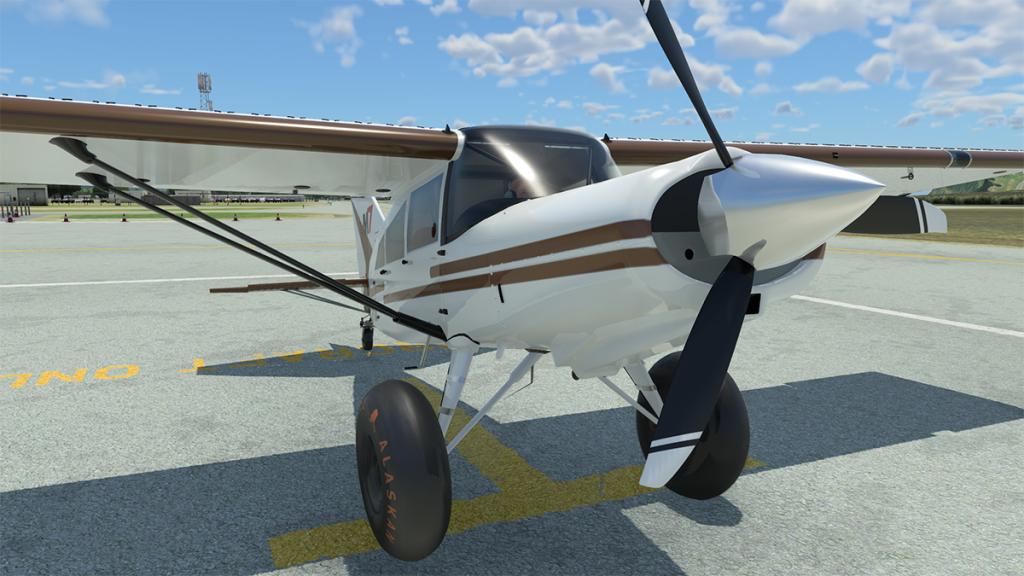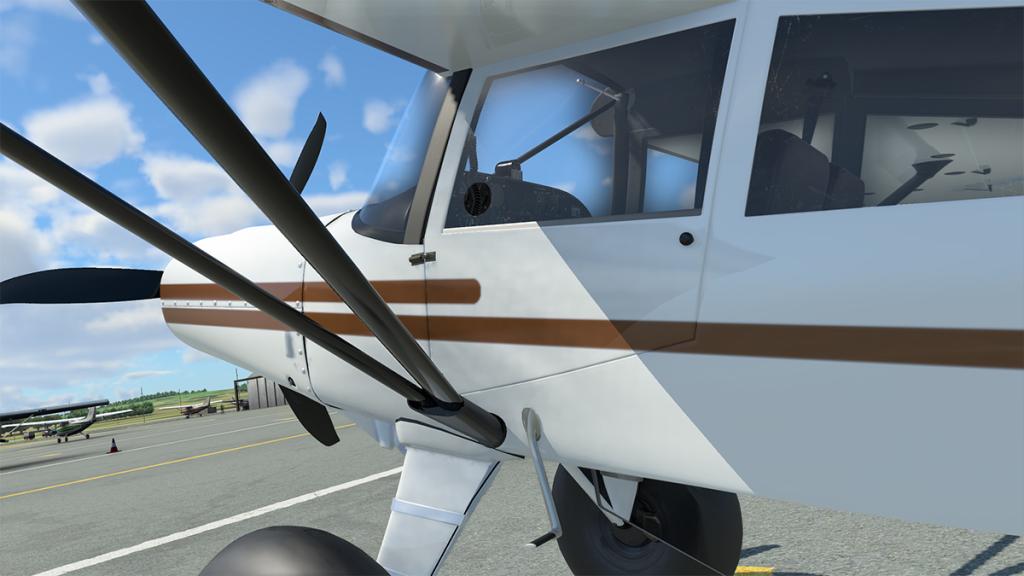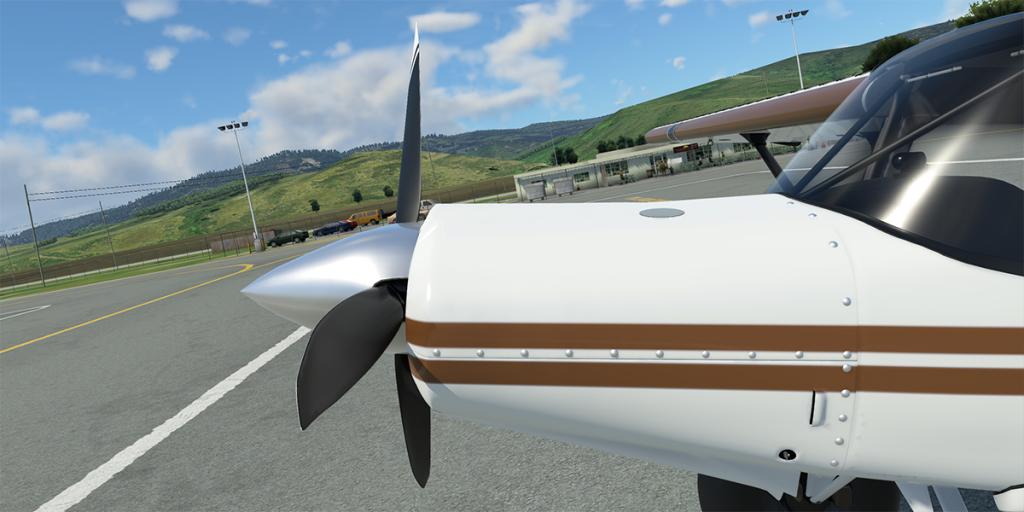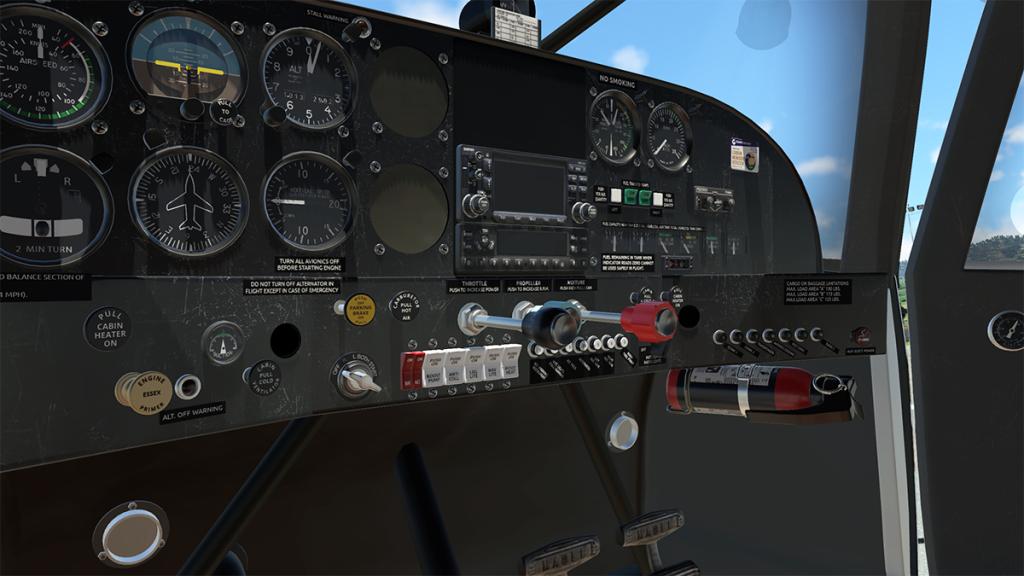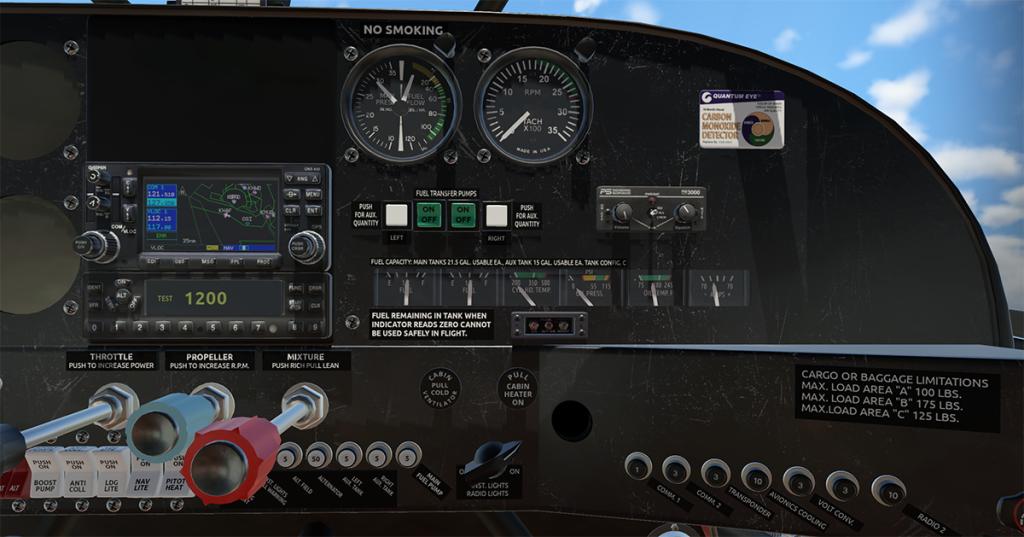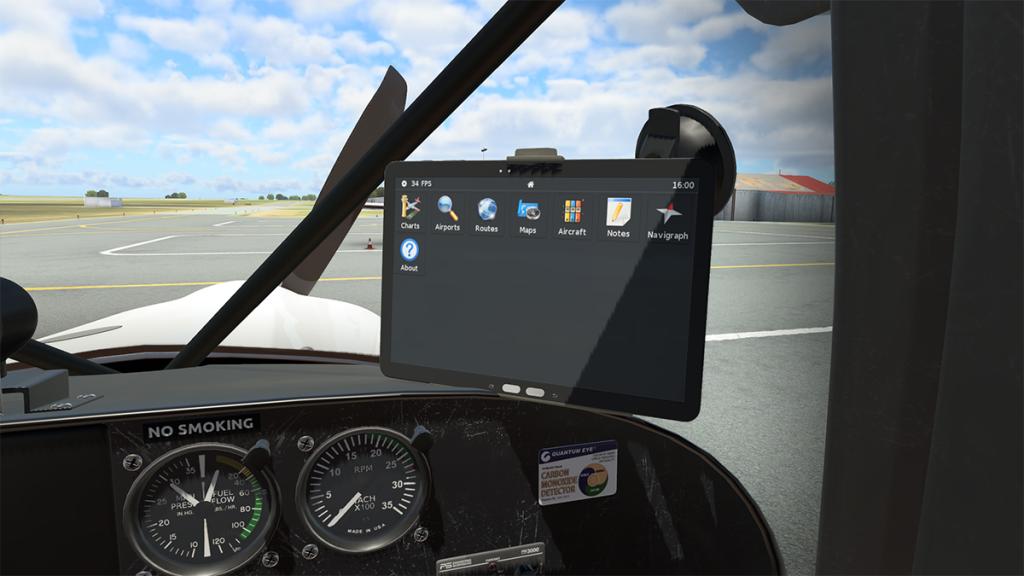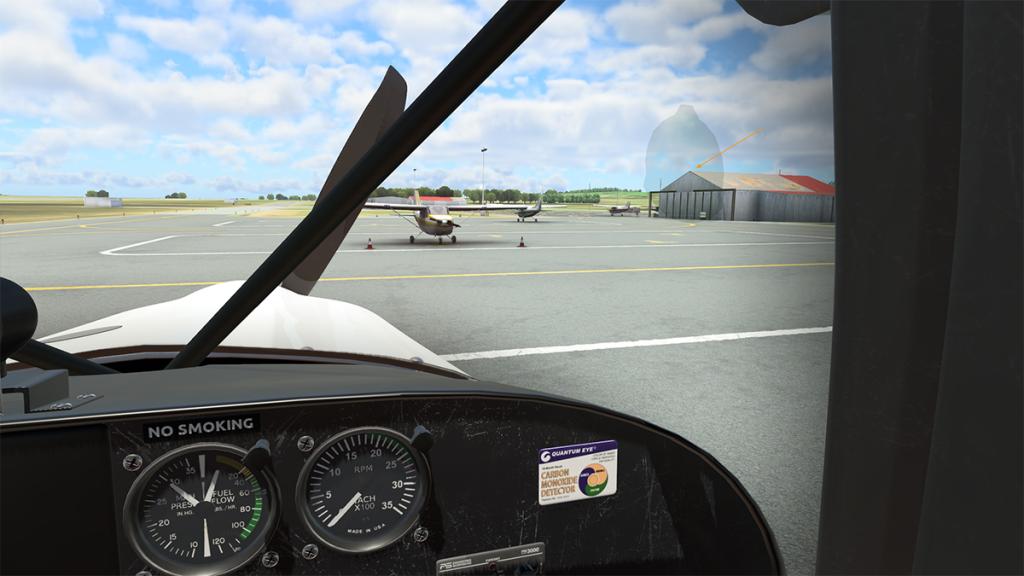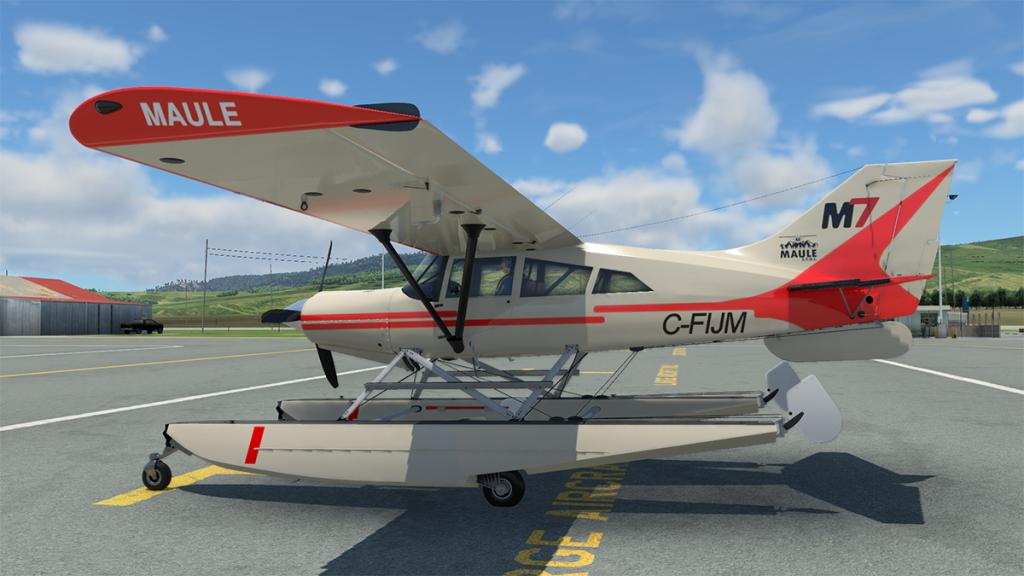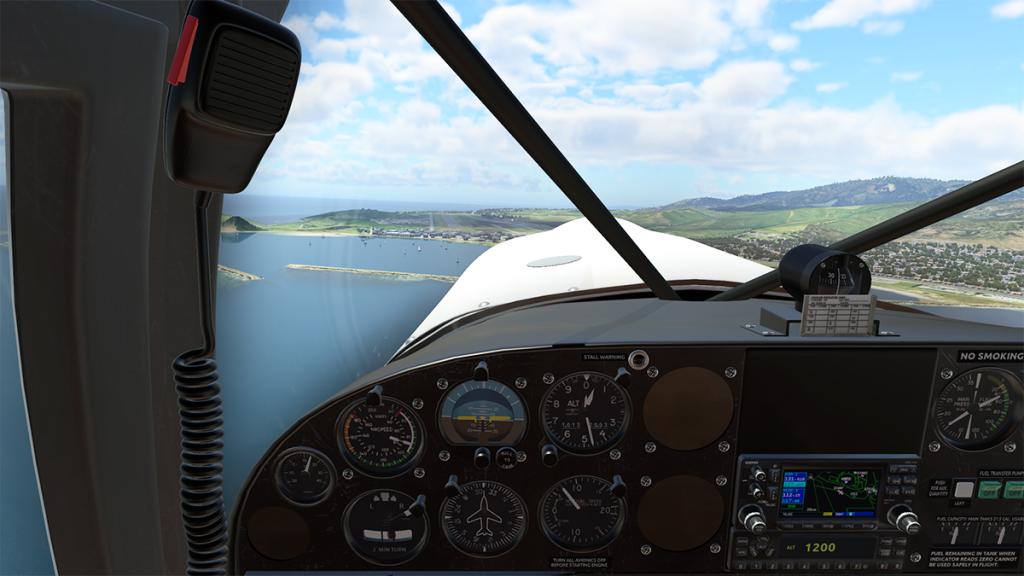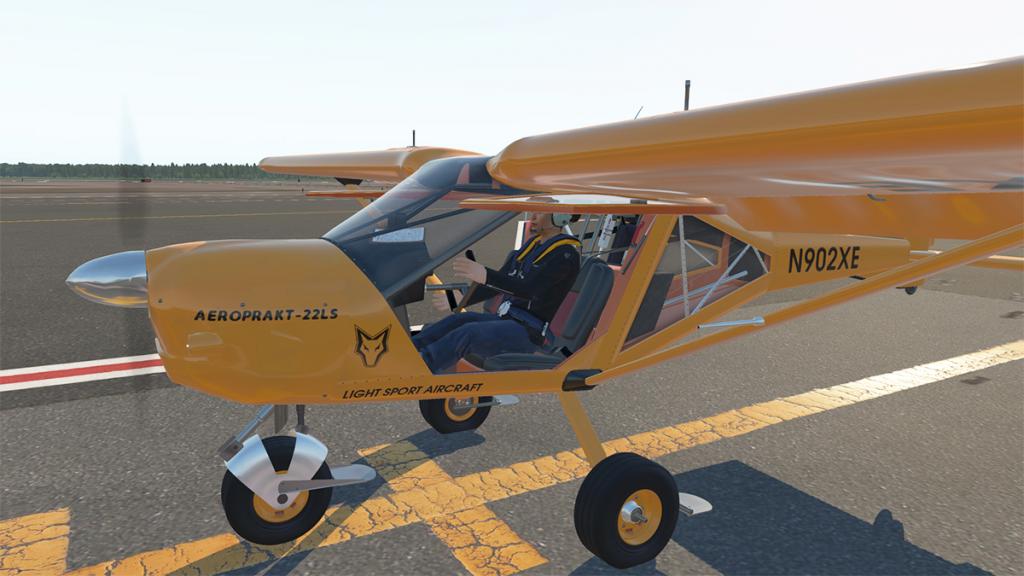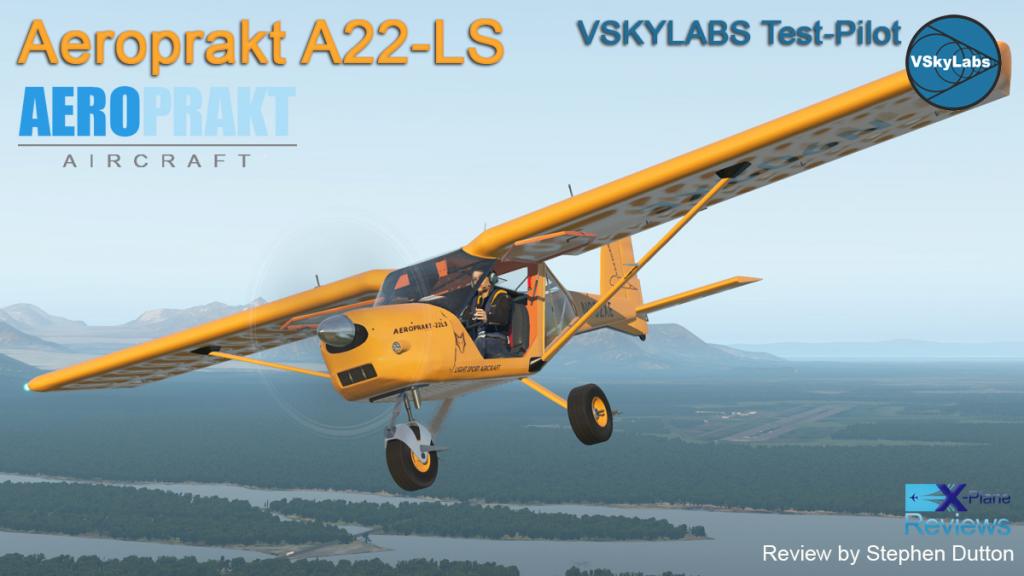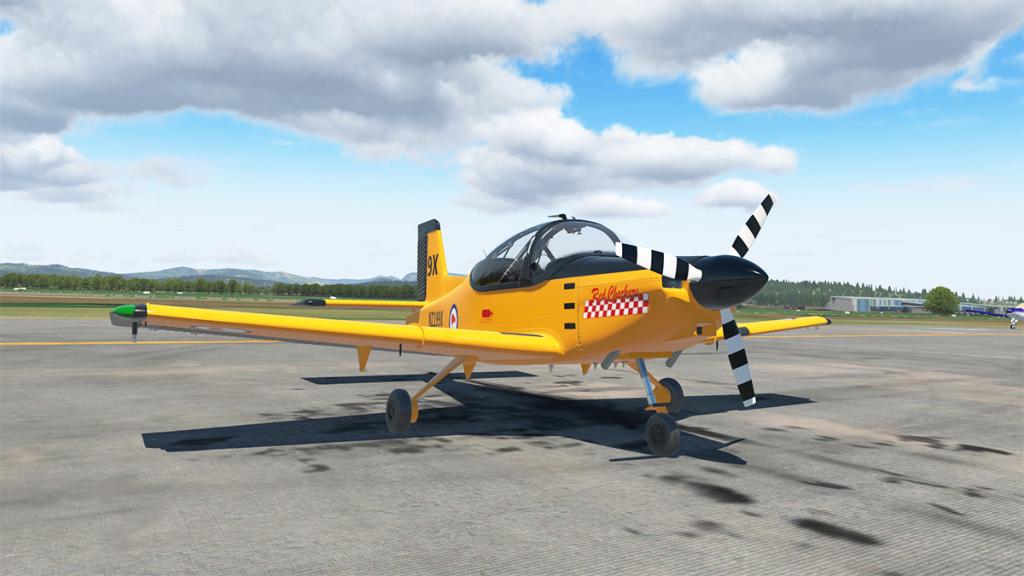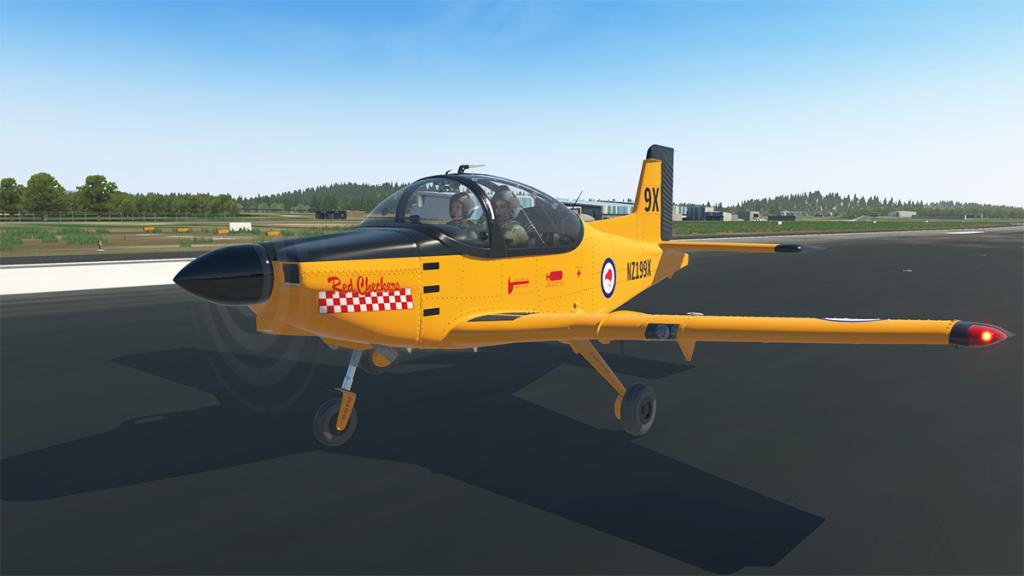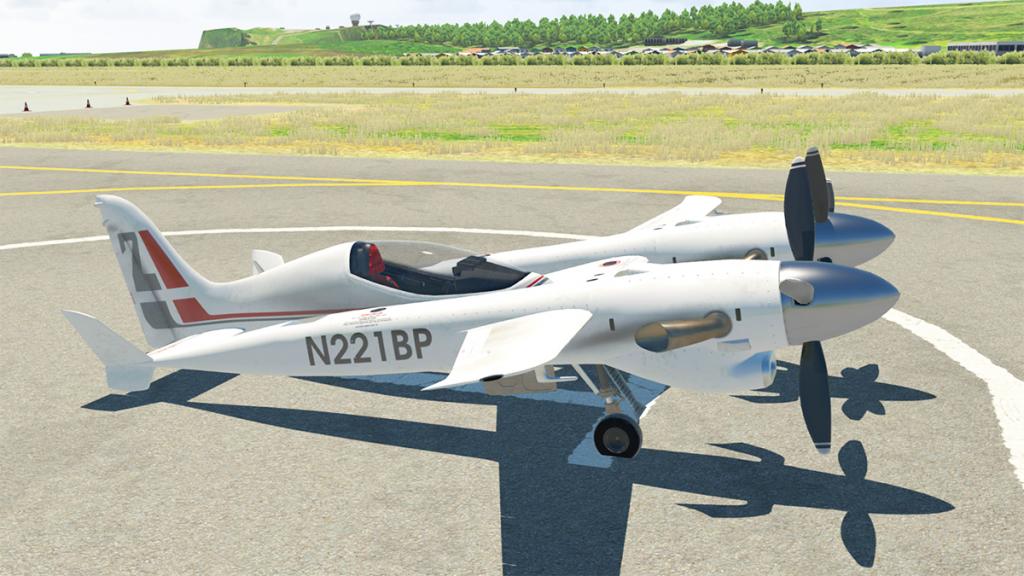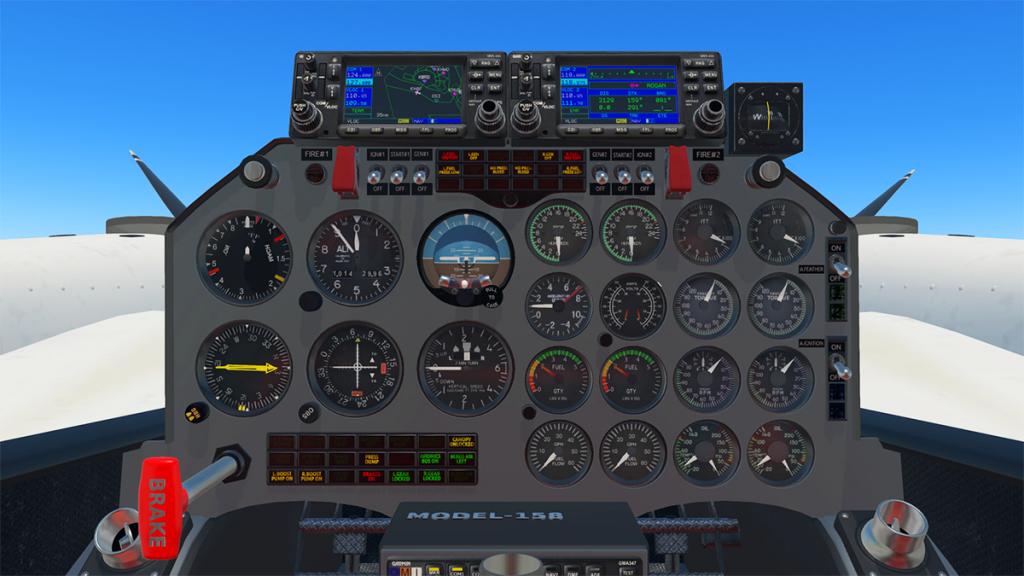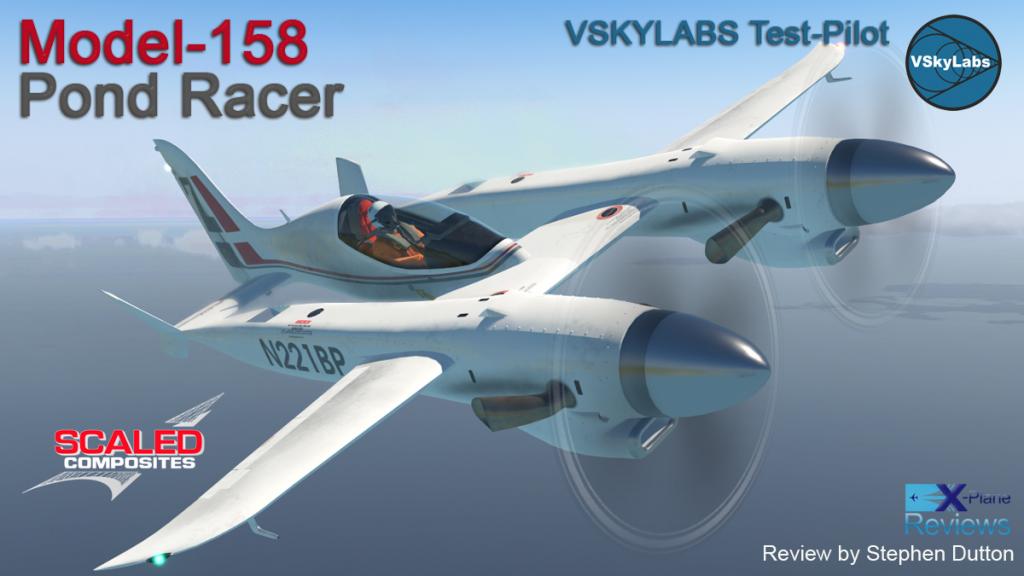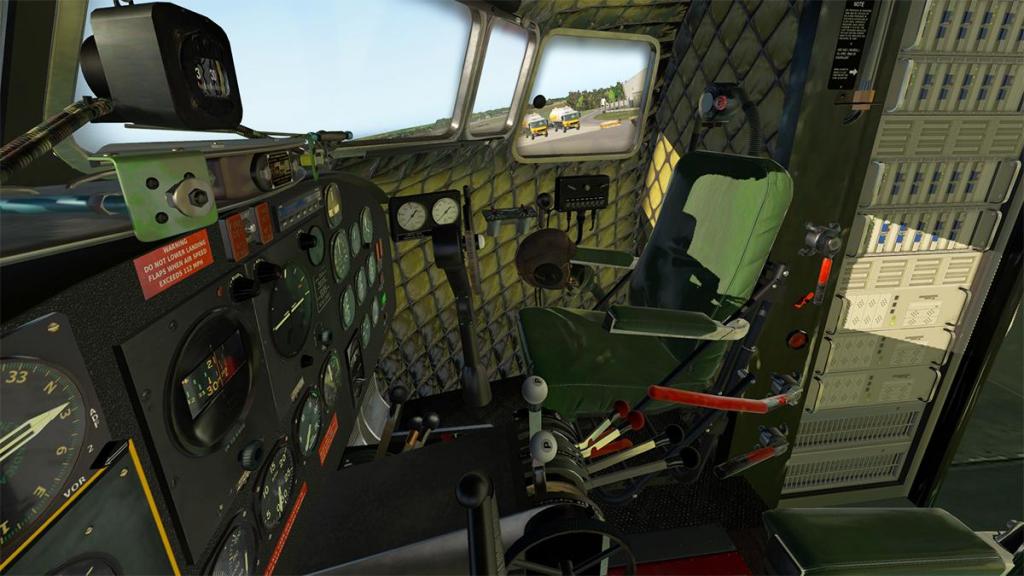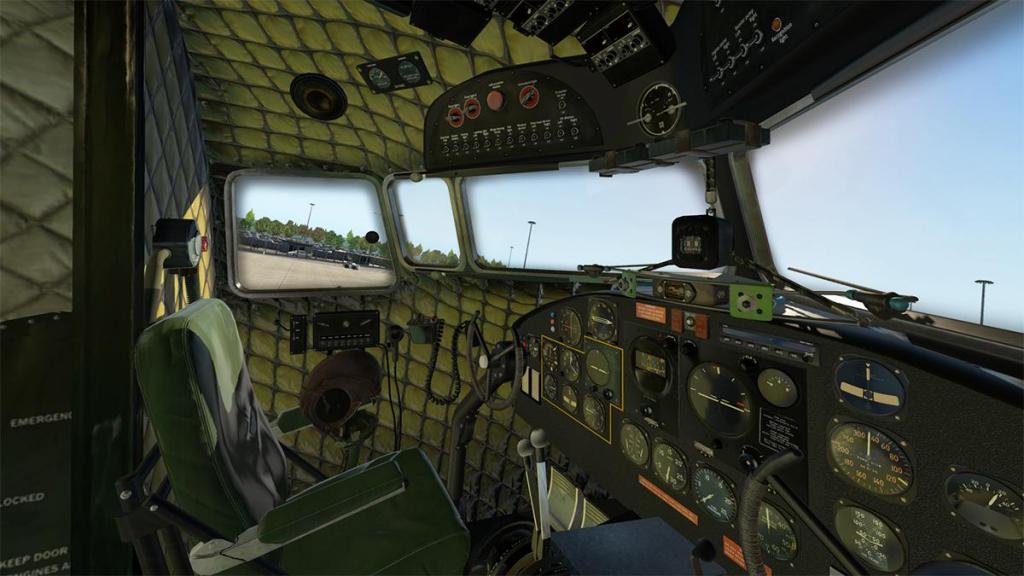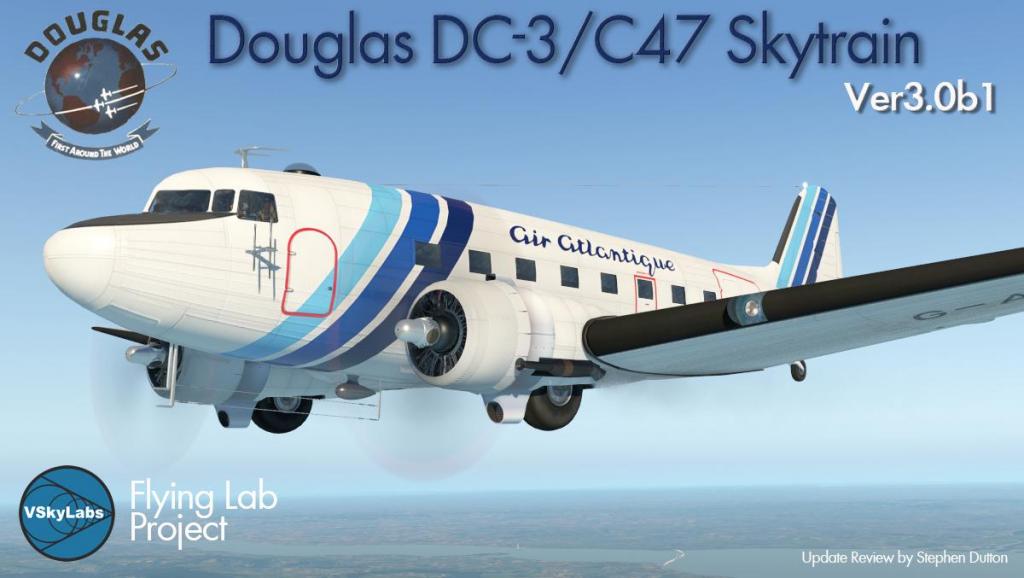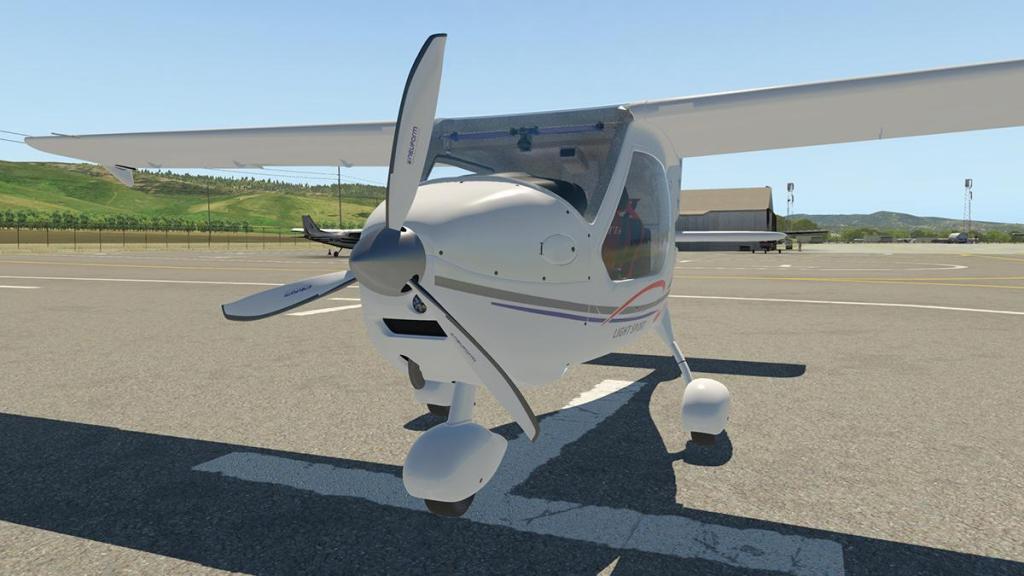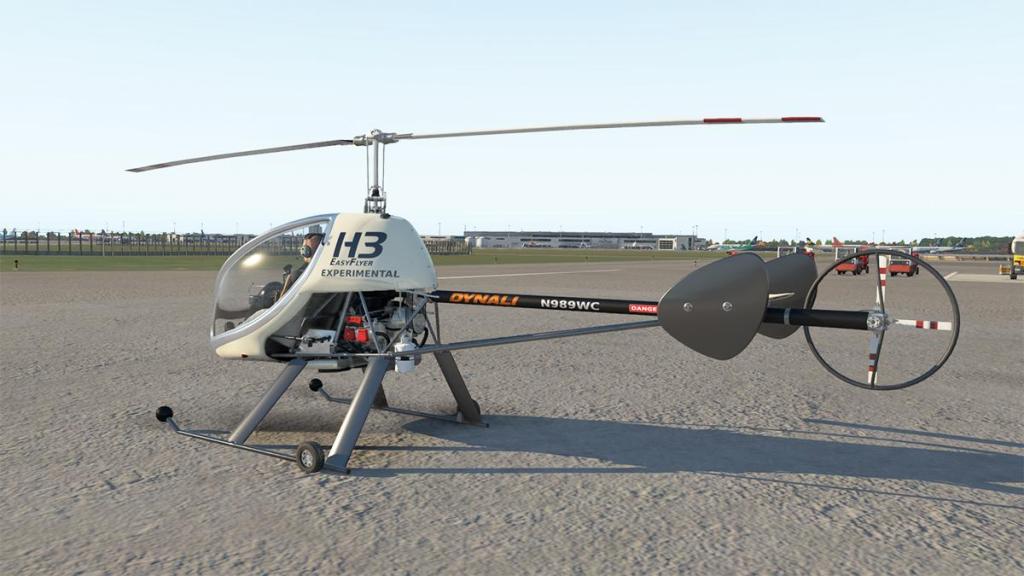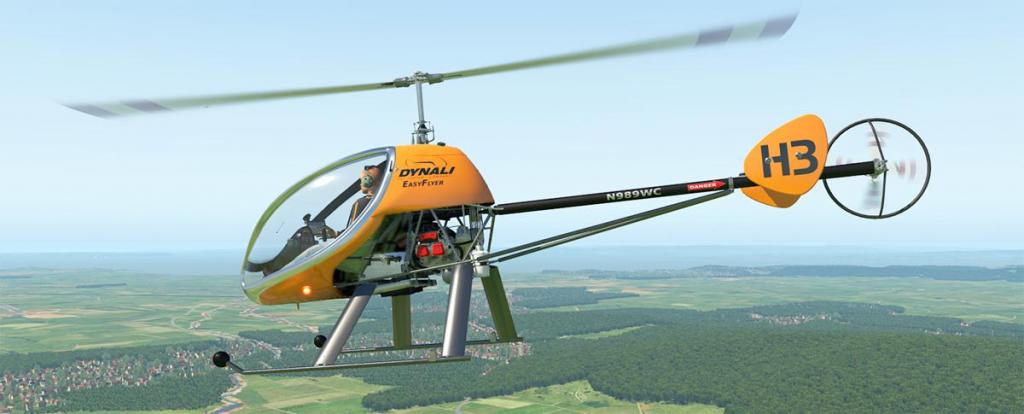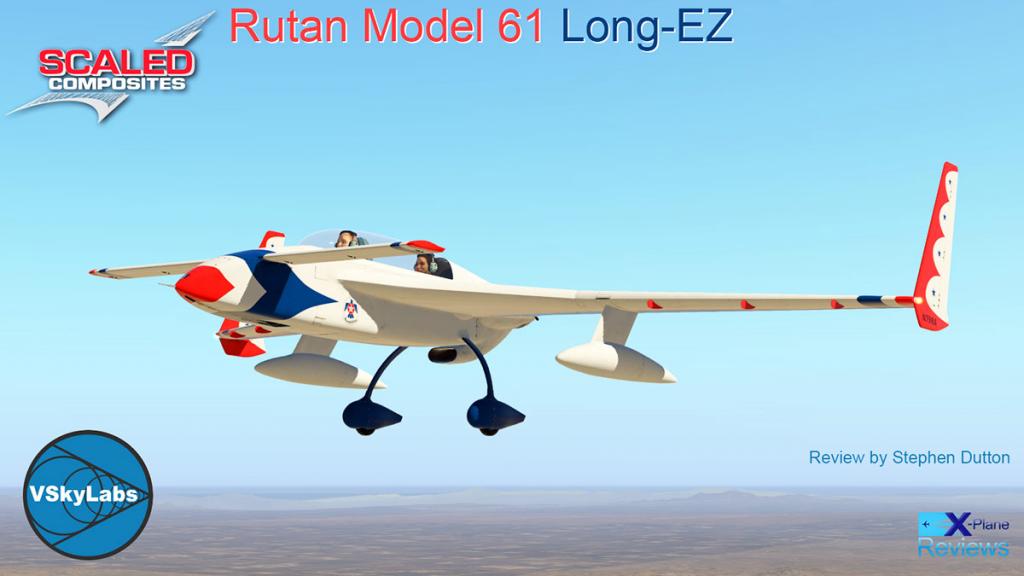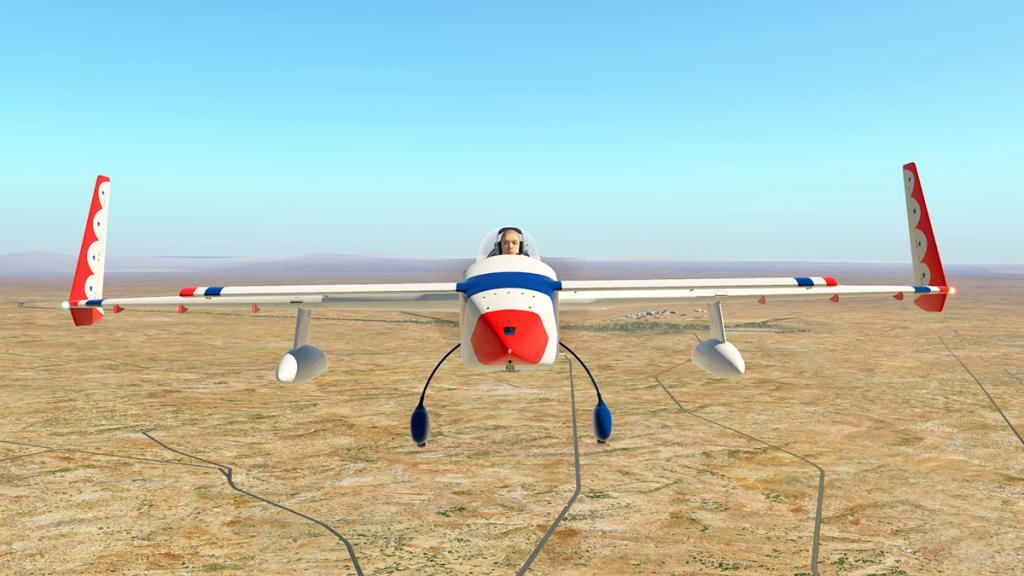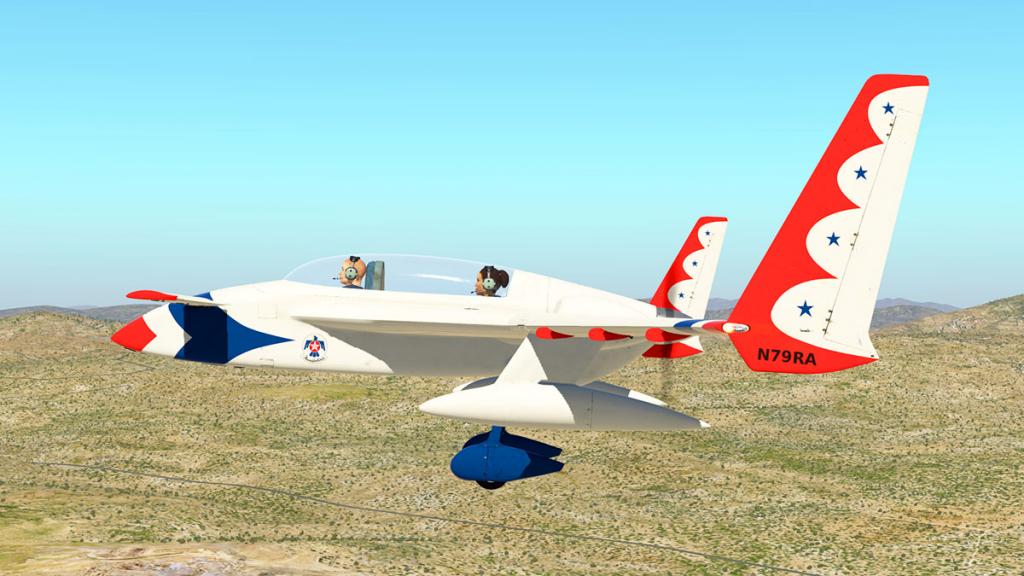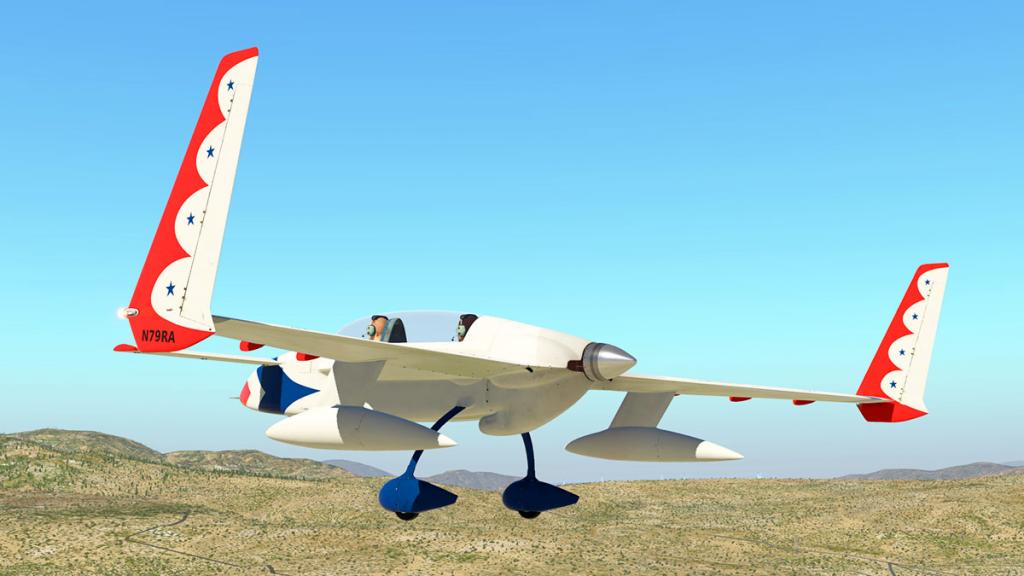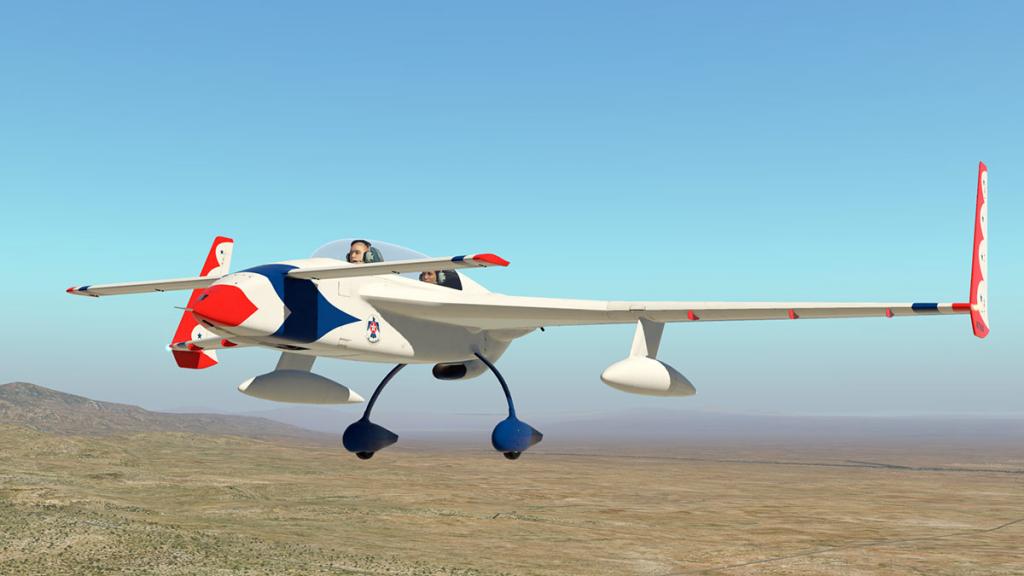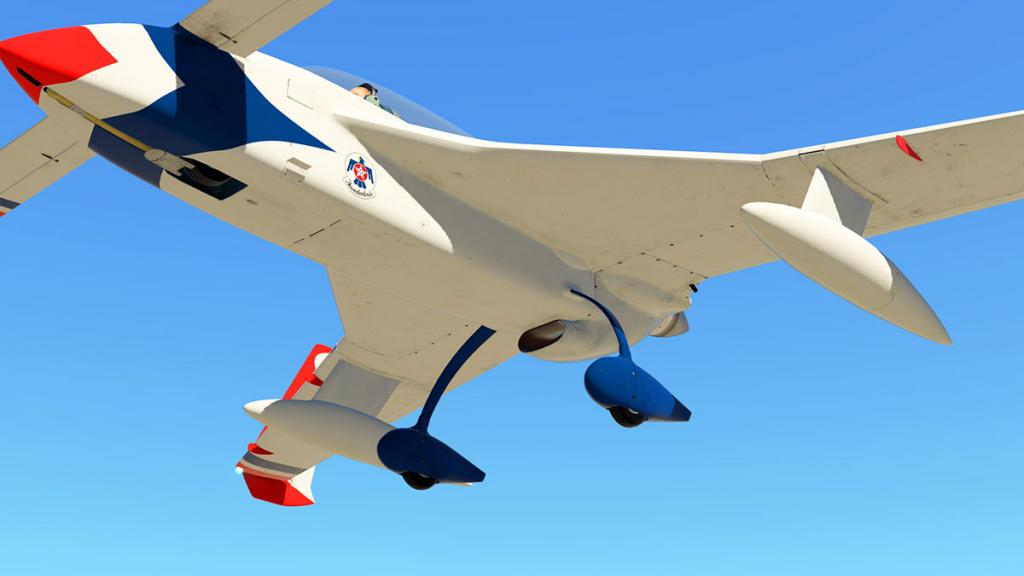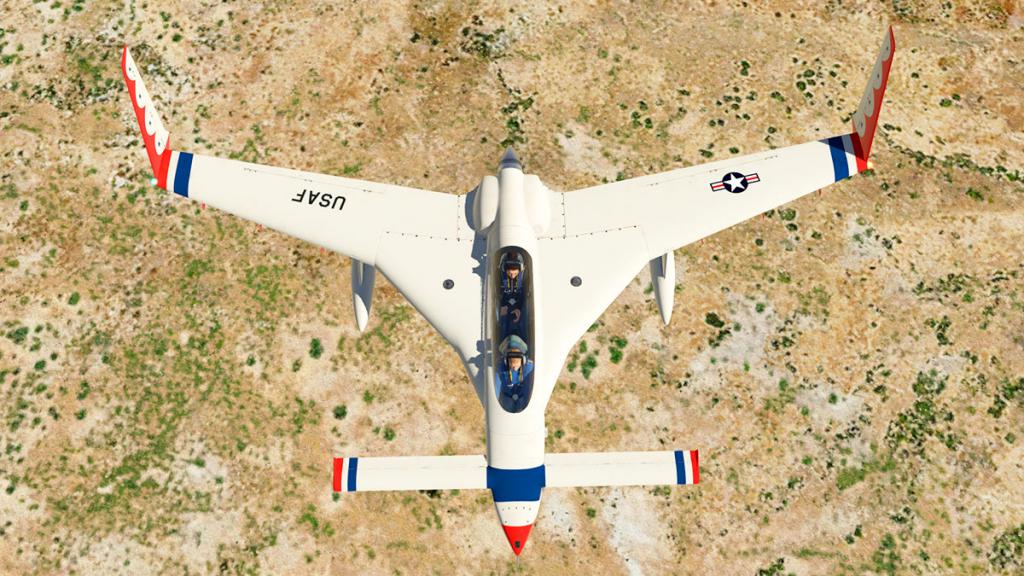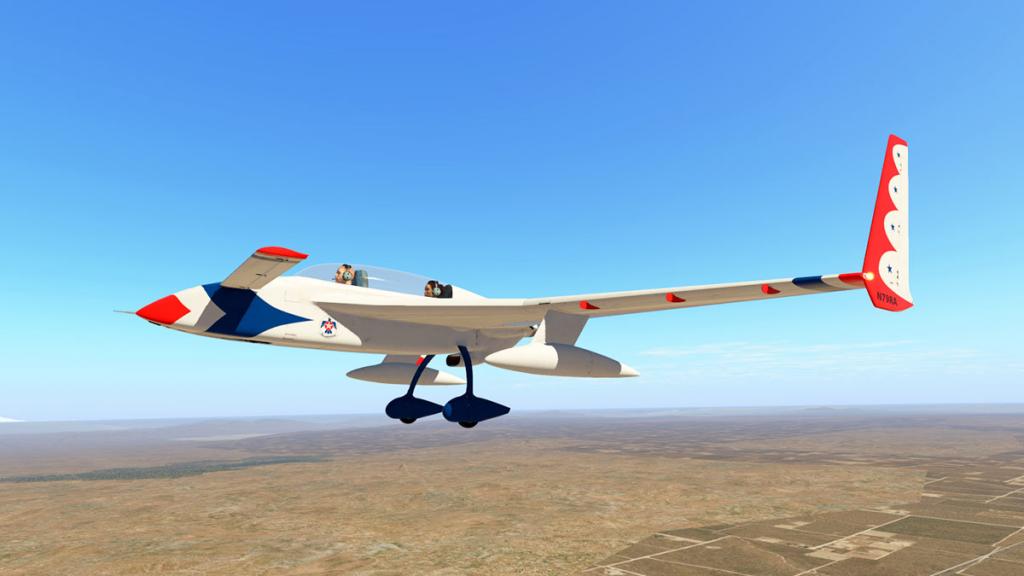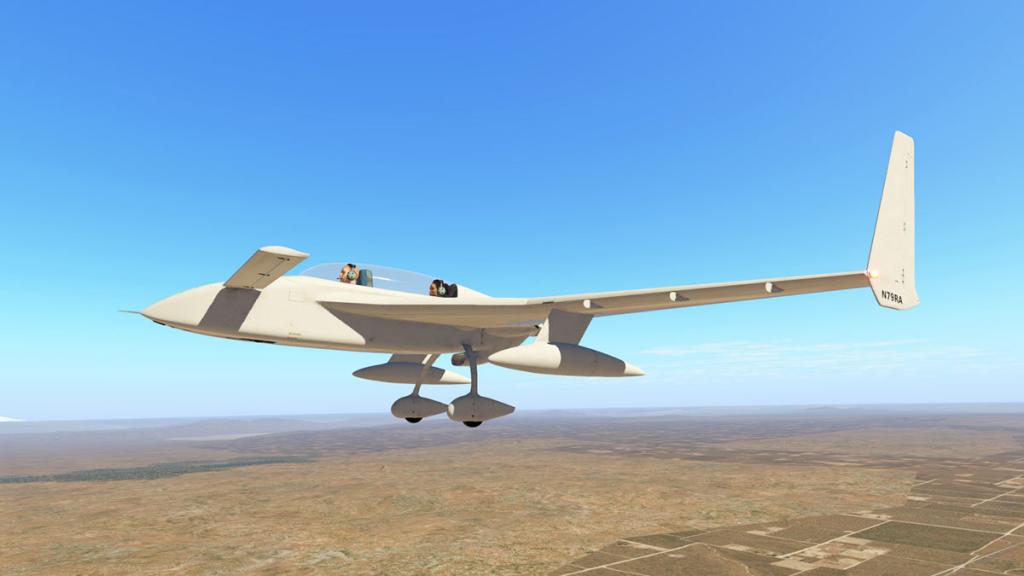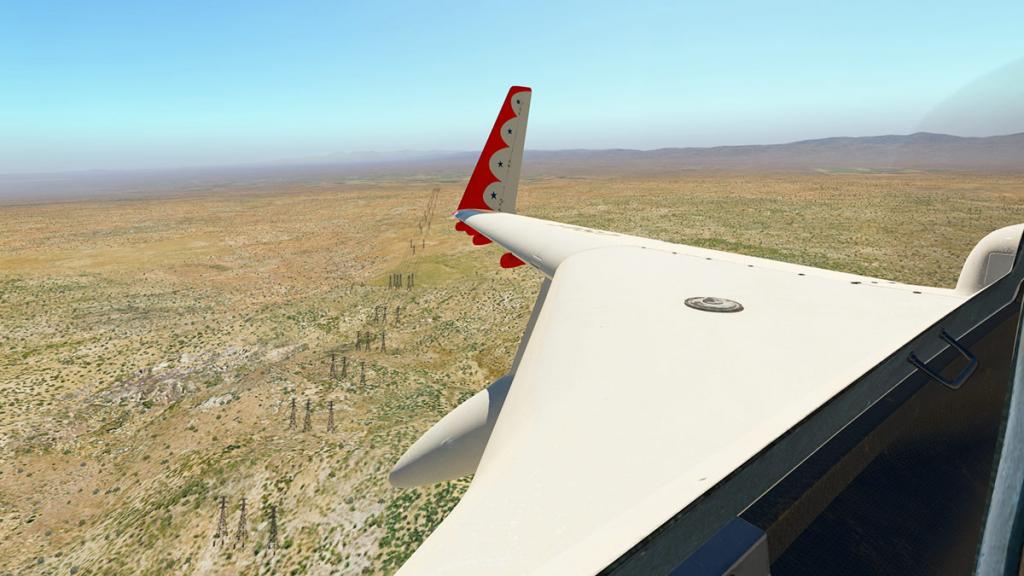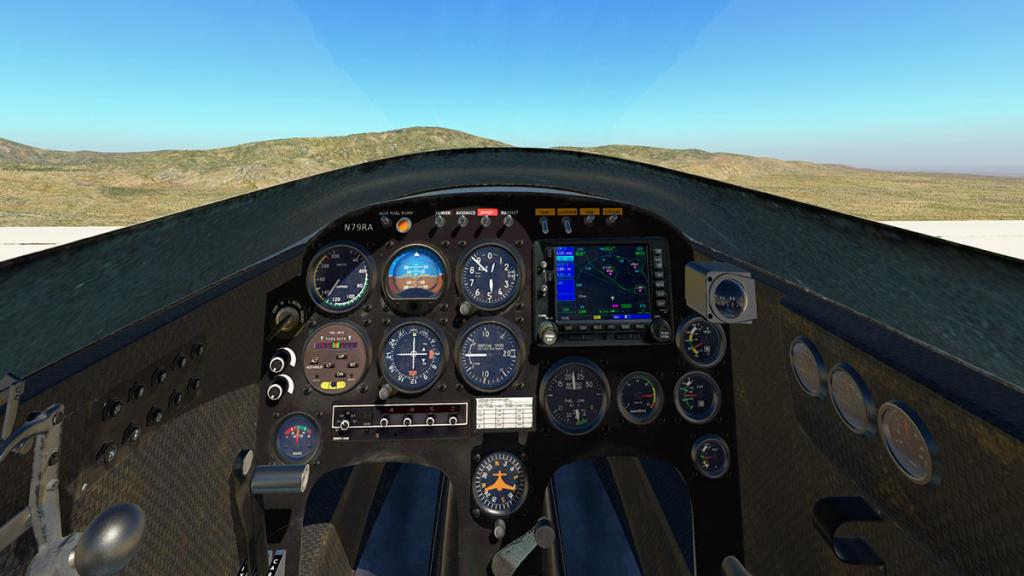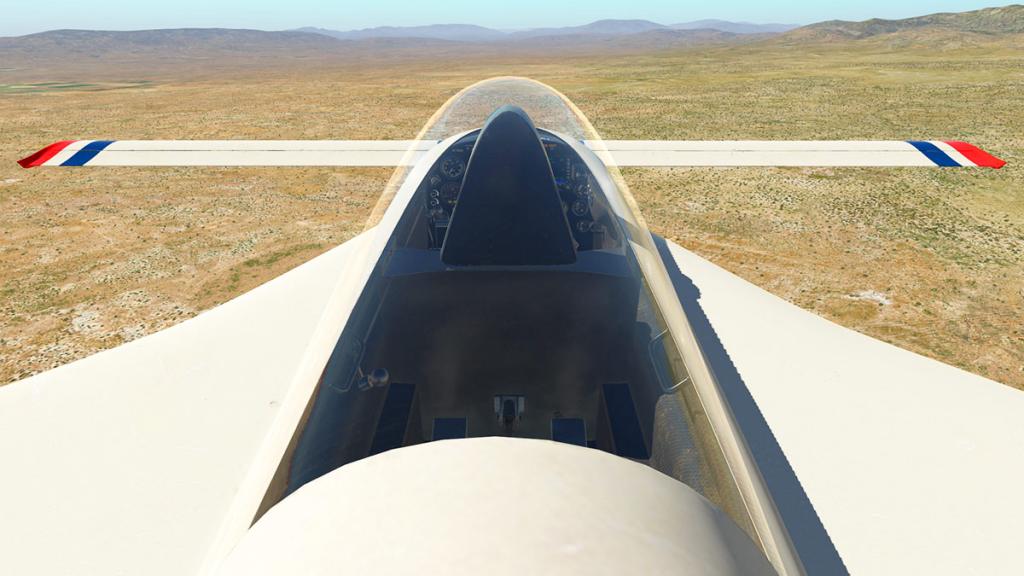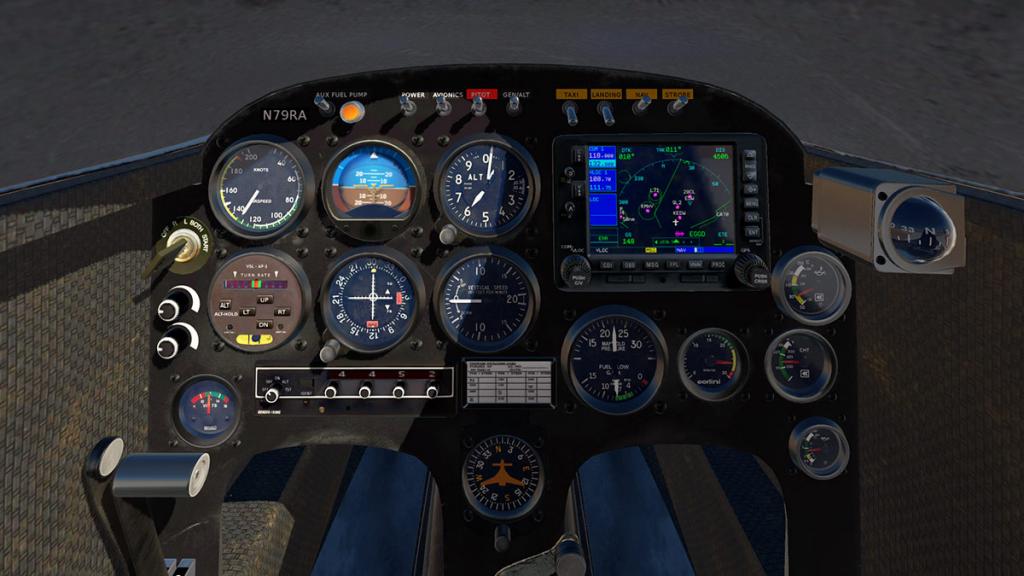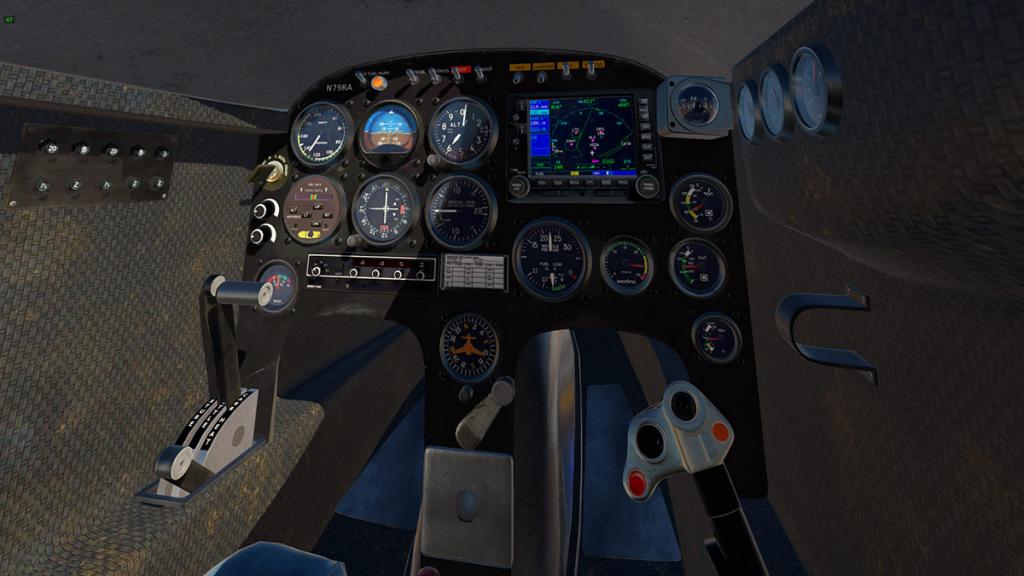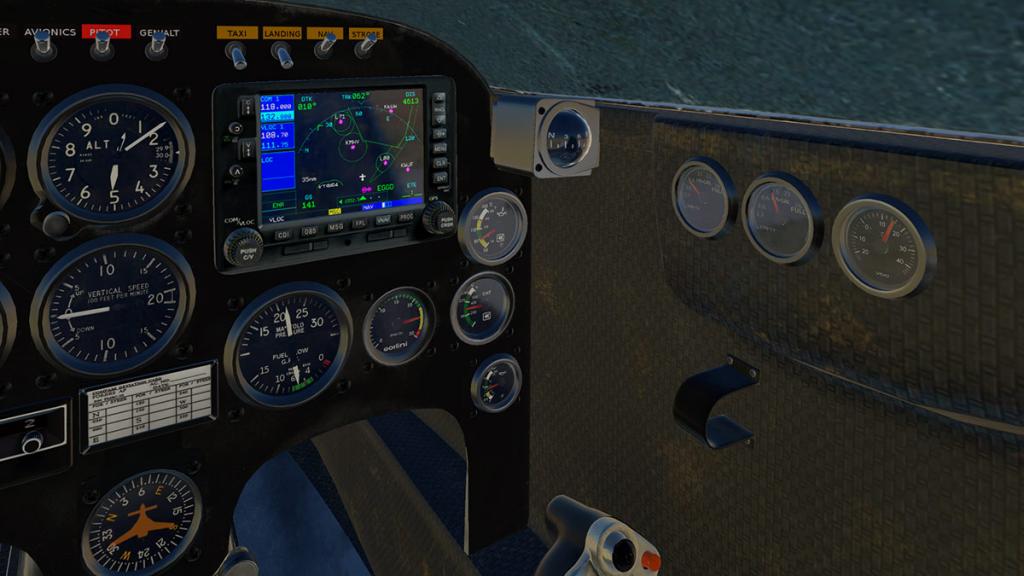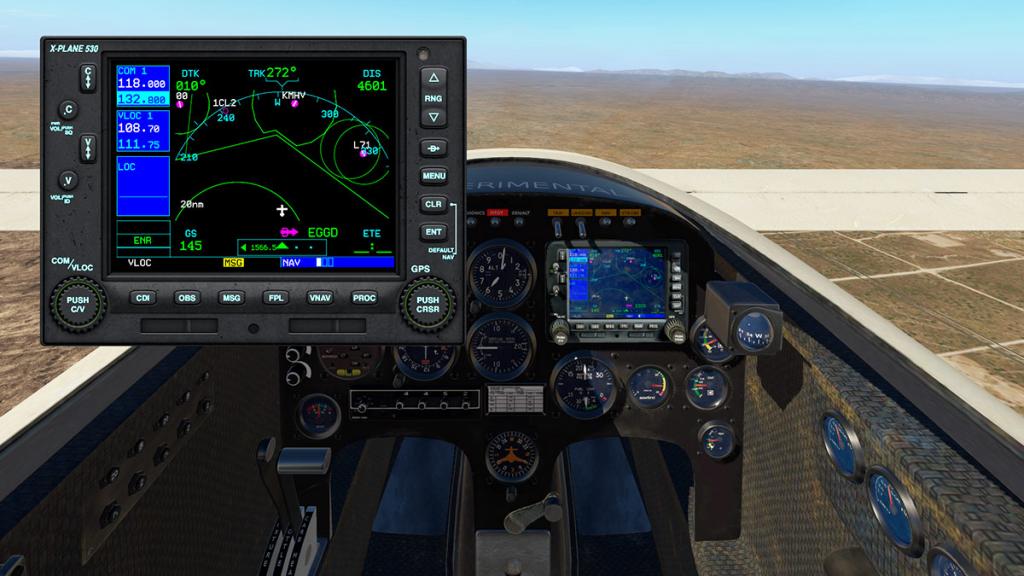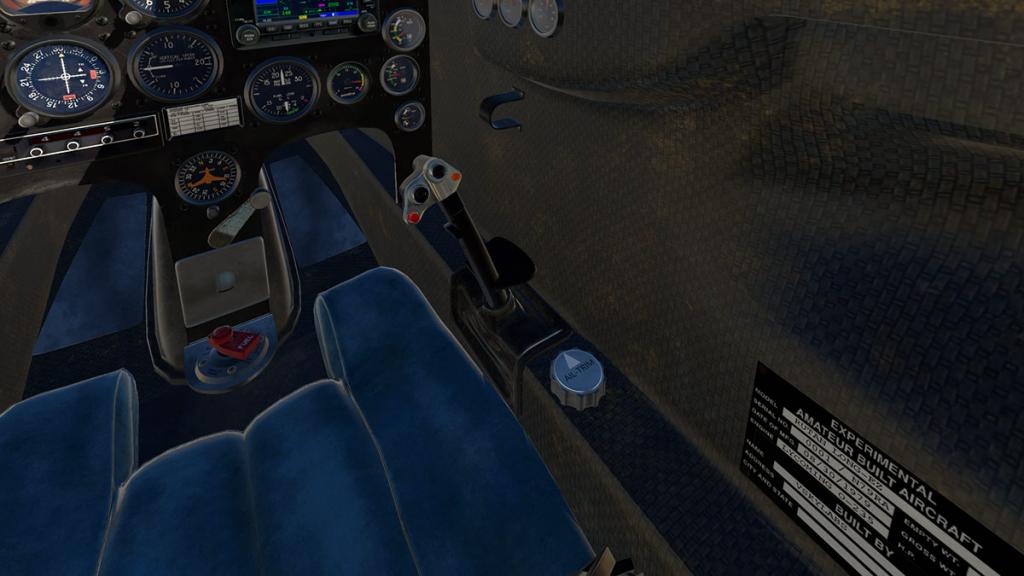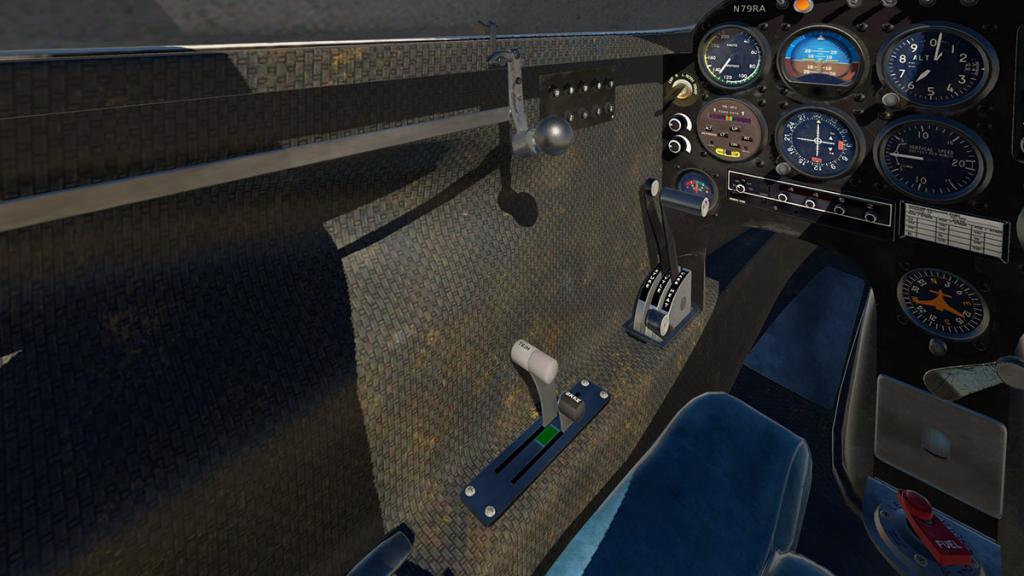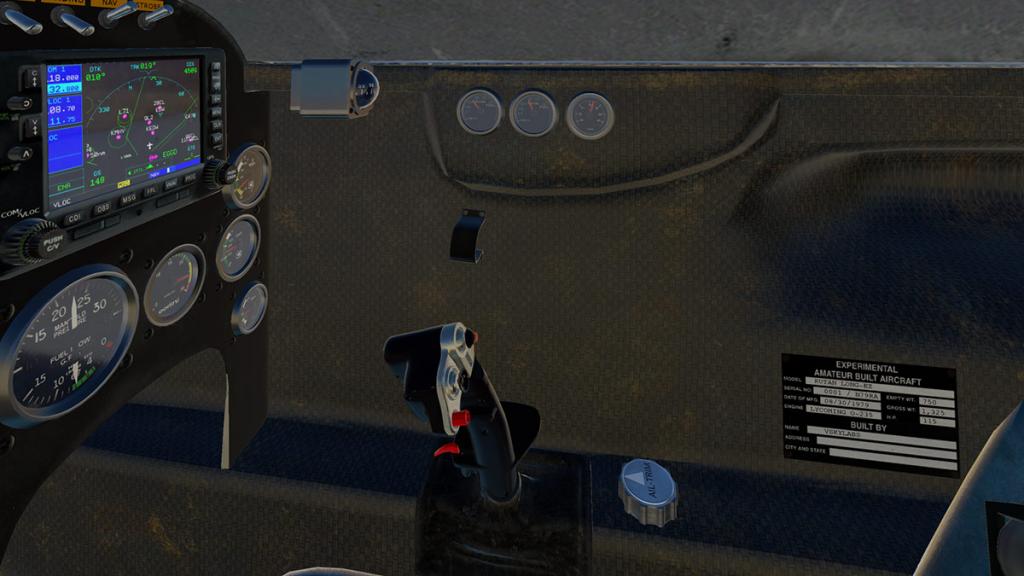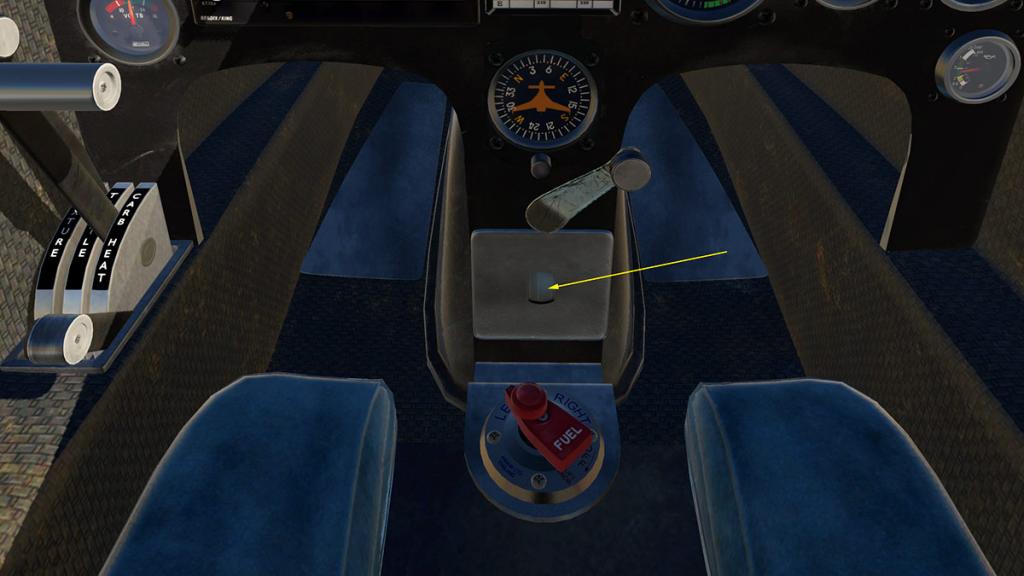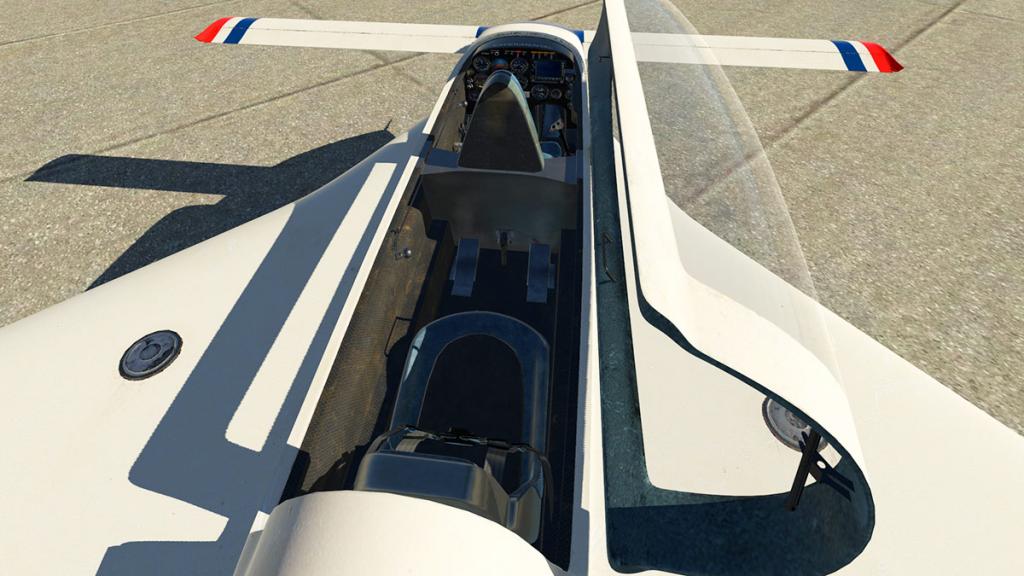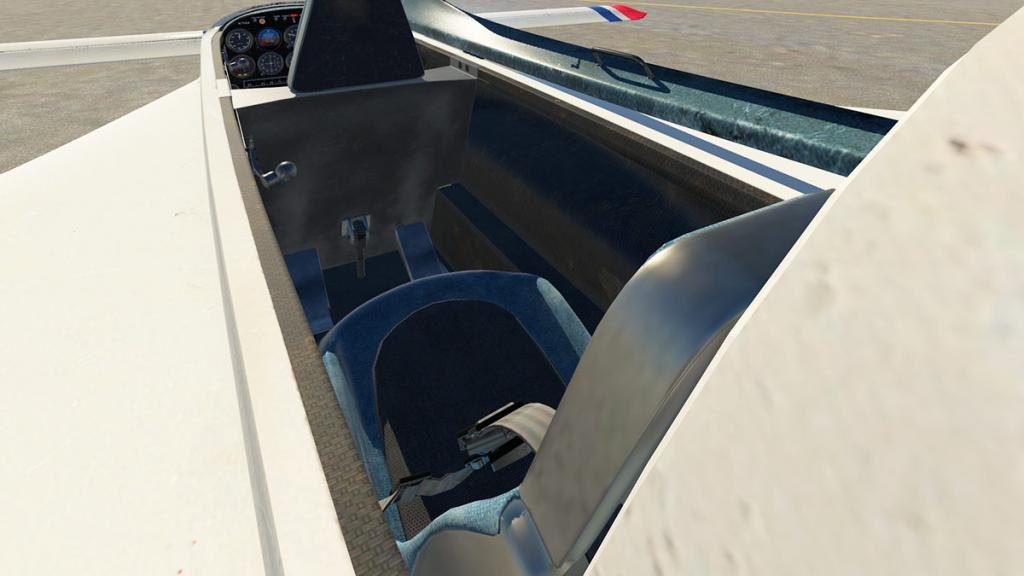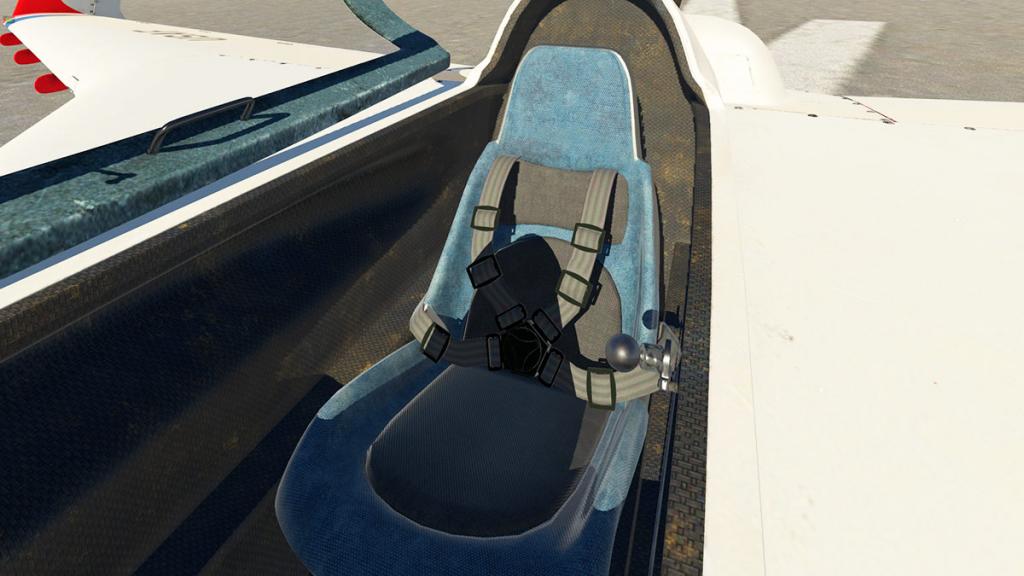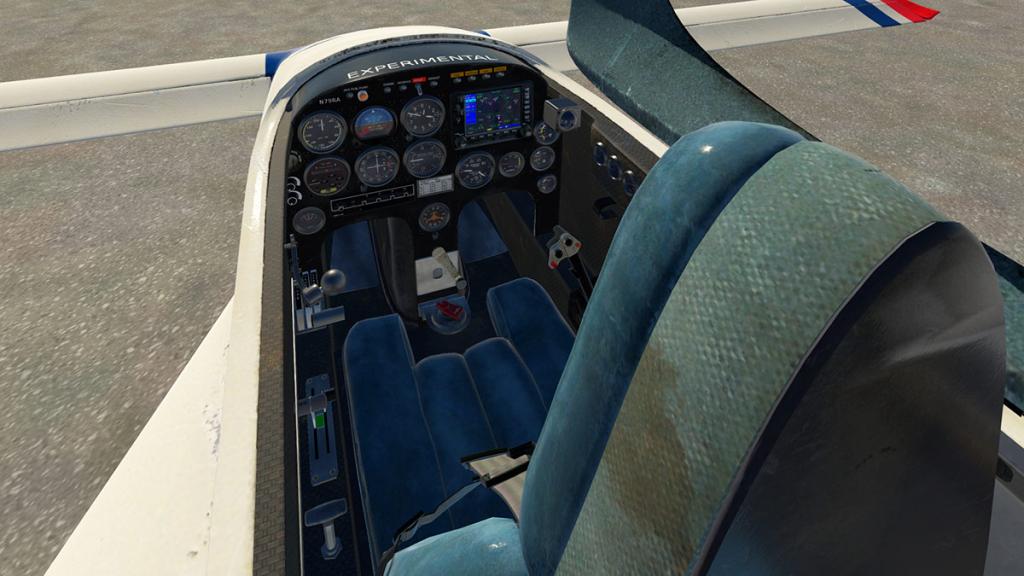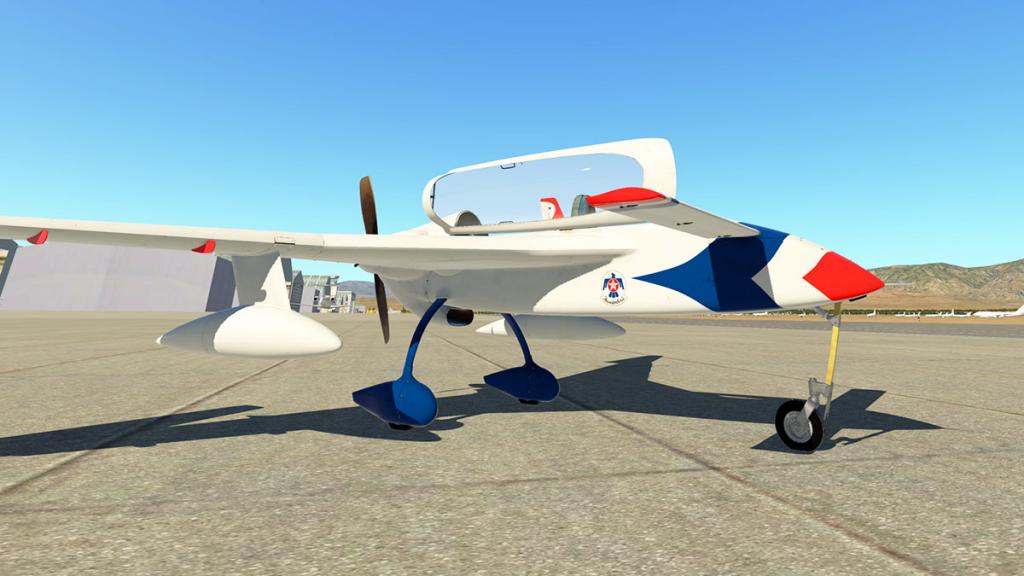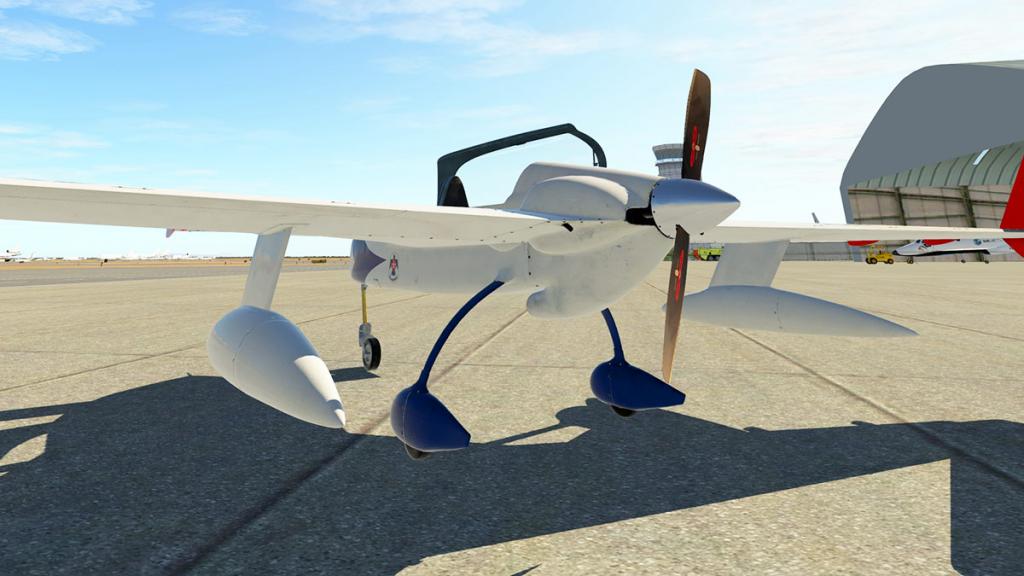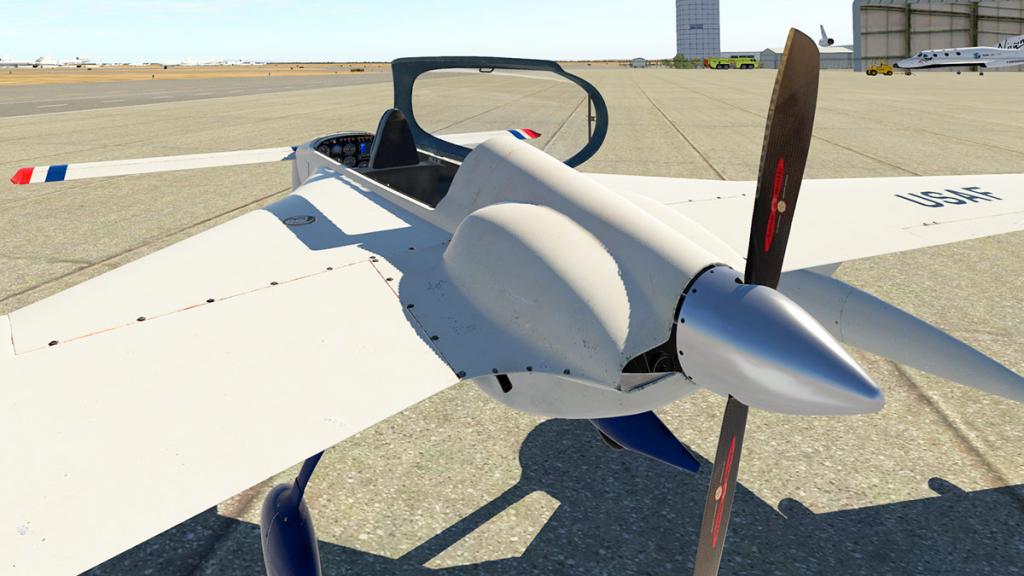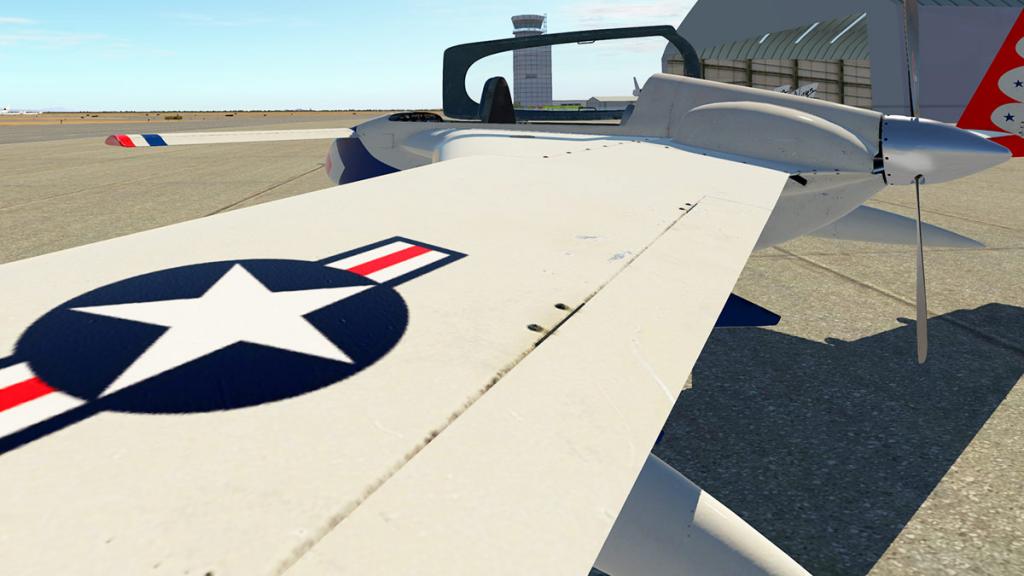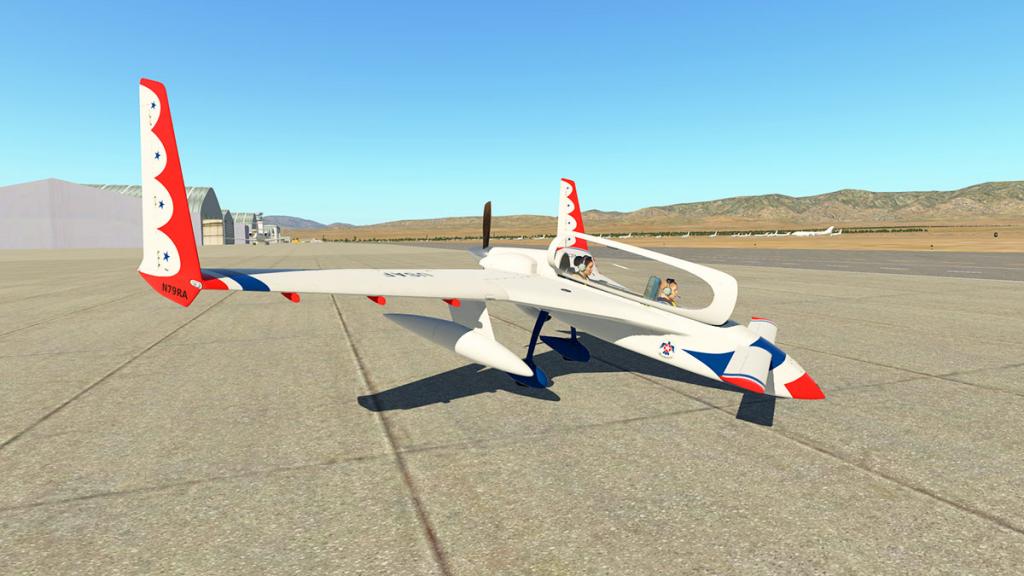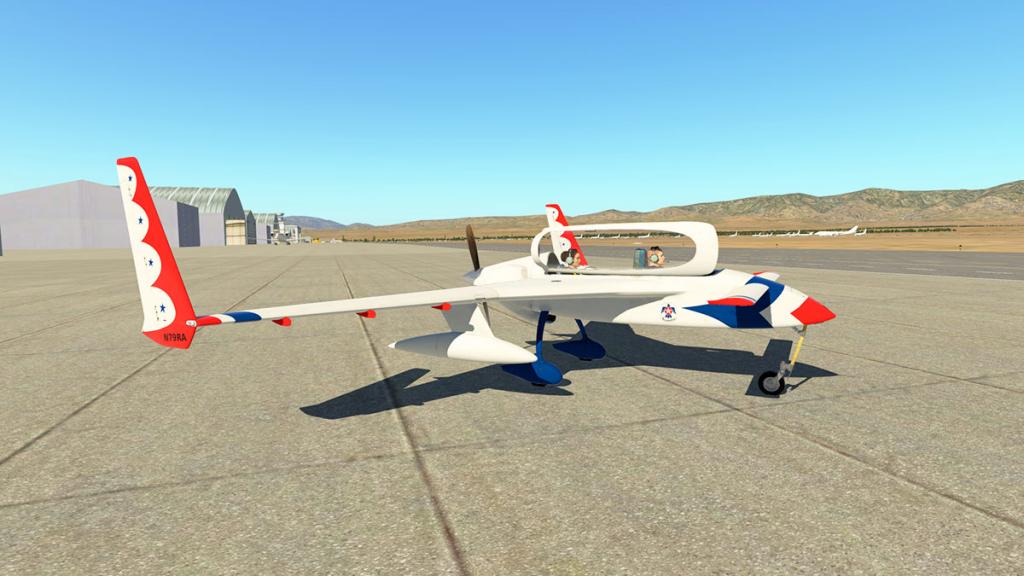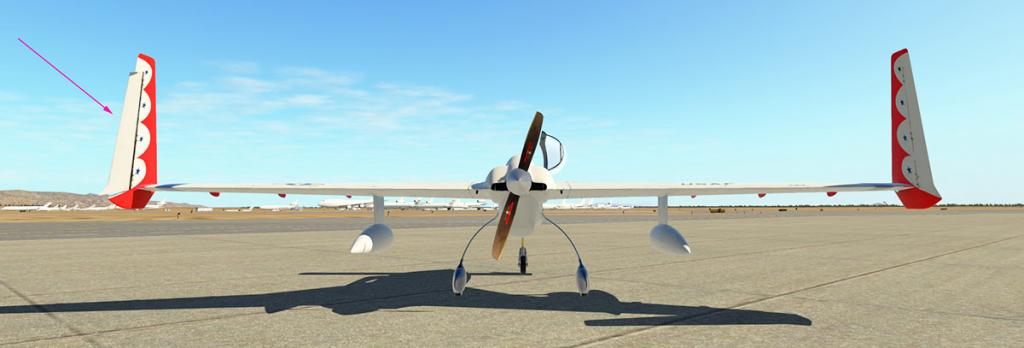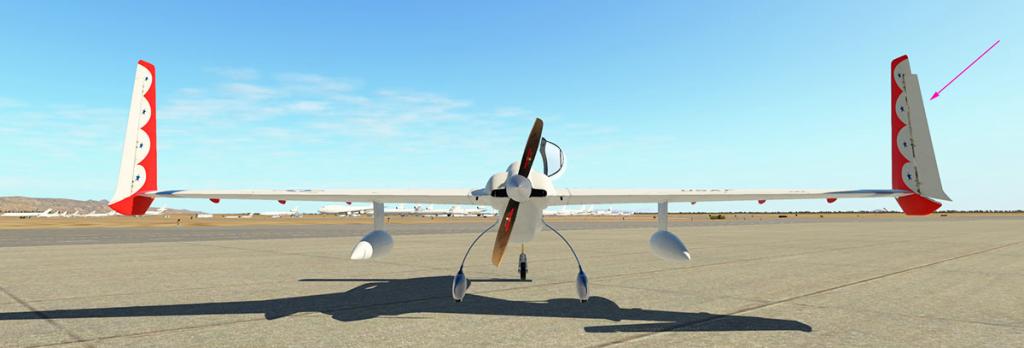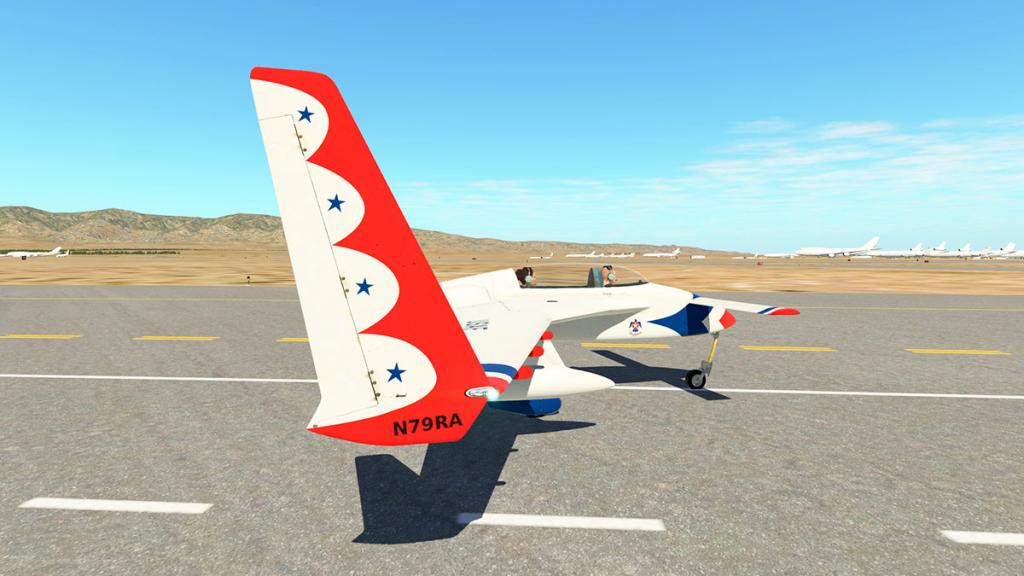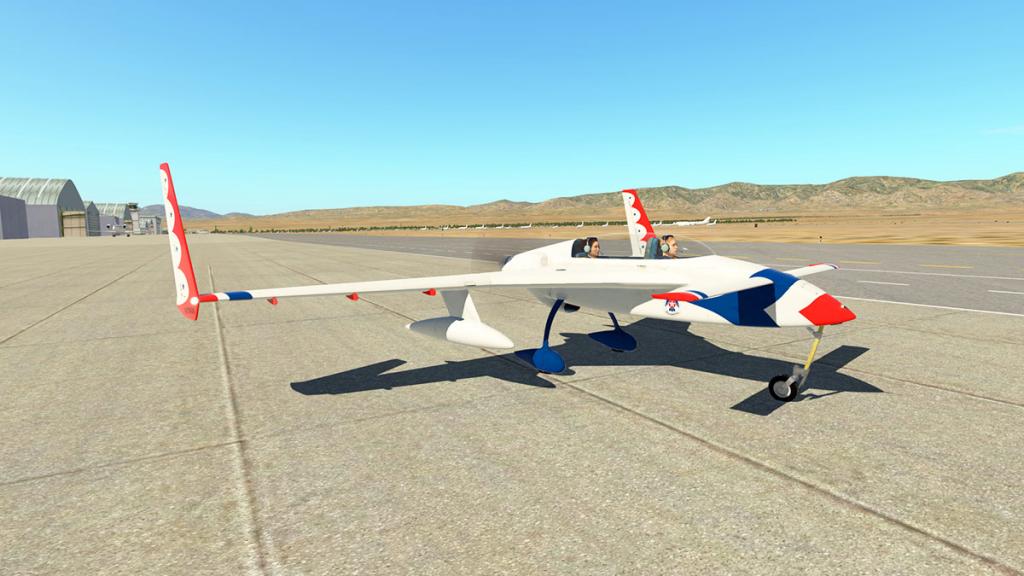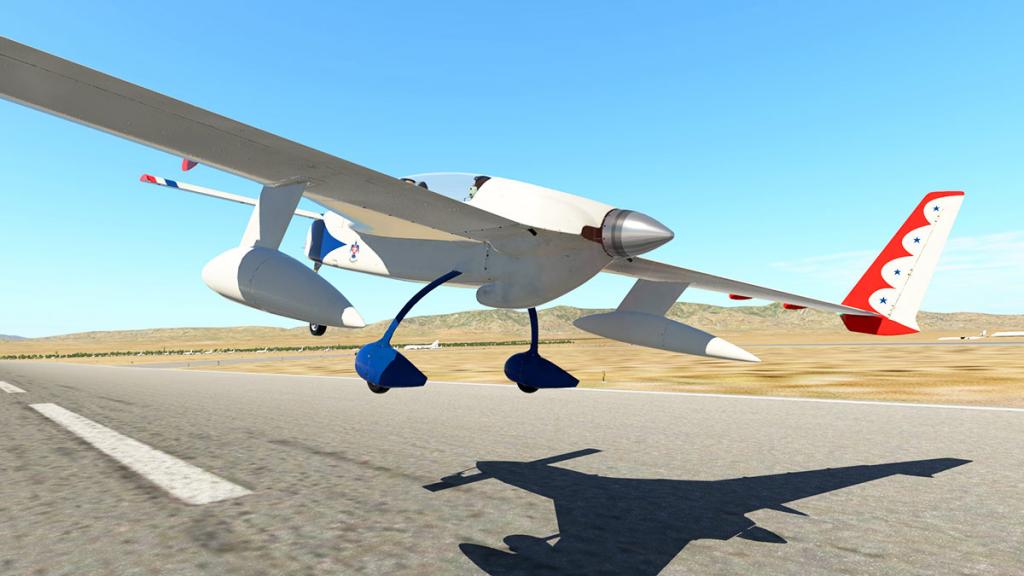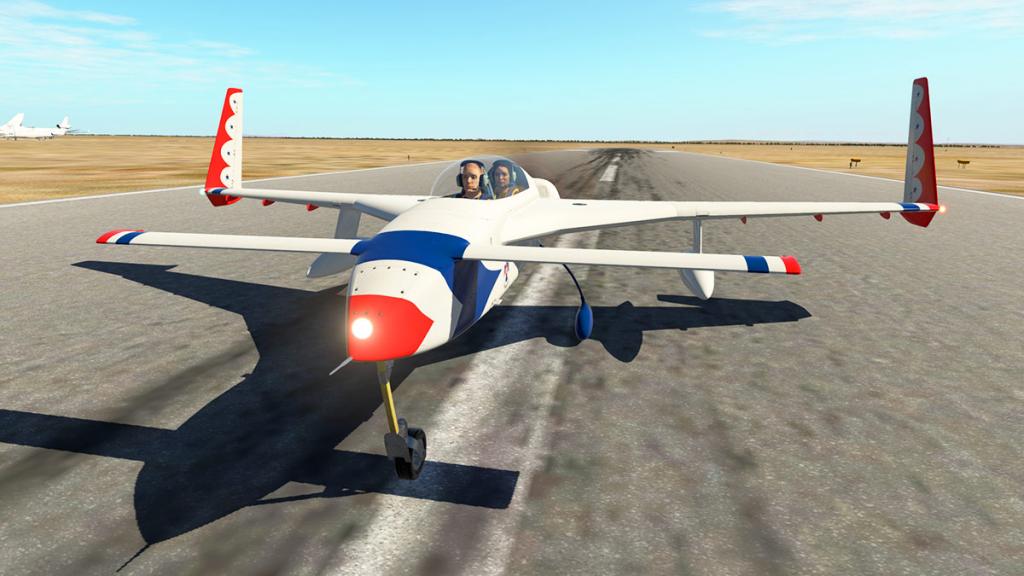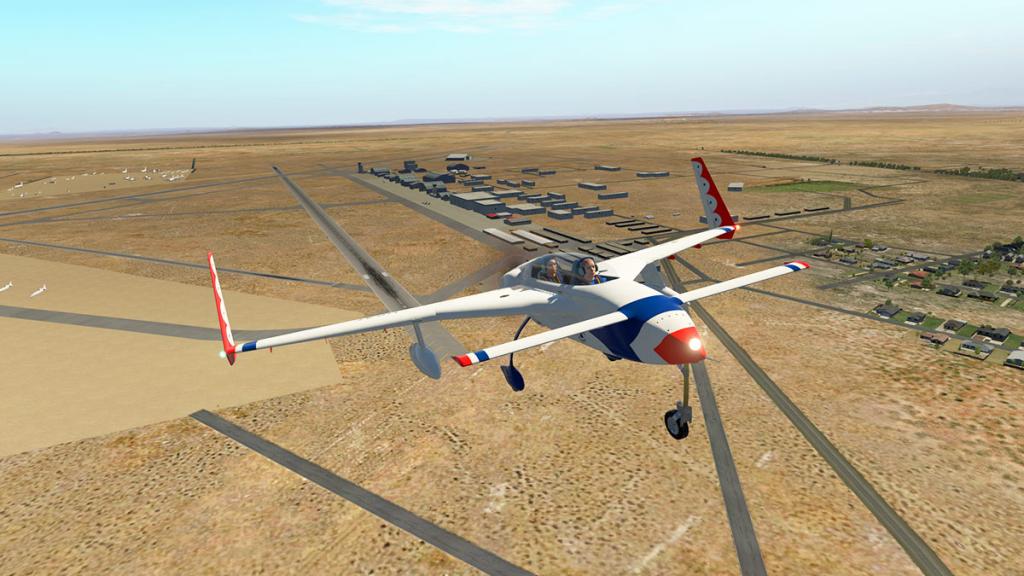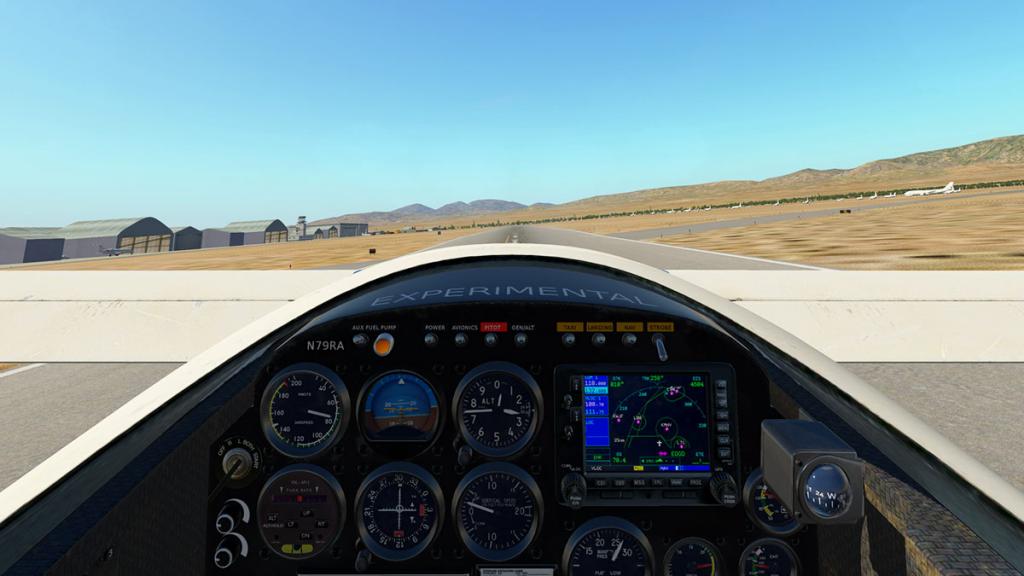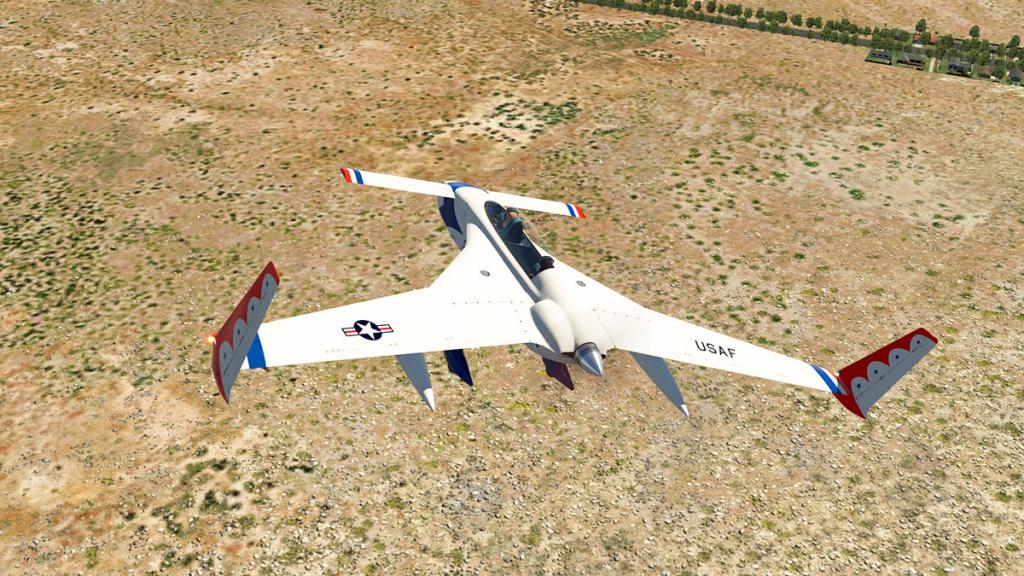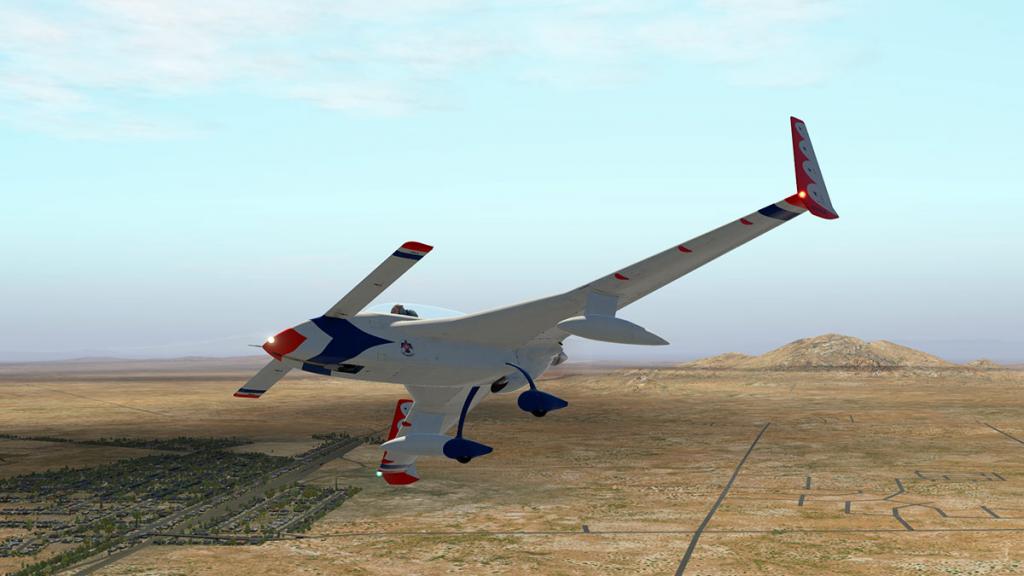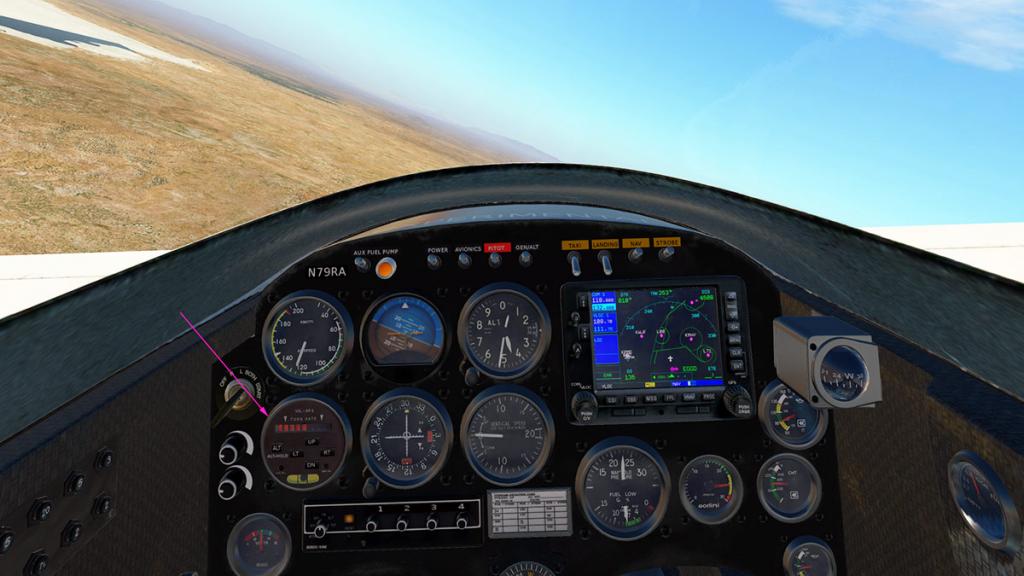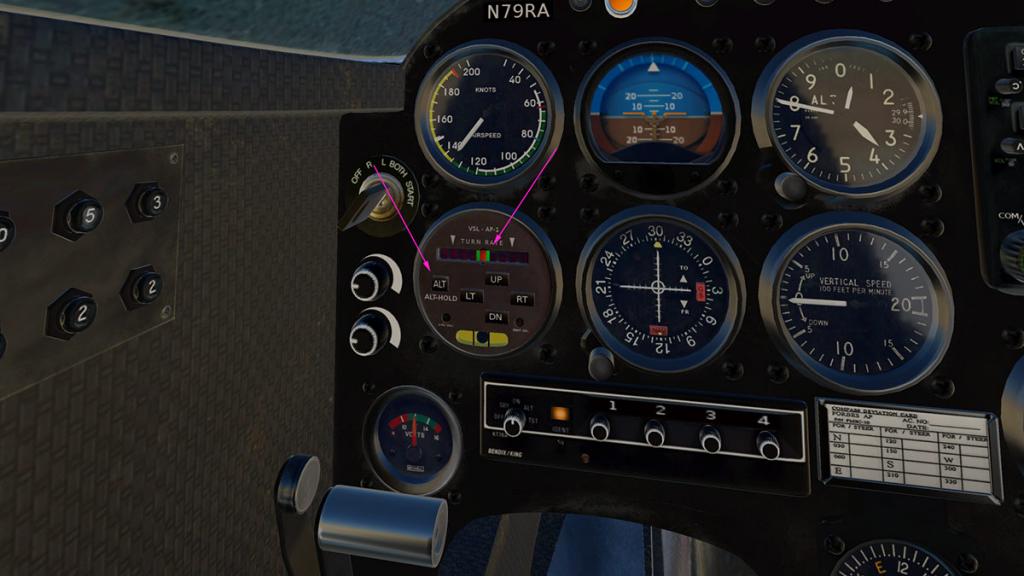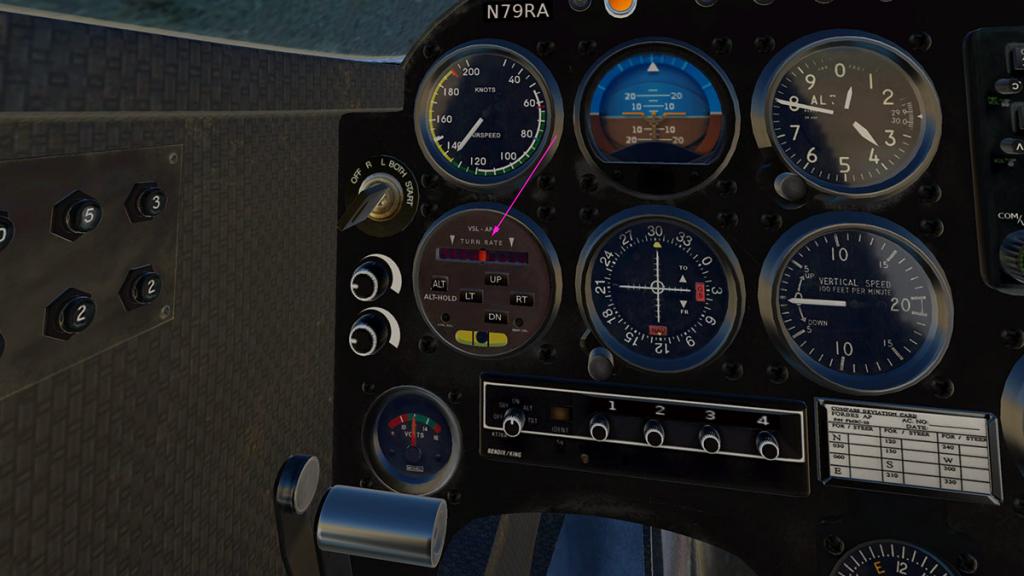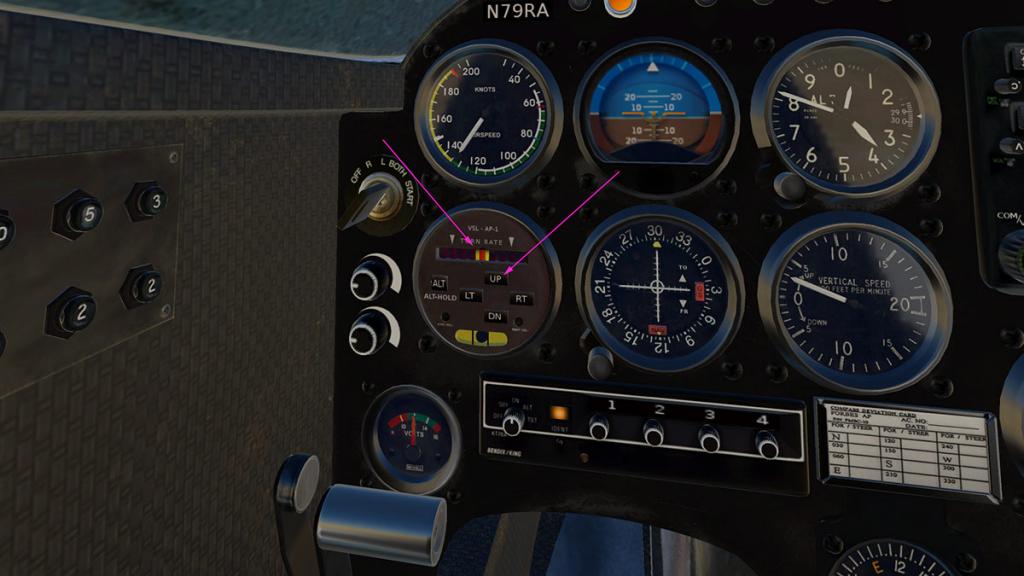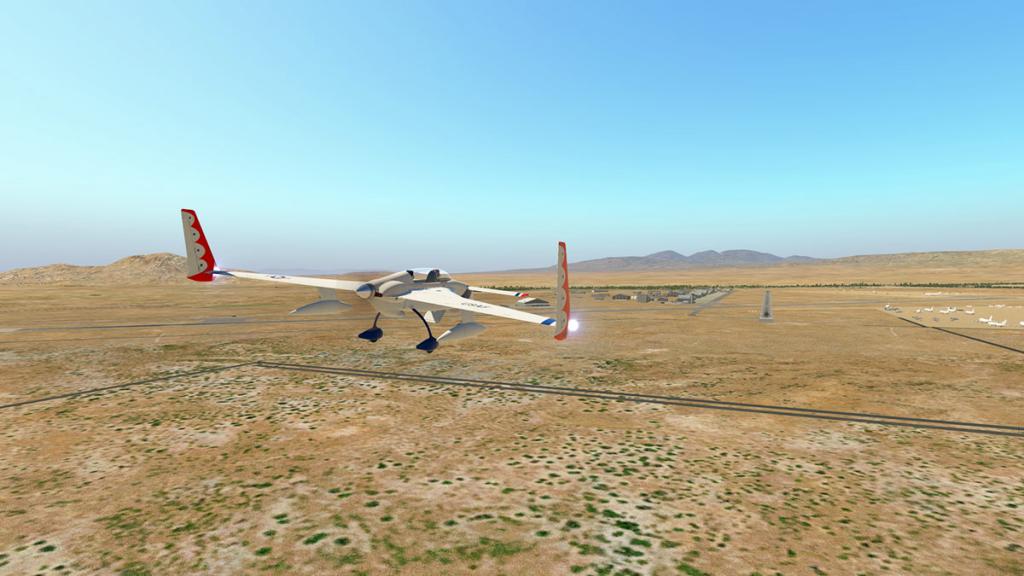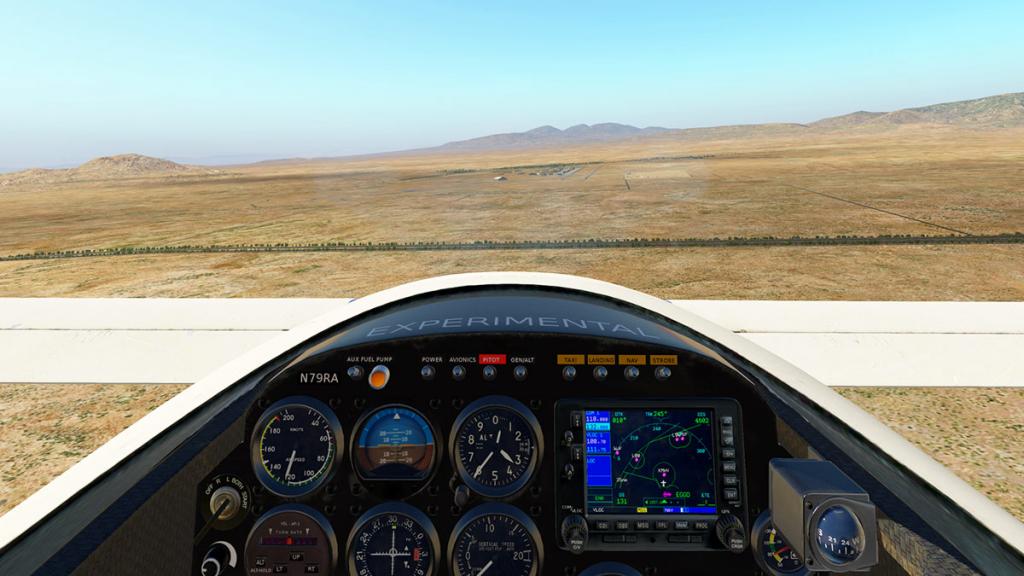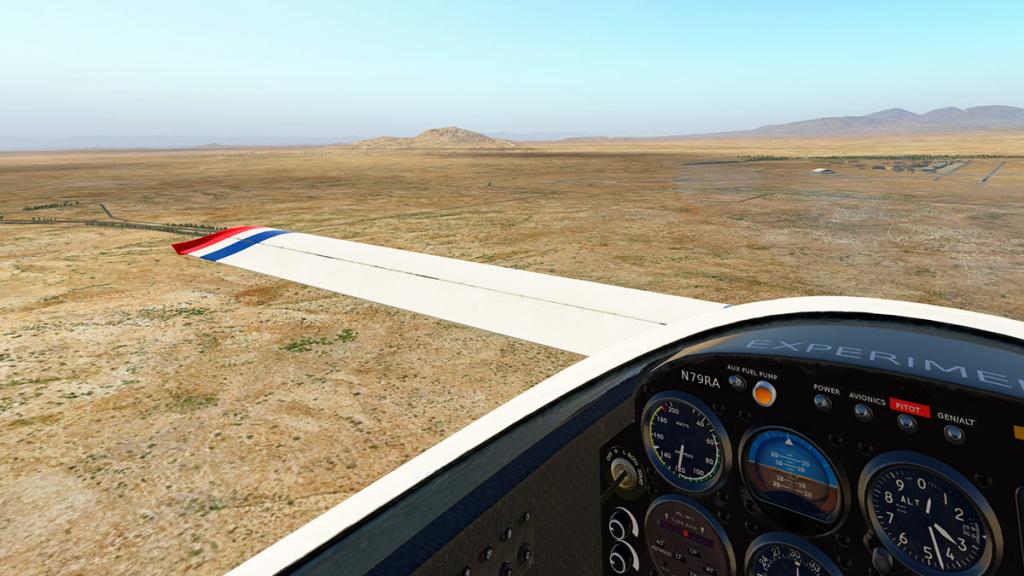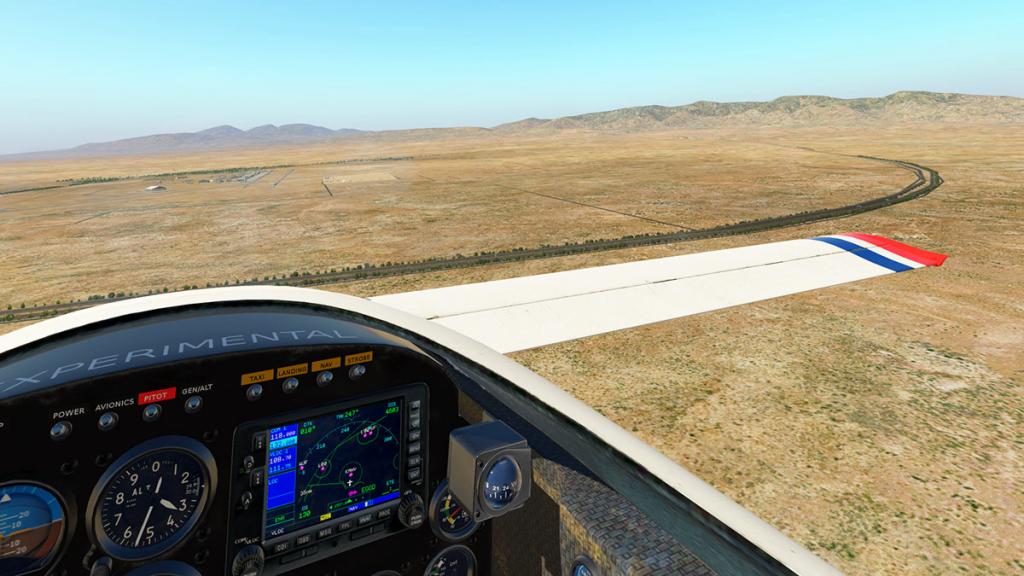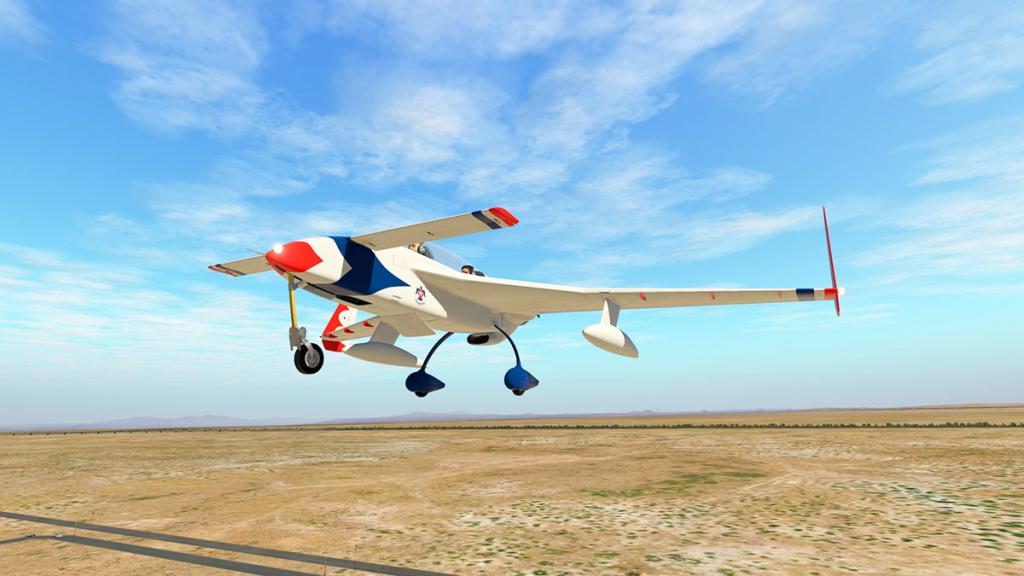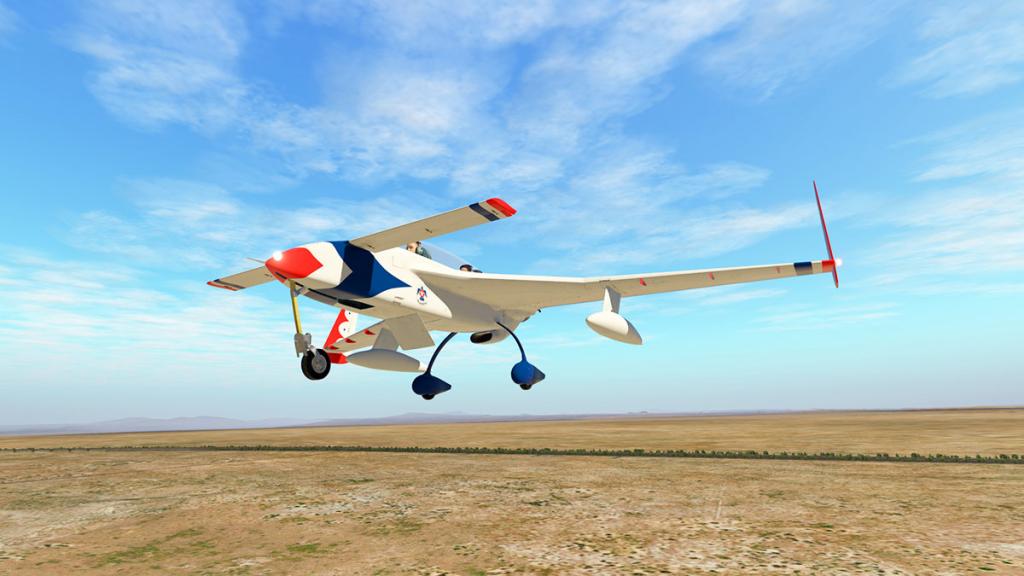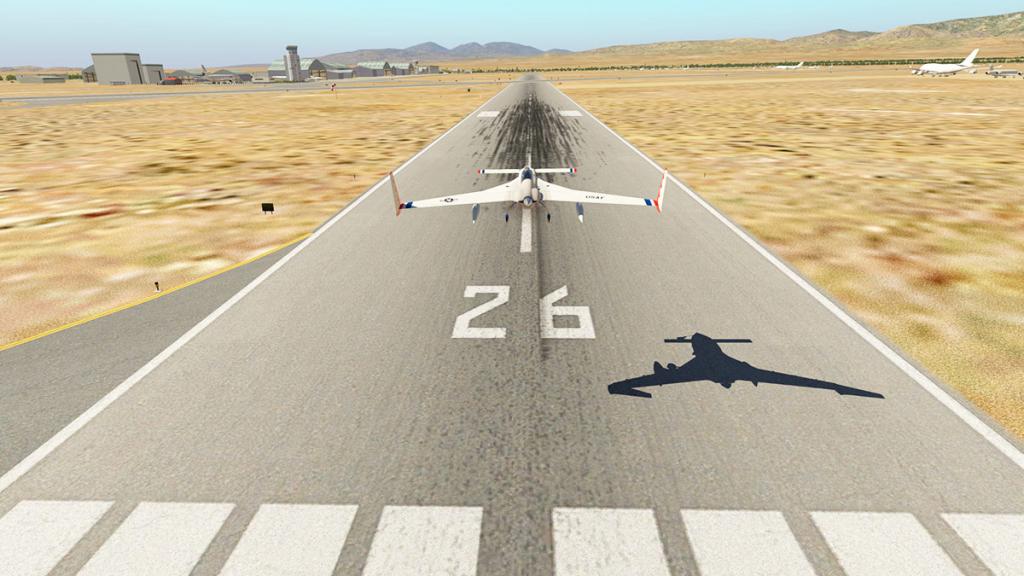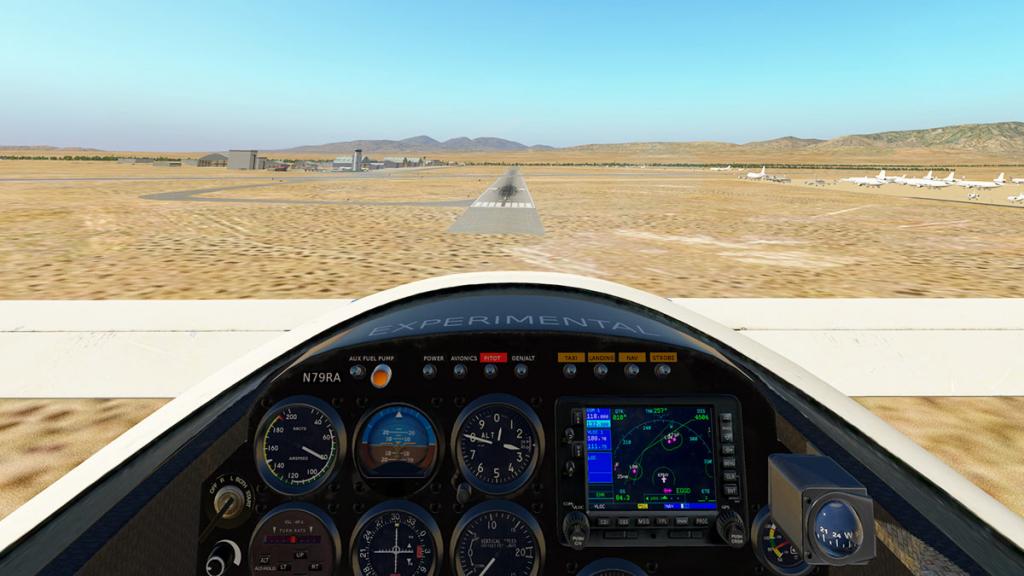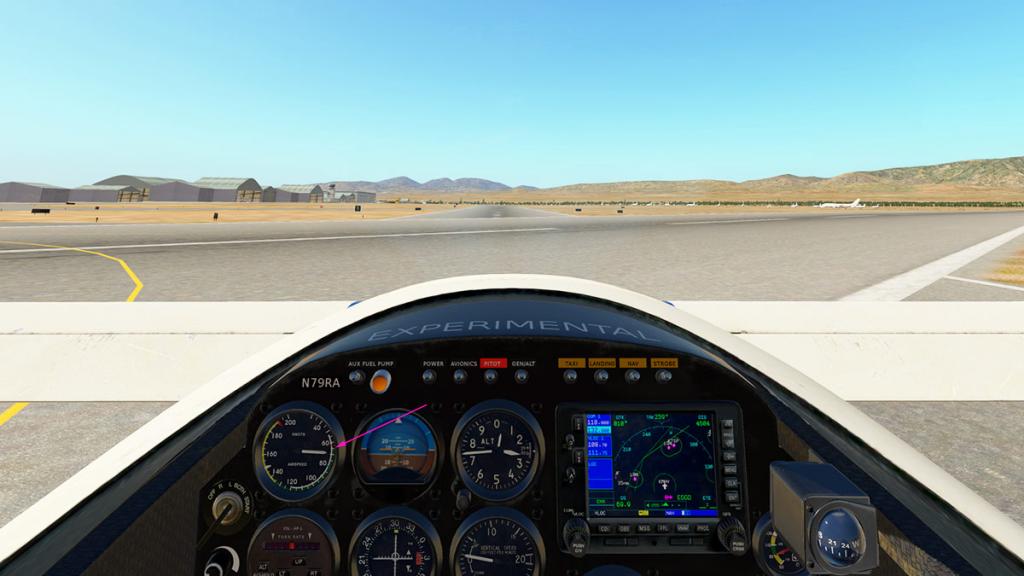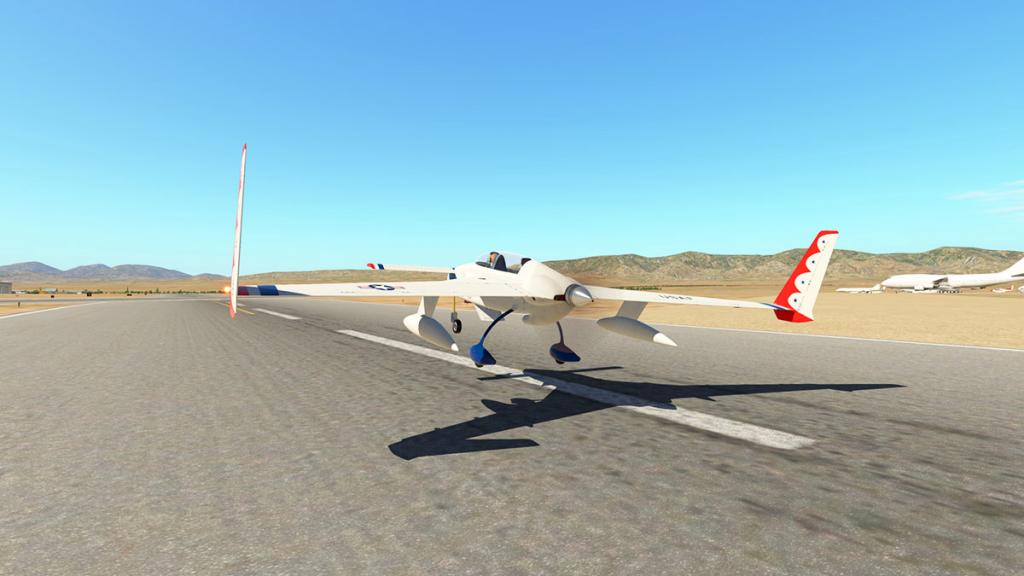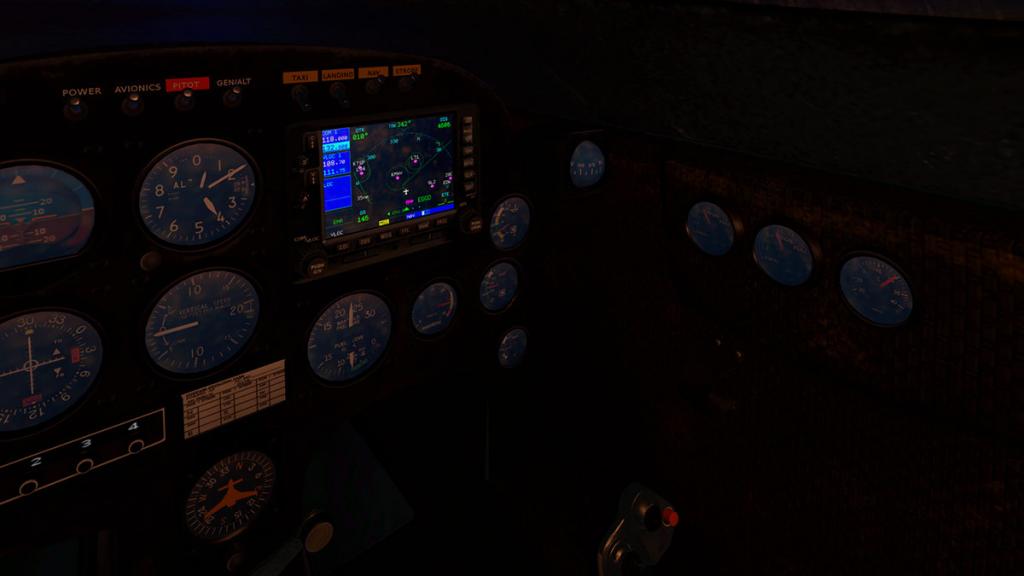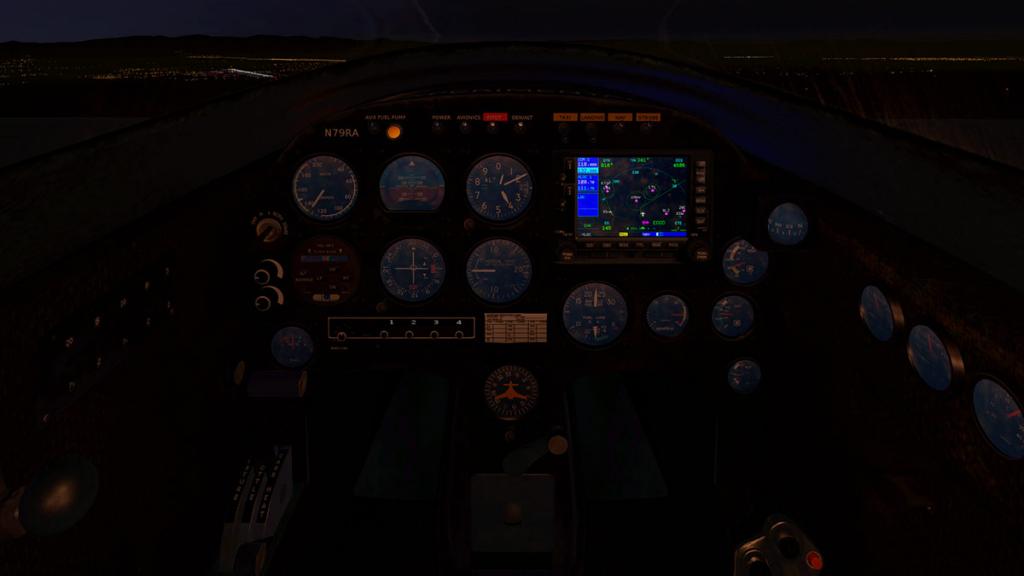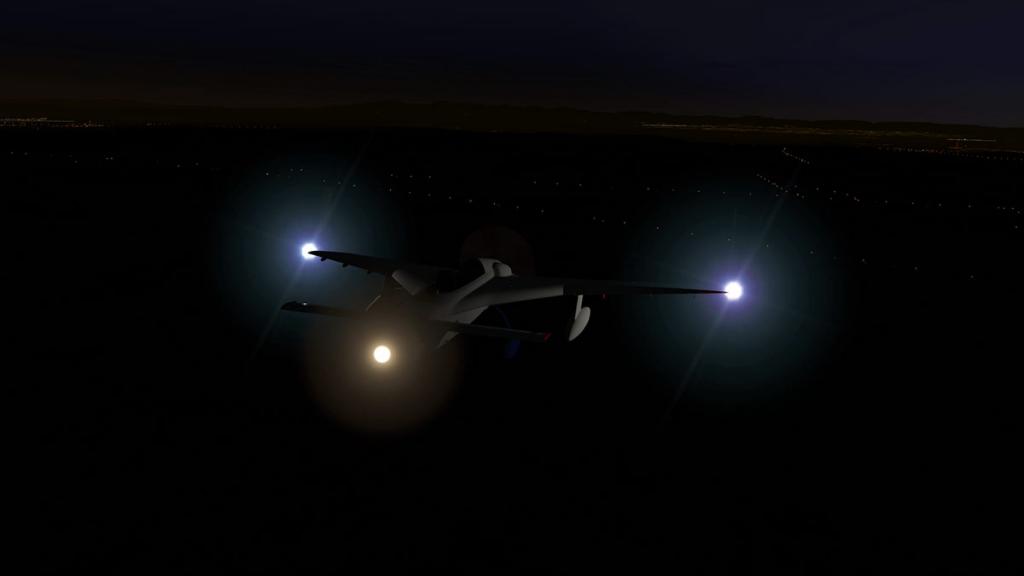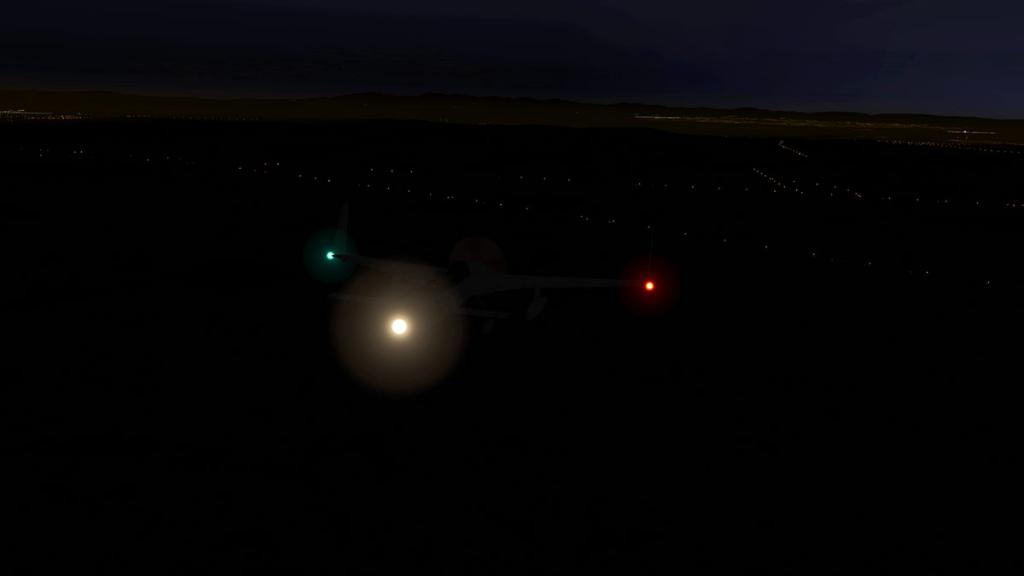Search the Community
Showing results for tags 'vskylabs'.
-
NEWS! - X-Plane 12 : Revolution Mini-500 by vSkyLabs Oddity aircraft are part of X-Plane's DNA. And vSkyLabs love producing project style aircraft. This one is the Revolution Mini-500, outwardly it looks like a small Hughes 500, but it isn't, but an American single seat light helicopter, designed and built in the 90's by Dennis Fetters, as a home-built kit. The X-Plane version of the Mini-500 was released back in January 2019. This is the fully upgraded X-Plane 12 version, is not just an adjustment to configure to fly the helicopter in X-Plane 12, but a full redesign of the original project, details include... light dynamics latest tuneup to fall in line with the latest X-Plane 12 related helicopter simulation physics. Sounds - new sounds (FMOD 2.0). 3-d external - skids flex animation was added. 3-d external - tail-vibration animation was added. 3-d external - (experimental) damage due mast-bumping visualization was added. 3-d external - rotor-blades flex animation was added. 3-d external - rotor-disc visualization refinements. 3-d int - new PBR textures for most cockpit elements. 3-d int - new higher resolution airspeed indicator plate. 3-d int - new higher resolution VSI indicator plate. 3-d int - new Altimeter with dual pressure system. 3-d int - improved VSL autopilot LED system. 3-d int - new built-in avitab support. 3-d int - new ignition switch. 3-d int - fixes to yaw-string. 3-d int - new hour-meter. 3-d int - added better animation to fuel-tank selector. 3-d int - new high resolution mapping for canopy pieces (in and out). Avionics - new GNS 430. Avionics - new Transponder. Avionics - autopilot, gps, radios are wired via 'avionics' switch. VR interaction - new/improved VR interaction for the entire cockpit. Manual/POH - new manual (please read before flight). All-around refinements and optimizations. Aircraft features include; VSKYLABS 'Test-Pilot' Project - Professional-grade physics, handling and performance characteristics. Highly defined and engineered flight dynamics model of the Revolution Mini-500, built around the powerful X-Plane flight model. The Mini-500 performance was analyzed by experts. Fully functional VR (Virtual Reality). Multi-Layer FMOD sound pack, composed with actual recordings of the Mini-500 helicopter engine and rotor sounds. Unique aspects of the Mini-500 helicopter are simulated and are part of the flying experience by definition: Manual engine/rotor RPM management, low rotor-inertia aspects, in-flight nose tuck during engine-stop, rotor RPM management, retreating blade stall condition (Vne), typical Mast bumping, typical autorotation capability and more. The VSKYLABS 'Test-Pilot': Revolution Mini-500 is designed as if it was a real kit-built helicopter, awaiting for it's first test-flight. Was it built exactly as instructed? Will it fly as expected? wow there is only one way to find out! You will have to get familiar with it step by step...or you might get yourself into serious trouble when mistreating it. Mastering the Mini-500 will sure make you a better helicopter pilot! The original pilot's manual and other 1st hand references contributed by the Mini-500 real-world designer were one of the core-materials during development of this project, and the VSKYLABS Mini- 500 pilot's manual includes the actual data and information of the actual Mini-500 manual. Autoupdater based on the SkunkCrafts autoupdater (XP12 only) - all updates are being pushed smoothly without the need to re-download the entire base package (base package will be updated every once in a while to minimize the gap). The project is under constant development. Highly responsive VSKYLABS support forums. The vSkylab philosophy is that you are purchasing an ongoing project, so any aircraft you purchase is not fully completed or is completed to 100%, that is the deal you sign up for to get access to the aircraft and all the development is free and ongoing throughout the X-Plane 12 version. These projects are under constant development: the development road-map is including flight model refinements, enhanced systems depth, additional liveries and other improvements. This aircraft is also available for X-Plane 11 (obviously with out the dynamics and effects of X-Plane 12) Images are courtesy of vSkyLabs... The Revolution Mini-500 by vSkyLabs is now available from the X-Plane.OrgStore _____________________________________ Yes! - the Revolution Mini-500 Project by vSkyLabs is NOW available from the X-Plane.Org Store here : Revolution Mini-500 Price is US$26.50 (Currently on sale for only US13.20!) Requirements X-Plane 12 or X-Plane 11 Windows, Mac or Linux 4 GB VRAM Minimum - 8 GB+ VRAM Recommended Current version: 3.0 (March 9th 2023) ___________________________ News by Stephen Dutton 11th February 2023 Copyright©2023: X-Plane Reviews (Disclaimer. All images and text in this review are the work and property of X-PlaneReviews, no sharing or copy of the content is allowed without consent from the author as per copyright conditions) All Rights Reserved
-
NEWS! - Aircraft Update : He-162 Project v3.0 - VSKYLABS 'Test-Pilot' Series Released in July 2020. This is another project aircraft from vSkyLabs, called the He-162 Project. Now Updated to v3.0 and is also X-Plane 12 compliant. The Heinkel He 162 Volksjäger (German, "People's Fighter") was a German single-engine, jet-powered fighter aircraft fielded by the Luftwaffe in World War II. Developed under the Emergency Fighter Program, it was designed and built quickly and made primarily of wood as metals were in very short supply and also prioritised for other aircraft. Volksjäger was the Reich Air Ministry's official name for the government design program competition won by the He 162 design. Other names given to the plane include Salamander, which was the codename of its wing-construction program, and Spatz ("Sparrow"), which was the name given to the plane by the Heinkel aviation firm. The aircraft was notable for its small size; although almost the same length as a Bf 109, its wing was much shorter at 7.2 metres (24 ft) vs. 9.9 metres (32 ft) for the 109. Most distinctive was its top-mounted engine, which combined with the aircraft's ground-hugging landing gear allowed the engine to be easily accessed for maintenance. The vSkylab philosophy is that you are purchasing an ongoing project, so any aircraft you purchase is not fully completed or is completed to 100%, that is the deal you sign up for to get access to the aircraft and all the development is free and ongoing throughout the X-Plane 12 version. These projects are under constant development: the development road-map is including flight model refinements, enhanced systems depth, additional liveries and other improvements. Project's Main Features: VSKYLABS 'Test-Pilot' project Highly defined flight dynamics model of the He-162 First Generation Jet-Fighter Comprehensive damage simulation Built around the powerful, native X-Plane's 'Experimental Flight Model' environment. Highly detailed model of the Heinkel He-162 aircraft. Comprehensive manual - 50 pages booklet Systems simulation: All core systems of the He-162 are modeled Fully functional VR (Virtual Reality) Ready Multi-Layer FMOD sound pack Auto-Updates and Support Highly responsive VSKYLABS support forums XP12 - v3.0 (22nd February 2023) Flight model deep validation to fall in line with the latest XP12 flight model updates (phase #1/2). Variable-area Nozzle performance enhancements (thrust, temperatures, speeds, altitudes). Landing gears physics overhauled. Weight and balance tune-up due latest XP12 aerodynamics updates. PBR rework for interior/exterior (to fall in line with the new XP12 rendering and lighting updates). Fix to 'aircraft is being initiated with nose-up attitude'. Engine RPM tuneup for ground idle. New 3-d modeling of the Revi-16B sight and internal 'projected' mechanism. New 3-d modeling of canopy air-vents. 3-d modeling fixes and improvements, including textures, for throttle quadrant, and cockpit panel. Fix for active gyro sounds in cold and dark, without electrical power. Notable was that the Skunkcraft's updater was added in November 2022 This aircraft is also available for X-Plane 11 (obviously with out the dynamics and effects of X-Plane 12) Images are courtesy of vSkyLabs... The He-162 Project v3.0 by vSkyLabs is now available from the X-Plane.OrgStore _____________________________________ Yes! - the He-162 v3.0 Project by vSkyLabs is NOW available from the X-Plane.Org Store here : He-162 Project Price is US$25.00 (Currently on sale for only US12.50!) Requirements X-Plane 12 or X-Plane 11 Windows, Mac or Linux 4 GB VRAM Minimum - 8 GB+ VRAM Recommended Current version: 3.0 (February 22nd 2023) ___________________________ News by Stephen Dutton 24th January 2023 Copyright©2023: X-Plane Reviews (Disclaimer. All images and text in this review are the work and property of X-PlaneReviews, no sharing or copy of the content is allowed without consent from the author as per copyright conditions) All Rights Reserved
-
Aircraft Update Review - DC-3/C47 Skytrain v4.0r4 by VSkyLabs Flying Lab Project vSkyLabs are back with another focus on the DC-3/C47 heritage aircraft. It is a year since the last v3.0 update that renovated the cabin and included a cargo version... note the word "Project" as in any aircraft by VSkyLabs creates is an ongoing project and there is more to come as the aircraft is developed out more and more. This is part of the deal with the developer, and at least he keeps his side of the bargain. Noting the versions... Authentic DC-3 "Douglas Commercial" above and the C-47 Skytrain below... ... you can add on some really big Ice skis, or... ... a huge set of XC-47C floats. The Douglas aircraft is also highly developed for VR (Virtual Reality) use and operation. DC-3/C47 Skytrain v4.0r4 There was a huge amount of changes in the last v3 update, and there is again this time around. But v4 is more focused on the cockpit than the cabin or any of the external modifications than what was presented last year. The main changes are on bringing in the PBR (Physically Based Rendering) properties to the cockpit, a "fresh over" if you like. The changes in v3, were mostly all to the very good, but there was also a few items that I thought were also a big retrograde step backwards... The main instrument panel was changed from a basic black to a more detailed green panel... the green looks very good and is certainly nicely worn, but it was also missing the nice screws that originally held the panel in place... again the screws have not yet been replaced, and you still really miss them as it makes the panel a bit "missing something"? Second was the change of the glass, from the original dirty rusty brown, to a smoky black... the new finer tint just does not have the ageing impact of the earlier grubbier version, again the lighter black tint remains. Note the nice opening windows. The panel actually though has had a lot of changes... in fact all the gauges have been remodeled and re-engineered to include plastic covering for lighting, better refined needles and engine markings (L/R) on the relevant instruments, and all the gauges animations were re-calibrated with higher precision indications. The differences are far more highly noticeable at night... ... the Airspeed indicator can now also be switched (hotspot) to either MPH or KNOTS, and the speed bugs then move to match each of the different speed settings. I bet you didn't notice, but there was no Artificial Horizon instrument gauge (arrowed below) on the right Co-Pilot instrument panel, that instrument has now been installed... the AH replaces an Ampere meter that has been removed. The original Sperry Type A-3A autopilot facia has also been redone... including the compass scales, rotary knobs, bezels. The Sperry autopilot cutout was also added, to host the Sperry unit inside... in fact the whole complete instrument panel and instruments have been remodeled and retextured to PBR texturing quality and dials come with reflective covering glass. Ditto the overhead switch panels, again PBR texturing and new switchgear. There is remodeled dirty roof speakers and an added master Ignition switch that works... (below) the drop down (press the Whiskey Compass) twin Garmin GNS 530 GPS units have had their outer casings units totally remodeled, and they now have a far more visual 3d look and feel. The yokes have also been redone, gone this time around is the loss of the lovely raffia weaving, after the loss of the Douglas logo the first time around, so the yokes are all now just a pure metal frame with a nice PBR gloss and still no return of that magnificent Douglas logo? The AviTab (plugin required) has also now been added. There are two tablets positioned on each yoke, and the tablet is selected via the pocket (hotspots) on each side of the pedestal. The pilot seats have been redone (recovered?) as well... Green before they are now a more authentic worn brown leather with a nice PBR wear look and feel. The pedestal has also been remodeled, and again the look and feel is to the more modern, or a straight out of the shop brand new feel... beautifully done however with some very nice metal work, but not in the original feel of tired, aged or worn in any area? On the rear of the pedestal now (arrowed above right) is a real-time conversion board for airspeed (mph/knots/kmh), temperatures and altimeter settings. On the floor between the pilots, there has been added both an undercarriage lock handle (arrowed) and more about this when flying, and a "Emergency" panel for the fuel shutoffs and Fire Extinguisher, again all really well done. The classic DC Hydraulic panel, situated behind the Co-Pilot has been totally overhauled.. there is now a Engine-Pump-Selector, Autopilot Emergency valve (which works), a Star valve (non-functional), and both the Flaps and Landing Gear handles now operated in a three positions of UP, NEUTRAL and DOWN (Again more about about these movements when flying. The hydraulics metal panel placards are beautifully done (detail, detail) and add a lot to the aircraft, as all of the advisory and warning placards around the instrument panel and cockpit which are also new and more authentic. Up on the roof, the escape hatch has been redone and has gained a window, which lets in a lot more light into the cockpit... very nicely done with great window surround detail. Gone also is the 60's IBM 360 mini-computer (Avionics rack) situated right rear of the cockpit... it has been replaced just by simple brushed aluminum facade that is quite nice, but I would have rather have had a realistic avionics rack (but not the 60's rack, but a far older model). There is a notable pattern here, a far, far higher quality, but also a more sleek and modernistic look... you are certainly leaving the grubby, wear and tear feel now well behind... for me it is a debatable context, if you want old classic, wartime built and battered, then that aspect has been (but slowly) refined totally out. Flying the v4 DC-3/C-47 Instantly when starting the twin Pratt & Whitney R-1830 Twin Wasp 1,200 hp (890 kW) engines... is they sound now very different? This is a very all new FMOD sound package, and it comes with new multi-layered engine sounds for the interiors and exteriors... and you significantly notice that aural difference straight away, and it is very good. With the weight of the aircraft you steer with the engines as much with the locked tailwheel, yes I am cheating, but as noted I don't have toe-brakes to get a realistic wheel on wheel braking effort. Taxiing mean small movements for corrections, if you don't go too fast the DC-3 will hold a nice straight line. The Gear lock has to be flat on the floor to "Lock". So you check it, then set the trim to neutral. Half throttle to get the bird moving, then feed in the full power... control is via the throttles as much with the rudder to keep the DC-3 straight, as you need more power on the right to counteract the forces of the pull to the left, it is natural to me now, but this is on how you fly the DC. The tail will soon lift around 70 knts, and you use the rudder for more control, but be careful, as if the DC-3 starts to weave you can easily lose it. Around 90 knts the DC-3 will naturally lift, so your job is to just keep the aircraft tight and straight, once off the ground and flying and all you need is to do is a slight pull back on the yoke that will give you a nice clean 1,000 fpm climb... ... now come the tricky bit, you have to pull up the "Gear Lock" handle... then move the gear lever upwards to stow the gear, simple... No not really. It is because you are flying totally blind while moving around the cockpit to focus twice on two different actions. This is the second change. Originally vSkyLabs used a setting on the Slider# to create a 3 way selection, UP, NEUTRAL and DOWN... .... but that caused me personally havoc after setting the Slider#14. I got a conflict with my Saitek X56 throttle system, it made the right engine run weak... disconnect the Saitek throttle add-on and it worked all fine again, plug it back in and it doesn't? Why an addon unit messed with a throttle power selection is totally beyond me, but it did? Other users struggled with the 3-way system as well, so it has been since simplified back to using the default (Gear) UP and DOWN commands, but you still have to pull up and push down to lock the "Gear Lock" lever... two other notes, one is to make sure you update to the latest version via the "STMA" built in updater to get the later (r4) gear update. And when the gear is retracted, do a little pull on the regular brakes to stop the wheels rotating in the wheel bays. There is an "ESSENTALS" pdf with all the Slider# commands to set as the developer recommended), including sliders# to cover the "Gear (safety) latch", "Gear Handle", "Flaps Handle", and all to save you moving visually around the cockpit, but after the incident or conflict with the Slider# command I am personally wary of other hidden actions of using the sliders#... it is an area to investigate further. I totally recommend using the XPRealistic Pro v2 by rk Apps and their realism effects... it makes the DC-3 "shake, rattle and roll" with aplomb, and they are extremely highly realistic. Add in those new FMOD sounds and you are having a great time up here. Notable is if you open the side window, on how the sounds change nicely (tone wise) in the cockpit of the unique thrum of the Wasps, it is far quieter with the window closed again. Trimmed out, you need to again to adjust the throttle position to stop the slow yawing to either the left or right... The DC-3 always had a tendency to drift or bank one way or the other. The throttle trimming will do a good job here, but the exact balance window is very hard to find. Changing the throttles or power can have a big impact on trim or the change of altitude... you can steer and fly by the power settings alone. Notable in v4.0r4 is that long-waited fix for the dual DME radios, which were replaced with a fully functional, independent dual DME radio that allows to fix your position with the use of separate NAV1/2 radios, while still on-navigation with NAV1/2. The Sperry Type A-3A autopilot is about as basic as you can expect it to be, it also now has the "Autopilot Master" switch on a slider# setting and the noted "Autopilot Shutoff Valve" that actually works. Three dials in RUD (Rudder), AIL (Aileron) and ELE (Elevation) will adjust your flying surfaces, in reality it is just another trim function but one that you can control easier. Turn the ELE knob and you will see your yoke go towards you to climb, same movement in forward to descend. AIL will bank the aircraft to a new heading and so on. It all works quite nicely but you have to watch your instruments in that you are going in the right direction and not slightly banking towards another one... as with the A-3A system the DC-3 tends to drift (badly) over distance, so you had to consistently make heading adjustments. I actually love this sort of flying as you felt you were back in a period of basic automation and you still required your navigation skills to find your way around the planet. Switch on the provided S-TEC Autopilot, and the more modern system eliminates this aspect, but the wide swings around the new heading are not at all realistic? In v4 vSkyLabs have adjusted these wild swings, but they don't seem much better to me? To change the heading for the S-Tec you use the RUD (Rudder) knob on the A-3A (arrowed orange) and I love the alignment of the compass to heading rotors (arrowed yellow) on the A-3A. Notable is the vSkyLabs use of the "Experimental Flight Model" that needs to be selected ON in the Menu/General settings. And vSkyLabs recommends to set up your X-Plane configuration for MAXIMUM REALISM, and all "Stability Augmentation" to zero "0" values. In v2.7b vSkyLabs introduced Ice and rain to the aircraft... but to note how far that interior quality has also changed over the versions, but I still really miss those great earlier twirling fans! The Ice and Rain effects are some of X-Plane's best use of the feature, it not only feels cold, but it can be quite lethal as well. Lakeland (KLAL) field in sight, it was time to get ready for landing... like the Undercarriage the Flaps are now also on the new (Slider#) system, and it is used in a realistic hydraulic pressure fashion, in the real DC-3/C47 there is a hydraulic hand pump located at the bottom of the hydraulic control panel, this is a handle that extends out between the pilot's and co-pilot's seats, and is set there for manual use if the engines cannot supply the required hydraulic pressure (but not yet implemented in this aircraft, but coming). Gear lock lever up to release and then click down the gear lever to lower the undercarriage, then the gear lock lever down again to lock the gear in place... Flap position is noted to the far left, upside down... with the UP position low, and the DOWN position high in front of your eyes, but it can still be tricky to see while on approach. Approach speed is around 70 knts, but I think it is too fast, it feels fast... not slow and lumbering? but it is still close to the 58 knots stall speed. A slight nose up will drop you down to 63 knts, then slowly you fall to the runway. The DC-3 is very tricky to land... very susceptible to crosswinds, and you have to get those wheels perfectly right, unless you will bounce or hop like a drunk bunny all the way down the runway quite badly... ... now if you do bugger it all up (and it IS quite easy to do), in v4 a bad landing or crash will now do untold damage to the aircraft, like blown tyres and broken props... or the aircraft will simply come apart in the air... (note: no DC-3s were harmed in displaying the damage shown here!). Over throttle and the engines will simply blow up on you... "Oh dear!" Summary This is another huge update to the vSkyLabs DC-3/C47 classic aircraft. The aircraft was released back in July 2017, but has had continuous and quite significant updates since, this is v4.0r4, up from v3.0 last year, which in renovated the cabin and included a cargo version... note the word "Project" as in any aircraft by VSkyLabs creates is an ongoing project. Look at the original release version; DC-3/C47 by VSkyLabs Flying Lab Project and see the large amount of changes to the aircraft over the years, yes it is hugely and even significantly a far, far better aircraft, but a few of the great original ideas have also been lost along the way... notable the cockpit fans, rusty brown window tints and the screws around the instrument panel, this has also taken away a little of the old wartime classic feel that was so originally attractive. There has been also a more of a modernisation of the aircraft from back then as well, more modern tools like modern autopilots and in this v4 version AviTabs on the yokes. Other significant changes here also include another complete overhaul of the cockpit, mostly to the instrument panel to include instrument covers and the full look and quality of PBR textures and effects. Hydraulic panel has been overhauled and the gear lock handle included. Hotspot to either MPH or KNOTS, and dirty roof speakers and an added master Ignition switch. GNS holder are also all new... removed is that 60's avionics rack and replaced by some just nicely brushed aluminum panels. Slider# options are also now included as well as the usual default commands, but be careful the settings don't conflict with the default settings as they did with X-PlaneReviews. New damage effects are also clever and the feature list like with the realistic icing and rain is huge and getting longer by each version release. The DC-3/C47 is one if the the greatest aircraft ever produced, and 30 of the old timers are still actually flying... the result here is one of the great simulations, with a highly realistic feel and handling of this amazing aircraft for the X-Plane Simulator... it is a challenging aircraft to fly, a "sort of grab it by the neck and fly the thing" sort of machine, but a classic never the less, and what you get in the features and detail delivered here is excellent value and all for the under US$30.00 price.... value, huge feature list and barnstorming fun, what more could you ask for! ______________________________________________ The DC-3/C47 v4.0r4 by VSkyLabs Flying Lab Project is NOW available! from the X-Plane.Org Store here : VSKYLABS C-47 Skytrain / DC-3 Flying Lab Project Your Price: US$29.95 If you have already purchased the DC3/C47 from Vskylabs then just login to your X-Plane.OrgStore and go to your account and download the current v4.0 update (note - that you download the r4 update via the STMA Auto-Updater plugin, built into the simulation) Project's Highlights: Project is 'VR Ready' for use with X-Plane: VR functionality is a part of the project aspects which are constantly under evaluation and development for reaching a higher level of immersion as the VR features and possibilities are growing. Highly Realistic Handling and Flight Performance DC-3/C-47 Simulation: Highly accurate performance and handling simulation of the DC-3/C-47, along with a full set of traditional/old school navigation and autopilot systems. Aircraft performance and handling qualities were designed and tested in a "Research level" approach and went through a validation process of hundreds of flight testing and evaluation, tested and refined by a real-world C-47 pilot. Workhorse for DC-3/C-47 pilot skills: Experience authentic flight performance and handling practices (takeoff, landing, single engine operations, flight planning, long range flights and old school navigation). It is a perfect platform to recreate and fly historic routes using authentic performance. Unique look and feel: There is nothing to hide - the VSKYLABS DC-3/C-47 is a mixture of a simplified yet very engaging design. Two C-47 variants included: The C-47 and the XC-47C floats-equipped variants. Systems: All the relevant systems are being simulated. Here are **some** of the more unique systems: Two speed Supercharger blowers - based on the PW-1830-90C engines model, equipped with lo/hi blowers. The high blower configuration allows high altitude cruise. Oxygen system - including crew dilution/regulator, pressure indicator and functional flow-indicator ("Blinker"). Do not forget to enable hypoxia in X-Plane's general settings menu. Fire Extinguisher system - including fire indication system. The fire extinguisher control panel is located behind the hinged cover on the cockpit floor, between the pilot/co-pilot seats. Damage simulation - engines are sensitive to rapid spool-up. Engine mishandling will result in severe damage to the engine/engine fire. Stressing the airframe will result also in severe damage, following a visual representation of the damages. Blown tires are also being visualized and simulated. Engines/propeller systems - designed with fully featured, functioning and authentic propeller feathering systems, for highly realistic single engine simulation. Landing gears and flaps simulation - are being simulated with a high level of authenticity. Sperry Autopilot - Old school autopilot is configured. Optional modern avionics - dual GNS 530, S-TEC autopilot, AviTab compatibility. Anti-Icing/De-Ice systems - including icing and rain visualization. Skis - Animated, incorporated in the flight dynamics model. Passengers/cargo configurations. Comprehensive FMOD sounds. STMA Auto-updater plugin included. AviTab plugin compatibility included (AviTab plugin not included). Highly responsive VSKYLABS support system (including C-47/DC-3 operational knowledge and support/assistance). Requirements X-Plane 11 Windows, Mac or Linux 4 GB VRAM Minimum - 8 GB+ VRAM Recommended Current and Review version: Version v4.0r4 (October 1st 2021) The AviTab Plugin is NOW required for this aircraft. _____________________________________________________________________________________ Update Review by Stephen Dutton 12th October 2021 Copyright©2021 : X-Plane Reviews (Disclaimer. All images and text in this review are the work and property of X-PlaneReviews, no sharing or copy of the content is allowed without consent from the author as per copyright conditions) Review System Specifications: Computer System: Windows - Intel Core i7 6700K CPU 4.00GHz / 64bit - 16 Gb single 1067 Mhz DDR4 2133 - ASUS GeForce GTX 1080 8Gb - Samsung Evo 1Tb SSD Software: - Windows 10 - X-Plane 11.55r2 Addons: Saitek x52 Pro system Joystick and Throttle - Sound : Yamaha Speakers YST-M200SP Plugins: : Plugins: Global SFD plugin US$30.00 : Environment Engine by xEnviro US$69.90 : RK Apps XPRealistic v2 - US$34.99 (Highly Recommended) : Traffic Global - JustFlight-Traffic (X-Plane.OrgStore) US$52.99 Scenery or Aircraft - KRSW - Southwest Florida International Airport by Aerosoft (X-Plane.OrgStore) US$24.99 - KLAL - Lakeland Linder by Freddy de Pues (Not Available)
-
NEWS - Aircraft Update : Scheibe SF-25C Falke Project XP12 - v5.0 VskyLabs VSky Labs have released two consecutive releases for their Scheibe SF-25C Falke glider. v4.3, then a day later v5.0, a bit odd, but we will go with it. The Scheibe SF-25C Falke is a German touring motor-glider which flew for the first time in 1963. The two-place powered sailplane is featuring a low wing configuration, an 80 hp engine (Limbach 2000 L) and side by side seating. High performance in its operation range, easy handling, robust construction, reliability of both airframe and engine are the main features of the SF-25C Falke. The VSKYLABS Scheibe SF-25 Project development for X-Plane was approved by Scheibe Aircraft GMBH (although it is an independent VSKYLABS project which is not endorsed and/or affiliated with/by Scheibe Aircraft GMBH). The project is featuring the SF-25 C variant (Falke 2000), which is equipped with a 80 hp engine, driving a two-blade wooden fixed pitch propeller (alternator and electric starter are included). The vSkylab philosophy is that you are purchasing an ongoing project, so any aircraft you purchase is not fully completed or is completed to 100%, that is the deal you sign up for to get access to the aircraft and all the development is free and ongoing throughout the X-Plane 12 version. These projects are under constant development: the development road-map is including flight model refinements, enhanced systems depth, additional liveries and other improvements. Features VSKYLABS 'Test-Pilot' Project: designed for use with X-Plane cutting edge Experimental flight model environment, featuring superb flight dynamics with authentic performance and flight handling characteristics. Superb Flight dynamics: A highly defined SF-25C flight performance and handling qualities. Built for VR: development was tailored specifically for VR, and optimized for 2D usage. Perfect fit for beginner and expert pilots: The VSL SF-25C Falke features a standard, basic analog cockpit suitable for easy readings and orientation. With its superb handling qualities and docile behavior, it will serve as a safe training platform for powered flight, as well as for gliding. It is a motor-glider, so it's perfect for thermal-hunting and cross-country flights as well. Wonderful FMOD sound package that includes authentic Limbach 2000 engine recordings and an interactive set of dynamic sound layers that will "wrap" your flight perfectly, setting a whole new level of flying experience! Built-in Avitab Plugin Compatibility (AviTab plugin is not included). Detailed manual included. STMA Autoupdater plugin is included - all updates are being pushed smoothly without the need to re-download the entire base package (base package will be updated every once in a while to minimize the gap). Highly responsive VSKYLABS support forums: VSKYLABS is offering continuous professional support from aircraft related aspects (operating and flying) to X-Plane technical support. I have put the two updates together; XP12 - v5.0 (18th January 2023): Cockpit re-engineering - correction of full-scale measurements. Cockpit floor level reduced by 15 cm. Struss structure modifications. Rudder pedals re-scaling. Older 'fork' control sticks were replaced with the newer two spearate sticks modification. XP12 - v4.3 (17th January 2023): PBR Tuneups for interior and exterir elements to fall in line with the latest X-Plane 12 lighting engine updates. New default livery, new additional livery. Paint kit modifications. Notable there was two earlier updates for X-Plane12, so this an X-Plane 12 compatible aircraft. Version 4.1 (November 23rd 2022) Added the Skunkcraft Updater Version XP12 (September 5th 2022) Added link for the X-Plane 12 version There was a brief overview of the Scheibe SF-25C Falke, back in 2018. This aircraft is also available for X-Plane 11 (obviously with out the dynamics and effects of X-Plane 12) Images are courtesy of vSkyLabs... The VSKYLABS Scheibe SF-25C Falke Project by vSkyLabs is now available from the X-Plane.OrgStore _____________________________________ Yes! - the Scheibe SF-25C Falke Project v5.0 by vSkyLabs is NOW available from the X-Plane.Org Store here : VSKYLABS Scheibe SF-25C Falke Project Price is US$25.00 Requirements X-Plane 12 or X-Plane 11 Windows, Mac and Linux 4 GB VRAM Minimum. 8 GB+ VRAM Recommended Current version: 5.0 (January 18th 2023) ___________________________ News by Stephen Dutton 19th January 2023 Copyright©2023: X-Plane Reviews (Disclaimer. All images and text in this review are the work and property of X-PlaneReviews, no sharing or copy of the content is allowed without consent from the author as per copyright conditions) All Rights Reserved
-
Aircraft Released : Tecnam P2006T X-Plane 12 by vSkyLabs vSkyLabs have released the X-Plane 12 version of their popular Tecnam P2006T. The Tecnam P2006T is an Italian high-winged, twin-engine all-metal light aircraft built by Costruzioni Aeronautiche Tecnam, which is based in Italy. The P2006T is the lightest twin-engine certified aircraft available, and is a four-seat aircraft with fully retractable landing gear and liquid-cooled Rotax 912 engines. Yes it is actually all new... as the VSKYLABS P2006T Project was originally designed following the Tecnam 'MK-I' model which was commonly used at the time that VSKYLABS developed it for X-Plane (2016-2017). Tecnam introduced the production 'MK-II' models to the market in May 2017. The P2006T 'MK-II', which is not included in this product, includes several enhancements such as the G1000 Nxi (instead the G950), new seats design and improved lighting system. Features Major Update Release. Flight model validation, tune-up and modifications to fall in line with the latest X-Plane 12 flight model related features and nuances. Engines - Power rating gradient, fuel consumption, rates. New FMOD 2.0 sound package. Cockpit - All-new PBR textures to fall in line with X-Plane 12 latest lighting-engine features and nuances. Cockpit - Newly modeled and textured pilots and passengers seats. Cockpit - Newly modeled and textured fire extinguisher. Cockpit - Newly and improved various modeling. Cockpit - Modified and tuned interior lighting system. Propellers - Improved 3-d and textures. Improved prop-discs. Landing gears retraction animation now fits perfectly into the gear bays. Pitch trim gauge re-calibrated. Exteriors - All-new PBR normals, textures and paints. New default liveries. New v9.0 Paint-Kit. To note the VSkylab philosophy, is that you purchase an ongoing project, so any aircraft you purchase is not fully completed and 100%, that is the deal you sign up for to get access to the aircraft, all updates to the aircraft are free but changes can come infrequently if sometimes slowly. This aircraft is also available for X-Plane 11 (obviously with out the dynamics and effects of X-Plane 12) Images are courtesy of vSkyLabs... The Tecnam P2006T X-Plane 12 Project by vSkyLabs is now available from the X-Plane.OrgStore _____________________________________ Yes! - Tecnam P2006T X-Plane 12 by vSkyLabs is NOW available from the X-Plane.Org Store here : Tecnam P2006T Price is US$33.95 Requirements X-Plane 12 or X-Plane 11 Windows, Mac or Linux 4 GB VRAM Minimum - 8 GB+ VRAM Recommended Download Size: 215 MB Current version: 9.0 (XP12 - January 2023) ___________________________ News by Stephen Dutton 10th January 2023 Copyright©2023: X-Plane Reviews (Disclaimer. All images and text in this review are the work and property of X-PlaneReviews, no sharing or copy of the content is allowed without consent from the author as per copyright conditions) All Rights Reserved
-
Aircraft Release : DC-3 Airliner by vSkyLabs vSkyLabs have released the DC-3 Airliner for X-Plane 12... DC-3? Confused yes? We have been flying the vSkyLabs DC-3 for years? Well you have actually been flying the C-47 (Military) version for years. So let us clear up the biggest confusion first. Yes to a point this new release is the (same) DC-3. But the aircraft design has been split into three distinctive variants. The original C-47 Skytrain, this DC-3 Airliner and the forthcoming Tri-Turbo-Three, In context; VSKYLABS 'Test-Pilot': C-47B Skytrain: Highly defined C-47B simulation of the 30's-50's era; authentic WWII era cockpit, powered by PW1830-90C two speed supercharged engines, Astrodome, cargo loading, operational weights of the C-47's and more. Includes two variants - C-47B and XC-47C (float plane). VSKYLABS 'Test-Pilot': DC-3 Airliner: (this model) Highly defined DC-3 simulation, a modernized C-47A restoration, with modernized cockpit; 3-display G1000 cockpit, powered by PW1830-92 engines, passengers cabin configuration and loading system. VSKYLABS 'Test-Pilot': Tri-Turbo-Three: (Available soon) Highly defined DC-3 turbo-conversion based and inspired by the Conroy Tri-Turbo-Three conversion. So this is a new aircraft (totally based on the C-47), not an update, not an upgrade, but a totally new version of the old one. The vSkylab philosophy is that you are purchasing an ongoing project, so any aircraft you purchase is not fully completed or is completed to 100%, that is the deal you sign up for to get access to the aircraft, and all the development is free and ongoing throughout the X-Plane 12 version. These projects are under constant development: the development road-map is including flight model refinements, enhanced systems depth, additional liveries and other improvements. Externally the DC-3 is an exact replica of the C-47 Skytrain, not one difference, even the same liveries work fine (thankfully) as I can still use my lovely G-AMSV Air Atlantique livery, so I'm very happy. One thing though is different to the exterior, in that it now has that X-Plane 12 shine and realism, the DC-3 looks sensational in X-Plane 12, but only in X-Plane 12 and this aircraft not available for X-Plane 11 or earlier versions (the C-47 Skytrain is). Engines are slightly different, the C-47 has PW1830-90C (1,200 hp - 890 kW, but this version has the later -94 Engines (1,350 hp - 1,010 kW, Twin Wasp air-cooled radial aircraft engine, so more power. We know that there are no menu's from vSkyLabs and just hot spots to open doors and turn on certain features. X-PlaneReviews did an original review here; Aircraft Review - DC-3/C47 by VSkyLabs Flying Lab Project Notable is sheer differences in the quality between the updated versions, it's come a long way, but basically it is the same aircraft. There was another major update in 2020; DC-3/C47 v3.0b1 that gave you a lot changes, and a move away from the original pre-war feel. Here is another change into the future again with modern avionics... .... it's very blue in here, also a little odd. If you are used to the analog dials and a pre-war feel, then it all comes at quite a shock, as it is all very clean and modern... in a DC-3! It is well done as a modern conversion and everything is in a modern blue metal. Does it have a Russian aircraft feel? interesting thought. Note the lovely scratch markings on the displays, very nice. Above you are the same three electrical switch panels with Volts and each Generator output, centre are Collins radio ADF1/ADF2 and DME-4 selectors. Oh yes and the diamond sound-proofing blankets are blue as well... there is a lot of blue. The DC-3 uses the Laminar Research default G1000 three display panel installation, the normal layout with the two outside PFD (Primary Flight Display) and the centre MFD (MultiFunctional Display), with Flightplan and MAP modes. Two Comm radios are set between the displays, and the AP (Autopilot) is set lower left MFD and left PFD. Obviously the G1000 PFD (Only one, but either one) and the central MFD pop-out. Top panel are the three analog backup instruments, Artificial Horizon, Speed and Altitude dials. Upper centre console is the wiper assembly, and the Compass is now attached to the top, gone is the springing "bouncy" animated Compass, damn I really loved that thing? Vertical Speed V/S, Clock and Rate of Turn indicator are far Left of the PFD. Lower instrument panel... Left; VOR 1 and VOR 2 pointers. All Engine read-outs are Dual-pointers... for RPM, Manifold Pressure, Oil Pressure, then twin Cylinder head Temp, Carburettor/Air and Oil Temp. Far right lower panel is the Fuel Tank (Amount/GAL) switch, Flap position, Temperature Hydraulic Pressure and De-Icing Pressure, and a Static Pressure switch. Right side is the Landing Gear (Hydraulic) Pressure, and Hydraulic System (large) Pressure Gauges, and the Cowl (Open/Close) selectors. Centre is the complex lever pedestal, same as in the other C-47 Cockpit, but still well done with excellent detail. Note the Fuel Tank Switches. AviTab is available and the tablet is attached to the centre of the yoke. You have to set a slider (#5) on/off option to make them appear, the AviTab plugin is also required. Overall it is a very nice cockpit and very well done... _______________ In the early (DC-3) days you flew with a half-completed cabin, and a poor one at that. Here the cabin is finished and it now comes with a plane load of passengers and their baggage... Passenger 3d modeling is excellent (Nice to see a realistically loaded aircraft), but it does look like a wild student getaway weekend, except for one guy and his very, very young wife, or daughter, no wonder he is smiling? Seats are nice and modern (For a DC-3), so it is a very nice interior. _______________ Flying the DC-3 Airliner The DC-3 is a tail-dragger, fun if you want it. Turning is done via throttle power and toe-brakes, still very tricky though. You can use the "Novice' tool to lock in the rear drag wheel to the X-Plane (joystick) yaw, and that really helps, but I really still don't like the poor weak effort from the toe-brakes, no pressure unless almost flat, means the DC-3 is hard to steer manually on takeoff and landing. Off the ground and the gear won't retract? Oh I forgot about the "manual lock" on the floor central by the pilot, pull it up and retract the gear, then put it down again to lock it up, if not it will drive you crazy in dropping the undercarriage every five minutes, just remember to do the opposite on landing! Note that ski's are also available on the aircraft. In the last big update (C-47/DC-3 v4.0r1). There was a completely new and improved FMOD Sound pack, with multi-layer engine sounds for the interiors and exteriors, aural indication system recordings for the mixtures, autopilot and tail-wheel, plus 3d sound effects with doppler movement around the aircraft and changing sound internally and that extensive update has been passed over here in full. I've always loved the DC-3 sounds, but now they are really good. Open the window(s) and the noisy wind comes into the cockpit with all that 1,350 hp power... cockpit sound is also far more different than the cabin, so its really good. All the mod-cons... in a DC-3, it's hard to get your head around that, but it makes it far easier to fly, navigate and then there is an Autopilot! You remember were the switch was? of course you do... hard to use though in being buried down there lower left pedestal. But a more modern autopilot is far more efficient than the old VOR C-47 pointer version, it doesn't drift off-course now, and needed to be consistently corrected every 10 NM. The view out is quite (X-Plane 12) sensational, both forward and from the cabin. Better still when it is raining! Yes folks... Librain is back in X-Plane 12, and you not only get the thick front window streams, but the cabin windows as well, but the wipers are pretty ineffective. Iceing was always a great feature on the vSkyLabs DC-3, and with the better X-Plane 12 icing it is very good here... front windows, even the cabin windows ice up.... wings ice build up is spidery and realistic, but turn those boots on before you fall out of the sky. You don't as much fly, but trundle along with all that noise (yes it is good to turn the volume up). VR (Virtual Reality) is built in from the start, so the aircraft is excellent with all the VR features, so the DC-3 must look awesome in 3d. Maximum speed is 200 kn (230 mph, 370 km/h) at 8,500 ft (2,590 m), but you might squeeze out a few knots more with the extra power here with the -92 engines, Cruise speed is around 180 kn (207 mph, 333 km/h). Service ceiling is 23,200 ft (7,100 m), but you wouldn't really go above 10,000 ft - 12,000ft. Head up and the backup instruments which are nicely positioned in your eyeline, are however bit dark, if actually too dark to use? The "Panel Inst Lts" adjustment is full on, but quite ineffective. Lower with the two tone lighting in X-Plane 12 RC5 the lighting is not bad, but I feel more instrument brightness would be nice in the daylight. Lighting At night however it all goes "Very Nice", and the instrument panel glows very well, the G1000 screens are quite bright, but you can tone them down nicely. Other lighting covers; Overhead Hatch, Aisle, and the rear Passenger (cabin) lights. Emergency Lights I couldn't find, but the Seatbelt/No Smoking is well done on the cabin walls. Upper panel lights are also very reflective and well done. In the cabin it looks a bit like a Manhattan Disco circa 1989, bright purple and reds? It's nice... I suppose? Externally the lighting is very good... I particularly like the red left and white right landing lights, pre-war, but nice anyway. Navigation, Beacon (upper red, lower white) Strobe and very nice Ice (wing) lights. There are wheel well lights as well. As noted X-Plane 12 is a big attraction here, Norway vistas are sensational in winter, so is flying slow and ponderous at 6,000ft. Arrival at Bergen ENBR, RWY35... I have to admit in doing a lot of flying in the vSkyLabs DC-3 Series, and this cross from Oslo to Bergen has to be one of the best, obviously X-Plane 12 makes a huge difference to the simulation, with not only the vistas, but the effects as well in rain on approach... Gear down and locked early, for no mistakes... ... same with the pump flaps (continuous) in getting the aircraft perfectly right in height and speed early in the approach phase. Modern avionics means modern tools at your disposal, so APP via using the ILS is available, not your usual tail-out and wide rudder approach, but great for novices... don't get it wrong though, this is still a heavy Pre-War aircraft, it feels like it, and it handles that way as well... ... nervous? It's icy! It's Wet! 20,000lbs of aircraft... Tricky! You can't do too much flare, as you need to land pretty square on the main gear, another tricky part is between having the aerodynamic control and then losing it (Rudder) when the tail drops... note the great water spray from the wheels Yes you pulled it of, well done, but it's harder than you think, it needs skill to get it right... but your a good simulation pilot right! __________ Liveries We are up to v3 on liveries. The v2 liveries still work and are worth collecting. You get four liveries with the DC-3 version, a new Buffalo Airways 2022, Bare Metal, Military Transport and "That's all Brother". Honestly I don't like the new Buffalo version, it is bland, the older tired version would always fill my heart, I've shown it here with an excellent Icelandair classic. There are also whole series of professional liveries available for the DC-3 Series... Liveries for VSKYLABS Aircraft Most cost around US$10 per package. __________ Summary The vSkyLab's DC-3 has been around for a few years, since July 2017. It is a capable if always in development aircraft of the famous iconic DC-3/C-47 Skytrain aircraft, a pre-war marvel. But for X-Plane 12 the DC-3 aircraft design has been split into three distinctive variants. The original C-47 Skytrain, this DC-3 Airliner and the forthcoming Tri-Turbo-Three. All three are now (or will be) also separate projects. Pricing is now also separate for each variant, so there are no discounts or updates, so it is a full upgrade to the version of the DC-3 that you want. Notable is that the vSkylab philosophy is that you are purchasing an ongoing project, and the deal you sign up for to get access to the aircraft and all the development is free and ongoing throughout the X-Plane 12 version. These projects are under constant development: the development road-map is including flight model refinements, enhanced systems depth, additional liveries and other improvements. The C-47 Skytrain (original) can still be used in X-Plane 12, but this DC-3 Airliner is the same aircraft in absolute X-Plane 12 form, and changed as to be a modern take on the aircraft, with the installation of Laminar Research's default G1000 three display panel installation... Different, yes. Basically it is a very different cockpit (in blue) with modern avionics. as usual things are changed around, and missing here is the floating (animated) compass in being replaced with a static one, it's still currently in the C-47. In the cabin it has also been totally reworked with modern seats, nice 3d people (mostly students) and their baggage. vSkyLab's aircraft don't use menus but datarefs and hotspots to open doors or activate items or areas. It's a quirky machine to use and fly, so a though study of the POH is highly recommended, but modern instruments can make it accessible to the more novice flyer. VR (Virtual Reality) is built in from the start, so the aircraft is excellent with the VR features, and the Skunkcraft updater is now also available. Lighting and sounds are overall excellent, certainly the excellent sound package that has been refined over the years, lighting internally is excellent if a little 80's disco in the cabin. negatives are weak toe-brakes (required with a tail-dragger), daytime instrument lighting is too dark, hard to steer even with "Novice mode", but practice helps... missing the 'bouncy" compass. The real star here is X-Plane 12. It makes the DC-3 shine and feel very realistic, gives you great rain and icing effects, and this is an extremely satisfying aircraft to fly, if challenging if you like your aircraft that way, but to note on this review, X-Plane 12 is still in RC (Release Candidate) mode, so expect changes from not only the simulator, but also from the developer. But also notable that this aircraft is for X-Plane 12 only. So what this DC-3 Airliner is, is a very modern take of a classic aircraft. The avionics are interesting, even very easy to use, but the word "Classic" here is what to have to debate, if you want this approach, then you will absolutely love this Classic modern airliner, or the best of "both worlds". Highly recommended. ___________________________ The DC-3 Airliner by VSkyLabs Flying Lab Project is NOW available! from the X-Plane.Org Store here : VSKYLABS DC-3 Airliner Your Price: US$29.95 This is a new product, so no updates or discounts apply Project is 'VR Ready' for use with X-Plane: VR functionality is a part of the project aspects which are constantly under evaluation and development for reaching a higher level of immersion as the VR features and possibilities are growing Highly Realistic Handling and Flight Performance DC-3 Simulation: Highly accurate performance and handling simulation of the DC-3. Aircraft performance and handling qualities were designed and tested in a "Research level" approach and went through a validation process of hundreds of flight testing and evaluation, tested and refined by real-world C-47 pilots. Workhorse for DC-3 pilot skills: Experience authentic flight performance and handling practices (takeoff, landing, single engine operations, flight planning, long range flights). It is a perfect platform to recreate and fly historic routes using authentic performance. Unique look and feel: There is nothing to hide - the VSKYLABS DC-3/C-47 projects are a mixture of a simplified yet very engaging design. Compatible with the VSKYLABS 'Test-Pilot': C-47B Skytrain project liveries! Advanced avionics and autopilot: Fully featured glass cockpit avionics based on the LR G1000 (including the G1000 autopilot), along with complementary analog instrument gauges and navigation displays. Comprehensive systems: All the relevant systems are being simulated. Here are **some** of the more unique systems: Engines/propeller systems - Highly defined PW-1830-92, 14 cylinder engine simulation, designed with fully featured, functioning and authentic DC-3/C-47 propeller feathering system, for highly realistic single engine simulation. DC-3 Fire Extinguisher system - including fire indication system. The fire extinguisher control panel is located behind the hinged cover on the cockpit floor, between the pilot/co-pilot seats. Damage simulation - engines are sensitive to rapid spool-up (experimental feature). Engine mishandling will result in severe damage to the engine/engine fire. Stressing the airframe will result also in severe damage, following a visual representation of the damages. Blown tires are also being visualized and simulated. Landing gears and flaps simulation - are being simulated with a high level of authenticity. Advanced glass cockpit and autopilot system - based on the LR G1000. Anti-Icing/De-Ice systems - including icing and rain visualization. Skis - Animated, incorporated in the flight dynamics model. Making use of X-Plane 12 advanced weight and balance system for station based passengers loading. Passenger and luggage 3-d visualization. Comprehensive FMOD sounds. Auto-update based on the SkunkCrafts autoupdater. Built-in AviTab compatibility. (AviTab plugin not included). Highly responsive VSKYLABS support system (including C-47 / DC-3 operational knowledge and support/assistance). Requirements X-Plane 12 Only (not compatible with X-Plane 11) Windows, Mac or Linux 4 GB VRAM Minimum - 8 GB+ VRAM Recommended Current version: 1.0 (December 12th 2022) Installation and documents: download for the DC-3 Airliner is 439Mb and is deposited in the "Aircraft" X-Plane folder. The AviTab plugin is also required to use this aircraft, and it is deposited in your X-Plane Plugins folder. Full Installation is 0.99Gb Documents supplied are: SKYLABS_DC-3_MANUAL-POH.pdf (80 pages) VSL-DC3-Airliner-ESSENTIALS.pdf (2 pages) Plus "How to Install" pdf POH is extensive (80 Pages), with set up notes, custom assignments, checklists and project details. ___________________________ Review by Stephen Dutton 15th December 2022 Copyright©2022: X-Plane Reviews Disclaimer. All images and text in this review are the work and property of X-PlaneReviews, no sharing or copy of the content is allowed without consent from the author as per copyright conditions) All Right Reserved Review System Specifications: Computer System: Windows - IS1700 Core i7 12700K 12 Core 3.60 GHz CPU / 64bit -32 Gb single 1067 Mhz DDR4 2133 - ASUS GeForce GTX 1080 8Gb - Samsung Evo 1TB SSD Software: - Windows 11 - X-Plane v12.00RC5 (note this review was done in the beta revision period) Addons: Saitek x52 Pro system Joystick, Throttle & Rudder Pedals : Sound - Bose Soundlink Mini Plugins: Traffic Global - JustFlight-Traffic (X-Plane.OrgStore) US$52.99 : Global SFD plugin US$30.00 :: RK Apps XPRealistic v2 - US$34.99 Scenery or Aircraft - ENGM - Airport Oslo XP by Aerosoft (X-Plane.OrgStore) US$24.95 - ENBR - Bergen - X-Plane 12 Global Airport (free)
-
Aircraft Update: Aeroprakt A22-LS Project XP12 by VSKYLABS By LPNils Introduction VSKYLABS has modelled the A22-LS version, tailored for the American market as a Light Sport aircraft, which means a max gross take-off weight of 1320lbs (600kg) for land planes and 1430lbs (650kg) for seaplanes. It also means the aircraft cannot stall at speeds higher than 45 knots. Other limitations are a fixed pitch or ground adjustable prop, two seats maximum, one engine, fixed gear, unpressurized and a maximum speed in level flight that does not exceed 120 knots. Fear not though, as this plane certainly won’t get near those numbers! Purchase and installation The VSKYLABS A22, like the developer’s other work, is available at the X-Plane.org store, for a very reasonable price ($27.50 at the time of writing). The pack has download links for both an XP11 and 12 version of the aircraft, but for the purpose of this review, I tested the XP12 model (even though 12 is still in Beta!). Reassuringly, the developer Huss has committed to keeping the pack up to date with changes still happening to the X-Plane Beta. He always tends to stay on top of updating models, so no worries in that regard. The download size for the A22 is just under 200MB. Installation is very straightforward, just drag the A22 aircraft folder into your X-Plane Aircraft directory as instructed by the manual found in the download. Documentation Inside the aircraft folder, you will find an installation manual, which is very clear and to the point. The most important piece of documentation is the Instructions Manual / POH. Huss compiled the manual as some sort of Pilot Operating Handbook Supplement. In it, he is very clear about what this Aeroprakt add-on does and doesn’t do, how it compares to the real-life aircraft and the limitations of X-Plane and how he worked with or around those. In all, it’s extremely clear and transparent, which is superb! If you would like to configure your hardware to the A22, Huss has written a detailed list of what control assignments are required for specific interactions with the aircraft. In this list, he again mentions some of the X-Plane limitations and how you should work with those. VR users will be able to find all interaction zones described in the manual, with visual representations. Huss also goes on to explain the Experimental or LSA Autopilot included in the X-Plane model. The “POH Supplement” ends by referring to the real-life Pilot Operating Handbook and you can download this POH for real-life operating instructions and performance. Exterior The VSKYLABS A22 is well-modelled and really does mirror its real-life counterpart. There’s plenty of detail on the external model, but not so much that it’s overly excessive. I love the triangular windows on the aft sides of the cabin. An Aeroprakt A32 regularly visits the airfield I work at, and it does have a cool look to it (also it’s entirely black) …except for the extended range fuel tank covers, which do slightly odd. It’s a lot less odd looking in this A22 model though and flying this VSKYLABS rendition sort of made me get used to them. The real A22 has these bigger fuel tanks as an option (57L each instead of the standard 45L) and I am glad Huss went for the larger tanks. Another feature that stood out to me was the design of the wings (TsAGI wing profile, Soviet equivalent of NACA). These are slightly swept forward which after talking to a local aviation buff (CFI, examiner, airport manager) was told is sometimes done to add more flexibility to weight and balance. The empennage of the A22 is equipped with some sort of ventral fin with a small wheel to protect the stabilizer. I doubt it can take excessive forces of incompetency, but it is incredibly nice to have, especially since it has an elevator with plenty of authority, although, in backcountry operations, or rougher strips, I wouldn’t advise getting the tail feathers down that low (protect them from debris). Speaking of the backcountry… it also comes with decent size wheels and mudflaps, which are great options to have on STOL planes. The mudflaps probably won’t stop all the muck from slinging onto the aircraft (wings in particular), but anything’s better than nothing, plus it looks cool. The flight control surfaces of the A22 are huge, and this is well represented in the metallic & orange livery. It also doesn’t come with separate ailerons and flaps, it comes with flaperons. A wing has only a limited span to add ailerons and flaps, so why not combine both so you get a decent lift increase from the flaps and good roll authority at low speeds? It’s also simpler to implement than let’s say drooping ailerons and flaps, and again, it looks cool! It’s interesting to see what the flap settings do to roll deflections and in particular to deflection limits. The A22 comes with five liveries in total, with the standard livery being fully yellow. In addition, there’s a blue version with yellow door/window frames, a metallic grey body variant with orange frames, flight controls and cowl (black on top to block reflections), a red and black body version with white frames and number 22 (air rally look?), and lastly, a blue frame with yellow wings and stabilizers (reminds me of old USAAF basic trainers). Personally, I really like the metallic and orange livery. Interior & Functionality The first feature of the Aeroprakt A22-LS that catches the eye is the optional yoke! The standard control is a Y-shaped stick mounted in the centre console. This can appear an odd configuration at first, but on an earlier flight in a Zenith STOL, I learned that it feels nice, and on longer flights, you can lean your forearm on the Y and chill out a bit. I like it, as it suits my Honeycomb Alpha yoke very well. Upon a cold-and-dark start, the gust lock pin will be installed, which can be removed by clicking on the tag. Also, the yokes can be hidden by clicking where the rod enters the panel. Another huge plus of this model is the Garmin GNS430. It’s getting old for a Garmin GPS/NAV/COM, but for its size, it’s a very suitable instrument for this cockpit. I imagine in this modern age; one may be looking for a newer setup if you have funds to spare and that’s where the tablet comes in. I do not have the AviTab plugin, so I cannot elaborate too much on it, but I think it’s a welcome feature to this pack. Tablets are what most modern pilots use to fly with nowadays, using apps like Foreflight or SkyDemon. One oddity is the location of the (battery) master switch! It’s under the left-hand seat and is a plastic key that with a quarter turn switches on power to the battery (12V DC). Then there’s another master switch on the panel, with a regular key, which also acts as a starter switch. The ignition switches are two separate toggles on the panel, rather than included in the master/starter switch. You may see them mentioned as mag switches (magnetos), but the Rotax 912 uses two electrical ignition boxes (of Ducati make) instead of antique magnetos. This brings me to another thing that is a little off or confusing depending on how old the aircraft/engine is. If you click on the checklist at the top of the panel, it will come up for you to read. When looking, you’ll see that it mentions Coolant Temperature but if you look at your engine instrumentation you will only find a Tecnam brand CHT gauge (Cylinder Head Temperature). However, the Rotax 912 has air-cooled cylinder bases and liquid-cooled heads. Older Rotax 912s had the temperature probe on the bottom of the #2 or #3 cylinder and picked up Cylinder Head Temperature, whereas more modern cylinders have the probe on top of the cylinders, dipping into the coolant. So Rotax, in 2015, published Mandatory Service Bulletins (SB-912-066 & SB-912-068). This requires owners or operators to change the temperature limit numbers in the documentation and get rid of the potentially confusing usage of both terms “CHT and CT”. With a newer engine (or cylinders) you just go with Coolant Temperature. Along with that, a CT gauge gets installed instead of the CHT gauge (in consultation with the aircraft manufacturer). I also notice that the engine instruments stay live even with the master is off, so this is a slight bug at the time of writing. Another cool feature of this VSKYLABS model is the clickable airspeed indicator as this can change units between a joint MPH/Kts (BK-3) or KPH (BK-240) backplate. Rotax-powered aircraft can have different RPM gauges and since the Rotax 912 is a geared engine, the engine RPM and Prop RPM differ (this rendition in X-Plane has the engine RPM indication). The gearing is included in the engine to maintain enough torque on the prop while the engine itself has rather tiny pistons (compared to a Lycoming O-320 for example). As mentioned in Huss’ aircraft manual, the choke doesn’t work quite the way the real one works. You see, Rotax engines don’t have a mixture control. In a legacy engine, you would use a full-rich mixture to start the engine, after which you can lean pretty aggressively. Rotax requires you to add more fuel to the mix upon starting and has Bing carburettors with membranes to maintain a proper mixture after that. So, it’s not even a real choke (which chokes the air to enrich the mixture), it just injects a little more fuel. To start a cold Rotax, you use full choke and close the throttle. After it fires up, remove the choke and increase the throttle to a minimum smooth RPM (1900-2100ish). A recurring mistake is that pilots want to add a little throttle while using the choke. Of course, it won’t start that way, you’re just draining the battery. I noticed some other small details where it differs from the real deal: if you leave the choke on, RPM will not drop below 2400 engine RPM. For reference, I have had plenty of students and renters come back complaining that the engine idles too high, and this nearly always means that they have forgotten to take the choke out after starting. If you try and add choke quickly while it’s already running, the engine starts to shake and tells you it is not happy with what you’ve just done. Also, adding carb heat should induce a very slight RPM drop, not as much as a legacy carbureted O-320, but just slightly. But hey, for a sim this will do just fine. The flap(eron)s are actuated manually and the handle is located on the ceiling. It comes with three positions: up, 10 degrees and 20 degrees. Manual flaps are great for this type of STOL aircraft as you can use them to push it off the runway by using ground effect for minimum take-off roll. If you search YouTube, you’ll see this used in STOL competitions. Being a modern light aircraft, it comes with a BRS (ballistic rescue system) recovery chute, and you’ll be pleased to know, it works in XP! Make sure you pull the locking pin before you fly (as per the checklist). The sound of the BRS activating in the sim is slightly underwhelming as I’ve experienced a real deployment up close, and boy does it grab your attention with that rocket being fired! But then again, I’m amazed this model even comes with a working chute. Apart from the autopilot, which is displayed by clicking the compass, the VSKYLABS A22 doesn’t come with many other features. It’s a very basic aircraft, but what I can say is that what’s included is done to a very high standard. Another attribute of the A22 is that its visibility is very good, being a high-wing aircraft. I very much appreciate being able to look down and forward, so I can still sort of see where I’m going while on final approach. Handling Now on to the real fun! Before I begin though, I have to say that I have noticed the model tends to fall on its tail when parked slightly nose-high, which can be an issue in the backcountry. However, I have a feeling this may be the same for its real-life counterpart, as some are very light on the nose. When treating the brake system like the real thing, I felt it sometimes lacked some nose wheel steering authority (I added some toe-brakes to help it turn). Nose wheel steering is effective enough to make relatively tight turns with no help from brakes needed, though for sim use I don’t feel this is a large issue. During takeoff, it’s highly apparent that the elevator has plenty of authority. I say this because it’s easy to over-pitch, leading you to potential tail dragging, which risks damaging the stabilizers and adding drag on your roll. Be very gentle when applying back pressure and once you have a feeling for it, it’s easy to do a soft field departure with the nose wheel just slightly off the ground. The A22 will fly off rather quickly after a very short run as it’s very light, and with a ~100 horse Rotax 912ULS, you have plenty of power for a decent climb. At low speeds, the aircraft feels mushy, and it really does depend on those huge control surfaces to make its way around turns, but they do work, which is incredible, especially when you realize just how slow the air is moving over them. During the cruise phase, the controls are very light and direct, with plenty of airflow over them. Stalls are relatively docile. You can make the plane descend in a stall by keeping the yoke pulled and then power right out of it. Letting the nose drop also ends the situation. It can however snap on you, dropping a wing if you wrestle it just too much. On landing, it depends on the weather, location and other variables as to what technique you want to use. You can drag it in with some power to do spot landings without obstacles, or you can drop it in from high and use all the drag you can get from the flaperons and maybe even some forward slip. Again, the roll control feels sort of mushy, so you need large deflections sometimes, but this means it’s easier to make small corrections. During my testing, I can’t say I’ve got the landings nailed quite yet but it sure is fun getting to know the character of this low-and-slow fun machine. Sounds The sound pack is OK as it sounds like a Rotax 912. The starter sound is there, and you can hear the gearbox slapping on shutdown, which always hurts my “mechanic feelings” a bit. In real life, I close the throttle and while spooling down, I cut the ignition. Tough to nail, but oh it’s so nice not to hear the gears rattle, so yeah, it does sound and feel like it should! The sound does change when you open or close the doors, which makes for a nice and loud experience when flying with the doors open. There are sounds for the buttons and switches, but it appears to be rather generic. Overall, the sound is fine for what it is and does a good job of mimicking the Rotax engine experience. I suspect the price of the pack would go up if a high-detail FMOD soundset was included (I’ve seen the process of how SimAcoustics records those, quite professional and has lots of expensive-looking microphones). Those are nice but aren’t a must-have. Conclusion Well after my testing, I must conclude that this is a highly enjoyable model from VSKYLABS, especially for the price and what Huss is trying to do with his VSKYLABS range. I say this because Huss uses the default X-Plane flight modelling instead of resorting to all sorts of plugins and ‘dirty’ tricks often employed by others. This means there are some compromises made when it comes to specific systems and handling. In saying that though, the A22 is right there in the ballpark, where it should be. The documentation is very clear and transparent about it, which is a trademark of VSKYLABS. To sum up, the A22 looks great, includes some good quality liveries, sounds realistic enough and is interesting and enjoyable to fly. Sure, if you want to go somewhere in a rush, it might disappoint, but if like me you enjoy the magical world of low-and-slow flight, then the Aeroprakt A22-LS makes for the perfect companion. _______________________________ The VSKYLABS- Aeroprakt A22-LS Project for X-Plane 12 is available from the X-Plane.Org Store here: VSKYLABS- Aeroprakt A22-LS Project Priced at US$27.50 Project's Main Features: VSKYLABS 'Test-Pilot' Project: designed for use with X-Plane's cutting edge Experimental flight model environment, featuring superb flight dynamics with authentic performance and flight handling characteristics. Built for VR: development was tailored specifically for VR, and optimized for 2D usage. Engineered and designed as a default X-Plane aircraft (Like all VSKYLABS projects). The VSKYLABS projects are practically show-casing X-Plane, as they are stretching X-Plane default features, systems and flight model to its limits without any dependencies on complementary plugins or software...delivering a very robust simulation model, having maximum compatibility with the ever evolving X-Plane flight simulator. Perfect fit for beginner and expert pilots: The VSL A22-LS is featuring the standard, basic analog cockpit suitable for VFR + night flying. The simple and clear analog gauges layout is perfect for beginner pilots. It is also featuring an optional experimental LSA-grade autopilot. Built-in Avitab Plugin Compatibility (AviTab plugin is not included). STMA Auto Updater plugin is included - all updates are being pushed smoothly without the need to re-download the entire base package (base package will be updated every once in a while to minimize the gap). Highly responsive and professional support: VSKYLABS is offering continuous professional support from aircraft related aspects (operating and flying) to X-Plane technical support. The project is under constant maintenance and development. Requirements X-Plane 12 or X-Plane 11 Windows, Mac or Linux 4 GB VRAM Minimum - 8 GB+ VRAM Recommended Current version: XP12 - September 5th 2022 1.0 (April 29th 2021, XP11) Review by LPNils 17th Nov 2022 Copyright©2022: X-Plane Reviews Review System Specifications: Ryzen 7 3800X - 32GB RAM - Gigabyte RTX 2070 2X 8G - Windows 10 64Bit (Disclaimer. All images and text in this review are the work and property of X-PlaneReviews, no sharing or copy of the content is allowed without consent from the author as per copyright conditions) All Rights Reserved
-
Aircraft Update : Maule M-7-235B Project XP12 v1.15 by vSkylabs Weeks, well only two months actually. The Maule M-235B Project from vSkylabs was the first third party aircraft created just for X-Plane 12, a significant moment. The Aircraft came in two variants of a Tundra tyred machine, and the second is the Amphibian or Float option. X-PlaneReviews full review of the original release aircraft is here; Aircraft Review : Maule M-7-235B Project XP12 by vSkylabs The vSkylab philosophy is that you are purchasing an ongoing project, so any aircraft you purchase is not fully completed or is completed to 100%, that is the deal you sign up for to get access to the aircraft and all the development is free and ongoing throughout the X-Plane 12 version. These projects are under constant development: the development road-map is including flight model refinements, enhanced systems depth, additional liveries and other improvements. There has been already two updates for the Maule M-7, the first Version v1.1 (October 24th 2022), and now this version Version v1.15 (November 7th 2022). The October version (v1.1) focused mostly on the Flight Dynamics, personally needed as I found the aircraft far too touchy to fly, landing was also a bit hit and miss. Version v1.15 First change is on your X-Plane Flight Configuration menu. Now there is another aircraft (acf) to choose from. Before there was the M-7-235 Aircraft and the M-7 Floats variants, now added is the G1000 variant. The original M-7 has been renamed "Analog". So here is the "G1000", variant. If you have read my release review, then you would know I complained longingly and loudly about one element of the aircraft, the "Bouncy Wouncy" Tundra tyres, great for that odd wilderness adventure, but horrible for any regular flying. So you just couldn't see the objective of fitting them on the aircraft as standard. But now in v1.15 you are (thankfully) now given the choice of standard wheels (noted as "classic") or the 35" balloon tyres, that also gives the aircraft a more realistic stance (you touch them to change them over). The contrast of the different type of wheels is also adjusted to the flight dynamics (affecting the ground handling and aircraft performance). The three variants together, Standard, Tundra and Floats. If the Tundra wheels 35" are used, it is noted on the top of the instrument panel. Second big change is the option for G1000 (Laminar default) Avionics, in the standard two panel PFD and MFD display arrangement. The system is all totally Laminar default in features, pop-out PFD and MFD panels, built in Autopilot, Radio set in the centre, nothing here to relearn or study. Nice is the surrounding bezels, they have a great realistic texture that looks extremely realistic in the light. It is one of the best G1000 installations I have seen. Another instrument change is the addition of IFR instrumentation (Arrowed - RMI/CDI), missing from the earlier version (top). It feels very different inside the cabin as well? Overhead there has been installed a Sunroof and it makes a huge difference inside and externally to the aircraft in creating light and space. The glass window tint and the reflections has also been adjusted. Flying the updated M-7 Power up and we are away, definitely differences between the two versions if only separated by a couple of months. Sounds have been redone, and are now quite magnificent and have a bigger range. Yes I like them a lot. Taxiing is far easier as well... but you have to watch the mixture cutoff point, as it is now about mid-way between closed to full open, so you can easily shut off the fuel supply to early by wanting a leaner engine. Taildraggers are a handful, but I am finding a lot of differences here. Without those large balloon tyres the aircraft is not bouncing around as much on the takeoff, staying more controlled and far more in line. I hated them, now I can see why and now I feel why as well... this is much more better. There has been extensive flight model updates to refine STOL performance and ground handling, that also includes landing gears modifications physics (in other words the gear is more giving), It was a wonder I could fly it at all before? Climb rate is the same 1,650 fpm, but you keep it under 1,000 fpm to keep the climb in check and to get some forward speed, but that huge wheel drag is missing (unless you use the Tundra tyres), so you feel your not dragging the planet with you in climbing out now. This is a very different aircraft dynamically. You still have to however brake the wheels to stop them revolving though. I am enjoying the Maule a lot more in this version. Originally it was good, but this update makes it far, far better all round. The G1000 installation is in my mind better as well. We like the clockwork feel authenticity, but the G1000 gives you far more options including an automatic pilot option, easier flight planning and those far bigger displays. The extra light doesn't make the cockpit feel so cramped either, it has now a nice lighter and more airy feel in here... all to the good. Performance and flying dynamics are more refined and the plane feels far better, yes I'm smiling this time around. The better FMOD sounds, here are far more aurally realistic, certainly with the powered 0-540-B4B5, 235 HP Carbureted engine. Throttle up or down or lean the mixture and the sounds instantly respond in feel and tone, very nice. I do recommend the RK Apps XPRealistic v2 for the visual movements, in making the M-7 relate to the engine vibrations and again that syncs back in with the sounds, all round in creating a very authentic flying experience. The five liveries are the same... (also the same for both Wheeled and Amphibian) Gull-Grey-Black is default. the other four are; Big Sky-Blue-Red, Dune-White-Brown, Glacier-White-Brown and Solar-Yellow-Black. Then there is X-Plane 12... brilliant. The issue comes back when wanting to return to land, only worse. Before the huge wheels gave you a lot of drag, but that drag effect is not there anymore, so the aircraft is even now worse at floating with full flap and low speeds... you start to get a bit frantic as the aircraft WILL NOT GO DOWN, even at a stall speed which is 49 mph (80 km/h, 43 kn) full flaps down. So your sitting high, and not going down there... ... so if there is a heavy headwind then that wind just gives you a ton of lift, so your flying like on a pin, low speed, ballooning lift, and trying to keep the aircraft level, its fun... sort of nerve-racking fun if you like that bush pilot feel. Finally I lose height, at 58 knts I feel the aircraft sinking, so I focus on the runway... this is essentially a STOL aircraft, and those performance figures were tuned up in v1.15, you can feel that, but it would need a few flights to see if it is to the positive or the negative. A bit of flare and 48 knts and I'm touching the asphalt, that is the easy part, it gets tricky on the ground... ... it is very, very easy to lose the M-7, as it will twist on you in a second, and so it needs (a lot of) skill to align it back forwards while slowing down the aircraft, hard, but not impossible. But I will rally for the standard wheel configuration, it does help in this case again... a lot. Overall the Maule M-7 a nice modern bush pilot's aircraft. Two notes to wrap up, there is an annoying STMA auto updater that keeps coming onto the left of your screen, but handy for updating the aircraft. And the Maule is not compatible with X-Plane 11. Or can not be purchased for XP11, as this aircraft is for X-Plane 12 Only. ___________________ Summary Less that two months ago the Maule M-7 from vSkylabs was the very first aircraft released for X-Plane 12. Since that release there has been two updates v1.1/v1.15. The earlier update focused on the performance and bugs, but the second update is far more significant with more features and a lot more tuning to the aircraft. Added in v1.15 is the G1000 Avionics package with pop-out screens, more importantly you now also have the option of classic or 35" Tundra Bushwheels, the original Tundra wheels were just too unwieldy for just a light bush plane here. Nice new Sunroof also makes the cabin a far more brighter and open place to be. The analog cockpit also received IFR instrumentation (RMI/CDI), and the FMOD sounds have been totally redone to great effect. Noted the dynamic and performance tuning has greatly enhanced the flying, but the M-7 is still tricky to land and needs a lot of taildragger experience. So overall a great step forward. In the first review I asked for more options and features, that aspect to a point has been covered here, this Maule is now all round a more pleasant flying experience, not only in the dynamics but also in the new features and the better sound package. Most fliers that purchase vSkylabs aircraft know what they are purchasing, and the ongoing commitment to the project. This time around I had more fun and enjoyed the experience a lot more... it's overall a fun sweet little aircraft. _______________________________ Yes! the Maule M-7-235B Project XP12 v1.15 by vSkylabs is NOW available from the X-Plane.Org Store here: Maule M-7-235B Project XP12 Price is US$32.95 Three Models in One - All are included in this package Maule M-7 Land Maule M-7 Amphibian Maule M-7 G1000 Requirements X-Plane 12 - Not compatible with X-Plane 11 Windows, Mac or Linux 4 GB VRAM Minimum - 8 GB+ VRAM Recommended Current version: 1.1.15 (November 7th 2022) Installation and documents: download for the Maule M-7-235B is 235Mb and is deposited in the "General Aviation" X-Plane folder. The AviTab plugin is also required to use this aircraft, and it is deposited in your X-Plane Plugins folder. Full Installation is 375Mb Documents supplied are: HOW TO INSTALL VSKYLABS M-7-235 POH Two, a basic manual (26 pages) and "How to Install" pdf _____________________ Review by Stephen Dutton 11th November 2022 Copyright©2022: X-Plane Reviews Review System Specifications: Computer System: Windows - S1700 Core i7 12700K 12 Core 3.60 GHz CPU / 64bit -32 Gb single 1067 Mhz DDR4 2133 - ASUS GeForce GTX 1080 8Gb - Samsung Evo M2 2TB SSD - Sound : Yamaha Speakers YST-M200SP Software: - Windows 10 - X-Plane 12 beta B3 Plugins: Global SFD plugin US$30.00 : RK Apps XPRealistic v2 - US$34.99 Scenery or Aircraft - KHAF - Half Moon Bay by Rising Dawn Studios (X-Plane.OrgStore) - US$19.00 (Disclaimer. All images and text in this review are the work and property of X-PlaneReviews, no sharing or copy of the content is allowed without consent from the author as per copyright conditions) All Rights Reserved
-
NEWS! - Released : VSKYLABS F-19 Stealth Fighter The what! We know all about the F-Fighter definition of American Fighter Jets, and there are some extremely famous ones in there, notably; F4 Phantom, F-14 Tomcat, F-15 Eagle, F16 Fighting Falcon, F22 Raptor... and maybe even a few favourites I have missed out. The F-19? Nah, don't know that one? F-19 is the designation for a hypothetical US fighter aircraft that has never been officially acknowledged, and has engendered much speculation that it might refer to a type of aircraft whose existence is still classified. In other words it is an experimental aircraft that keeps getting recognised as a UFO or foreign invader, it looks like a blend of an early lifting body (Lifting bodies were a major area of research in the 1960s and 70s as a means to build a small and lightweight crewed spacecraft), and a stealth fighter. So here is the hypothetical 80's Testor's F-19 concept in the most advanced flight simulation environment up to date and it can fly in X-Plane 12. Following thorough analysis made by experienced/professional pilots with deep relevant background, the VSKYLABS F-19 was designed from scratch and was engineered as close as possible to an actual, plausible jet-fighter aircraft. The 80's concept did include some general specifications, however the hypothetical aircraft was never fully realized with the use of high fidelity or levels of comprehensive propulsion, control and stability, electrical, hydraulics, pneumatic, aerodynamics, avionics and all the required mission related/peripheral systems that forms together a plausible jet-fighter aircraft simulation. Project Highlights (Early Access Version): Early access version! A new aircraft for X-Plane v12.00 beta. Advanced concept aircraft simulation, including detailed, fully functional 3-d cockpit environment with realistic, working systems. Extensive, professional real-world experience and knowledge of jet-fighters design, systems, performance, handling and operation were involved in the making of the VSKYLABS F-19. Designed for X-Plane 12 cutting edge flight model environment and presents superb flight dynamics with presumably authentic performance and flight handling characteristics for the hypothetical F-19 aircraft. Developed for VR: Development was tailored specifically for VR, and optimized for 2D usage. Engineered and designed as a genuine, default X-Plane 12 aircraft. The VSKYLABS projects are practically show-casing X-Plane, as they are stretching X-Plane default features, systems and flight model to its limits without any dependencies on complementary plugins or software...delivering a very robust simulation model, having maximum compatibility with the ever evolving X-Plane flight simulator. Comprehensive FMOD sounds for 'As Real As It Gets' experience! Perfect challenge for beginner and expert pilots: Provides a very wide flight envelope with comfortable control from ~140 knots to Mach 1.1. Autoupdater based on the SkunkCrafts autoupdater - all updates are being pushed smoothly without the need to re-download the entire base package (base package will be updated every once in a while to minimize the gap). Highly responsive VSKYLABS support forums: VSKYLABS offers continuous professional support, from all aircraft related aspects (operating and flying) to X-Plane technical support. The project is under constant maintenance and development. **EARLY ACCESS VERSION, PLEASE READ THE FOLLOWING DISCLAIMER**: The VSKYLABS 'Test-Pilot': F-19 Stealth Fighter product has gone through the entire development cycle alongside X-Plane 12.00 early development. The VSKYLABS 'Test-Pilot': F-19 Stealth Fighter product is still under constant development to allow close proximity and tracking of X-Plane 12.00 expected beta updates and bug fixes. All future updates and fixes of the The VSKYLABS 'Test-Pilot': F-19 Stealth Fighter product are free. NOTE; THIS IS ONLY an X-Plane 12 aircraft, no X-Plane 11 version is available. VSKYLABS F-19 Stealth Fighter Specifications: Country of Origin: USA. Type: Single-seat shipboard and shore-based strike stealth aircraft. Power Plant: Two 11,000 lb st dry and 17,700 lbs st afterburner General Electric F404-GE-100A turbofans. Dimensions: Span, 31 ft 5.4 in; length, 62 ft 3 in; height, 12 ft, 10 in. Performance: (F404-GE-100A) Max speed 750 mph, or Mach 0.99 at sea level ; 655 mph, or Mach 0.99 at 38,000 feet; Max speed Mach 1.2; Service ceiling, 53,000 ft; ferry range (with full internal fuel load, cruise at 28,000 ft, Mach 0.85), 1400 miles. Combat radius (air-to-ground low altitude mission), 550 miles (non-afterburner). Weights: Operational empty, 24,000 lbs; Maximum internal fuel, 14,000 lbs; Max takeoff, 41,300 lbs. Armament: Three internal weapon bays designed specifically to carry two AIM-9X Sidewinder AAMs and a single AGM-158A JASSM low observable standoff air-launched cruise missile. Overall weapon bays carry-weight, 190 lbs*2 + 2150 lbs (max 2600 lbs.). Design by VSKYLABS © 2022 Support forum for the F-19 by VSKYLABS Images are courtesy of vSkyLabs... The F-19 Stealth Fighter Project by vSkyLabs is now available from the X-Plane.OrgStore ___________________________ Yes! - F-19 Stealth Fighter by vSkyLabs is NOW available from the X-Plane.Org Store here : VSKYLABS F-19 Stealth Fighter Current Price is US$29.95 Retail Price:$34.95 You Save:$5.00(14%) Requirements X-Plane 12 - Not compatible with X-Plane 11 Windows, Mac or Linux 4 GB VRAM Minimum - 8 GB+ VRAM Recommended Current version: 1.0 (October 21st 2022) ___________________________ News by Stephen Dutton 22nd October 2022 Copyright©2022: X-Plane Reviews (Disclaimer. All images and text in this review are the work and property of X-PlaneReviews, no sharing or copy of the content is allowed without consent from the author as per copyright conditions) All Rights Reserved
-
Aircraft Review/Tutorial: VSKYLABS- Rutan Model-158 Project By Alan Ashforth Introduction The VSKYLABS- Rutan Model-158 being reviewed here in X-Plane 12 is closely based on the Pond Racer, designed by Burt Rutan for Bob Pond, and flown at the Reno Air Races back in the early 90s. Only one was ever built and was sadly lost in an accident in 1993, killing the pilot Rick Brickert. What we have here in X-Plane, is a clever, plausible variant, that extends the racing aircraft, into an all-weather, cross-country sports plane, which allows it to be far more adaptable and useful in X-Plane. Its racing heritage is clear to see (there is no mistaking those sleek lines), which makes it very fast but also incredibly challenging to fly properly and safely, especially when landing. The model presented here features twin turboprop engines, with each one delivering about 600shp, which enables the Rutan Model-158 to achieve a top speed (TAS) of about 450mph/380kts, and a cruising range of 500 miles/ or 1.5 flight hours, coupled with a service ceiling of over 30,000ft. Installation The VSKYLABS Rutan Model-158 is available for both X-Plane 11 and 12, with Stephen from X-PlaneReviews offering a highly comprehensive review of the X-Plane 11 model back in March 2021. This review, whilst not as in-depth as Stephen’s, will hopefully give you an idea of how the model performs in X-Plane 12, albeit, in beta form (at the time of writing beta 5). With my purchase completed and downloaded from the X-Plane.Org store (extracted size was 407MB), it was just a straightforward task of placing the model into my X-Plane Aircraft folder. Included with the download is a 50-page, comprehensive, illustrated Pilot Operations Manual, including checklists. Exterior The Rutan Model-158 is quite a distinctive-looking aircraft, especially with its twin booms housing the two PT6A-28 propulsion free-turbine turboprop engines. Being a relatively small aircraft, these design characteristics portray an aircraft that is both highly dramatic and powerful in appearance. Although a taildragger, its stance is shallower than say a WW2 fighter, which has the added benefit of offering a forward view, even if it is somewhat limited. The engine covers of the two PT6A-28 engines can be removed to show the nicely modelled details within. The main gear is also modelled to a high level and even includes the names of all the people who made the original Pond Racer on the covers, a very nice touch, and one which could have easily been left out! The original aircraft was designed in 1991, and as such incorporates a variety of useful features, such as satellite navigation, full safety lights, and interior lighting, which makes night flying entirely possible, not to mention great fun! One feature of the VSKYLABS model which I was highly impressed with, and which is new to the X-Plane 12 model, was the excellent rain effect on the canopy. In terms of liveries, there are three included: No. 2 in white, Marines in grey and finally Storm Chaser in red, all of which have been created to a high standard and really make the Rutan Model-158 stand out. There’s also an included paintkit for those artists among you. Interior The interior of the Rutan, much like the exterior, is finished to the same high standard, with some great texturing on offer, including some excellent weathering effects (scuffs, marks etc), which gives the appearance of the cockpit being suitably authentic. This also has the benefit of making the cockpit a highly enjoyable place to be, particularly when navigating and manoeuvring the aircraft during flight. Both the seat and rudder pedals have excellent detailing, as do all the dials and switches, in fact, everything on offer is a class act. Of course, for an aircraft of this type, complete engine information is included for the pilot in the form of numerous gauges and dials, along with oxygen levels, cockpit pressure, etc. There are also the usual trim levers and autopilot/transponder settings, along with a rather handy cancel button on the stick. However, it’s perhaps the two Garmin 430 satnav units located in the centre panel housing which probably stand out the most, with the option of having the AviTab unit displayed for occasional use (a freeware download that you must acquire separately). Cold & Dark Start Before starting the engines, we need to set the desired fuel and oxygen levels required for the flight (in weights and balances). With that done, set the battery to on (right panel), then engine one igniter, and engine one starter, which will, in turn, slowly start the left engine spinning. Soon after this, you will hear an audible beep, which is the signal to push in the engine one fuel tap. When the engine is idling, turn off the igniter and switch on the generator. Lastly, switch on the engine one inverter, located on the right panel, and turn on the avionics. You then partially repeat the procedure for engine two. We are now ready to close the canopy and enter our flight plan into the first Garmin. This unit has a VOR and CDI to help you navigate and land, unlike the second Garmin which is not configured with a VOR or CDI. However, it is still extremely useful as it can be used to show the distance and range page, whilst the first unit displays the map. When it comes to landing, you can use the autopilot’s APR mode to get lined up properly, but that’s about it, there is no glideslope ability. From here on in, it’s all manual flying, and as the Rutan Model-158 is quite a hot ship, you’re going to have to keep your wits about you. With no flaps or speed brakes fitted in which to manage airspeed, you must rely on adjusting and setting the props correctly, which is an important skill to master. Flying Experience When taxiing from cold and dark, it’s crucial to remember that the props will be in beta (reverse) which can be fun to use if you’re starting on a stand! With that knowledge firmly cemented in your mind, gently slide the levers forward to about halfway, release the brakes, and then control your speed with both brakes and throttle. The minimum prop speed in alpha (forward thrust) is 1,200, while the maximum is 2,200. VSKYLABS recommends full forward props and 80% throttle for takeoff unless you’re at or above max takeoff weight, in which case it’s full throttle, which provides exceptionally swift acceleration. Once you have left terra firma, reduce acceleration (prop and throttle) so as to allow the gear time to retract. This is done below 180kts, as any higher, and the likelihood of damaging your undercarriage increases significantly. With this done, you are now ready to accelerate and continue with the climb out. As you proceed, you’ll notice that the Rutan is highly stable in the roll; not as fast to roll as a single-engine fighter, but at low speeds (below about 250kts) the elevators are highly effective until they tighten up with speed. For this reason (at low speed), I’d make sure you adjust your trim accordingly. The climb performance of the Rutan is exceptional, and as such, reaching our target altitude of 25,000ft is achieved in almost no time at all. According to the documentation, this cruising altitude achieves the best economy (500 miles), which for a cross-country sports aircraft of this type, is not too bad at all. One thing to note when climbing, is that if you’re going past 12,000ft, you’ll have to seal the canopy and adjust pressurisation accordingly, as failing to do this will cause you to blackout. Also, if you only have pressurisation on, and not oxygen (there is a separate oxygen control for your mask), then you will begin to blackout above 25,000 to 28,000ft, so if you’re going above that altitude (maximum ceiling is 33,500ft), you will need to adjust pressure and use oxygen. If there happens to be a fault with the pressure, you’ll need to use oxygen above 12,000ft. The procedure for accomplishing all the above is mentioned in the AviTab tablet, so it’s well worth setting up prior to takeoff. Achieving the desired course/route in the Rutan Model-158 is a relatively simple task, as the supplied Gamin 430 units should be a familiar site to quite a few X-Plane users. However, if they’re not, and you’re new to X-Plane, then I highly recommend downloading and then reading the Garmin 430 PDF manual kindly provided by X-Plane.com As you head towards your target airport, reduce your speed by first pushing props fully forwards (2200rpm) and then throttling back, which provides a steady and controlled reduction of airspeed. If you’re feeling adventurous, you can simply whack the props into full reverse (beta) position and lose altitude at an even greater rate. However, don’t forget to put the props back to alpha to land though! When your airspeed has been reduced to below 180kts, it’s safe to lower the main landing gear, and with your trim adjusted, you can reduce your speed to 150/130kts for landing. Gentle braking is advised, as from my experience, the Rutan has a tendency to flip if applied above 90kts. Landing is perhaps the most challenging aspect of piloting the Rutan, and will no doubt take a few goes to get right, but that’s what makes flying this unique aircraft so special…it’s the replay feature, and the desire to get it right the next time around. Conclusion During my testing, I found the VSKYLABS Rutan Model-158 to be both challenging and fun to fly. It’s well-modelled, especially the cockpit, includes some wonderful engine sounds, and is topped off by having a highly rewarding flight model. Considering X-Plane 12 is still in beta form, I was also impressed with how stable the model was in the sim. Quite often during the initial stages of an X-Plane beta, it’s not unusual for third-party add-ons to either freeze or crash the sim, so that was an additional bonus. For someone like myself who enjoys experiencing the thrills of flying powerful and challenging aircraft, I found the experience to be nothing short of exceptional, and as such would have no hesitation in recommending it to other like-minded X-Plane 12 users. Note: if you’re looking to add a few additional liveries to the Rutan, then there are some excellent and fun repaints available over at the Org by SimSmith and Criminy. _______________________________ The VSKYLABS- Rutan Model-158 Project for X-Plane 12 is available from the X-Plane.Org Store here: VSKYLABS- Rutan Model-158 Project Priced at US$28.50 Project's Main Features: VSKYLABS 'Test-Pilot' project. Highly defined flight dynamics model of the Model-158. Highly defined PT6 turboprop engine simulation (PT6A-28) including its associated peripheral systems. Built around the powerful, native X-Plane's 'Experimental Flight Model' environment. In-depth systems simulation: Fully equipped aircraft with deep systems simulation (electrical, lighting and warning systems, comprehensive fuel system, fire protection, bleed air and pneumatic systems, ice protection systems, pressurization system, landing gears system, flight control, oxygen system, canopy system, auto-feathering and auto-ignition systems and more). VR (Virtual Reality) Ready. Multi-Layer FMOD sound pack. 50-pages, comprehensive, illustrated Pilot Operations Manual, including checklists. STMA Autoupdater is included: Project updates are fast and efficient! Included Paint-Kit. Highly responsive VSKYLABS support forums. Requirements X-Plane 12 or X-Plane 11 Windows, Mac or Linux 4 GB VRAM Minimum - 8 GB+ VRAM Recommended Current version: XP12 - September 5th 2022, 1.0 (March 14th 2021, XP11) Review by Alan Ashforth 13th Oct 2022 Copyright©2022: X-Plane Reviews Review System Specifications: Windows 11, Intel i7 10,700 Processor, 32GB RAM, 2TB SSD, GeForce RTX™ 2070 (Disclaimer. All images and text in this review are the work and property of X-PlaneReviews, no sharing or copy of the content is allowed without consent from the author as per copyright conditions) All Rights Reserved
-
Aircraft Review : Maule M-7-235B Project XP12 by vSkylabs The Maule M-7 is a family of single-engine light utility aircraft that has been manufactured in the United States since the mid-1980s. Based on the Maule M-4, the M-7 is a high-wing, strut-braced monoplane of conventional configuration, available with tailwheel or optional tricycle wheeled undercarriage and frequently used as a floatplane with twin floats. The basic M-7 has a longer cabin than its predecessors the M5 & M6, with two seats in front and a bench seat for up to three passengers behind them. The M-7 also incorporates the increased fuel tankage, Hoerner-style wingtips and four-position flaps, and the M-7 family has been produced both with piston and turboprop engines. It first flew in 1984. This review of the Maule M-7 is a landmark because the aircraft was the first officially released new aircraft for X-Plane 12. That said, it was also released into the "Beta" phase of X-Plane 12, so aspects of this review could change with the development of X-Plane 12 through it's beta run, this review is conducted in Beta b3. The vSkylab philosophy is that you are purchasing an ongoing project, so any aircraft you purchase is not fully completed or is completed to 100%, that is the deal you sign up for to get access to the aircraft and all the development is free and ongoing throughout the X-Plane 12 version. These projects are under constant development: the development road-map is including flight model refinements, enhanced systems depth, additional liveries and other improvements. First look says this is a "Bush" aircraft, big and chunky with "Tundra" tyres, it is also a STOL (Short TakeOff and Landing) machine. vSkylabs are pretty consistent in their designs. If you have purchased before you will pretty well know what to expect. You do get good if great design with a high focus on the dynamics, but there are no menus or aircraft options, and any changes to the aircraft is via "Hotspots", to find them then turn on the X-Plane View/Show Instrument Click Regions or look in the provided POH Manual. There are two variants in the package of the M-7. One above is the Tundra tyred variant, and the second is the Amphibian or Float option. There is no standard wheeled version here which is a disappointment for me, the Tundra is not as flexible in missions as you could do with a standard set up aircraft, the size of carrying such large tyres all the time looks odd and would also be a drag on your fuel, hence range. The Maule is a steel-tube, fabric-covered fuselage design, so there are no rivets in creating a flush appearance or a smooth skin. So the Maule is a very slippery smooth aircraft, even quite aerodynamic for it's bulky size. There are a few external fittings, braces, tiedowns and aerials, but basically the aircraft's design is very clean. The aircraft can be fitted with an array of engine types, all Lycoming O-540-J1A5D, IO-540-W1A5D, O-540-J3A5, IO-540-W1A5, or O-540-B4B5... Installed here is the B4B5 235 hp to a McCauley Constant Speed B3D32C414-C/G82NDA-4 (78") Propeller. External glass is good, but not spectacular. Side windows are plain (meaning very flat), but have some nice crazing and an open window hole. The two forward doors and the right double rear doors can be opened via handle "Hotspots", the internal cabin is very basic, with very basic old brown leather seats, the rear accommodation is just two flat bench seats. But it is well done. As basic as it is inside, it does feel very authentic with parts of the airframe showing and in being part of the seating and window strength supports, note the excellent seatbelts. If you go to the aircraft's (X-Plane) "Weight, Balance & Fuel" menu you can adjust the weight of the pilot, three passengers and baggage, plus the fuel load of course. I don't remember these weight adjustments before, so it could be a new feature for X-Plane 12. Setting the passenger weights will make appear passengers in the aircraft, now passengers are extremely highly realistic, but not here animated. Thankfully quality of the passengers also is very high as there is now no more ghastly stretched facial images. However the Pilot never disappears, even if the power is off or if the aircraft is cold. Instrument Panel The twin yokes are very nice, lovely shape if a simple design, with the "Maule M-7" logo centre. You can hide them via the "Hot Spot" rear (arrowed). Instrument layout is very simple and basic as well. Standard Six instrument layout left gives you Airspeed, Artificial Horizon, Altitude (top row), Turn Coordinator, Heading and V/S Vertical Speed (lower row). Far left is the VDO outside Temperature Gauge and Suction Gauge lower. Engine Start and Primer. Wings in the AH can also be adjusted. Centre are only two Avionics... Garmin GNS 430 and Garmin GTX 335 transponder (both default XP). Top left are two large dials that cover Manifold Pressure/FF Fuel Flow (left) and RPM x100 (right). Below is the Fuel Panel, and below that are the two fuel and four engine gauges that cover; Fuel (left) / Fuel (right), Cylinder Head Temp, Oil Pressure, Oil Temp and Ampere (AMPS). Notable is the very small P.S.Engineering PM3000 radio panel, which is well done. Lower centre panel are the three push/pull Throttle - Propeller - Mixture knobs. With below the aircraft's switchgear for; Power (BAT & ALT), Boost Pump, Anti-Collison, LDG Light (Landing), NAV LIght (Navigation) and Pitot Heat. Engine Start switch left and Instrument lighting brightness right. All Circuit Breakers (fuses) are non-working, but look nice. If flying the Amphibian variant. You get the Float Wheel control panel centre left, and a hooked band to lower/raise the rear float rudders. On the floor is a Flap lever (Four positions) and large pitch trim wheel, on the left wall is your Fuel Tank switch (21.5 Gal per tank) and a nicely done Fire Extinguisher right. Rudder Pedals both have "MAULE" logos. As noted there are no menus or features except for the AviTab screen that can be used on the right window (Plugin Required). ________________ Liveries Liveries (same for both Wheeled and Amphibian) Gull-Grey-Black is default. the other four are; Big Sky-Blue-Red, Dune-White-Brown, Glacier-White-Brown and Solar-Yellow-Black. Flying the Maule M-7 Starting is very simple. Power on (BAT/ALT), Mixture almost in, throttle almost a little. Lower left Fuel switch to "Both". "Boost Pump" to on, Anti-Coll (lights) on, "Pitot Heat" to on... then give the lower "Engine Primer" a few pulls (I did three), then turn the "Starter" switch to "Start", and the Lyncoming B4B5 235 hp will easily spurt into life. Be careful, as too much throttle will power the aircraft forward, tip and damage the prop. Then you have to tune the engine when warm to the lowest speed you can without stalling the engine. Although a taildragger the rear tailwheel is not a free agent. As you can thankfully control it by the Yaw adjustment in your throttle (not the pedals). Still tricky though until you get the hang of it.... The first turn went quite wide... ... but by the second turn I had tuned into the felling and had got it perfect. The aircraft does go a bit too fast for me, even at minimum mixture and idle throttle, so you still need a bit of soft braking to keep the aircraft on the centre line. But thankfully the M-7 is not a diabolical aircraft to taxi overall. I set myself up slightly to the right of the centre line so I could see it as a guide to my left with the high nose... As you start to start to roll, you notice not so much pull to the left (the M-7 is quite a heavy and bulky aircraft), but also on how quickly the tail aerodynamics start to work... once at the end of the white zone (Flaps position 1) or 100 knts, your airborne. You need a lot of power to climb out, it feels clunky because the Maule is a heavy aircraft at 2,500 lb (1,134 kg) GW even with a tube and fabric frame. Climb rate is 1,650 fpm, but you keep it under 1,000 fpm to keep the climb in check and to get some forward speed. Pulling the Flap back up to +2º helps, as notable is that the flap sits not flush with the wing but slightly up angled. As to note those bumper wheels keep on spinning around as well, unless you brake them static. The Maule M-7 is a basic flying aircraft. There are no distracting features or elements to worry about. The vSkyLab's aircraft is all about feel and pure flying. This is the point of the aircraft. You can balance it, twist it, pull it around a nice roll and the aircraft will respond perfectly. I do wonder though on how much the new X-Plan 12 dynamics make a point here, if so they are very good (I can verify that as I have already flown another similar X-Plane 12 light aircraft with the same new dynamics). In saying that I wonder if the M-7 is simply too basic. I miss more instruments, the Course and VOR 2 pointers that I use for circuit flying, and there is no autopilot if you do want to do a long up river stretch up to a camp. Notable the M-7 will trim out nicely and fly quite easily with a finger or two on the stick... but is that enough, in this case I don't think so, I think even a real bushy would find the aircraft too basic for his skills. Notable is flying with the Amphibian, as you are adding even more pendulum lower to already bulky aircraft, so you get even less speed, and more drag from that. Cruise speed around 147 mph (237 km/h, 128 kn) maximum structural cruising speed, with a never exceed speed of 182 mph (293 km/h, 158 kn), Range with standard fuel is 788 km (490 miles) and Range with auxiliary fuel is around 1,384 km (860 miles). Sounds are FMOD and actually very good, with the wide engine power range well covered, but it doesn't note if they are FMOD 1 or FMOD 2 in quality. In flight you burr along quite nicely, and as you can set your speed via your engine tone and it all works very nicely. Lighting Inside and out the lighting is pretty basic... You have just two Landing/Taxi lights set one each outer wing (LED), and Navigation Red/Green and White tail. Instrument panel is very nice and adjustable, but only one tone. Also there are several highlight lights for the front door handles and the rear baggage area, but no rear cabin lighting at all? Flying both the Amphibian (first) I found it hard to reduce speed (odd with that much drag?) but I found myself giving the aircraft too much pitch up to slow down, that I could easily fall into a stall situation. So you tend to approach in a very nose up, tail down configuration. The aim is to rub off the speed, and it is slow rubbing off the excess speed until you get within the 100 knt white band... ... once inside the white, you can dial out the four place flap almost straight to Full Down. With the flap extension down to almost to the slowest speed without much float is down around 70 knts, and this would be your final approach speed. Flaps are the "barn Door" type, as this is a STOL aircraft for operating on short strips. At this configuration the M-7 is a very stable aircraft. So you have an approach nose up feel, and then you can't see the actual runway unless you squeeze yourself left to see past the window strengthening supports, as they are right and directly on your line of sight. Approach and touchdown has to be perfectly gauged, right speed and height, then once over the threshold your bringing the nose up and adjusting the power... it is essential you get that angle of a tail down and nose up landing perfect! So gradually you let off a little throttle, say 5 knts to slowly descend to the runway at around 65 knts, reducing to 55 knts on contact... Land level and the nose will dig in and tip forward and crushing your propeller, too far back and the tailwheel hits the ground first, again bouncing you forward... (crushing your propeller) so it is right between the two positions that you have to get it right, again those balloon tyres really don't help on a hard runway? Your stall speed is 49 mph (80 km/h, 43 kn) full flaps down. Braking is tricky but not impossible, obviously easier on grass. Overall a nice modern bush pilot's aircraft. Two notes to wrap up, there is an annoying STMA auto updater that keeps coming onto the left of your screen, but handy for updating the aircraft. And the Maule is not compatible with X-Plane 11. Or can be purchased for XP11, this aircraft is for X-Plane 12 Only. ___________________ Summary The first aircraft released for X-Plane 12 was this Maule M-7, which is a family of single-engine light utility aircraft from vSkyLab's. Notable is that you purchase a vSkyLab Project that comes with conditions that this is not a completed aircraft on release, but an ongoing project. This Maule is a modern take on the bush aircraft and a STOL (Short TakeOff and Landing) machine. It is created to going out deep into the bush, landing on the rough strip then coming back out again. For this mission the M-7 is ideal. Modeling as by vSkyLab's is the usual excellent, certainly in the new X-Plane 12 environment. As you can here in the review the images in X-Plane 12 delivers a great feel and a nicer more realistic look for the aircraft. But this is a very basic aircraft with not a lot of options or features, and no menu's... In fact the only option is the AviTab (tablet) of which you need the plugin. The instrumentation although well done is basically again the Standard Six dials and aircraft's engine instruments, but also only comes with two Avionic sets. Personally I wanted a lot more or options even to fly bush. You do get two variants with the Larger "Tundra" tyres and another which would be the most popular variant in an Amphibian variant, both are well done, but again personally I would want a standard wheel version to get more versatility out of the aircraft, the "Tundras" are just too limiting for me, and make it harder to takeoff and land the aircraft, not to mention the drag. Overall what it is all about here are the excellent X-Plane 12 dynamics in the handling and feel of the aircraft, in this aspect a bush pilot will get a lot of flying out of the aircraft... for personally myself, I hope the on going project delivers a bit more in options and configurations in future, as presented here it is just a little too basic for my tastes. _______________________________ Yes! the Maule M-7-235B Project XP12 by vSkylabs is NOW available from the X-Plane.Org Store here: Maule M-7-235B Project XP12 Price is US$32.95 Two Models in One - Both are included in this package Maule M-7 Land Maule M-7 Amphibian Requirements X-Plane 12 - Not compatible with X-Plane 11 Windows, Mac or Linux 4 GB VRAM Minimum - 8 GB+ VRAM Recommended Current version: 1.0 (September 6th 2022) Installation and documents: download for the Maule M-7-235B is 266Mb and is deposited in the "General Aviation" X-Plane folder. The AviTab plugin is also required to use this aircraft, and it is deposited in your X-Plane Plugins folder. Full Installation is 336Mb Documents supplied are: HOW TO INSTALL VSKYLABS M-7-235 POH Two, a basic manual (26 pages) and "How to Install" pdf _____________________ Review by Stephen Dutton 20th September 2022 Copyright©2022: X-Plane Reviews Review System Specifications: Computer System: Windows - S1700 Core i7 12700K 12 Core 3.60 GHz CPU / 64bit -32 Gb single 1067 Mhz DDR4 2133 - ASUS GeForce GTX 1080 8Gb - Samsung Evo M2 2TB SSD - Sound : Yamaha Speakers YST-M200SP Software: - Windows 10 - X-Plane 12 beta B3 Plugins: Global SFD plugin US$30.00 : RK Apps XPRealistic v2 - US$34.99 Scenery or Aircraft - KHAF - Half Moon Bay by Rising Dawn Studios (X-Plane.OrgStore) - US$19.00 (Disclaimer. All images and text in this review are the work and property of X-PlaneReviews, no sharing or copy of the content is allowed without consent from the author as per copyright conditions) All Rights Reserved
-
Aircraft Review : Aeroprakt A22-LS Project by vSkyLabs Well it makes a change from very light helicopters. vSkyLabs are back again with another of their Project 'Test-Pilot' series, and this time it is another Very Light Aircraft (VLA) in the Ukrainian built two-seat, high-wing, tricycle landing gear ultralight aircraft, called the Aeroprakt A-22, also known as the A-22 Foxbat, and in the US as the Valor. The small aircraft is manufactured by Aeroprakt in the Ukraine, and is expertly designed by Yuri Yakovlev. The A-22 first flew in taking its maiden flight on 21 October 1996, and a German-certified version entered production in 1999. The Aeroprakt A-22 is supplied either as "ready-to-fly" factory built aircraft, or as a kit consisting of 152 pieces. The kit can be built in about 500 man-hours, and currently over 2000 examples of the A-22 have been built or assembled. The vSkylab philosophy is in that you are purchasing an ongoing project, so any aircraft you purchase is not fully completed or is completed to 100%, that is the deal you sign up for to get access to the aircraft and all the development is free and ongoing. These projects are under constant development: the development road-map is including flight model refinements, enhanced systems depth, additional liveries and other improvements. Second is that the aircraft is designed around the powerful, native X-Plane 11 'Experimental Flight Model' environment, so that means in the Menu/General "Use the experimental flight model" tickbox has to be selected on. The space-frame design is highly evident here, as the fuselage panels are fitted around and are not part of the airframe, centre panels are metal (and strangely not composite except for the engine cowling, wing fillets and wheel spats), and the fabric covered wing and flying surfaces. vSkyLab's modeling is always very good, and the detail here is excellent in the clever construction methods used for frame strength and lightness. Don't expect that grungy wear and rust sort of detail from vSkyLab's as that is not their angle of design, but the clean and out of the box design certainly is. The A-22 has a 3-bladed Aeroprakt ground-adjustable propeller, 1.68 m (5 ft 6 in) diameter that looks powerful and air grippy. There is a lot of perspex glazing, on both sides including the convex doors, rear panels and very large rear window, and the amount of glazing gives the aircraft a very open and light feel. Note the excellent rear window and rivet detail. The perspex is absolutely perfect here with the fine glazing markings showing real world realism. curvature, depth and reflection is about perfect as well.... impressive. The flying surfaces fabric feel is very good, and you want to run your hands over the undulated surfaces, but it is not actually a fabric in a sense but more a heavy plastic film, but the realism is very good. The A-22 uses flaperons in the place of ailerons and flaps, giving the Foxbat a stall speed of around 52 km/h (32 mph) with the flaperons fully down. Note the three stage flaps 0º-10º-20º. Undercarriage is a standard tri-cycle arrangement, but note the neat small tail-wheel (above) in case you over-rotate or get the loading balance wrong. Gear detail is very, very basic but neatly done, with nice mudflaps set on the rear. Nose gear is covered in a metal shroud that supports the hub and tyre, clever... ... but I was seriously not impressed by the unconnected front gear-wheel when turned, very average? Both front doors can be opened by clicking a hot-spot lower (all vSkyLab aircraft only have hot-spot zones, and no menus). The doors open up and wide. There are only two seats in the A22, but both are beautifully done, in a leather outer bolstering and a fabric inner design, seatbelts look natural and flexible, hence realistic. You are very aware of the twin frames inside. One is the main full box frame, then the attached tube piping supports, it is all expertly done and original. The control cables are highly visible running through the rear section of the aircraft. Above you centre is the flap lever and the two fuel tank selector levers are situated up high on each side of the main frame... ... centre lower is the storage area for two "Remove Before Flight" pins, one is yoke lock pin, and the other is a disarm for the Parachute Recovery System, in the rear area (right), the red pull handle is set at your right elbow. Instrument Panel The main instrument panel is very nicely done, but quite basic in instruments and avionics. There is a lower centre panel with two dials and the aircraft's switchgear. Then a centre console with a very large throttle, another large brake handle, Choke lever, Control Throttle Friction lever and Parking Brake valve lever. The twin yokes are huge and square, and big for the size of the aircraft... but thankfully can be hidden via touch-spots at the rear. The instrument panel is dominated by a very large heading compass top centre. There are four main flight instruments, with the Airspeed top left, Altimeter top right, Artificial Horizon (with built in rate of turn) lower left and Vertical Speed (V/S) lower right. A set of four dials centre panel cover, RPM, CHT (Cylinder Head Temp), Oil Pressure and finally Oil Temperature. , Cockpit heater and Carburettor push-pull knobs are very far left and right is the standard GNS 430 GPS and below is a Garmin GTX327 Transponder. Basic right... Notable is a VSI-AP-1 LSA Grade autopilot system. It is located on the very left of the panel, and is activated by pressing (hot-spot) on the top of the Heading Compass. This autopilot is very basic, there are four buttons to go up, down, left or right and one button to hold the ALT-Altitude... Simples! there is also a power switch on the lower panel that is needed to activate the unit. The centre console is also quite basic, with top the twin fuel gauges (40kg per tank). Below are six switches that cover (LtoR) Landing Light, Nav (navigation) Lights, Strobe Lights, AVNCS (Avionics), Auto-Pilot and INST. (Instrument) Lights. Around the red bands are the two IGN-A and IGN-B really busses, a set of well done fuses, and lower the main key (power) and Starter, and left is an hourly Hobbs meter. The twin bar rudder pedals are really well done and are quite clever in operation when you look at the idea. Two VR (Virtual Reality) features are both accessed again by hot-spots. One is the AviTab (Avitab Tablet plugin is required) on the left Yoke, accessed by touching the iPad set right of the passenger seat, and a clipboard checklist, sitting on the top of the instrument panel, as noted there are no menus in this aircraft nor a Weight or Balance sheet. There is a very nice female pilot, that is very nicely animated to the yoke and even with footwork movement on the rudder pedals. The control rods to the flaps are also animated and visible rear. Flying the A-22 Foxbat For any student or wanna be pilot, this A-22 is perfect. Everything is quite simple here, the instrument layouts, the controls, but more importantly is the feel factor on the way you fly this aircraft. If you want to learn to fly, and want to know what the "Seat of your pants" flying is all about then the Foxbat is perfect. So the A-22 is all about the flying and the basics. The A-22 is powered by a Rotax 912ULS 4-cylinder air-cooled horizontally-opposed piston engine, 73.5 kW (98.6 hp), not much power, but not a lot of grunt is required either in this lightweight frame of a machine, plus the deep 3-bladed propeller is very grippy... If you want to know what the LS stands for in A-22LS... it is for the "Light-Sport" version for the American market with a higher gross weight of 600 kg (1,323 lb), the standard weight is 450 kg (992 lb). The Rotax starts easily and settles down to a clatter idle, so I check all the control movements, left/right, back/forward and the rudder left/right... everything feels light and easy to move, and you are very aware of the aerodynamic surfaces moving around you. I am flying with both doors open, you feel more free and have more space for controlling the aircraft in this configuration, than blocking yourself into the tiny space with the doors closed... I'll fly this way anytime if I can, certainly any VLA. The A-22 does not hunt or want to move if you let off the brakes, but just a little throttle will get it moving forwards... lovely. Taxiing is easy as are the excellent sounds. vSkyLab's have used these Rotax sounds before, so they are not new to your ears... but still very good. There is no need to use a full runway length at PACV-Merle K Smith in Cordova Alaska, I'm not a Boeing 737, but a tiddler aircraft that needs only a very short runway to get airborne. Brakes are nice and you only need a movement of the throttle to jump the A-22 off the line and get the aircraft swiftly moving... ... you are very quickly aware of the very strong asymmetrical thrust that pushes you left almost off the line, and it takes a lot of control to keep the aircraft aligned straight as you increase the power. At 65 knts you are flying, the A-22 will just leave the ground and want to fly... .... as you get the lift you are already dancing on the controls to keep the machine straight and level, that wide rudder position is going to transfer the angle into the air into something odd, so you have to play to get the aircraft up, wings level and the nose pointing straight ahead... it sounds hard, but it is not really any effort at all, just skill and being a pilot in control.... the little Rotax powered machine is a lot of fun if now noisy. Whoa! the bugger really wants to climb out, the official rate of climb is 5 m/s (980 ft/min), but to be sensible then a 500fpm to 700fpm climb is about right, so almost instantly you are adjusting the trim to bring the nose down, even if you set it as per neutral as required for takeoff. If I don't control this quickly, I will easily climb stall out as your speed goes through the floor. A note that a more forward set trim on takeoff will dial out a lot of that severe climb-out, but you will use a lot more runway in taking off as well, there is that sweet-spot to find and use between the two settings. It all sounds a bit dramatic, but it isn't really, the Foxbat is very easily controlled and basically a lot of fun to fly... ... the A-22 responds very well in every area, control feel, trim and with any adjustments you make... you feel very comfortable and even safe in here, even though you can look straight down at the ground swirling past below you, very open... very fun. Settling the aircraft is very easy, without even using the autopilot, once trimmed the Foxbat will fly like this all day, just skimming along and feeling the breeze. The fastest speed is 170 km/h (110 mph, 92 kn) and the Cruise speed is around 160 km/h (99 mph, 86 kn). The range is an amazing 1,100 km (680 mi, 590 nmi) with a maximum fuel load, but you are not going to go very high as the Service ceiling is set at 4,000 m (13,000 ft). In reality this is a 5,000ft to 6,000ft maximum altitude flying aircraft, I think only rarely would you go higher than that. You do rest your feet with the rudder slightly to the right... there is no rudder trim and so you have to manually adjust the direction heading with your feet, but it all comes very natural, almost normal to do so. You don't do serious aerobatics in aircraft like this, twisting, heavy stalls can get you easily into trouble, it's just not the A-22 thing to do. The VSI-AP-1 autopilot is very simple to use. (but make sure it is switched off on the ground before flying). When at the correct position even while still climbing, just switch on the system via the switch on the lower panel. When at your correct altitude just hit the ALT button to level off at that height, then to turn, just hit the left or right button and hold it down to the correct turn angle you want... ... to straighten up, just hit the opposite button until you are central again... just too easy, if you want to go up or down then use the UP or DN buttons, again hit ALT to reset at your correct altitude. Skimming... ... is the best thing, flying at 500 ft and just skimming the treetops. The Rotax purring (if a little of a sort of rattle purr), and the sound reflects upwards from the open door, perfect. From this low 500 ft altitude PACV-Merle K Smith's runway 09 is very wide angled and challenging. Slowing to flap speeds (around 65 knts), and the torque on the nose is pulling you left, and the tail is going all the way out there to the right, you need to find the balance of the pulling of the thrust sidewards to the wind pushing the tail out the other way, so a lot of rudder and yoke control is required to keep you direction correct... "Flying by the seat of your pants", you feel the airframe and your need to control the fragile machine correctly, it is flying in it's truest sense, love it! I adjust the speed slightly faster to 75 knts to get the right descent angle to the runway, I have sort of got the direction angle sorted, the A-22 is more now aligned to the runway. You always feel the high pull of the lift in these VLA's, they float more like with a huge parachute canopy than a hard wing... ... it creates an uplift as well, all of a suddenly I am in a worse crab as I approach the field's boundaries... whoa! Again dancing on the pedals and swiftly manoeuvring the yoke I get my line back, speed is now dropped through 60 knts and get slowly down to 50 knts for the right descent to the runway... Bugger! It does it again... this time ballooning, yawing and drifting to the right as well. I am very aware of my approach, I don't want to land too fast, or I'll bounce myself off the runway, so slow and easy is the key, I touch the runway at 40 kts... Stall speed is a very low 55 km/h (34 mph, 30 kn), but you are very aware in easily not stalling the Foxbat. I'm smiling broadly, I'm straight and pointing the right way while simultaneously while not also bouncing this ultra-light machine all around the runway, skill and lots of fun in one package. The roll out is very short, but braking needs careful control to take take the speed off cleanly. Once back on the apron, I wonder on how to stop the engine? No mixture lever here? It is done by switching off the power, via the IGN-A and IGN-B switches... humm that was fun... lots of it! Lighting Lighting is very, very basic. One switch lights up the instruments, and it has no adjustment, there is no overhead (dome) light either and a moveable spotlight would certainly be very handy in here?. Externally is also very basic, Only the red and green navigation lights and a white blobby Strobe light on the top of the tail, another even larger blobby light is your single landing light, nose left. Liveries There are five liveries provided, All-Yellow (Default), All-Blue, Bare-Metal, Black-Sporty-22 and Blue-Yellow. Summary If you have purchased or tasted before any of vSkyLabs project aircraft, then you probably know what you will get here. Great modeling, great detailing and an extraordinary flight model. They are great projects, but to note that you are purchasing an ongoing project with any vSkyLabs aircraft and that all the development is ongoing, so this is not a 100% fully developed project. Updates maybe infrequent if sometimes at all. Overall though most vSkyLabs aircraft are all mostly basic, but they are fully detailed to the extreme. There are also no menus or static objects or extensive features as the focus is fully on the dynamics and flying performance. The A-22 requires the experimental setting, but delivers a very credible if brilliant flying "seat of your pants" performance. Only interactions are with the few interaction zones that; open the doors, move the throttle and console levers, show an autopilot and clipboard. There is also AviTab intergration and exceptional VR-Virtual Reality is also available. There are only a lot of the basics in the lighting and options, but you won't care when flying low over the trees with your doors open to the roar outside, great for learner beginners on how to fly with the very basics, and a lot of sheer fun for the experts, so another hit from vSkyLabs that really delivers... recommended. Now available from the X-Plane.OrgStore or directly from vSkyLabs ___________________ Yes! the Aeroprakt A22-LS Project is now available from the X-Plane.Org Store here : Aeroprakt A22-LS Project - VSKYLABS 'Test-Pilot' Price is US$27.50 Project Main Features: VSKYLABS 'Test-Pilot' Project: designed for use with X-Plane's cutting edge Experimental flight model environment, featuring superb flight dynamics with authentic performance and flight handling characteristics. Built for VR: development was tailored specifically for VR, and optimized for 2D usage. Engineered and designed as a default X-Plane aircraft (Like all VSKYLABS projects). The VSKYLABS projects are practically show-casing X-Plane, as they are stretching X-Plane default features, systems and flight model to its limits without any dependencies on complementary plugins or software...delivering a very robust simulation model, having maximum compatibility with the ever evolving X-Plane flight simulator. Perfect fit for beginner and expert pilots: The VSL A22-LS is featuring the standard, basic analog cockpit suitable for VFR + night flying. The simple and clear analog gauges layout is perfect for beginner pilots. It is also featuring an optional experimental LSA-grade autopilot. Built-in Avitab Plugin Compatibility (AviTab plugin is not included). STMA Auto Updater plugin is included - all updates are being pushed smoothly without the need to re-download the entire base package (base package will be updated every once in a while to minimize the gap). Highly responsive and professional support: VSKYLABS is offering continuous professional support from aircraft related aspects (operating and flying) to X-Plane technical support. The project is under constant maintenance and development. Requirements: X-Plane 11 Windows, Mac or Linux 4 GB VRAM Minimum - 8 GB+ VRAM Recommended Current and Review version: 1.0 (April 29th 2021) The AviTab Plugin is required for this aircraft. Note: In order to use and enjoy VR environment in X-Plane, user hardware and system specs should meet the required specifications for OS, CPU, GPU, MB and RAM which are specified both in the given VR hardware websites and at X-Plane.com. Aircraft download is 174 Mb, and unpacked then installed 251 Mb Documents VSKYLABS Aeroprakt A22-LS POH.pdf Designed by VSKYLABS Support for for the Aeroprakt A22-LS Project _____________________ Aircraft Review by Stephen Dutton 12th May 2021 Copyright©2021: X-Plane Reviews (Disclaimer. All images and text in this review are the work and property of X-PlaneReviews, no sharing or copy of the content is allowed without consent from the author as per copyright conditions) All Rights Reserved
-
NEWS! - Released - VSkyLabs RC-PILOT: Jump Jet 2830 Testbed This is the second of the RC-PILOT series in the Jump Jet 2830 Testbed. Note... this aircraft is not a full sized aircraft you can fly, but a MINIATURE R/C (Radio Controlled) AIRCRAFT MODEL. The first RC-PILOT release from VSkyLabs was the Carbon Gunship 950, of which you can checkout here; Carbon Gunship 950 -VSKYLABS RC-PILOT The VSKYLABS ‘RC-PILOT’: Jump Jet 2830 Testbed is an advanced simulation of a 1:5 scale Turbine powered Radio Controlled model airplane. It is powered by an RC Scale Turbofan power unit that provides thrust vectoring propulsion. The propulsion system provides bleed air pressure to stabilizing vanes in each wing tip, under the nose and in the tail boom, to allow pitch, roll and yaw control while hovering. The highly defined VSL Jump Jet 2830 Testbed simulation is powered by X-Plane’s latest Experimental Flight Model environment, providing the most advanced flight model, aerodynamics and physics existing nowadays in real-time flight simulation software. Project Highlights: VSKYLABS 'RC-PILOT' project: built around the powerful, native X-Plane's 'Experimental Flight Model' environment. Highly engineered VTOL/CTOL model airplane simulation scaled down to 1:5 (length of 2,830 mm), with true-to-life RC specs. On-screen operations: Easy and straightforward operation of the model, including flight reset, auto-start and other operations without the need to go through menus… VR (Virtual Reality) Ready. Multi-Layer FMOD sound pack. STMA Autoupdater is included: Project updates are fast and efficient! Project under constant development. Highly responsive VSKYLABS support system. To note the VSkylab philosophy, is that you purchase an ongoing project, so any aircraft you purchase is not fully completed and 100%, that is the deal you sign up for to get access to the aircraft, all updates to the aircraft are free but changes can come infrequently if sometimes slowly. Images are courtesy of vSkyLabs... The Jump Jet 2830 Testbed Project by vSkyLabs is now available from the X-Plane.OrgStore _____________________________________ Yes! - Jump Jet 2830 Testbed by vSkyLabs is NOW available from the X-Plane.Org Store here : Jump Jet 2830 Testbed Price is US$10.00 Requirements X-Plane 11 Windows, Mac or Linux 4 GB VRAM Minimum - 8 GB+ VRAM Recommended Current version: 1.0 (February 9th 2022) ___________________________ News by Stephen Dutton 11th February 2022 Copyright©2022: X-Plane Reviews (Disclaimer. All images and text in this review are the work and property of X-PlaneReviews, no sharing or copy of the content is allowed without consent from the author as per copyright conditions) All Rights Reserved
-
NEWS! - Aircraft Updated : VSKYLABS C-47 Skytrain-DC-3 to v4 Vskylabs have updated the C47 Skytrain/DC-3 to v4.0. This is a MASSIVE update, HUGE, as even the v4 changelog is as long as most feature lists... To be honest I didn't like the the v3 update, as the trend was away from the earlier WW2 feel to a more modern DC-3 with modern avionics, I had felt it had lost a little bit of why you wanted a DC-3 in the hanger, for that classic design of this of all the greatest legendary aircraft. But you have to admit, you get a lot of DC-3/C47 with huge features and detail for your money. Version v4.0r1 (1st October 2021) New and improved FMOD Sound pack: New multi-layer engine sounds for the interiors and exteriors. New aural indication system recordings for the mixtures, autopilot and tail-wheel. Updated and tuned FMOD package. Cockpit - Overhead panels and ceiling: Overhead panels switches - Remodeled (NEW) with new PBR textures. Overhead panels - Remodeled radios-stack, radios, added PBR texturing and covering glass. Overhead panels - Remodeled speakers, re-arranged inside cockpit ceiling. Cockpit ceiling - Escape hatch door remodeled, now includes an up-facing window. Ignition panel - Added Master Ignition switch (operational). Cockpit - Pedestal panel: Pedestal panel - Remodeled (quadrant and lower panel). Pedestal panel - Remodeled rotary switches and placards. Pedestal panel - Added real-time conversion board for airspeed (mph/knots/kmh), temperatures and altimeter settings. Cockpit - Main panel: Main panel - Remodeled and re-engineered the entire instrument gauges, to include plastic covering for lighting, refined needles and engine markings (L/R) on relevant instruments, all gauges animations were re-calibrated with higher precision indications. New, remodeled folding 2 x GNS 530 devices. Main panel - Added airspeed indicator in knots (toggle by interacting with the airspeed indicator glass). Main panel - Re-tuned airspeed limitation markers. Main Panel - Added copilot Artificial Horizon instrument gauge. Main panel - Remodeled switched and rotary knobs. Main panel - Remodeled and rearranged of the warning light panel (light bulbs, switches, placards). Main panel - Warning light panel now includes authentic indication for landing gear / landing gear handle status. Main panel - Warning light panel now includes operational 'door open' warning light. Main panel - Warning light panel now includes a functional BRT/DIM switch. Main panel - Added functional alternate pitot static valve switch and placard. Main panel - Placards - Added stall speeds placard. Main panel - Placards - Added MAX. Power limitations placard. Main panel - Placards - Added MAX. speeds placard. Main panel - Placards - Added advisory placard (on top of the pedestal). Main panel - Sperry autopilot - remodeled (including compass scales, rotary knobs, bezels). Main panel - Sperry autopilot cutout was added, to host Sperry inside. Re-modeled control yokes (wheels). All Panels - New night textures. Cockpit - Hydraulic panel and floor: Hydraulics panel - Re-modeled and replaced entire Hydraulics panel placards. Hydraulic panel - Re-modeled Engine-Pump-Selector (non-functional). Hydraulic panel - Added Autopilot Emergency valve (functional). Hydraulic panel - Added star valve (non-functional). Hydraulic panel - Remodeled and re-engineered / animated Landing gear handle to include all 3 positions (UP, NEUTRAL, DOWN). Handle operation is customized to reflect real-world operation practice. Hydraulic panel - Remodeled and re-engineered / animated Flaps handle to include all 3 positions (UP, NEUTRAL, DOWN). Handle operation is customized to reflect real-world operation practice. Cockpit Floor - Landing gear Safety Latch is now functional and integrated into the landing gear system. Cockpit Floor - Textures / PBR setup refined to include additional details. Cockpit - General: Pilot, copilot seats re-textured with new PBR hi-res textures. Old server-stack, located on the RH side of the cockpit corridor, behind the co-pilot seat was removed. Brushed aluminum walls were mounted instead. Upgraded front and upper panels, cockpit padding. All now featuring new hi-res PBR textures. Aviation flashlight (pilot side) - improved, new PBR setup. General Features: Added built-in AviTab compatibility, with Two sets of AviTab tablets (pilot, copilot), and two sets of tablet cases for quick interaction. Systems: New system: Two functional Inverters were added. New system: Ignition Master Switch (mounted on the ignition panel). New system: New Gears up aural warning (authentic for the C-47). New system: Landing gears pressure gauge is now wired to the landing gears system. When retracting the landing gears, it will drop to zero ("0") once the gears are up. Then, the landing gears may be set to NEUTRAL, like it's done in the real aircraft. When lowing the landing gears, pressure will build up and will be indicated. Upgraded system: Landing gears system now features two-levers: safety latch and gears handle. When safety latch is locked (down), gears handle cannot be placed in the upper position. Landing gears lever has 3 positions: up, down and neutral. In neutral mode the pressure is locked, preserving the current landing gears position state. Warning light panel indicates gears and handle status accordingly. Upgraded system: Warning lights panel is now wired to doors, landing gears indications and handle. Upgraded system: Flaps system now features a fully functional 3-position lever with up, down and neutral position. When in the neutral position, pressure is locked and the flaps will remain in the current deployment state. Added tail-nav light bulb in tail-cone. Autopilot tuneup including S-TEC modes refinement to work with the Sperry with reduced wandering in the roll axis. Autopilot - added heading-sync push button option along with DG alignment to the magnetic north. Vacuum system - Refined vacuum system characteristics. Doors - will get closed automatically above 20 KIAS. Propeller feathering system remake - now the feather push-handles will pop-out once the propeller feathering process is done. Un-feathering and terminating the feathering process is now possible as it works in the real C-47 (push to un-feather in case that the propeller is fully feathered). Propeller mode tune-up (pitch rate of change) Flight Dynamics: Re-tuned control surfaces throws and phasing. Re-tuned CL behavior with flaps deployment. Validated flight envelope. General interactions: Added blown-tires visualization. The Douglas DC-3/C-47 is a fixed-wing propeller-driven airliner. Its great performance - range of approximately 1500 miles and speed of above 200 Miles per Hour, revolutionized air transportation in the 1930's and 1940's. It is a twin-engine all-metal monoplane, capable of operating from short runways at remote places. You can update to version v4 now by going to your account at the X-Plane.OrgStore, and downloading the new version... All images are courtesy of vSkyLabs ____________________________ The DC-3/C47 v4.0r1 by VSkyLabs Flying Lab Project is NOW available! from the X-Plane.Org Store here : VSKYLABS C-47 Skytrain / DC-3 Flying Lab Project Your Price: $29.95 Features: New: Two variants included DC-3/C-47 Plus XC-47C Amphibious version VR Ready X-Plane 11 Native VR ready. will be updated as needed Requirements X-Plane 11 Windows, Mac or Linux 4 GB VRAM Minimum - 8 GB+ VRAM Recommended Current version: Version v4.0r1 (October 1st 2021) ____________________________ News by Stephen Dutton 2nd October 2021 Copyright©2021: X-Plane Reviews (Disclaimer. All images and text in this review are the work and property of X-PlaneReviews, no sharing or copy of the content is allowed without consent from the author as per copyright conditions) All Rights Reserved
-
Aircraft Review : PAC CT/4E Airtrainer Project by VSkyLabs Armed services around the world when revitalising their fleets, usually do what they call "Off the shelf" purchases, or take an aircraft already built, and then reconfigure the aircraft to suit their services requirements, it is supposedly to save you money, buy an already produced aircraft and not pay the development costs... but it never really seems to work out that way, and so they usually end up with a far more expensive result. Sometimes you also may need an even more specialist configuration to the aircraft to meet your specialist requirements, then even an "Off the shelf" option won't fit those requirements either, in this case you then have to build the aircraft yourself, or to meet the needs of the role the aircraft has to fulfill. This was the situation the RAAF (Royal Australian Airforce) and RNZAF (Royal New Zealand Airforce) was in, in the early 70's, as they needed a specialised trainer aircraft that was relatively cheap, but still a nice aerobatic aircraft to train RAAF/RNZAF pilots on. The solution was to take an already successfully built Australian aircraft in the Victa Aircruiser (and yes Victa is renowned in Australia for their lawnmowers!) and reconfigure the aircraft to be an all-metal-construction, single-engine, two-place with side-by-side seating (with a single rear seat), and was also to be a fully aerobatic, piston-engined, basic training aircraft, and this development and assembly work was done by the maintenance firm Aero Engine Services Ltd (AESL) in New Zealand. Externally the CT/4 differs from the Airtourer and Aircruiser designs by its larger engine and the bubble canopy of which was redesigned in to an aerofoil shape. Structurally there are changes to the skin and upgrading of the four longerons in the fuselage from sheet metal to extrusions. Earlier aircraft were powered by a 210 hp Continental piston engine and was later upgraded to a 300 hp Lycoming and with a three-bladed propeller and the wing was also moved 5 cm rearwards to compensate for the altered centre of gravity (to balance the extra weight of the Lycoming) this is this vSkyLabs version in the CT/4E . The vSkylab philosophy is in that you are purchasing an ongoing project, so any aircraft you purchase is not fully completed or is completed to 100%, that is the deal you sign up for to get access to the aircraft and all the development is free and ongoing. These projects are under constant development: the development road-map is including flight model refinements, enhanced systems depth, additional liveries and other improvements. Second is that the aircraft is designed around the powerful, native X-Plane 11 'Experimental Flight Model' environment, so that means in the Menu/General "Use the experimental flight model" tickbox has to be selected on. Only two months on since their release of the excellent Aeroprakt A22-LS Project, VskyLabs are already back with another project, this time it is the PAC (Pacific Aerospace Corporation) CT/4E trainer aircraft. The Victa was a small but very sweet designed aircraft by the famous Henry Millicer. Then AESL's chief designer, P W C Monk redesigned the Airtourer/Aircruiser into the CT/4 for it's trainer roles that were then built in Hamilton New Zealand to a total of 155 aircraft. Initial views are that this is a nice tight little aircraft, and you knew it was going to be as sweet in the air. vSkyLabs are already well known for their really excellent modeling skills, and that aspect is certainly evident here, the CT4 is superbly done in design and detail. From front to rear the detail and mapping is first rate, all the rivets can be counted and the flying surface louver panel work is also bang on... ... I'm not really sure about the fully coloured in navigation lighting, but overall you can't fault the work here. One area that stands out is the white rear beacon tail assembly. Outwardly it looks bland, but on closer inspection it is really quite good, it is the way it looks and not actually what it is... The landing gear is extremely basic in design, but again like the earlier Aeroprakt A22, the front strut looks a little under-developed, or really basic as do the two engine exhausts that just protrude out of the cowling, with the no surrounding cowling cut-outs to accommodate them, a small but significant detail folks. The canopy is however a masterwork. Brilliant and detailed glass, surrounded by the metal frame, is exceptionally well done, no matter what angle you look at the canopy, you can see the construction and rivet work of the frame, and the glass is perfectly worn and marked. To open the canopy, there is a lever externally, and a twist handle internally (arrowed), that disconnects the latch, then you push the canopy upwards... ... the mechanism and animations are excellent and also very realistic, and when open below the canopy is a very highly detailed interior. There are three seats in the aircraft in the tight space, two front trainee pilot seats and an instructor seat in the rear, all seats are a metal can based design, with just a rear and cushion base, but all looks totally authentic here. Note the large roll-over bar centre cockpit. Nice smaller details include a large first aid kit and on the floor fire extinguisher, both bright red to stand out in an already complex cockpit... overall the detailing is masterful in here. The instrument panel facia, is also metal, but superbly nice and worn with wear scratches and whatnot... very very nice. Instrument detail is also off the charts, clear and highly legible... perfect. There are two sets of Throttle, Propeller and Mixture levers, one set for each pilot, but there is also a second flap lever built into the left hand assembly (arrowed)... There is a centre panel of where the main flying instruments are positioned... not really in a three instrument across layout as the Speed indicator is central left and not top, with a Rate of Turn indicator below. Centre instrument down line includes a ball Artificial Horizon top, with a nice adjustable setting line (orange line). Lower is the Heading Dial compass, and bottom is an OBI twin pointer compass (note the heading bug, is on on this instrument, and not on the above heading dial)... right row (top to bottom), is the Altitude Instrument, Vertical Speed (V/S) and lower a Course Deviation Indicator (CDI). Each side of the primary flight instruments are to the left, Fuel Quantity (75 lts per tank) and lower are the Trim Indicators. Right side are the RPM indicator, Manifold and Fuel Flow pressures, and bottom a combined Oil Pressure/Temperature and Cylinder Head temperature gauge. Centre panel top there is a main Temperature gauge, the Ignition Start/Off Switch, Ampere/Volt meter (push knob to activate the volt readout) and G-Meter (acceleration) bottom. Top of the panel are three lights for; Low Oil Pressure, Low Voltage and Engine Fire. The avionics stack is quite stock standard X-Plane... S-Tec Fifty Five X autopilot top, Then both a Garmin GNS 530 and a GNS 430 gps units below. The transponder is a Garmin GTX327 and bottom is an ADF Bendix/King KR87. On the right pilot's side is a simple four instrument layout of primary flight instruments. Including a Speed indicator with a Rate of Turn indicator below, then the Altitude Instrument and Vertical Speed (V/S) instrument to the right. There is a Whiskey Compass on the top of the centre panel. Lower panel has the electrical switchgear array, and on the right the fuses (Circuit breakers) that are non-workable, but note the odd switch on this panel is to power the AP - Autopilot. Below are three instrument lighting knobs. It is all a very non-fussy but a good training instrument panel, not complicated or messy to use. Center console is quite basic... top is the left side pilot's Throttle, Prop and Mixture levers. Below is the cabin heat and (right side) Flap lever in UP-HALF-DOWN selections, but in reality it is a more fluid flap selection then that you need by selecting any degree selection you want. Rear is the Fuel Tank selector and Parking Brake. The AviTab is attached to the far right side of the screen, and a bit small where positioned for the pilot to read? Selection is via selecting the point on the screen (AviTab plugin is of course required). Important to note the Trim controller is a HAT switch on the nice joystick, it moves your trim; UP-DOWN and LEFT-RIGHT via the knob, of course you can set the same HAT on your own joystick or by the keyboard commands, but it is a very authentic set up and shown on the right panel indicators. There are two nicely modeled trainee pilots, the main pilot is female and a secondary pilot is also of the fairer sex. Selection is done via the Payload Weight slider on the X-Plane IOS screen. When exceeding the 80 kg / 176.4 lbs of payload (by using the slider), the second pilot will then be visible.... the main pilot is visible all the time. The main pilot's arms are also animated to the movements of the stick. vSkyLabs don't do menus, popups (except for standard X-Plane elements (i.e. GNS units)) or static elements, so there are few extras to note, anything that is not an "Interaction zone" is not added into the aircraft. But the PAC CT4 is highly compatible for VR-Virtual Reality and it is marketed that way. As with all vSkyLab aircraft the "Experimental Flight Model Mode' must be checked on. ____________________ Flying the PAC CT4 Trainers are pretty basic aircraft, nothing more and nothing less is required not to mess with the new flyers introduction to aviation, as it is here with the PAC CT4E Airtrainer. The 300 hp Lycoming is also quite a powerful engine for such a small airframe, so you have to be aware of that factor. Starting up the Lycoming is very, very easy... mixture lever forward, fuel pump on and turn the start switch and the engine sprightly springs into life, then you just wait for the instrument readouts to settle down... Start up sounds are very good as are the running engine sounds, but the external sounds are far, far higher than the internal (yes the canopy is down, and you do have a helmet on) but you always have to turn your speakers down or adjust the external sounds lower on the X-Plane sounds panel to a more even balance. Highly notable is the amount of turn on the front nosewheel compared to the rudder movement... the CT4 has this restriction, and also the use of using the braking on the main wheels to give a wider turn (which is like in turning a taildragger)... ... it means a lot of wider turns and a lot of space in manoeuvring around the taxiways. The small nosewheel movement can also catch you out if your speed gets to fast and the aircraft will start to weave, so you need to keep your taxi speed down a little, overall though, with half a throttle the CT4 will taxi quite nicely. You also need to set your trims to neutral... you need control of your trims either by the HAT on the joystick or keyboard control (any training aircraft should be set this way anyway to learn about aircraft trims)... ... instrument backlighting with the full setting is quite average in the daytime, the instruments are actually lit, but only bleakly so... so it makes the instrument panel look darker than it actually is. The VOR Pointers on the OBI are not working either, here the VOR array is just the over the other side of the field, but the pointer is not registering it or is it an ADF pointer only? Which is pretty useless nowadays. When trying to takeoff on my earlier test flights of the CT4, I found that front nosewheel restriction a barrier to taking the aircraft off and landing cleanly, or mostly impossible to do so, as once you reach a certain speed the aircraft just weaves incredibly badly and you simply lose control... I tried the fast throttle up approach (really bad), and the slow, slow throttle input approach and both failed with a loss of control.... ... the problem is that the rudder and nosewheel are totally out of sync in angle, so when you need more rudder to counteract the powerful asymmetrical thrust, the nosewheel is at the wrong pitch or position, hence you weave and badly... my solution was to kill the tighter movement via the "nosewheel steer toggle", and that gives you back full control of the nosewheel again, but also making it again in sync with the rear rudder movements, cheating, I don't know, but at least I can takeoff and land the aircraft normally without consistently destroying the scenery. As noted that asymmetrical thrust from the 300 hp engine is quite strong, so you need a very firm hand to control it and keep the aircraft straight, 90 knts and you can slightly pull back on the stick and grab the air... ... once off the ground, you need to quickly realign the balance to the centre and get the aircraft level and straight. So the CT4 is tricky to takeoff and for the initial control of flight. Climb out or rate is 9.3 m/s (1,830 ft/min), so quite high, but watch your speed does not trail off. So a climb of around 130 knts at 1500 fpm is about ideal. Note the Vertical Speed indicator is very wide, it looks quite high, but you are only pulling 1,000 fpm. the 2,000 fpm marker is directly and right around to the right (3 o'clock), so it can be a bit disorienting. Once at your altitude, then your first job is to set your trims. You are surprised on how much trim you actually need, especially the rudder trim to get the aircraft balanced and flying straight and level and the controls back to their neutral position... but it is important you have to trim it out before doing anything else. Turns are slightly odd in that you don't nudge the CT4 in the direction and centre the stick again, but sort of hold the angle of the turn, it becomes natural quickly, but it is a more physical way to fly.... so in the air the PAC is a very physical aircraft to fly. The CT4E is a semi-aerobatic aircraft, so you can do some pretty extreme manoeuvres in the aircraft, within reason. But when pushing the aircraft to it's limits you do get great feedback and control response, that extra power really helps as well, overall the PAC is a lot of fun with it's excellent and superb flight dynamics, authentic performance and flight handling characteristics. Lighting The lighting is quite basic... In the daytime as noted the instrument panel feels quite dull, but it is not as bad in the dark. There are three knobs to adjust the overhead and overhead (red) seat lighting, but they both have no light sources, the panel lighting adjustment is the third knob. There is a switch on a light between the roll-over bar, and that activates the X-Plane white flashlight to use on the panel or wherever, not as good as say a proper animated spot light, but I suppose a clever workaround... only the background instrument lighting is okayish, but the dials are clear, so that is what matters, but overall in the cockpit I wanted more brightness everywhere. External lighting gives you Navigation, Red, Green and a White tail-light, Landing and Taxi lights are blobby, and not tuned. Strobe lights are connected to the upper beacon (also white) and all are also very blobby, but effective at night, so is the blobby bright lower red beacon. Once adjusted, overall I like the sounds, not extremely dynamic, but still quite good in realism. Maximum speed of the PAC CT4 is a fast 387 km/h (240 mph, 209 kn) at sea level and the cruise speed: 282 km/h (175 mph, 152 kn) at 2,590 m (8,500 ft) (75% power)... Range is 963 km (599 mi, 520 nmi) (max fuel, 75% power) and the Service Ceiling is 5,550 m (18,200 ft), but do the last two performance figures matter? not really. I miss the VOR pointer to find the airport... so I use the Course Deviation Indicator (CDI), to centreline the runway, and use it to turn directly into the approach path... I am not on the Autopilot or using the APP selection, but it is available if you need it, but in just using the instruments to guide me in... Flaps are as noted variable, so you find the best degree to suit your speed, but I never got under the white marker banner on the speed dial, until I had almost full flap and 90 knts. You can adjust your altitude easily with your power or throttle inputs... more power to climb and less power to descend, and the CT4 reacts very, very nicely to your inputs of power, so it is very easy to get the perfect right speed and slope into the runway... ... you have to focus, but overall the CT4 is great on the final approach and responds nicely to your inputs, once close to the threshold you let the power drop slowly and you sink nicely and gradually, Stall speed is 82 km/h (51 mph or 44 knt) flaps down. So at FULL flap the final landing speed is of 70 knts, and the CT4 feels a bit fast, not much, but I expected around 65 knts or even slightly less, but that does not say you cannot do a nice sweet touch and a no bounce landing at this speed... ... also give yourself a slight nose up flare to show off your landing skills and the CT4E will respond nicely. I have already done about eight landings in the PAC Airtrainer, and each one was absolutely checkbook perfect, so the aircraft is very, very good in this area with great feel and control. vSkyLabs uses the STMA Plugin for aircraft updates thoughout the project, the updater can be found on the left side of your screen as a pop-out... personally a loath these sort of annoying pop-out affairs, and in most cases usually remove the plugin from the aircraft folder, I up date by inserting it again, doing the update and then remove it again... it is a seriously screen hogging popping out annoying tool. Liveries Three... in a RNZAF (Royal New Zealand Airforce) "Red Checkers", RAAF (Royal Australian Airforce) and RTAF (Royal Thai Airforce) liveries, all well done and highly detailed. ______________________ Summary In only another few months since their last release with the excellent Aeroprakt A22-LS Project, VskyLabs are already back with another project, this time it is the PAC (Pacific Aerospace Corporation) CT/4E Airtrainer aircraft. A New Zealand built aircraft for both the Australian and New Zealand Airforces, The Royal Thai Airforce also bought 24 aircraft. Designed out of the Australian built civilian Victa Aircruiser, the CT4E here is a twin (with a third if required) seater trainer for a specialised single-engine trainer role. You would never fault vSkyLabs quality modeling, and very good in detail it is here as well. Nice externals, but the cockpit detail is exceptional, not crazy about the coloured navigation wingtip lights, or the poor front nosewheel assembly, but the canopy and glass quality is extremely good. Blobby external lighting and daytime instrument lighting is also a few marks down and I didn't at all relate to the restricted nosewheel movement... but overall the aircraft is first rate. There are very few extras or no menus at all... there is however AviTab intergration and exceptional VR-Virtual Reality is also available. If you have purchased or tasted before any of vSkyLabs project aircraft, then you probably know what you will get here. Great modeling, great detailing and an extraordinary flight model. They are great projects, but to note that you are purchasing an ongoing project with any vSkyLabs aircraft and that all the development is ongoing, so this is not a 100% fully developed project. Updates maybe infrequent if sometimes at all. The PAC CT4 requires the experimental setting, and as usual for vSkyLabs the aircraft delivers a very credible if brilliant flying and performance related machine, always interesting and always a very interesting aircraft to fly, then flying the PAC CT4E a lot and you will get a big rewards for your investment... simply another winner from vSkyLabs. ___________________ Yes! the PAC CT/4E Airtrainer Project by VSkyLabs is now available from the X-Plane.Org Store here : PAC CT/4E Airtrainer Project Price is US$32.95 Project Main Features: VSKYLABS 'Test-Pilot' Project: designed for use with X-Plane cutting edge Experimental flight model environment, featuring superb flight dynamics with authentic performance and flight handling characteristics. Built for VR: development was tailored specifically for VR, and optimized for 2D usage. Engineered and designed as a default X-Plane aircraft (Like all VSKYLABS projects). The VSKYLABS projects are practically show-casing X-Plane, as they are stretching X-Plane default features, systems and flight model to its limits without any dependencies on complementary plugins or software...delivering a very robust simulation model, having maximum compatibility with the ever evolving X-Plane flight simulator. Perfect fit for beginner and expert pilots, including aerobatics. Built-in Avitab Plugin Compatibility (AviTab plugin is not included). STMA Autoupdater plugin is included - all updates are being pushed smoothly without the need to re-download the entire base package (base package will be updated every once in a while to minimize the gap). Highly responsive VSKYLABS support forums: VSKYLABS is offering continuous professional support from aircraft related aspects (operating and flying) to X-Plane technical support. The project is under constant maintenance and development. Requirements: X-Plane 11 Windows, Mac or Linux 4 GB VRAM Minimum - 8 GB+ VRAM Recommended Current and Review version: 1.0 (July 1st 2021) The AviTab Plugin is required for this aircraft. Note: In order to use and enjoy VR environment in X-Plane, user hardware and system specs should meet the required specifications for OS, CPU, GPU, MB and RAM which are specified both in the given VR hardware websites and at X-Plane.com. Aircraft download is 217 Mb, and unpacked then installed 367 Mb Documents VSKYLABS CT4E POH.pdf Designed by VSKYLABS Support forum for the CT/4E Airtrainer _____________________ Aircraft Review by Stephen Dutton 8th July 2021 Copyright©2021: X-Plane Reviews Review System Specifications: Computer System: Windows - Intel Core i7 6700K CPU 4.00GHz / 64bit -32 Gb single 1067 Mhz DDR4 2133 - ASUS GeForce GTX 1080 8Gb - Samsung Evo 1TB SSD Software: - Windows 10 - X-Plane 11.55 Plugins: Global SFD plugin US$30.00 : Environment Engine by xEnviro US$69.90 : RK Apps XPRealistic v2 - US$34.99 (Disclaimer. All images and text in this review are the work and property of X-PlaneReviews, no sharing or copy of the content is allowed without consent from the author as per copyright conditions) All Rights Reserved
-
Aircraft Review : Rutan Model-158 Pond Racer - Test-Pilot Project by vSkyLabs The bizarre and the unorthodox is littered with examples in aviation, more than really any other medium. Then aviation pushes the boundary on what can and even the unexpected of what has been achieved in relation to leaving the boundaries of not only above the ground but to go even beyond the planet Earth itself. The experimental aspect of flight is strewn with examples that pushed the boundaries forward, but was also the death of many a good pilot... the Model-158 Pond Racer is one such example. First is the name "Pond Racer"... it is not an aircraft designed to fly over water, but the designation is taken by the person who wanted to compete in air-races, Robert J Pond, he also created the Palm Springs Air Museum in California. Bob Pond commissioned the Model-158 design with the idea of developing a modern aircraft that could compete with the vintage warbirds in the Unlimited Class at the Reno air races. Bob Pond was concerned that each year at the Reno Air Races, valuable and historic aircraft were being crashed and destroyed, not to mention many engines being damaged or wrecked beyond repair. The Pond Racer was hoped to be an alternative to vintage aircraft like the P-51 Mustang and the Hawker Sea Fury that would be as fast and spectacular in the air as the warbirds. To do this he turned to the most avant-garde of all the aviation designers in Burt Rutan, and Scaled Composites. The Model-158 airframe was constructed of composite materials, carbon fiber and Kevlar. This resulted in a very light, strong aircraft. And to power the plane, then two Electramotive 3 liter V-6 engines were chosen. These were based on the Nissan VG30 automobile engine. The engines were originally developed for auto racing and were turbocharged to produce 1,000 hp (750 kW). However, those fitted to the Pond Racer only ever achieved a peak of around 600 hp (450 kW). The engines drove 4-bladed propellers via propeller speed reduction units. The result was something out of Star Wars or the racing machines in "The Phantom Menace" episode one of the series. Huge massive twin engines are connected to what is basically a glider cockpit, it flew, and by the results it actually flew very well, but overall it was a flying death trap. VskyLabs has taken liberty with the design, basically it is a reproduction of the original "Pond Racer", but the aircraft is powered by twin PT6A-28 propulsion free-turbine turboprop engines with around the same output (640 kW) as the V-6 original installations. Instrumentation is quite different as well, as the original aircraft quite basic, and didn't have extras like GPS or iPads and all the required complementary systems, providing the needed instrumentation of; environmental control, fuel capacity, navigation-aids and all- weather flying capabilities. The aircraft was fitted with a new type of fuel-system layout, pressurization, oxygen, pneumatic, electrical and avionics. A lot however is original as well, mostly in the aircraft's detail. The design results though are pure Rutan, a very composite aircraft with slender fine forward-swept wing in which the quarter-chord line of the wing has a forward sweep, with slight uplifts at the wingtips. It is a twin boom-fuselage that supports a central rear fine cockpit, in other words a pure racing machine, note the nice upward and downward fins that make the tail really a tri-tail configuration. Brilliantly conceived in you have to admit is in its clever design. Modeling is a mixture of textured and untextured components, and in areas the two do slightly conflict as you can see the differences... But to note first the VSkylab philosophy is that you purchase an ongoing project, so any aircraft that you purchase is not fully completed and 100%, that is the deal you sign up for to get access to the aircraft, all updates to the aircraft are free but the changes however can come infrequently, if sometimes slowly. The landing gear (twin front) is basic modeling, and in parts not even textured, but overall it serves it's purpose in the right links and uprights and in design it is authentic, this is also a tail-dragger aircraft with only a (very) small caster wheel at the rear. A nice touch is the names of everyone involved in the Model-150 are listed on the left and right gear doors. Cockpit is tiny and gliderish in concept, the textured and untextured sections are highly noticeable of the canopy to the tub section. Glass is simply excellent, or would it have been perspex as with the lovely graining on the cover, the canopy shaping is perfect and highly realistic. The highlight on the aircraft is that you can remove the engine covers (press on the covers directly) and then see those awesome PT6A-28 turbines in all of their glory, and they are both amazingly well done. Another nice touch is the fuel tank fillers (four) with two set in the inner connecting wing (21.3 GAL per tank), and two on each outer pod (50.7 GAL per tank), nice tank instructions are noted as well. The Pond Racer has a complex fuel system with the main tanks in the front, and the two pod feeder tanks aft. Cockpit The long thin canopy is opened by a pull rod on the left inner side, and revels a striking interior, highlighted by that padded bright red-orange cushion like seat, a seat is really not what it is, but more a padded material between yourself and the composite frame. The interior detail is both exceptional and realistic, even for an experimental aircraft such as this Pond Racer. Note the blue marks show when the canopy is open or locked. From the external view there is an exceptional pilot in a flight suit, he is also animated to move the stick, throttles and even the rudder pedals. Most of the detailing focus is certainly on the cockpit, as it is really well done. The instrument panel is really quite big for an aircraft of this size and it is also very well fitted out with instruments. I am going to be quite suspect and say the original instrument set up is nothing like this and be quite basic, because the original aircraft was only an experimental aircraft and not a production machine. Top of the panel are two GNS 430 GPS units, which do sort of stick up in your viewline with an attached Whiskey Compass. Below on the panel are the fire switches and starter switches for the left and right engines with the first of two annunciator panels that covers warnings. The Standard Six instruments including the; Airspeed Indicator, Altitude Indicator, Artificial Horizon top, Heading dial with built in VOR Pointers, Course Deviation Indicator (CDI) and V/S Vertical Speed instruments are all grouped together top left of the panel. Below the SS is the second (larger) of the two annunciator panels, this panel covers Systems. Most of the rest of the right instrument panel is taken up by the duel engine instruments and there are sixteen of them (or eight per engine)... top row is the (twin) Propeller RPM and ITT (Inter Turbine Temperature) dials. second row is a G-Meter, Ampreres/Volts and Torque dials. Note you can switch between bus volts and generator load indication via the knob on the Amp/Volt meter. Third row consists of two fuel gauges and RPM dials, and finally the fourth row has (twin) Fuel Flow and Twin Oil Temp and Oil Pressure gauges. The panel looks complicated, but overall it really isn't. There is a box panel beneath that is mostly hidden by the joystick, which can be half-hidden by pressing the base. Top panel is a Garmin GMA347 radio unit, with the external (left) lighting switches and internal Flood and Instrument lighting switches right. Note the exquisite rudder pedals. Top left panel is the parkbrake, Gear lever and twin engine Throttle (black) and Propeller (Blue). Rear panel is a sensational trim section, with nice large wheels to adjust your Yaw, Roll and Pitch trim, with the pitch and yaw noted on the dials. Canopy seal and Firewall shutoff is set mid-panel. Top right panel is the Cabin Pressure gauge, and below your Oxygen Supply (Liters). Mid-Panel top is the Oxygen Regulator, and are controlled by three big switches that cover your Emergency supply (Red), 100%/ Normal (White) and PBG -Pressure (Green). There is a PSI dial for the pressure and a flow indicator. Mid-Panel bottom switchgear that covers Pressurization, PWR (Power/Electrical) and Bleed/De-Ice Systems Rear right panel are the rest of the avionics. There is a S-Tec Forty-Five autopilot, which is odd in a pylon racing machine? but there you go... and a Garmin GTX 327 Transponder... final switches cover the fuel boost pumps. Overall the instrument and system layout is exceptional, and a full description of all the systems including the 28-VDC electric system configuration, that is powered by a 24-volt, 42-ampere hour battery and the two 250- ampere starter generators of the electrical system and the complex fuel system is also well documented in the manual. Also noted in the manual is the full settings for the X-Plane JOYSTICK/KEY ASSIGNMENTS. As the project is designed and optimized for VR (Virtual Reality) usage, therefore, all on- board equipment, switched, lever, handle, knobs and other relevant functions are all accessible through on-screen manipulators, for also use with the mouse in 2D mode, or with the touch controllers in VR mode. X-Plane 11 Experimental Flight Model environment must be ON to fly this aircraft, the checkbox is on the X-Plane/Settings/General menu The cockpit and instrument panel lighting (adjustable) is lovely, the "Flood" light is not a full on bright light, but a nice glow on the panel and underneath it... any side dial is nicely also lit up. STMA AutoUpdater The vSkyLabs aircraft also comes with the STMA AutoUpdater. This tab pops out on the top left of your screen and will update the aircraft version automatically, the same can be accessed via the X-Plane/Plugins Menu. Personally I am not a big fan of this STMA updater as it pops anytime you access this left side of the screen real estate, so (seriously) "annoying" is the word for it. Flying the Pond Racer The real aircraft did not actually taxi... it had a rear wheel puller that positioned the aircraft on the end of a runway, and so that is the best way to start. Starting the twin PT6A-28s is actually quite easy... Boost pumps on, Firewall (Fuel) Shutoff on, Prop levers to full forward, a little throttle. Then Switch up IGN#1 (or IGN#2) and then flick up the starter (START#1 or #2), then above 15% N1 you push in the Fuel cutoff handle. It takes time to wind up and power up the engines, so you have to wait until the Prop RPM is showing around 21x100 percent, before you have fully completed the start procedure. The Model-158 is not at all as noisy as you would expect it to be and even quite smooth, mainly I think it is set with you wearing a full face helmet and oxygen mask... either way it isn't what you expect, but in not being really loud, seriously noisy and rattling your brains out. The view forward is horrible, the view sideways is totally unrealistic... in reality you are flying the machine between the small gap between the font of the pods, al la a Star Wars racer. The sounds are more high buzzy than noisy, but it sounds... well interesting. With the park brake off you gingerly push up the twin throttles, and they require quite a fair amount of throttle to make the aircraft actually move... when moving the Model-158 will immediately pull heavily to the right, I found a way of keeping the racer more on the straight line was to give more power to the right (throttle) engine than the left, it gives you more straight line control... so you steer more with your throttles than with your rudder pedals... you can use the rudder toe brakes if you set them, but the throttle control is more agile in your straight line control... ... the Pond Racer takes a fair amount of time, and runway to gather enough speed for takeoff, part of the effect is caused by you, yourself as in the way you have to nudge the throttles higher and higher while remaining in control, you know with a certain feel, that with just one mistake, it will simply send you barreling off the runway to a certain death. At around 170 knts you will finally have enough grip in the air to fly. The Model-158 will climb out savagely if you let it... there are no official vertical speeds, but around 2,000fpm is pretty close to realistic, no doubt with this much power it could go right off the scale, but let us be realistic here. immediately you are aware that the view forwards is very hard to see with those GNS 430s blocking out the vision, worse is that you need to also see the instruments, and getting (some sort) of forward view and seeing the instruments together creates an odd, if weird viewpoint angle... ... I found very quickly is that the best way to fly the Pond Racer, is actually via the instruments and not so much in the visual, a more head down and level sort of approach. Surprisingly the Model-158 is very nice to fly, the controls are light and the machine is easily trimmed. And very, very fast... Maximum speed is 400.0 mph (643.8 km/h, 347.6 kn), and the real aircraft did achieve that astounding speed. The full history of the Pond Racer makes for unbelievable reading "The aircraft made its debut at the 1991 Reno air races having been flown from the Scaled Composites factory (at Mojave) under escort. Gasoline/Petrol was used as the fuel for the flight to Reno as this gave a greater range. The onboard engine control computers were replaced with equipment for metering methanol in the race configuration. Methanol was the preferred fuel because no intercoolers were needed, and so the associated drag was eliminated. After the day's running had concluded the engines were again configured to burn gasoline/petrol to preclude the corrosive effects of methanol. The aircraft was entered in the Silver class and qualified at 400 mph (640 km/h), flown by experienced test pilot Rick Brickert. The aircraft sadly developed mechanical problems before the race was officially started and dropped out as a DNS. The decision was made by Pond to attend Reno with the same engines used for flight testing. In fact, a vibrator was still attached to the left vertical stabilizer to initiate flutter as part of the planned flight test program. There was no expectation of victory the first year. It was viewed as a "dress rehearsal" more than anything else. After takeoff for the final event on Sunday, the left engine threw a rod out the side of the block and created a tunnel of fire 4 feet (1.2 m) in diameter and about 15 feet (4.6 m) long. An onboard halon extinguishing system put the oil fire out and an uneventful single-engine landing was made. The engine installations were very compact and "close cowled", meaning the bodywork covering the engines had little clearance. The carbon fiber engine cowling was a structural component of the aircraft and as such had to be protected from heat-soak after shutdown. This was accomplished via two 2-stroke weed blowers immediately after the blades stopped turning, quickly followed by two air conditioner blowers attached to the air inlet "scuppers". The engine cowlings were lined with corrugated inconel of .007 thickness. Airflow was vital to structural integrity. Conversely, the powerplant units had to be preheated to nearly operating temperature before the engines were fired up. This was due to the tight tolerances of the engine main bearings. Because methanol burns much cooler than gasoline/petrol, cooling was never an issue. Actually the cold nature of the methanol gave the team a problem with oil viscosity. The thick, graphite laden oil would "puke" overboard for the majority of the time while airborne. Eventually it was determined that the oil drain holes were undersized in the rocker area of the heads as they were not intended to run at a constant high RPM in an automobile application. Fully half of the radiator inlet ducting was blocked off after the first test flight on March 22, 1991. Dick Rutan himself was the initial test pilot. Mike Melvill also flew the plane as did Steve Hinton as part of the test program. On September 14, 1993, the Pond Racer was entered again in the Reno races and once more it was piloted by Rick Brickert. During qualifying, the aircraft began leaking oil and suffered an engine failure leaving the right propeller unfeathered. Brickett pulled up, lowered the landing gear, and chose to perform a belly landing by retracting the gear again. The aircraft then overshot a smooth landing area and crashed in rough terrain, killing Rick Brickert the pilot." (wikipedea) If being cowered down behind the instrument panel is not enough, you can select down by your right seat (arrowed) an "AviTab" VR-compatible tablet, that can be positioned over the twin GNS 430s Now your forward view is completely blocked, so you certainly can't use the AviTab in visual flying. The S-Tec Autopilot is actually very good, but a note to the developer as it is needed in a pop-up panel with it's very hard far right (almost out of sight) position for a more ease of use... The AP will however give you a chance of a rest, and to finally pop your head up for a look around. If you drop the nose too quickly. You do get this weird and very loud helicopter sounding blade slap, authentic? it "scared the bejesus" out of me, so I am not so sure of that one. This machine is created in reality to do only one thing... go extremely fast around a circuit, so ultra manoeuvrability is not the Pond Racer's forte, yes it will turn, climb and go very fast, but you feel you better not push it beyond it's boundaries in case it bites you back in being nasty... just keeping it on the straight and fast is the game on here. Landing takes a lot of skill, and bravery... holding your breath for long periods helps as well. Again trusting you instruments is everything, as the horizon or your view of here the water, can be misguiding to your actual height.... and you can very easily get it all very wrong. You have no airbrake, or flaps to lower your speed? using the huge propellers set at idle can create a drag effect to lose speed, but you have to be careful in not stalling the aircraft... gear down also creates a slowing drag as well. But ultimately you are still going to come in fast... this is what killed Rick Brickert remember. I approach KHAF at 150 knts and 300 ft. The coastal wind is pushing me left as the Pond Racer is extremely lite, but I am holding it, and getting closer to the centreline of RWY 30, I like KHAF as you have a wide runway (meaning lots of space) for these sort of aerial antics. You are extremely aware of those two HUGE spinners on the front of the engine pods, plus the fact you line of view is not quite level either, this creates a sort of abstract view of the ground, in that you dare not put the nose too far down, so you approach in a sort of tail down aspect fear of being too nose down when getting close to the runway. You approach high and super fast, and it take nerves of steel and skill to get this landing right... ... you can easily panic as you feel you are too high, and want to drop the aircraft quicker, but just let it down in it's own time, but also be aware of the X-Plane downward pull, it is severe here, so you have lower your height as you control that sinking rate. Finally the wheels touch, but you are still going fast and furious... ... thankfully the tail drops quickly as does then the speed. VSkyLabs recommend a long runway, and so do I, as you can't touch those brakes heavily unless you want to cartwheel nose over end, but was able to do slight touches of the brakes to rub off a lot of the final speeds. Finally I stopped, took in a lot of oxygen and realised I had survived the landing in one piece... good "plain olde" luck, believe me was part of that landing more than anything else. Personally how could you actually race this thing... it is a deathtrap! External Lighting The Pond Racer is not really an aircraft you would fly at night. You have the three Red, Green and rear White navigation lights, two beacons in a top tail large white and underside red... a large blobby landing light is set in front of the cockpit. Liveries There are only three liveries in the original "Pond Racer" white and red, grey. A Marine Grey and a Red StormChaser livery. A paintkit is provided. ________________________ Summary The famous Model-158 "Pond Racer" was created by the more famous aircraft designer Burt Rutan of Scaled Composites fame. The "Pond" in the name is the as famous Bob Pond, who commissioned the Model-158 design with the idea of developing a modern aircraft that could compete with the vintage warbirds in the Unlimited Class at the Reno air races. It did actually fly in a few tests and in a race, but then crashed and in killing it's pilot, Rick Brickert. vSkyLabs have recreated the racer, and it looks like something out of a Star Wars film. The shape and aerodynamics are perfect, but some liberty was taken in changing the engines from the original (Gasoline/Petrol) Electramotive 3 liter V-6 engines, to a more aviation based T6A-28 propulsion turbine turboprop engines with around the same output (640 kW). The cockpit is also not really an experimental layout, but a more standard instrumentation fitout, with full avionics packs like two GNS 340s, GMA347 radio, S-Tec Autopilot, GTX 327 Transponder and even a popup AviTab tablet. The twin T6A-28 turbine engines are also viewable by removing the covers. Modeling is pure vSkyLabs, very good and not fussy. Internally the cockpit is exceptional. With great materials and instrumentation and even an animated single pilot... so the aircraft delivers a lot, in so little a package. Flying the Model-158 is an experience, even frighting to the uninitiated. View is highly restricted and you have no flaps or speed brakes to get you out of trouble. But there is a real challenge to master the machine and build your skill set on it, overall in that aspect and with it's pure high speeds (400 mph), the Pond Racer is an overall exceptional experience, and good value as well... a final note is that all vSkyLab aircraft are always development in progress (even if this aircraft is far more complete than most), and the purchaser are aware of this handshake deal when purchasing the aircraft. Fast deadly... experimental, the Rutan Model-158 "Pond Racer" has it all... Highly recommended. _______________________________ Yes! the Rutan Model-158 Pond Racer - Test-Pilot Project by vSkyLabs is NOW available from the X-Plane.Org Store here : Rutan Model-158 Pond Racer - Test-Pilot Project Price is US$28.50 Project's Main Features: VSKYLABS 'Test-Pilot' project. Highly defined flight dynamics model of the Model-158. Highly defined PT6 turboprop engine simulation (PT6A-28) including its associated peripheral systems. Built around the powerful, native X-Plane's 'Experimental Flight Model' environment. In-depth systems simulation: Fully equipped aircraft with deep systems simulation (electrical, lighting and warning systems, comprehensive fuel system, fire protection, bleed air and pneumatic systems, ice protection systems, pressurization system, landing gears system, flight control, oxygen system, canopy system, auto-feathering and auto-ignition systems and more). VR (Virtual Reality) Ready. Multi-Layer FMOD sound pack. 50-pages, comprehensive, illustrated Pilot Operations Manual, including checklists. STMA Autoupdater is included: Project updates are fast and efficient! Included Paint-Kit. Highly responsive VSKYLABS support forums. Requirements X-Plane 11 Windows, Mac or Linux 4 GB VRAM Minimum - 8 GB+ VRAM Recommended Current and Review version: 1.0 (March 14th 2021) ___________________________________ Installation and documents: download for the Rutan Model-158 is 285Mb and the aircraft is deposited in the Aircraft" X-Plane folder. Full Installation is 460.60Mb "AviTab" VR-compatible tablet is required, download is free, and installation is in your X-Plane/Plugins Folder. Document supplied is: VSKYLABS Rutan Model-158 POH.pdf Manual is excellent with full system references, aircraft features, and a full "Pond Racer" description and history. Support forum for the Rutan 158 by VSKYLABS ___________________________________ Aircraft Review by Stephen Dutton 18th March 2021 Copyright©2021 : X-Plane Reviews (Disclaimer. All images and text in this preview are the work and property of X-PlaneReviews, no sharing or copy of the content is allowed without consent from the author as per copyright conditions) All rights reserved Review System Specifications: Computer System: Windows - Intel Core i7 6700K CPU 4.00GHz / 64bit -32 Gb single 1067 Mhz DDR4 2133 - ASUS GeForce GTX 1080 8Gb - Samsung Evo 1TB SSD Software: - Windows 10 - X-Plane 11.52 Plugins: Global SFD plugin US$30.00 : Environment Engine by xEnviro US$69.90 Scenery or Aircraft - KHAF - Half Moon Bay by Rising Dawn Studios (X-Plane.OrgStore) - US$19.00
-
News! - Released : Rutan Model-158 Pond Racer - Test-Pilot Project by vSkyLabs The Rutan Model-158 was a twin-engine racing aircraft, developed by Burt Rutan (at his company 'Scaled Composites'), for Bob Pond (1924-2007), a honorable aviator and inventor, to be flown at the Reno Air Races back in the early 90's. The Pond Racer's made its first public appearance at the Reno Air Races in 1991, but dropped out due to mechanical problems. On September 14th 1993, during qualifying, the Pond Racer, which was piloted by Rick Bricket, crashed following engine failure, killing the pilot. The crash of the Pond-Racer ended its development. The VSKYLABS Test-Pilot: Rutan Model-158 Project introduces a plausible aircraft variant, based on the original "Pond-Racer" aircraft. Initial project's objective was to explore the Rutan Pond-Racer aircraft design features, estimated performance and flight envelope using X-Plane flight simulator as an advanced flight simulation lab. The second objective was to design a plausible variant that extends the Pond Racer usability as a racing aircraft, to an all weather, cross-country sport plane. The VSKYLABS Rutan Model-158 variant is an advanced flight simulation model of a high-performance turboprop aircraft, capable of flying approximately 1.5 flight hours up to ~30,000 feet while cruising and can cover more than 500 nautical miles in a single flight. As with all VSKYLABS projects, actual and relevant real-life pilot-experience had a major part in the design, development and test flights process. In this specific project, several aspects of the aircraft had to be addressed or to be designed from scratch, to allow all required systems simulation and integrations. The core of the project is a highly defined flight dynamics and PT-6A propulsion model which was built and refined to simulate the Model-158 variant in the most plausible and accurate way. In VSKYLABS perspective, this project reflects the basic concept of X-Plane flight simulator, where fictional aircraft concepts can be challenged and tested in the most advanced flight simulation environment nowadays. Although it is a *fictional* variant of the Model-158, it is NOT a "science fiction" project. It is a highly defined concept demonstrator. Features Highly defined flight dynamics model of the Model-158. Highly defined PT6 turboprop engine simulation (PT6A-28) including its associated peripheral systems. Built around the powerful, native X-Plane's 'Experimental Flight Model' environment. In-depth systems simulation: Fully equipped aircraft with deep systems simulation (electrical, lighting and warning systems, comprehensive fuel system, fire protection, bleed air and pneumatic systems, ice protection systems, pressurization system, landing gears system, flight control, oxygen system, canopy system, auto-feathering and auto-ignition systems and more). VR (Virtual Reality) Ready. Multi-Layer FMOD sound pack. 50-pages, comprehensive, illustrated Pilot Operations Manual, including checklists. STMA Autoupdater is included: Project updates are fast and efficient! Included Paint-Kit. Highly responsive VSKYLABS support forums. Images are courtesy of vSkyLabs... Rutan Model-158 Pond Racer by vSkyLabs is now available from the X-Plane.OrgStore _____________________________________ Yes! Rutan Model-158 Pond Racer by vSkyLabs is NOW available from the X-Plane.Org Store here : Rutan Model-158 Pond Racer - Test-Pilot Project Price is US$28.50 Requirements X-Plane 11 Windows, Mac or Linux 4 GB VRAM Minimum - 8 GB+ VRAM Recommended Current version: 1.0 (March 14th 2021) ___________________________ News by Stephen Dutton 15th March 2021 Copyright©2021: X-Plane Reviews (Disclaimer. All images and text in this review are the work and property of X-PlaneReviews, no sharing or copy of the content is allowed without consent from the author as per copyright conditions) All Rights Reserved
-
News! - Update : Tecnam P2006T Project by vSkyLabs vSkyLabs have done a very significant update to their Tecnam P2006T Project. The update list is very long and detailed so this is quite a big step forward. Here's the full list of v7.0 (build 2021) Features: Build 2021 (v7.0) 14th January 2021: Flight Dynamics: Thorough flight model validation for aircraft performance, throughout flight envelope regimes. Systems: Systems overhaul (both versions). Operational trim switches (G1000 version). New transponder (analog version). New ADF radio (analog version). New DME display (analog version). Improved annunciators panel (analog version). New fire-system test circuit (analog version). New engine Choke system (both versions). New cockpit and instruments lighting system (both versions). Interactions: Thorough re-mapping of all cockpit and switches to allow comfortable cockpit mapping using default X-Plane assignments (both versions, for home-cockpit builders). Sounds: New and improved FMOD sound package (both versions). Modeling: Extensive 3D modeling and improvements including PBR (both versions). New default livery. Manual/POH: New Manual POH / Essentials files in PDF format. Note is that you are purchasing an ongoing project with any vSkyLabs aircraft and all that all the development is ongoing, so this is not a 100% fully developed project. The update to current purchasers is free. For more information, complete update history log and more, visit the project main pages at the VSKYLABS website: https://www.vskylabs.com/vsl-tecnam-p2006t ____________________________ Yes! the Tecnam P2006T Project by vSkyLabs is Now Available from the X-Plane.Org Store here : Tecnam P2006T Project Price is US$33.95 Requirements X-Plane 11 Windows, Mac or Linux 4 GB VRAM Minimum - 8 GB+ VRAM Recommended Download Size: 215 MB Current version: 7.0 (January 14th 2021) v7.0 update is free to current purchasers, just go to your X-PlaneStore account and download. Images are courtesy of vSkyLabs ____________________________ News by Stephen Dutton 16th January 2021 Copyright©2021: X-Plane Reviews (Disclaimer. All images and text in this review are the work and property of X-PlaneReviews, no sharing or copy of the content is allowed without consent from the author as per copyright conditions)
-
Aircraft Update Review - DC-3/C47 v3.0b1 by VSkyLabs Flying Lab Project Changes on VSkyLab's DC3/C47 is increment by increment. That is not a bad as long as it goes forward of which this project always has done, and note the word "Project" as any aircraft by VSkyLabs is an ongoing project and there is more to come as it is developed out more and more. This is part of the deal with the developer, and at least he keeps his side of the bargain. It was noted that v3.0 was always going to be a significant overhaul, and it is... and it isn't as well? Confused, well that will be explained. First the external textures was changed or gone from 2K to 4K textures, now the mapping has been changed as well, and to the better or worse is again debatable. My beloved Air Atlantique livery needed some significant changes to match the new v3 texture requirements with items moved (propellers and detail), as the mapping has been now totally redone... but now the rivet lines don't match up to the older livery, but you can certainly see the better quality in the detailing and far better rivet detail, and overall I am quite happy about with changes. Overall all the earlier liveries will still work, but if you are fanatical about detail then you will need to spend the time to fix them up to the v3 specifications. Version 3 was always about the internal changes, and there has been some significant changes in every internal area. The cockpit is vastly revised... .... the changes can be dividing depending on your mood and inclination, I know I am. The main visual change is from the older grey quilt insulation to a more wartime green webbing insulation, I actually like it, but I liked the grey quilting as well, so the cockpit now feels more military than commercial. Another big change are that the windows lose their dirty ageing banding for black tinted banding, personally I think this is a backward step as the older wear of dirt gave the aircraft this dated appeal, were as the tinted black makes it feel more modern. And that is a major point to note here in v3.0. The instrument panel is laid out the same, but different in details. First changes are that you lose the lovely "Douglas" logo on the metal rimmed yokes.. ... they may come back in a future update, other changes are that the Standard Six instruments are now yellow boxed which I like a lot, and the landing gear and hydraulic gauges are now a lovely detailed white than black... here is the original panel. First are the missing rings of screws that holds the panel together to the bulkhead, and yes you really miss them visually, another work in progress, I do hope so... Added is a really nice wiper switch assembly set below the whiskey compass and above the main instrument panel... but they don't work... switches do, but the wipers don't? but the assembly is a great visual filler of the instrument panel detail. Note the new S-TEC autopilot panel (arrowed), a modern addition, again I would have liked an option on this visual aspect as I really love the original if very misguided Sperry Type A-3A autopilot, I am not sure if that Type 3A still works, I'll test it in flight. New instruments are lovely, but feel like the new black panel facia in they are now very modern, clean, new and certainly lose that 70 year old wear and tear feel? Everything now has the feeling that the old has been pulled out and a new layout has been installed to up date the aircraft to a more modern version? ditto the new clean heel plates on the floor, no wear or tear like the tired older plates... at least the excellent pedestal is the same. Pilot and Co-Pilot seats are all new and are more military surplus than the older black chairs, they are however really well done and highly realistic. So this updated cockpit overall will certainly be divisive, even I are in two minds with the changes, overall it is certainly far better and with a far higher quality of details with those lovely instruments, but that aged aircraft feel is not in here anymore and even the more militaristic feel adds into the changes, but the loss of the ramshackle wear and tear feel of certainly an very old aircraft is not going to give you now that wartime dated appeal anymore either... and that was the biggest attraction of the aircraft for me, if I want new and modern then I'll fly a newer aircraft, not an old wartime Dakota. Behind the cockpit is a main frame computer? because it looks like a 60's IBM 360 mini-computer, but it is actually an avionics rack? I expected a metal drilled rivieted wartime set of racks, not banks of medical equipment... odd. Crew entry door is now completed opposite and yes it now opens. Upper observation dome requires you stick your head up into it, well done internally and externally. Cabin The original cabin with it's stick like seats was always a stopgap measure. v3.0 was all about a proper cabin, and so it is. The quilt insulation is a lighter green and looks authentic, but it does make the cabin look dullish, the feeling is there is simply too much of it, some lower below the windows paneling would have broken up that over quilty feel. The passenger seats are a bit squared off and blocky as well, and nothing like the excellent forward pilots seats, texture is fine, but the seats have no shape in the cushions or blockrests (sorry back rests), rear seat detailing though is very good. Green curtains replace the bright red ones... more green. Kick the computer (sorry touch the avionics racks) and the passenger version changes into the very much wanted cargo version. First you notice the ventilation tubes now added that both run around the cockpit windows and into your forward view? Invasive, yes very much so as most tubing in images is not this large or so deep into your personal space? I like the detail, but not so close to my face while flying the aircraft, again so divisive.... Cargo consists of three wooden crates and three army surplus bags, no weights are given and there is no adjustment in cargo in volume or types of cargo... those lower blanket walls would not last a day in any real rough cargo operations? Huge twin cargo doors open (with a push) and you can see why the DC-3 is such a brilliant regional cargo aircraft, the right size vs the right volume in loading capacity... the aircraft is so hard to replace for those wilderness "way off beaten track" fields. Door detailing is very good, but they feel a little thin, ditto the door fuselage frame. EGGD - Bristol to EDIW - Dublin Startup and those lovely Wright R-1820 Cyclone engines burst into life, and the authentic sounds are really good. I do absolutely recommend XPRealistic Pro v2 by r.k.Apps effects plugin with this VSkyLabs DC-3/C-47... it gives the aircraft a life like no other with shakes, rattles, sounds and movements that I seriously love... the twin G530 GPS units are still two of the best intergration systems that are perfectly slung from the top of the windshield, but I am not going to use them here as this is strictly a VOR to VOR flight, but they are there if you need them. There is a change on how you control the tailwheel in this new v2 version... the tailwheel lock lever is still there down on the lower pedestal, but there is now a button far left panel that switches between "Pro" and "Novice" It is a little insulting to be called a "Novice" after flying X-Plane seriously for twelve years or so, but I need the lock between the rudder and tailwheel movement, yes you can go "Pro" and have a loose and twirly tailwheel if you can control that, but I haven't got the time in mastering it all over again. The Douglas needs a heft of power to get it moving, and a huge amount of power to the left engine to turn the aircraft onto the taxiway... ... the taxiway feels tight with the nose up - taildown movement, and there is the need to find the time to set up the correct trim for takeoff. Half-power up and your moving... then gradually increase the RPM until the tail lifts, you have to be fully in control and give the DC-3 a bootful of right rudder to keep the line ahead straight... At around 85 mph you will become unstuck from the runway, the DC-3 is very hard to feel the ground at this point of aerodynamic lift. A wheel can lift as you fight the rudder, in fact grasping the yoke and pushing pulling hard on the rudder pedals is what this aircraft is all about... The DC-3 has a climb rate of 1,130 ft/min but you keep it around a 1,000 ft/min as so not to strain the Wasps, but she will climb nicely with no fuss or loss of speed. Total ceiling is around 23,000ft (7,100 m) but I will climb only to 8,000ft for this trip. In the air I go from pushing the right rudder to heavily pressing the left to keep the aircraft flying straight, and then in a moment remember an old trick in using the engines to balance out the drifting, pull back a little on the left hand power and the DC-3 will straighten up, while letting the right engine pull the forces into line... that denotes the way you fly this aircraft, it is very physical, and it comes with a lot of pressures on the controls and using the power to control the direction. (Yes there is a rudder adjustment lower pedestal, but it is in an impossible place to use) Once at altitude you use the trim to level up the aircraft. The rudder knob is then used to adjust the upper section of the twin compass... The NAV 1 is set to BRECON VOR (117.45 Mhz) BCN, and so I align the compass heading to my VOR heading, There are loads of Collins CTL 22's and CTL 60's set out on the roof for adjusting the required frequencies. So the aircraft is balanced between the trim and throttle power position on keeping it level and straight towards the BCN VOR... The autopilot switch is again on the lower pedestal, but you can't use an X-Plane servo toggle or keyboard selection, it as it has to be switched on manually. Switching on the autopilot turns on the S-Tec 55x servos that over-rides the older Sperry Type A-3A autopilot? you can adjust via the Type 3A controls, but you can't use just the Sperry Type A-3A? which is not a great step forward as I loved the basics of the older tool? surely you could have a choice? Worse is that the over-ride causes the aircraft to sway, in a wing up - wing down movement that is very hard to dial out, you can use the pressure on the yoke to minimalise the annoying movements, but otherwise flying in the aircraft is like swinging in a hammock. Yes the older Type 3A would drift off course, but you could adjust for that, but this is annoying flying? Turn and sway gets worse until you finally sooth the wings down again. At BCN we reset for VOR-STRUMBLE (133.10Mhz) STU. Turn and the sway gets worse until you finally sooth the movements down (again), but it takes ages. But I love this VOR to VOR flying, it is a discipline of getting everything right, airmanship or now airpersonship? Turns have to be on time and perfect to connect into the next VOR, if not you are adjusting the heading to get it right on the line again for ages. The DC-3 has a range of 1,500 mi or 2,400 km (1,346nm), which is very impressive, but in most cases around 400 to 500nm is usually the go, speed is around 180mph or 156 knts, and so you are not going anywhere really quickly, but that is missing the fun of these aircraft, it is in the journey than the arrival that is the attraction. Fishguard is under the DC-3's nose so it is time to head out into the Irish Sea, the DUBLIN (114.90Mhz) DUB VOR does show, but I took the course 335º and the KILLINEY (378Khz) KLY NDB setting as a backup pointer. The Douglas swayed around like a fishing boat in a large swell as the horizon moved enough to start to make you feel seasick... I tried everything to dial it out, but the swaying just kept on waving around. The Irish coast was now thankfully getting closer. Even if you set the S-Tec to a -800 negative descent, you will get no loss of altitude unless you reduce the power, so like a lot of General Aviation aircraft, then throttle control is crucial in controlling the changes in altitude in the DC-3 as well.... so the Douglas is a very feely, feely aircraft to fly. I used the GNS 530 to get my entrance bearings in to EIDW's Runway 34 (RNP 12-4). My approach was fine and on the money, but the DC-3 would simply not go left, I had to manhandle the aircraft to get it closer to the centre of RWY 34's centreline, wind was 5knts, but it felt more like a heavy sidewind of 18knts-20knts.... I found that time on the frame helps in using the throttles (or power) as much as the controls to keep the DC-3 going in the direction you want it too, but this is a seriously physical aircraft to fly, to a point you are at war with the machine to get it to do what you want it to, and no doubt in time with skill you will master it. Flaps are split underwing and variable with no set positions, and the position indicator (arrowed below) is set low and to your left and hard to read while your eyeballs are literally on centre through the windscreen... Finally I wrestled the aircraft to the touch down point and all things considered it was a good landing, slightly too fast but passable in the circumstances... So do I like flying the VSkyLabs DC-3/C-47, certainly yes, but I absolutely don't like that swaying under the autopilot, the DC-3 had it's foibles under the Type A-3A but you could sort of refine them out, but I couldn't do that with the S-Tec? But highly challenging it is too fly, for the pro's they will revel in the machine, but for first termers it could be quite a handful, even I know I would need more time (a lot) on the DC-3 again to totally master it. __________________ Liveries As noted the liveries and mapping has been updated in v3. The older liveries do work, but need adjustment. Four new liveries are provided with the update, these include; Buffalo Airways, Thats All Brother (D-Day), Bare Metal and Military Transport (default). __________________ Summary VSkyLabs has noted for a while the v3 update for their DC-3/C-47 Douglas was always going to be a significant update for the aircraft, that it is, but it has also muddled up the project into a stranger context. Focus was always on the new interior with v3 which here consists of a complete rework of the cockpit and cabin. New instrument panel, pilots seats, different webbed insulation replaces the padded quilting and loads of new details abound including a nice wiper assembly, windows have lost their lovely worn light surrounds to be replaced by a black tint. In the rear you get the same heavier and darker webbing insulation, new passenger seats and now a cargo version with crates and bags and a odd looking avionics rack that is more 70's than 40's. Odd notes are that the pilots seats are excellent, but the new passenger seats are strangely boxy average, the lovely working fans have been removed and when in cargo mode there are ventilation tubes added that both run around the cockpit windows and obstruct your forward view. Overall the changes are of a seriously higher quality and very good. But this is where the update get confusing. If you want a more military C-47 style Dakota then the internal updates fits better than the earlier civilian versions layouts, so put on a wartime livery and it fits all very nicely. But the instrumentation layout (but I am guessing is still not yet completed in the missing screws), is now a far more modern clean than a post war tired, worn and worked hard DC-3, ditto the newly added S-Tec autopilot that over-rides the older but very authentic Sperry Type A-3A, now it is a mish-mash of both autopilots with a weird wing swaying that is more like flying a fishing boat in a heavy swell. So what was once a civvy post war DC-3 Gooney Bird is now a military 90's updated and not so authentic modern take on the original aircraft, the only thing missing now is the installation of the two Pratt & Whitney Canada PT6A-65AR turboprop engines to finish off the modern take of the DC-3.... Confused, I am? So it comes down now to your take on what you want out of a DC-3, if you are looking for a post war civilian worn out machine then the VSkyLabs project is moving away from that context, it is slowly being replaced is a more military feel, with modern avionics, it is all very good, even excellent.. but I am not sure how Joe McBryan (aka "Buffalo Joe") would now make of it, I certainly don't know? ______________________________________________ The DC-3/C47 v3.0b1 by VSkyLabs Flying Lab Project is NOW available! from the X-Plane.Org Store here : VSKYLABS C-47 Skytrain / DC-3 Flying Lab Project Your Price: $29.95 Features: New: Two variants included DC-3/C-47 Plus XC-47C Amphibious version VR Ready X-Plane 11 Native VR ready. will be updated as needed Features: Fully compatible for VR (with fully featured cockpit for touch controllers operations). Highly Realistic Flight Performance DC-3/C-47 Simulation: Highly accurate performance and handling simulation of the DC-3/C-47, along with a full set of traditional/old school navigation and autopilot systems. Two Variants included: Standard C-47 and XC-47C Amphibious varariant. Equipped with portable Skis for snow operations. Comprehensive systems: Two speed Supercharger blowers - based on the PW-1830-90C engines model, equipped with lo/hi blowers. The high blower configuration is allowing high altitude cruise. Oxygen system - including crew dilution/regulator, pressure indicator and functional flow-indicator ("Blinker"). Do not forget to enable hypoxia in X-Plane general settings menu. Fire Extinguisher system - including fire indication system. The fire extinguisher control panel is located behind the hinged cover on the cockpit floor, between the pilot/co-pilot seats. Smoke ventilation algorithm is incorporated into the cockpit side-windshields. Damage simulation - engines are sensitive to rapid spool-up. Engine mishandling will result in severe damage to the engine/engine fire. Stressing the airframe will result also in severe damage, following a visual representation of the damages. Engines/propeller systems - designed with fully featured, functioning and authentic propeller feathering system, for highly realistic single engine simulation. Sperry Autopilot - Old school autopilot is configured. Anti-Icing/De-Ice systems. Skis - Animated, incorporated in the flight dynamics model. Rain and Icing conditions visualization. Aircraft handling and performance based on real-world C-47 experience: Aircraft performance and handling qualities were designed and tested in a "Research level" approach and went through a validation process of hundreds of flight testing and evaluation, tested and refined by a real-world C-47 pilot. Additional features: STMA AutoUpdater plugin included: You always have the most updated project version. Fully automatic. Highly responsive support: Support system to answer all your C-47/DC-3 related questions! Still under development: The project is under constant development, following a long-term development road-map, and also following X-Plane evolving features! If you have already purchased the DC3/C47 from Vskylabs then just login to your X-Plane.OrgStore and go to your account and download the current v3.0b1 (note - that you download the b1 revised version!) Requirements X-Plane 11 Windows, Mac or Linux 4GB VRAM Minimum - 8GB+ VRAM Recommended Current and Review version: v3.0b1 (August 11th 2020) _____________________________________________________________________________________ Review by Stephen Dutton 14th August 2020 Copyright©2020 : X-Plane Reviews (Disclaimer. All images and text in this review are the work and property of X-PlaneReviews, no sharing or copy of the content is allowed without consent from the author as per copyright conditions) Review System Specifications: Computer System: Windows - Intel Core i7 6700K CPU 4.00GHz / 64bit - 16 Gb single 1067 Mhz DDR4 2133 - ASUS GeForce GTX 1080 8Gb - Samsung Evo 1Tb SSD Software: - Windows 10 - X-Plane 11.41 (Tested in v11.50b17-fine) Addons: Saitek x52 Pro system Joystick and Throttle : Sound - Bose Soundlink Mini Plugins: : XPRealistic Pro v2 effects US$19.95 (highly recommended with the DC-3), Traffic Global - JustFlight-Traffic (X-Plane.OrgStore) US$52.99 Scenery or Aircraft - EIDW - Airport Dublin V2 by Aerosoft (X-Plane.OrgStore) US$24.95 - EGGD - Bristol International Definitive by Pilot+ Plus (X-Plane.OrgStore) - US$25.95
-
Aircraft Review : Flight Design CTLS Project by VSkyLabs This is the next new project released by VSkyLabs and it is a high-wing, tricycle, two seat light sport/ultralight aircraft and part of the Flight Design CT series family of Germany. But to note first the VSkylab philosophy is that you purchase an ongoing project, so any aircraft you purchase is not fully completed and 100%, that is the deal you sign up for to get access to the aircraft, all updates to the aircraft are free but changes can come infrequently if sometimes slowly. Basically small ultralights or light sport aircraft are aviation's version of Buzz lightyear's set of wings on your back, the fuselage is there just to carry the wings and put an engine in front of you and in the case of the CTLS that is a Rotax 912ULS (Carburated, 100 rated BHP @ 5800 RPM) engine with a Propeller gear reduction of 2.43:1, the rest is a pure plastic body. At first glance the tiddler CTLS feel like one of those packaged toys that you get where you click in the wings, click in the elevator, click on the three wheels and finally put the propeller on the nose to create an aircraft, only in full size. The design is very, very simple with an plastic or composite molded fuselage with the wings and appendages fastened together.... or a pure ultralight design. The look and feel is a bit like a large fish, bulging nose, wide centre to a flappy tail. VSkyLabs detail is very good as their modeling usually is. Plastic composites always come across as plain in simulators, and there are shades of that aspect here, but the modeling's tight lines and curves does eliminate a good part of those areas and making it interesting. Appendages and aerodynamic surfaces are thick, even clunky but perfectly designed here. Tri-cycle gear is all aerodynamic covers and not much in assemblies, but again they are well done. Glass is very realistic and nicely reflective, the doors can't be opened in flight like a lot of these light designs, but the huge panorama windows compensate for that, and again they have been well created. The fixed pitch Neuform CR3-65-47-101.6, 3 blade, composite propeller has also been really well rendered. Open the quite thick side door and there is the well designed instrument console and to the right the highlight of the aircraft with two very modern design sport seats. Both seats are insanely well created in detail, with the hard shell with the rubber body hugging insert is excellent work, the full detail can be observed by just admiring the sheer detail of the six point harness and straps. Note the nice rubber seals around the doors for quality work. Rear shelves have areas for bits and pieces with a rubber string restrainers, both wells are well done here but don't expect to get any sized bag in here. Looking forward the CTLS comes with two instrument panel configurations. One is the standard, basic analog CT VFR + night pack panel (Left) and the other the enhanced panel, which is including the addition of a notebook-based glass PFD (Primary Flight Display) along with a Dynon style AP74 and HS34 avionics package (right). In the review I will use the avionics package version. To change the panel then press the glass PFD (Primary Flight Display) and it changes over to the analog dials. The only difference instrument wise is that the top two instruments in the Airspeed and Altimeter are replaced with an electronic version, lower two instruments are the Artificial Horizon and the Vertical Speed instruments are both represented in either configuration. The overall panel design is very nice, as for the raised chrome nuts that hold the metal panels with the instruments in place is all expertly done with skill, realism 101. The glass arrangement is simple but highly effective for an aircraft of this class, and it feels right up to date. Centre panel has the default Laminar Research GNS 530 but enclosed in a custom housing, pop-out is standard GNS 530. Lower is the GTX-327 transponder. Right panel is top a large RPM dial and alternator warning light, lower are four engine dials that cover CHT (Cylinder Head Temperature), Voltmeter, Oil Temperature and Oil Pressure and right is a Quartz Hobbs meter. Lower are fifteen circuit breakers, and all are active (to note when starting from cold all breakers are out or off, so you have to click in to use). We will look at the Dynon AP74 and HS34 panels in flight. Centre forward console has the lighting and avionics switchgear top (6 Switches). PS Engineering PM3000 4-Place headset Intercom. Below is the ELT panel. The red lever to the left is the fuel valve (cutoff) that covers the start-key when in the lower position. Main Battery and Generator switches are set right, and we will look at the flaps in a moment. Centre console has left the stabilator (stabiliser) trim wheel, then the choke lever... right are the throttle lever and the brake lever, rear is the brake stop switch. Rear console between the seats are both the Rudder and Aileron trim wheels, and the BRS Ballistic Chute handle. Flap selections are interesting, there are five selections with Zero as the main position... dropping flaps are positions 15º, 30º (not shown) and full flap set at 40º... .... the interesting one is a setting in the negative at - 6º or the flap is set upwards, we shall see how this works in flight. There is the feature of a Avitab screen, stuck on the right side window and it is free and available here: AviTab: VR-compatible tablet and a Navigraph account is also required for active charts. This is a nice installation that can be hidden via pressing the suction cup, a lot of these 3d tablets are too large and hard to see around while flying, and if real you would bang your bonce on it if you moved your head around, but this one is about perfect in size and functionality. Window blinds are nice, and the left hand one has the checklist applied on the surface, very nice. The frame mounted compass is nice as well If you are aware then you will be wondering in "Where are the fuel gauges?" There are two left and right, both visual and are both set up in the wing roots, top up the tanks to see the volume of 17 US Gal (65 litres) in each wing. Note the "Carbon Monoxide Detector", but personally what could you do if it went into "Danger", jump out? The whole internal cabin comes in this motley composite texture, it looks good... but you feel it is more like your kitchen bench top than a quality internal aircraft design. As with most of these tiddler aircraft the instrumentation and controls are fairly basic in use and layout, but you get a great balance here. Flying the CTLS Is the CTLS difficult to start? no not really. Lots of circuit breakers to click in, main power BAT (another breaker really) Choke to "On", Throttle to 10% and that big red fuel cutoff lever to up... which exposes the start key and to note the avionics have to be switched off to save power. Then a twist of the key a few times and the Rotex purrs into life. One thing you expect is what you don't get is... movement? These Rotexs shake violently, so you need that visual feel, so I grabbed and installed "Headshake" by SimCoders to add in the shake effect, again I wanted more shake even when set with the plugin's full 100% settings, but some movement was better than nothing and gave you at least some vibration. But before you bombard me with emails on instead in using XPRealistic Pro, I will note I won't use the FlyWithLua plugin as it creates too many conflicts with my system. Another note is that the Experimental Flight Model checkbox on the X-Plane/General menu page has to be selected for this aircraft, a restart is required. Put the Choke in after about 30sec, but keep the revs up until the aircraft's vitals are showing normal, then turn on and set up the avionics. But before you can leave you have to arm the BRS emergency ballistic chute system by removing the pin, it is stored in the left lower pocket. Two things to note, you can adjust your horizon pitch target in the Artificial Horizion and set one and it sets in the glass version as well, secondly is that to set the Baro you can to switch over to the analog version to adjust to inHG or use the "Value" knob on the on the glass version via the right side Dynon HS34 panel for hPa. When warmed up and the throttle at idle you are ready to go, brake safety off and off goes the park brake, the braking has three settings, park and off, but also the standard X-Plane 50% braking action. Sounds are FMOD, and very good, but not highly dynamic in rotation and direction but more than enough for this type of aircraft. Tuning the stabiliser trim needed careful setting to be exact, if not the whale stabiliser will flutter badly, line it up correctly and it will calm it down. Taxiing is very nice with just a slight throttle to get you moving, yes the aircraft needs fine control to taxi, but it is a very short small aircraft and all of these types require that control, ditto going too fast, and if you do there is the feeling you will lose control and flip the aircraft. Power up but gradually and even just over 4000 revs is enough however VSkyLabs say 4800 rpm, but that feels too much for me, max I would do would be 4500 rpm... and almost straight away the nose wheel wants to lift, so for the first few hundred yards you need to keep the stick pressure forward... ... VSkyLabs note you can takeoff with the flaps set at 15º for a short almost handglider of a cliff-face lift off, but even the 0º setting will have you off the ground in a very short time at around 60 knts (official 54 knts) so you don't need to do that. Climb-out is around 500ft per minute and official max climb is 960 ft/min. Finding the right power position is critical, as too much power will rise the aircraft more and making it harder to trim. Trimming is tricky, even hard to get right because if you use keys (like I do) to trim, you have to hold them down to move the trim wheels, just clicking will not change the trim. So holding hard can make you go too far past your trim position, or the other way in in being too low... you work it out, but finding that sweet spot is kinda hard but doable. Once sorted you do have the option of using the flaps now in the -6º position to balance the aircraft better and gain more speed, again it is best to sort this out and manually trim it out before using the autopilot. But the aircraft never seems happy, with constant slight climbs and drops and sometimes as much as 300fpm either way no matter how much you try to flatten out the curve via the stick or manual trim, the CTLS is nice to fly and even very realistic, but not over time and distance a smooth experience. The Dynon Avionics autopilot system is very basic, but quite innovative for an aircraft of this category. The AP74 panel has the main engage selector, HDG (Heading), TRK (Track), NAV (Navigation GPS) and (hold) ALT (Altitude), the value knob does not work but is noted as Multi-Purpose) Left of the glass display is the Dynon HS34 panel that knobs adjusts top Value (Baro), Heading (middle) and Course (Lower) all push to sync. Other selections include NAV-SRC (NAV or GPS), BRG-SRC (just resets pointer). Like with the manual trim the aircraft's Dynon AP struggles also to keep the climbs and drops under control even in 5 knt wind conditions. It is a good little system that will take all on all the flying work from you, and with a 850 nautical mile range a requirement, top speed is 230 km/h (143 mph; 124 knts) but you cruise around 112 knts. Big huge side windows give you a helicopter panorama view... ... and the particle effects are effective on the tinny exhaust. There are no liveries except for the default N5623X VR (Virtual Reality) is a big feature here with designated zones for interaction and is fully operational with the use of mouse manipulators or VR touch controllers. Any manoeuvring for the CTLS has to be under 100 knts, and aerobatics are for the insane... The AP won't let you descend even if you disconnect the ALT button, so the only way to lose height is to disconnect the AP completely and then manually adjust the trim. You can come down quite quickly if you want to but be aware of that nose pitch... ... you also can turn on a dime, so short approaches are easy to do, but running off the little speed you use anyway can be quite hard. The problem is if you lift the nose to slow the aircraft it will then easily gain height, working the throttle helps, but even that action is not always totally effective, dropping the flaps is... but you still have to be well under 80 knts (15º) to do so, so be aware to get your speed down ready for an approach, 35º is 63 knts. You will need to have a few practise landings to find that perfect zone of speed and lift, too fast and you pitch the nose too far down, too slow and of course you lose height, so you tend to favour the former and safety. But the tiddler is very responsive to inputs, even to a point a bit nervous... .... so flying skills are everything here. Final approach is 55 knts and down to 48 knts in flare, and 42 knts is stall, you can land in -6º flap but add on a few more (2-3) knts to the approach speeds. Once those wheels contact then active steering control is everything to keep the CTLS straight until the speed rubs off, if not you will end upside down in the grass. So your first circuit in the CTLS will be a bit of a shocker, but after a few takeoffs and landings you will find your groove and understand the aircraft's limitations. Avitab is very handy (with a Navigraph account) to find your way around airports, then time to put the tiddly machine home to bed, but remember, that before shutting the engine down to switch off the avionics! The BRS emergency ballistic chute system works very well, you get thrown around a lot at first, but then gradually descend to the terra firma. Lighting Instrument lighting is basic, but adjustable. In fact it is quite good with the limitations. Glass and analog are nice to use and there is one overhead light that is not really very bright, but illuminates the glareshield nicely.... External is average with non-refined lighting (landing light is very blobby) and this light can then only be switched on and off via the panel switch and not by a key input, which I have set on me throttle system. Summary You sort of know what sort of aircraft project that comes with a VSkyLabs release. They are well if even extremely well done models with a lot of clever ideas. What you don't have are detailed menus and lots of active features, but this CTLS from Flight Design has more features than most with both glass and analog instrument panels and with the glass version there comes also a very nice if basic Dynon AP74 and HS34 autopilot system. They are clever and extremely dynamic flying aircraft, but I found the CTLS a bit nervous with the trimming and the up and down constant adjustment while in the air, and in both manual and auto trimming selections. It is certainly an aircraft to fine-tune into to get out the maximum rewards that it can deliver, but to note the aircraft is built to Sport/Ultralight rules and is just a step away from being just an upmarket handglider. You do also get great responsive service from VSkyLabs as part of the project, but remember the purchase deal just that, access to a project and not a fully designed and completed aircraft, but to me with only a few refinements needed the CTLS overall feels pretty well completed here. So overall this is another great little VSkyLab project, clever, different and challenging... it is all that and more. The VSKYLABS Flight Design CTLS Project is now available! from the X-Plane.Org Store here : VSKYLABS Flight Design CTLS Project Price is US$27.50 Project Highlights: VSKYLABS 'Test-Pilot' Project: designed for use with X-Plane 11.30+ cutting edge Experimental flight model environment, featuring a superb flight dynamics with authentic performance and flight handling characteristics. Built for VR: development was tailored specifically for VR, and optimized for 2D usage. Engineered and designed as a default X-Plane aircraft (Like all VSKYLABS projects). The VSKYLABS projects are practically show-casing X-Plane, as they are stretching X-Plane default features, systems and flight model to its limits without any dependencies on complementary plugins or software...delivering a very robust simulation model, having maximum compatibility with the ever evolving X-Plane flight simulator. Perfect fit for beginner and expert pilots: The VSL CTLS is featuring the standard, basic CT VFR + night pack panel. The simple and clear analog gauges layout is perfect for beginner pilots. It is also featuring an enhanced panel, which is including the addition of a notebook-based glass PFD along with a Dynon style AP74 and HS34 (these are incorporated with simplified, yet functional features). Built-in Avitab Plugin Compatibility (AviTab plugin is not included). STMA Autoupdater plugin is included - all updates are being pushed smoothly without the need to re-download the entire base package (base package will be updated every once in a while to minimize the gap). Highly responsive VSKYLABS support forums: Professional discussions which results in incorporating users feedback into the on-going scheduled development plan. Real-pilots inputs (as well as sim-pilots feedback) are always welcome, and in practice sets the the VSKYLABS projects within solid, professional margins over time. The project is under constant maintenance and development - updates are free. Requirements: X-Plane 11.30+ Windows, Mac or Linux 2Gb VRAM Minimum - 4Gb+ VRAM Recommended - 8Gb+ VRAM for VR Current and Review version: 1.0 (Aug 8th 2019) Installation and documents: Download for the Flight Design CTLS Project is 189.20 Mb and the unzipped file is deposited in the aircraft "General Aviation" X-Plane folder at 265.30 mb. Download of the"Headshake" by SimCoders effect plugin is highly recommended with this aircraft, Navigraph account also recommended Documentation: Manual included VSKYLABS Flight Design CTLS POH vSkyLabs Aerospace Simulations also has a full extensive website on all projects for updates and information including aircraft manuals available here: www vSkyLabs.com All VskyLabs projects are also available for purchase from the source developer here: VSKYLABS ______________________________________________________________________ Aircraft Review by Stephen Dutton 15th August 2019 Copyright©2019: X-PlaneReviews (Disclaimer. All images and text in this review are the work and property of X-PlaneReviews, no sharing or copy of the content is allowed without consent from the author as per copyright conditions) Review System Specifications: Computer System: Windows - Intel Core i7 6700K CPU 4.00GHz / 64bit - 16 Gb single 1067 Mhz DDR4 2133 - ASUS GeForce GTX 1080 8Gb - Samsung Evo 512gb SSD Software: - Windows 10 - X-Plane 11.31 (v11.30 is required for this aircraft) Addons: Saitek x56 Rhino Pro system Joystick and Throttle : Sound - Bose Soundlink Mini Plugins: Environment Engine by xEnviro v1.07 US$69.90 : Headshake by SimCoders - Free : Navigraph Charts - Subscription Scenery or Aircraft KHAF - Half Moon Bay by Rising Dawn Studios (X-Plane.OrgStore) - US$19.00
-
Aircraft Review : Dynali H3 Project - VSKYLABS 'Test-Pilot' Series Most recent releases from VSKYLABS in their "Test Pilot" series have been ultra-light helicopters, and here is another one in the Dynali H3 after the Cicaré-8, Guimbal Cabri G2 Heli and the Mini-500 Project, so there is now definitely a pattern going on here... The Dynali is a Belgian ultralight two-seat helicopter with a side-by-side seating configuration. It is authorised in several European countries under the ultralight helicopter category to comply with the European Class 6 microlight helicopter rules, in particular the French Class 6 Microlight Category, at a gross weight of 450 kg (992 lb). The H3 is supplied as a ready-to-fly helicopter, or as a kit from the manufacturer. H3 was designed for the flight training, utility and personal-use roles. Remember the VSkylab philosophy is that you purchase an ongoing project, so any aircraft you purchase is not fully completed and is 100%, that is the deal you sign up for to get access to the aircraft and all the development is ongoing. Small, inimate, teeny, dinky, pocket-sized, tiny and compact it is the whole thesaurus of a mini sized helicopter, with barely space for one human-being and never mind squeezing two inside that H3 tight cockpit. Detail is of course VSkyLabs quality and brilliant... Modeling quality is breathtaking... just look at the realism of the cockpit cowling and the hinged front canopy, the numbers must be very high to get that sort of smoothness and curves, the glass in shape and realism is also top notch. The highlight is of course the innards of the flying machine. The airframe is highly visible, as is the Rotax 912ULS four cylinder, liquid and air-cooled, four stroke aircraft engine that pumps out 75 kW (100 hp). The four-belt drive of the tail-rotor is really well done, and authentic in motion and note the under belly twin-fan cooling arrangement with working fans. Heat resistant material between the powerplant and basically your backsides is also highly realistic, so overall the reproduction of the machines internals are all very good. Details of the rotorhead in design and linkages are very good, but.... the main assembly is static in that nothing moves when you move the control stick, the collective however does move the blades to bite into the airflow... .... pusher tail-rotor looks and feels very small and fragile, components and assembly looks really well done and the rudder movement is active and visible. Internal Detail The whole canopy hinges forward for access. And the carbon-fibre seats look like the perfect fit... Seat detail is phenomenal even outstanding in realism, note the tank switch on the rear panel. Overall though the cockpit is basic and so is the instrumentation... .... flying controls are a twin-crossbar between the pilots. The T-Bar can be hidden by touching the base. Across the top of the instrument panel are seven warning lights, Instruments left to right/top to bottom are... Airspeed indicator (Km/h), Rotor/Engine Temp, Manifold Pressure - CHT Indicator (Cylinder Head Temperature), VSI (Vertical Speed Indicator), Altimeter, Engine Oil Temp - Battery Voltage, Engine Oil Pressure and MTG Temp (Main Transmission Gearbox). Lower is a row of seven power switches, All start but for a single light external switch. Lower panel has a Garmin GNS430 COM/NAV panel that pop-up (default Laminar), Garmin GTX327 Transponder. There is a working Circuit Breaker panel with seven breakers active, Power switch (starter button is on the T-Bar) and a low RPM indicator. Far bottom row is the Fuel Gauge and OAT (Outside Air Temperature. Hanging left of the main instrument panel is a very nice H3 Engine Information System and on the right is the heading dial and Vertical Card Compass. The Altimeter can be changed via clicking on the instrument from hPa to both hPa/in.Hg, but the in.Hg is however more blurry in detail to read? The AviTab Plugin tablet is also now fitted onto the canopy. It is a fixed unit that you can't move or hide, but it is well placed and a nice tool to have. You get a pilot who is oddly in the left hand seat?, you can hide him if you want to via pressing his seat. He comes with excellent hand and feet movements that look very realistic, but take the internal view external and he loses his head! Click on the passenger seat and a very attractive female pilot appears. There is no weight for the extra pilot noted but it is added, and the maximum total human weight allowed is 200 kg (440 lbs). There are no menus or static elements with the Dynali H3, and only the clickspots noted. There is the REALLY annoying STMA auto-updater that constantly pops up on the left of your screen, I usually pull the plugin out and throw it away. Flying the Dynali H3 The H3 is a Ultra-Light machine at 688 lbs empty, so that means it is a very nervy experience. vSkyLabs note to have the "Experimental Flight Model Mode" switched on (Menu/General). Twist the throttle on the collective to increase the power, and when the instruments have settled down then slightly raise the collective. I found even trying to hover above the ground a very tricky experience, even the slightest touch in movements sent the machine in directions I didn't really want to go in, but I sort of felt my way back to the zero movement point. The tail (rudder) feels very light with not a lot of power, that is more of the light weight of the machine than thrust from the tail-rotor, but even small changes for side-slip and changes in direction by yaw is hard... If you are used to more larger machines like the Bell 407 then you are going to have to relearn your skills, coming from vSkyLabs earlier light-weight machines is not as bigger a gap, but it is certainly the lightest chopper I have tried to fly. There is no doubt the high-range dynamics are at work here, this H3 is EXTREMELY responsive, so you have to adapt, but sorta carefully. There are Vertical and Horizontal marks on the canopy to aid your horizon orientation, but I also mixed up the lines up with the surrounding lighting masts around Bristol Airport? In a more distant situation then the lighting masts blurred into the same as the etched lines on the screen... very odd. Once you get a bit of a speed forward the machine very quickly comes back to you with a standard helicopter feel, the flying smooths out and the machine will cut through through the air very quickly... "Brisk" is the word I would say comes to mind, but you have to be aware of the red limiter zone above 155 km/h, VskyLabs notes the full four set of flying zones as: Red zone .......................................................................... 0 km/h – 85 km/h : Green zone......................................................................85 km/h - 130 km/h Yellow zone .................................................................. 130 km/h - 165 km/h : Red zone (VNE) ............................................................................. 165 km/h With also the first IAS red zone as marked between 0 and 85 km/h, and which is the recommended flight profile during any take-off and landing. There is a sort of Go-Kart in the sky feel as you power along, and certainly if you cruise fast and (very) low over the landscape... Sounds are in a dynamic Multi-Layer FMOD sound pack and sounds great, and certainly the aircraft is carefully aimed towards VR... Virtual Reality, so that full on VR experience must be exceptional. Specifications include: Cruise speed: 130 km/h (81 mph, 70 kn) and a never exceed speed of155 km/h (96 mph, 84 kn). Endurance is set at 3 hours, with a Service ceiling of 3,000 m (10,000 ft), and the Rate of climb is 4.6 m/s (900 ft/min) There are no flying aids in here, so it is all about the stick and rudder feel and being in one with the light machine. Coming back to translational-lift in from flying forward to the hover position is quite easy... then it wasn't in the actual very slow speed to the still hover zone... .... I landed, but under duress, as when in that hover zone the H3 was a bit of a handful or squirmy.... ... I got back into a static hover and was able to finally hold the H3 there, but I also completely lost the Dynali sometimes with some nasty results. Practise... of course and with time I would master the machine, but it requires a lot of skill in the hover zone as the H3 can very easily get away from you. Lighting The Dynali H3 is not the sort of aircraft you would really fly at night? But there is a nice reddish glow over the instruments that is pleasing, but the AviTab is quite bright in the dark, so there is a need to be able to turn it off or tone it down? External lighting is very basic, with red and green navigation lights and a tail-boom red beacon. Liveries There are four quite cool liveries, with the H3 Experimental as the default. H3-Orange, H3-Racer 14 and H3-VR Driver are all excellent. Three liveries have the carbon-fibre grey instrument panel, but the H3-Orange has the Orange instrument panel colour. ________________________ Summary This Dynali H3 is another Ultra-Light Helicopter from VSkyLabs, and now the fourth in a series of the same type of ultra-light rotor based machines. Extremely light the H3 carries two pilots in a tandem seating arrangement, it is quite fast, nervy, squirmy at slow speeds so the light-weight machine requires a lot of skill to fly professionally, obviously the highly skilled will revel in the dynamics, but the rest of us will just have to do a lot of practise to get it all right. Note that you are purchasing an ongoing project with any vSkyLabs aircraft and all that all the development is ongoing, so this is not a 100% fully developed project. Overall most vSkyLabs aircraft are basic, but is fully detailed to the extreme. There are no menus or static objects or extensive features as the focus is on the dynamics and flying performance and in that area the Dynali H3 really delivers. Only interactions are with the few interaction zones to select pilots, change altimeters, open the canopy and hide the T-Bar control column. AviTab intergration and exceptional VR-Virtual Reality is also available. Well designed and highly dynamic then the Dynali H3 is a challenge even for the medium helicopter pilot's out there, but that is also the attraction of mastering these Ultra-light machines... If you love that, then this Dynali H3 will be at the very top of your list. Now available from the X-Plane.OrgStore or directly from vSkyLabs ______________________________________________________________________ Yes! the Dynali H3 Project - VSKYLABS 'Test-Pilot' Series is now available from the X-Plane.Org Store here : Dynali H3 Project - VSKYLABS 'Test-Pilot' Price is US$29.00 - Currently on special for only US$17.00! Project Main Features: VSKYLABS 'Test-Pilot' Project. Highly defined model of the Dynali H3 helicopter Built around the powerful, native X-Plane 11.40+ 'Experimental Flight Model' environment (must be selected in the General settings window in X-Plane 11 Fully functional VR (Virtual Reality) compatibility 3D Pilot and passenger visualization for increased VR immersion Built-in Avitab compatibility (Avitab plugin not included) Multi-Layer FMOD sound pack STMA Autoupdater included Easy-to-use paint-kit included The project is under constant development Highly responsive VSKYLABS support forums Requirements: X-Plane 11 (latest stable version) Windows, Mac or Linux 4Gb VRAM Minimum - 8Gb+ VRAM Recommended Current and Review version: 1.0 (April 29th 2020 ) The AviTab Plugin is required for this aircraft. Note: In order to use and enjoy VR environment in X-Plane, user hardware and system specs should meet the required specifications for OS, CPU, GPU, MB and RAM which are specified both in the given VR hardware websites and at X-Plane.com. Designed by VSKYLABS Support forum for the Dynali H3 ______________________________________________________________________ Aircraft Review by Stephen Dutton 2nd May 2020 Copyright©2020: X-Plane Reviews (Disclaimer. All images and text in this review are the work and property of X-PlaneReviews, no sharing or copy of the content is allowed without consent from the author as per copyright conditions)
-
First Impression : 'Test-Pilot' Cicaré-8 Project by VSkyLabs This helicopter is another in the series of "Test-Pilot" from VSkyLabs. The VSkylab philosophy is that you purchase an ongoing project, so any aircraft you purchase is not fully completed and is 100%, that is the deal you sign up for to get access to the aircraft, but this Cicaré-8 is certainly a far more a completed aircraft than most of the releases than from VSkyLabs in the past. It is also the third light helicopter from VskyLabs after the Guimbal Cabri G2 Heli and the Mini-500 Project. At first glance you actually think it is the Cabri, with the same scale, same size and even the same in look, but the Cabri had a Fenestron anti-torque shrouded tail rotor and this Argentine helicopter manufacturer's Cicaré-8 however has the standard twin-blade tail rotor on a boom tail. Modeling detail from VSkyLabs is the usual excellent quality, there are a few shortcut straight modeling lines, but overall it is very well done, from the external it all looks quite basic, but under the rear of the cockpit there is a very highly detailed EPA Power R917 Ti horizontal 135 HP engine which is based on the ROTAX 900 Series. The highlights here are the twin animated fans, buried internally, but can be easily seen, they turn on when the coolant temp goes over 85ºc, and turn off again at 84ºc, If you hover over 10 min, you can actually damage the aircraft, then you either have to land or fly to cool the engine. The full internal structure is also highly exposed and very authentic. It is a tight fit in the cockpit for two people (early CH versions were single-seaters). View is excellent and the glass work is really well done... Single central instrument panel is basic, but again well done. A full (Alarm) annunciator lighting panel, with test function that works is top. Instruments left to right are: Vertical Speed, Altimeter, Air Speed, Rotor/Engine %RPM... Dials lower left are Turn Indicator, and L/R Fuel tanks (32 lts each), Dials lower right are Engine Information System, EGT/Temp. Two suspended instruments (both can be hidden) with on the left a Custom VSL AP-1 Auto-Pilot, and to the right a Heading dial. Avionics include a GNS 430 and a Garmin 345 Transponder. Positioned on the top of the panel is a Avitab Tablet (plugin required). Overhead panel is basic with Fuses (non-working), Hobbs meter and lighting switches. Test panel lighting function is very good. Custom Auto-pilot is also very basic, but it can hold your atlitude ALT, change altitude ATT and do Left or Right turns, there is a full section in the manual on how to use the settings. You can have a single or double yoke by selecting the zone in the centre part (join) of the yoke assembly... both yoke handles can be set up in a Y or straight or lower level. Fuel tank switch is between the seats, as is the basic collective. Cabin detail is very good, with some nicely detailed twin-seats Both doors can be manually opened or removed altogether Rotor assemblies are well done, but the main rotor links and animation don't work or move, the tail-rotor yaw movement however does. Sounds: There is a Multi-Layered FMOD sound pack included and it is brilliant, the sounds are very dynamic and highly-realistic, I loved them, and put them together the vibrating SimCoder Headshake plugin and you will feel like you are in the real Cicaré-8, externally they can be a bit cyclic.... but they still bring a smile to your face. The aircraft is full VR (Virtual Reality) ready and VSkyLabs always makes sure the VR experience is first rate. Annoying though is the STMA updater with the version noted, a great tool, but forever popping up on the left screen... I pulled it out of the package for my sanity. Lighting: Lighting is very minimal, internally there is only an overhead light and no instrument back or side lighting, and no adjustment either? Externally there is a beacon, navigation lights and a single blobby landing light? Only one livery is boring, and considering there is some really great livery designs on the real aircraft is also a missed opportunity, there are no menus or extra features, but there is an extensive set of interaction zones for 3d and VR users. Overall these project aircraft don't have a lot of flashy features, the focus is on the flying and not on extensive or changeable features. Sampling the Cicaré-8 Flying these very small and intensively light helicopters can be a very nervy experience. Any heavy movement can easily throw you. But I was at home at the controls of the Cicaré-8 right from the start... yes movements have to be kept to a minimal, but otherwise control was quite easy, movement from a slight foward motion, to a standing hover was easy, and I stayed in the same place without any drift either, yaw left or right and you feel the complete control.... HIGE- Hovering In Ground Effect is very good, but you have to be aware to have the new "Experimental Flight Model" box checked. The transition to forward flight was very smooth with complete control of the collective in keeping of the same height while gaining speed... ... you need a slight yaw to keep the aircraft straight and there are no helpers in here in trim, it is all manual flying, but easy flying as well, I relaxed pretty quickly and enjoyed the machine and the view. In flight I loved it, it is a very casual aircraft to fly and yes a novice could learn the dynamics quite quickly if they understand the basics of vertical flight. Using the custom autopilot is very easy, press the ALT to hold your current altitude and then to go faster or slower then just adjust your collective. LT to turn to go left, and RT to go right, but you will need a few button pushes to get the bank you need, turn off the ALT to transition back to manual control which is pretty seemless. Returning to KHAF - Half Moon Bay the change with the translational lift to the hover was also seemless and also was controlling the forward motion into the hover itself, which is one of the hardest areas of vertical flight as you have no brakes in the air. However the sink-rate felt a bit low, to a point your not sure if the autopilot is actually still active, a bit of fine tuning there. Yes yoke and rudder inputs need to be the absolute minimal for max control, but a nice touchdown was quite easy here. Overall excellent and to get a very non-uneventful first flight from takeoff to touchdown is quite hard without a bit of time and a bit of practise on any chopper, but here in the Cicaré-8 it all felt quite natural. I will note the Cicaré-8 is more nervy with the Experimental Flight Model switched on which is more focused for the pros, turn it off if you are newer to flying helicopters. Features include: VSKYLABS 'Test-Pilot' Project. Highly defined model of the Cicare-8 helicopter. Built around the powerful, native X-Plane 11.40+ 'Experimental Flight Model' environment (must be selected in the General settings window in X-Plane 11). Fully functional VR (Virtual Reality) compatibility. Built-in Avitab compatibility (Avitab plugin not included). Multi-Layer FMOD sound pack. The project is under constant development. Highly responsive VSKYLABS support forums. Now available from the X-Plane.OrgStore or directly from vSkyLabs ______________________________________________________________________ Yes! the VSKYLABS 'Test-Pilot' Cicare-8 Project is now available from the X-Plane.Org Store here : VSKYLABS 'Test-Pilot' Cicare-8 Project Price is US$26.00 Requirements: X-Plane 11 Windows, Mac or Linux 4Gb VRAM Minimum - 8Gb+ VRAM Recommended Current and Review version: 1.0 (November 20th 2019) Note: In order to use and enjoy VR environment in X-Plane, user hardware and system specs should meet the required specifications for OS, CPU, GPU, MB and RAM which are specified both in the given VR hardware websites and at X-Plane.com. Designed by VSKYLABS Support forum for the VSkyLabs Cicare-8 ______________________________________________________________________ News by Stephen Dutton 23rd November 2019 Copyright©2018: X-Plane Reviews (Disclaimer. All images and text in this review are the work and property of X-PlaneReviews, no sharing or copy of the content is allowed without consent from the author as per copyright conditions)
-
News! - Released : Flight Design CTLS by VSkyLabs This is the next new project released by VSkyLabs and it is a high-wing, tricycle, two seat light sport aircraft and part of the Flight Design CT series family. The CTLS is powered by a Rotax 912 ULS engine, and thanks to its design efficiency the CTLS is fast with a cruise speed of approximately 115 knots, spacious and capable for cross country flights, and can do a maximum range of up to 850 nautical miles. The VSkylab philosophy is that you purchase an ongoing project, so any aircraft you purchase is not fully completed and 100%, that is the deal you sign up for to get access to the aircraft, but this CTLS is certainly a far more a completed aircraft than most of the releases than from VSkyLabs in the past. Project Highlights: VSKYLABS 'Test-Pilot' Project: designed for use with X-Plane 11.30+ cutting edge Experimental flight model environment, featuring a superb flight dynamics with authentic performance and flight handling characteristics. Built for VR: development was tailored specifically for VR, and optimized for 2D usage. Engineered and designed as a default X-Plane aircraft (Like all VSKYLABS projects). The VSKYLABS projects are practically show-casing X-Plane, as they are stretching X-Plane default features, systems and flight model to its limits without any dependencies on complementary plugins or software...delivering a very robust simulation model, having maximum compatibility with the ever evolving X-Plane flight simulator. Perfect fit for beginner and expert pilots: The VSL CTLS is featuring the standard, basic CT VFR + night pack panel. The simple and clear analog gauges layout is perfect for beginner pilots. It is also featuring an enhanced panel, which is including the addition of a notebook-based glass PFD along with a Dynon style AP74 and HS34 (these are incorporated with simplified, yet functional features). Built-in Avitab Plugin Compatibility (AviTab plugin is not included). STMA Autoupdater plugin is included - all updates are being pushed smoothly without the need to re-download the entire base package (base package will be updated every once in a while to minimize the gap). Highly responsive VSKYLABS support forums: Professional discussions which results in incorporating users feedback into the on-going scheduled development plan. Real-pilots inputs (as well as sim-pilots feedback) are always welcome, and in practice sets the the VSKYLABS projects within solid, professional margins over time. The project is under constant maintenance and development - updates are free. Requirements X-Plane 11.30+ Windows, Mac or Linux 2Gb VRAM Minimum - 4Gb+ VRAM Recommended - 8Gb+ VRAM for VR Current version: 1.0 (Aug 8th 2019) The CTLS Project is now available from the X-Plane.OrgStore The VSKYLABS Flight Design CTLS Project is now available! from the X-Plane.Org Store here : VSKYLABS Flight Design CTLS Project Price is US$27.50 ______________________________________________________________________ vSkyLabs Aerospace Simulations has a full extensive website on all projects for updates and information including aircraft manuals available here: www vSkyLabs.com All VskyLabs projects are also available for purchase from the source developer here: VSKYLABS _____________________________________________________________________________________ Release notes by Stephen Dutton 9th August 2019 Copyright©2019: X-PlaneReviews (Disclaimer. All images and text in this review are the work and property of X-PlaneReviews, no sharing or copy of the content is allowed without consent from the author as per copyright conditions)
-
Classic Aircraft : Rutan Model 61 Long - EZ by VSKYLABS In the early evolution of aircraft design it was the singular force of an pioneer engineer that drove the design and innovation. Think of the names of Curtiss, Boeing, Douglas, Hawker, Dornier, Junkers, Hughes and many more. But as the designs became more complex and they required more od the differential skills then most of these individual pioneers were replaced with teams or companies to build the aviation industry into what we know today, most of these manufacturers were still exceedingly clever in what they produced, but were also very conservative in the same sense in that their expensive products had to also be sold and be highly reliable, and so the maverick pioneer of the early times was reduced to the outcast nutjob the dreamer who lacked funds to create their designs. The only major aviation advances then mostly came from the expensive military aspect of pushing the boundaries, and then out into space itself. But one man in the last half decade has still been a total maverick an honor back those earlier pioneers and in the process has turned the principals of aviation on their heads, his name is Elbert Leander "Burt" Rutan. Burt Rutan is now retired but his legacy is certainly amongst being one of the aviation's greats. A "maverick" and yes that title is perfectly acceptable for Rutan, but his list of achievements is simply extraordinary... early designs were mostly homebuilt aircraft and specialized research aircraft, but it was the Voyager project in designing an aircraft that could fly a nonstop, unrefueled flight around the world, and do something that had never been done before. In December 1986, Voyager took off from the famous Edwards Air Force Base in California and flew around the world (westward) in nine days, fulfilling the aircraft's design goals. The oddly shaped Voyager was retired and now hangs in the Milestones of Flight exhibit in the National Air and Space Museum (NASM) main exhibit hall, alongside with the Wright Flyer, Spirit of St. Louis and Bell X-1 and all barrier breaking aircraft.Then came the GlobalFlyer which set a record for the longest flight in history at 41,467.53km (25,766.73 mi), and in doing so gaining the third absolute world record set with this aircraft. Then later again came Virgin Galactic SpaceShipOne and its carrier aircraft in the White Knight Two, and that is the spacecraft to bring space travel to everyone or anyone that can afford the 200,000 seat cost. His name is forever associated with the company he formed called "Scaled Composites" or SCALED and they are based in Mojave and only a stones throw from the huge Edwards Air Force Base complex in the high southeastern California and southern Nevada desert were Burt started his career in 1965 to 1972 , when back then Rutan was a civilian flight test project engineer for the U.S. Airforce. Rutan's first personal projects were the VariViggen and VariViggen SP which first flew in April 1972. It had the large rear wing, forward canard, and pusher configuration design elements which became his trademarks. But it was the VariEze and Long-EZ that came next that became the default Rutan design, in that with the unusual aerodynamic surfaces they were also built of the then new composite design. It was a collaboration with the great English Formula One designer Colin Chapman that both men wanted the new material to create both extremely light but far stronger racing cars and aircraft, but sadly Chapman died before the ideas were brought to fruition. (John Barnard created the first carbon-fibre composite chassis that was first seen in 1981 with McLaren F1 Racing). Rutan Model 61 Long - EZ Although the VariEze was a successful design, Rutan thought the idea could done be better with the use of the more readily available Lycoming aircraft engines in lieu of the VariEze Volkswagen-derived engines and so the Long-Ez was clean-sheet scaled-up total redesign of the earlier aircraft. Changes from the VariEze included a larger main wing with modified Eppler 1230 airfoil and less sweep—the canard uses the same GU25-5(11)8 airfoil as the VariEze—larger strakes containing more fuel and baggage storage, and a slightly wider cabin. Plans were offered from 1980 to 1985. As of late 2005, there is still approximately 700 Long EZ's are FAA registered in the USA. At that time Scaled Composites was then known as Rutan Aircraft Factory, Inc. But some owners complained of the "rain trim change" that had been experienced by all Long-EZ pilots. This trim change is usually a nose down trim change experienced when flying into rain and then requiring a small aft force on the stick to maintain altitude, which is easily trimmed out, using the bungee trim system. So a new canard was designed with the Roncz R1145MS airfoil, which produces considerably more lift than the original GU25-5(11)8 airfoil. Any Rutan design is always going to throw the aviation rule book out of the window, and so the Long-Ez looks nothing like your standard GA or even a homebuilt aircraft. It looks more like a sports racer from Star Wars film or any futuristic video game. Performance: Maximum speed: 185 mph (298 km/h; 161 kn) (max cruise) - Cruise speed: 144 mph (232 km/h; 125 kn) (40% power) - Range: 2,010 mi (1,747 nmi; 3,235 km) - Service ceiling: 27,000 ft (8,200 m) and the rate of Rate of climb: 1,750 ft/min (8.9 m/s) There are two liveries provided with the original test aircraft N79RA and a "Thunderbirds' (aerobatic display team) Red, Blue and White scheme, there is a very nice Swiss version but that is not included here. I'm going to stick with Thunderbirds as the original test livery is a bit bland. My thoughts of these series of aircraft was to create an aircraft that were extremely easy to fly, more car like in operation with fewer controls and sturdy handling than the rather with the complexities of flying normal aircraft. It feels and certainly flies that way compared to a normal general aviation aircraft There is a double-seater glass canopy, but the high lower sides means only your heads sit right above up there in the glass, it feels all very 70's Formula One one sitting in here with the high sides and with the front canard also highly visible... The view all round though is very good and the aircraft would certainly be great as a VR (Virtual Reality) candidate and is already VR compatible and the Long-Ez sorta also handles like a flying F1 car as well, tight but with flowing in directional changes. Instrument panel is quite comprehensive for such a small tight aircraft. Top row are all the electrical power and lighting switches... Standard six flying instruments are not all here with just the four in... Airspeed Indicator, Artificial Horizon and the Attitude Indicator on the top row and the Vertical Speed Indicator bottom far right. An excellent EXPERIMENTAL/LSA autopilot type system is far left (we will come back to that instrument in a minute) and a Garmin OBS VOR indicator (VOR1) dial centre, below is a Bendix/King KT76 Transponder with a Mitchell Volt meter left... note the Heading Dial down lower centre. Key start and panel lighting knobs are far, far left. Native X-Plane GNS 530 also the standard pop-out, a floating compass is far right. Engine gauges are grouped lower left with a large manifold pressure (inHg) and fuel flow (gallons per hour) and RPM gauge. Oil temperature and Oil pressure gauges are above and below the centre Cylinder Head Temperature (CHT) gauge. On the right side wall are three gauges that cover both 26 GAL fuel tanks and an outside VDO temperature gauge ºC. Left side is the connected canopy release with below a trim lever and BRKE (airbrake). Mixture, Throttle and Carb Heat levers are front. Right side lower is the joystick and Aileron trim rear... The aircraft design plate is nicely well done here as well. The big handle is to retract or extend the front landing wheel gear, but the X-Plane key setting will do all the work for you... the (arrowed) hole allows you to see if the gear is down. Behind is the fuel tank switch in Left - Right and OFF. The internal cabin materials are excellent, with the weaved carbon-fiber matting and exposed fibreglass surrounding you and your single passenger... ... the aircraft has "EXPERIMENTAL" pasted across the glareshield, but that is what this aircraft actually is, a basic bare-bones flying machine, there are no comfort features in here, and the well created detailing also gets that message across, and you also feel the slight age now of the aircraft as well (1980) as that aspect has been very well recreated, in the wear, tear and soiled fabrics as this X-Plane aircraft has been designed around the original Long-EZ (NR79RA) prototype. Some Long-Ez's are equipped with a rear-seat fuel tank, and a Long-EZ has flown for 4,800 miles (7,700 kilometers) in this configuration. Flying the Long-Ez Externally the aircraft is of composite construction, and in X-Plane that aspect can come across as a little bland, but if you look closely then VskyLabs have created some nice wear, tear and visual points to give the fuselage some detail and aging, but it is still a hard aspect to cover completely. The pods beneath the wings are not fuel tanks but luggage containers or really places just to stow items than say full sized luggage. The undercarriage is unusual in that the rear gear is a one piece molded s-fibreglass/epoxy (resin) set out as two struts that is extremely strong but also flexible with excellent energy absorption, and also highly efficient aerodynamically. The front gear is as noted manually retractable, but again immensely strong. Most owners usually retract the front gear when parking up the aircraft to create a sort of nose down attitude and to start the engine via handpopping, the nose down in the dirt stops the aircraft running away from you... which when you think about that it is a good idea. One of the most interesting aspects of the aircraft is it's rudder arrangement... the rudders are on the end of each wingtip. But when you yaw or use the rudder pedals then only one rudder then moves while the other rudder stays straight, and vice-versa, both rudders can also go outwards to act like an airbrake but that is not simulated here. That nosewheel can be tricky? It is freewheeling or a bit like a taildraggers loose tail wheel situated on the nose and not the tail, so if you try to turn too tight it flickers from side to side... there is a trick to turning and taxiing smoothly and you will soon master it, but it is a strange feel to get right at first. Sounds of the Lycoming O-235 air-cooled flat-four engine, 115 hp (86 kW) are spot on and highly realistic, a pair of headphones can highlight the air-cooled engine. Sounds are 180º FMOD and I particularly liked the lower idle throbbing... With the Long-Ez I use the XPRealistic Pro dynamic movements plugin, which I highly recommend here, make sure you have the engine throttle movements (shaking) quite high to get the engine shake for realism... Throttle up and it is a neck back snapping experience, the Long-Ez just goes like a rocket with so little weight and the power of the 115 hp Lycoming. Rotate is around 70knts, and watch for any directional wind as this light aircraft can easily be buffeted off line by even just a breeze. There are no flaps at all, just rudders and aileron's, and the huge canard forward which does the lifting and the balancing act. If the trim is correct the Log-Ez is super easy to fly as you would expect it to be, as the turns and manoeuvrability are excellent, but don't go doing over excitable acts as this aircraft does have odd performance areas that you just don't want to go there, full performance and their limits are provided in the manual. The EXPERIMENTAL/LSA autopilot type system is an interesting tool. It has a built in rate-of-turn indicator by the red five boxes set either side of neutral. Then to hold an altitude and the heading you press the "ALT" (mode) button which acts like a hold and you get a green marker to say that action is activated... ... if you use the UP (Climb) or DN (Descend) buttons the green turns to yellow for the ATT mode, pressing the ALT returns you to the (ALT Mode) or straight and level. If you press the LT (Left Turn) or RT (Right Turn) buttons it stays in the ALT mode but banks to the required turn red box, clicking the opposite direction button will neutral the turn. I found that when in the normal ALT mode you need to centre the LT/RT to keep it tight on the heading or you will drift to the left or right (sort of trimming the heading), once set right the heading will stay on course. To disengage the LSA just press the ALT again to disconnect (cycle). The LSA is extremely easy to use and is very effective for long flights like In 1997, when Dick Rutan and Mike Melvill flew two Rutan Long-EZ aircraft that they had built, side-by-side around the world. This "around the world in 80 nights" flight was called The Spirit of EAA Friendship World Tour, and some of the flying legs lasted for over 14 hours. Landing can be a bit tricky with no flaps, but you have a great almost fishbowl outside view that helps in the coordination and focus of the runway. You have a two stage airbrake situated under the fuselage that helps in controlling the excessive speed, but the full position can easily stall you if you use it wrongly, but it is good in the case of losing height and speed. The single extension gives you the best option, but again you use it sparingly... The trick is to believe in the aerodynamics in that both that huge delta wing behind you and that canard in front of you will totally support you and give you the efficient lift you require, it takes a few landings to trust them, but in doing so and then the landing phase become easier, although I did find I used a lot of runway before accepting the ground as the ground effect lift is quite strong... You need to keep the approach above 70knts, but you landing speed target is usually around 55knts, but I found just under 60knts was fine, and overall the aircraft is quite stable unless you have a strongish crosswind, and then it is simply horrible! Lighting The Long-Ez has very simple lighting, the two knobs on the instrument panel control the main instrument lighting and the avionics lighting... ... but the instrument lighting does look nicely aged and authentic, as all the dials glow sweetly in the dark. External has the navigation lights and a two stage single light in the nose that covers the different taxi and landing light brightnesses, not totally effective, but most Long-Ez's don't have landing or taxi lights either. The strobes are very bright at night and it feels like your are flying through a bad lighting storm most of the time... Summary It is important to note that all VskyLabs aircraft are "Projects", and are not completed aircraft, in other words the work is on going and you must be aware of that in the purchase, this aircraft doesn't even have rudder pedals? which seems to be a really odd missing item, even on any launch aircraft. But they will come in an update soon, as with more canopy detailing (internal - strut), back cockpit detailing and extra liveries. The aircraft is basically a simple machine, not only to use but to also fly, but that is also the same brief set out by it's designer in the first place. There are no menu's, static elements, pop out checklists (they are checklists in the supplied extensive manual) or any other fancy features to devour, this is all about the unusual flying characteristic of a very if again unusual design and a Burt Rutan design at that. In that context VskyLabs have done a brilliant job in creating this classic aircraft, it is far harder to do than you can imagine as the flying performance is quite different from your usual GA aircraft, but the Long-Ez does fly and perform very much like the real aircraft. Certainly a lot of thought, sweat and tears have gone into the aircraft to do justice of it's original design and honor one of aviation's greats. So here is the test... would you fly right around the X-Plane world in the Long-Ez, and that alone is great challenge, but a worthy one. So overall this Long-Ez is a great aircraft, but still slightly unfinished in a few areas, but that is the "project' aspect of the deal. So if you like the very different, challenging experimental style of aircraft then this is your type of aircraft, it is certainly different and also very interesting at the same time. ______________________________________________________________________ Yes! the Rutan Model 61 Long - EZ by VSKYLABS is NOW available from the X-Plane.Org Store here : VSKYLABS Rutan Long-EZ Project Price is US$27.50 Features The project is designed and engineered around the original 1980 'LONG-EZ Plans' and 'Pilot Operating Handbook' (N79RA). As a result, the VSKYLABS Rutan LongEZ Owner's manual is based on the real LongEZ owner's manual. The manual for the VSKYLABS LongEZ aircraft can be downloaded for free. The core of the project is a superb flight dynamics model with authentic aircraft performance and handling characteristics. Aeromatic propeller configuration (fully automatic variable pitch propeller). Highly detailed and animated aircraft model along with 4K textures. VR-READY - Highly detailed and functional 3D cockpit environment. FMOD sounds engineered with a 'rough and tough' feel for enhanced flying experience. IFR capability. Autopilot - Experimental/LSA grade autopilot included. Additional Features: Highly responsive support system/forum. The VSKYLABS Rutan LongEZ Project is under constant development. All updates are free. _____________________________________________________________________________________ Requirements: X-Plane 11 - (X-Plane 11.20+ is required for VR) Windows, Mac or Linux 2Gb VRAM minimim. 4Gb+ VRAM Recommended Download size: 220Mb Installation Download of the Lon - Ez is 216mb and it is installed in your General Aviation Folder as a 302mb folder. Documents Documentation is excellent with one (large) manual included: VSKYLABS-Rutan-Long-EZ-POH-001 (download) More Information: BurtRutan.com: Burt Rutan's web pages - contains interesting articles, 'must read' PDF documents etc... Burt Rutan Wikipedia page: The Aerospace Legend Burt Rutan Wikipedia page. Rutan Long-EZ Wikipedia page: ez.org - A community of Rutan canard aircraft enthusiasts: Includes Forum, articles, links, various downloads (drawings, POH plans etc...). Canards for X-Plane: An interesting resource of freeware, good quality models for X-Plane: _____________________________________________________________________________________ Review by Stephen Dutton 9th May 2018 Copyright©2018: X-PlaneReviews (Disclaimer. All images and text in this review are the work and property of X-PlaneReviews, no sharing or copy of the content is allowed without consent from the author as per copyright conditions) Review System Specifications: Computer System: Windows - Intel Core i7 6700K CPU 4.00GHz / 64bit - 16 Gb single 1067 Mhz DDR4 2133 - GeForce GTX 980/SSE2 - Samsung Evo 512gb SSD Software: - Windows 10 - X-Plane 11.20 Addons: Saitek x56 Rhino Pro system Joystick and Throttle : Sound - Bose Soundlink Mini Plugins: Environment Engine by xEnviro v1.07 US$69.90 : XPRealistic Pro v1.0.9 effects US$19.95 Scenery or Aircraft - KMHV - Mojave Air & Spaceport - Scenery Packages (v11,v 10, v9) (X-Plane.Org) - Free
-
Aircraft Released : ICON A5 by VSkyLabs - Test Pilot VskyLabs have released their next project for their "Test pilot" series in the ICON-A5, which is a LightSport amphibious aircraft. The A5 seats two people in an enclosed 46-inch-wide (116.8 cm) cockpit and is powered by a single 100 hp (75 kW) Rotax 912iS engine driving a three-bladed pusher propeller. Dornier-style sponsons provide hydrodynamic stability, housing the retracted main landing gear, and also act as a step for crew and passenger. The wings can also be folded aft for ground transport and storage. To date (January 2019) 90 A5's have been produced with orders set currently at 1,850 aircraft. The Vskylab philosophy is that you purchase an ongoing project, so any aircraft you purchase is not fully completed and 100%, that is the deal you sign up for to get access to the aircraft, but this Icon-A5 is certainly a far more a completed aircraft than most of the releases than from VskyLabs in the past. Detail is finished certainly to a far higher grade than in the past, with some nice noted features.... Highly detailed, fully animated aircraft exterior and interior 3D model. Fully functional, authentic A5 Angle of Attack display system. Unique and authentic iconography, embedded into the display systems in the cockpit. CAP system (Ballistic Parachute system) modeled along with automatic gear retraction upon activation. Bilge water build-up and purge system are modeled. Removable cockpit windows. The A5's unique custom designed, authentic Landing and Taxi lights. Custom built PFD Companion and a fully functional Autopilot system included. High quality, animated pilot figure for highly immersive experience in 2D/VR modes. Built-in Avitab Plugin compatibility (AviTab plugin is not included). FMOD Sounds. The project is under constant maintenance and development, updates are free. VR (Virtual Reality) compatibility is very good and a focus on the design here... The A5 is surprisingly easy to fly, even to land on water. I found myself very at ease from the start and in control of the aircraft, as the A5 has a very nice flow to it. Water takeoffs and landings are quite easy as well, without resorting to tricks to get airbourne, but wave height is obviously important with such a small craft, 004 metre wave height is about the limit, 1m will crash you around. Particle effects are well done, as the heat outlet from the Rotax is part of the propeller housing you get a nicely blurred propeller feel as part of the effect. Only issue was the very dark instruments on the centre upper console and radio frequencies, full lighting adjustment in place they are all still extremely hard to read or use? But VskyLabs usually fix issues like this quickly. Requirements are: X-Plane 11.30+ Windows, Mac or Linux 2Gb VRAM Minimum - 4Gb+ VRAM Recommended - 8Gb+ VRAM for VR And the Download Size is 195Mb The VskyLabs Icon-A5 is now avaliable from the X-Plane.OrgStore, details are set out below... The ICON A5 by VSkyLabs - Test Pilot is now available! from the X-Plane.Org Store here : VSKYLABS Test-Pilot: ICON-A5 Price is US$32.95 ______________________________________________________________________ vSkyLabs Aerospace Simulations has a full extensive website on all projects for updates and information including aircraft manuals available here: www vSkyLabs.com All VskyLabs projects are also available for purchase from the X-Plane.OrgStore here: VSKYLABS _____________________________________________________________________________________ Release notes by Stephen Dutton 16th March 2019 Copyright©2019: X-PlaneReviews (Disclaimer. All images and text in this review are the work and property of X-PlaneReviews, no sharing or copy of the content is allowed without consent from the author as per copyright conditions)







































